

List of Maps
Prologue
Part I : Shetlanders
Chapter 1 : Margaret Henderson & Arthur Robertson
Chapter 2: Coming to Australia
Chapter 3: Let’s Go Backwards - the Robertsons in Shetland
Chapter 4: Barbara, John and Peter Robertson
Interlude
Chapter 5: The Gift of Music
Part II: Settlers
Chapter 6: Life in Australia
Chapter 7: Generation B - Agnes Robertson
Chapter 8: Generation B - James Robertson
Chapter 9: Generation B - Arthur Robertson Junior
Chapter 10: Generation B - Margaret Robertson
Chapter 11: Generation B - Robert Robertson
Chapter 12: Generation B - William Adie Robertson
Interlude
Chapter 13: The Robertsons & Christianity
Part III: Native Born
Chapter 14: The Children of Agnes Robertson & Michael Grace McCue
Chapter 15: The Children of James Robertson & Frances Halls
Chapter 16: The Child of Arthur Robertson Jnr & Margaret Rutherford
Chapter 17: The Children of Margaret Robertson & George Chiselett
Chapter 18: The Children of Robert Robertson & Mary Jane Cairns
Chapter 19: The Children of William Adie Robertson & Jane Mathieson
Interlude
Chapter 20: The Robertsons & the Demon Drink
Part IV: Dispersal
Chapter 21: The Descendants of Agnes Robertson McCue
Chapter 22: The Descendants of James Robertson
Chapter 23: The Descendants of Arthur Robertson Junior
Chapter 24: The Descendants of Margaret Robertson Chiselett
Chapter 25: The Descendants of Robert Robertson
Chapter 26: The Descendants of William Adie Robertson
Interlude
Chapter 27: Occupations, Arts & Crafts
Epilogue
Genealogical Charts
Notes on the Genealogical Charts
I: Chart of Descendants of Agnes Robertson
II: Chart of Descendants of James Robertson
III: Chart of Descendants of Arthur Robertson Junior
IV: Chart of Descendants of Margaret Robertson
V: Chart of Descendants of Robert Robertson
VI: Chart of Descendants of William Adie Robertson
VII: Table of Descendants of Margaret Henderson & Arthur Robertson
Appendix 1
The Franklin Expedition to find the North-West Passage, 1845-48
Appendix 2
Children of John McCue and Margaret McDonald
Appendix 3
Linking Robertson - McCue - Mathieson - Le Couteur - Crouch - Croft
Appendix 4
James Robertson Lands Department Document July 1874
Appendix 5
Writings, Sayings & Other Bits and Pieces
Acknowledgements and Resources
Bibliography
© 2004 Margaret Dawne Worrall
Published by Marie-Claire Nemec, Whitfield, Cairns
Printing by Cairns Plan Printing Services Pty Ltd,Cairns
Edited by Jessica Worrall
Front cover illustration © 2003 Joy Stewart
Indexed by Jessica Worrall
Interior design and production by Jessica Worrall
Maps by Margaret Worrall
All rights reserved. Apart from fair dealing for the purpose of private study, research or review as permitted under the Copyright Act, no part of this publication may be reproduced, stored in a retrieval system, or transmitted in any form or by any means electronic, mechanical, photocopying, recording or otherwise, without prior written permission of the author.
The National Library of Australia Cataloguing-in-Publication
Worrall, Margaret, 1934-2022.
The Folk from the Wind Wound Isle : The story of Margaret Henderson and Arthur Robertson and their descendants in Australia.
Bibliography.
Includes index.
ISBN 0 95818091 1
1. Robertson, Arthur, 1815-1896. 2. Henderson, Margaret, 1812-1887. 3. Robertson family. 4.
Henderson family. 5. Shetland (Scotland) - Genealogy. 6. Australia - Genealogy. I. Title.
929.20994
This online version is published with the permission of the author, Margaret Worrall, and editor, Jessica Worrall.
This family history is dedicated to Thelma Watt, of the Shetland Family Historical Society, who started me on the quest to find my relations, to my daughters, Lisa, Tracy and Jessica, and to my grandchildren, Nicholas, Lucy, Amy, Felix, Elisabeth and Charlotte, in the belief that they can learn from those who have gone before.
Map of antecedants of Margaret Henderson and Arthur Robertson
Map of Shetland
Map of the area where the Robertsons lived
Map of Port Campbell
Map of relevant towns in Victoria, South Australia and New South Wales
In 1997 I made a trip to Europe. One of the ‘must visit’ places on my list was Shetland, for I was curious about the place my grandfather had come from. Brother Mac had been following up a bit of family history in a rather on and off manner for some years, so I offered to see what I could discover about the Robertson family while I was in Shetland.
As a result of that short trip to Shetland - which I have written about elsewhere - I started on a much longer journey in search of relations I had not seen since I was a child, had only heard other people talk about, or whose existence I knew nothing about until I went looking for them.
This documentation of the Robertson family history has been very much a joint project, with contributions from people both within and without the family. I thank all of those who have participated. Discovering my relations has been a wonderful experience for me. Searching out documents and records, meeting and getting to know people, listening to the stories they have to tell, looking for common characteristics among family members and the enjoyment of being with a whole new bunch of friends.
The following narrative is an account of what we have discovered. A joint memoir, for which I am no more than the scribe who has written it down. A collection of stories and potted biographies of the many family members I have been able to track down. The descendants and the forebears of Margaret Henderson and Arthur Robertson, who came to Australia with six of their children in the 1860s.
The genealogical charts and the portraits of family members I present, have been put together with the help of written records and from information and stories given to me by a wide variety of people. Not all of our relations have been interested in contributing and that is their choice. Others were full of good intentions but never got around to sending anything. This does mean you will find gaps in both the genealogical charts and the potted biographies. The cut off birth date for the biographies is 1944. Obviously it has not been possible for me to check every date of birth, death and marriage against official registers, so I have had to rely on key members in each section of the family to supply this information. I apologize if there are inaccuracies or omissions in the genealogical charts, or if names are not spelt correctly.
It is highly unlikely that my account of the Robertson Family story will please everyone. Steering a tactful course through the information and stories I have collected, as well as the sensitivity of individuals, has not always been easy. There are those who want an open and frank ‘warts and all’ approach to the family story and are happy to have both the faults and virtues of their close kin included. Others want a sanitized version with none of the nasties written about or even hinted at. I have been surprised in some cases when people have asked me not to publish some seemingly harmless story or piece of information, particularly when this information is well known among other people or is on public record. One person emphasised the need for a factual presentation and then, in the same letter, asked me not to publish certain facts!
These different attitudes illustrate for me one of the things I have found most pleasing about my Robertson relations. They are very human everyday sort of people. Let me assure you I mean this as a compliment. I have not discovered any saints, nor have I found any incorrigible sinners and I would not be doing individuals a service if I presented them as all good or all bad. Whether we like them or not, the people described in this publication are our relations. While recognizing and accepting each other’s faults, we need to look for and celebrate the good that exists in great abundance within our family.
Some people may question the authenticity of the material I present. Where possible I have used official records and documentary evidence to help me sort out the most likely version of events, and in many cases I have asked direct descendants to check what I have written. Sometimes however this has produced contradictions and confusion rather than clarity. So I
page 2
have had to make editorial decisions about what to include and what to leave out. I hope no one will be offended by what I write and will understand if my portraits and version of events differ a little from what they believe to be true.
This version of the Robertson family story is not intended to be a definitive account. I see it more as a starting point for those of you who are interested in learning about your family background. The very publication of my account may produce new information that has not been available to me, prompting people to explore their memories and the cupboards where forgotten letters and family documents are stored. My time and resources have been limited and someone else may be interested in continuing the research I have started. The overseas connections could certainly do with further exploration.
As much as possible, I identify the sources from which stories and information come. In many cases very similar information or stories come from a number of sources, so that what I present is a composite and cannot be attributed to a single individual or record.
In both the genealogical charts and the biographies, I identify women by their maiden names in preference to their married names. This simplifies the identification of family units and fits in with the practice of our Shetland ancestors. Direct quotations are indicated by double quotation marks and in these I use the original spelling and grammar of the writer. Single inverted commas are used for second hand quotations, for emphasis, or for the names of ships, books and so on. Square brackets are used within quotations when I have added words to facilitate clarity and for editorial comments.
The people who have assisted me are too numerous to mention individually, but let me assure you it is your enthusiasm and encouragement that has kept me at my task when I have been tempted to give up. Time now to get on with the story. I hope you will enjoy what I have written.
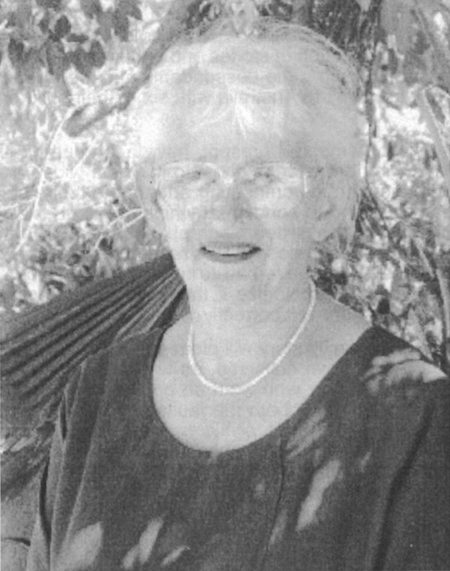
With kind permission of the Innisfail Advocate
Margaret Worrall
Innisfail, 2002
Arthur Robertson was the first of our Shetland ancestors to come to Australia. He was born at Hellister, Whiteness on 3 November 1815. The only things we know about Arthur's father is that his name was James Robertson, he came from Stromness, and he married Barbara Manson of Cova in 1811. James disappears from the records after the birth of his third child in 1817 and as there is no record of his death in Shetland, it is possible he died at sea.
We know more about the family of Barbara Manson. Her parents were Arthur Manson and Martha Thomasdaughter who married on 1 January 1772. Both were born in the 1750s and Arthur Manson’s father was probably a James Manson. Barbara was born in 1782 and had six siblings whose names are listed on the family chart. Magnus Manson, who sailed and perished with Sir John Franklin in the search for the Northwest Passage, is believed to be one of Barbara’s relations. (See notes on the Franklin expedition in Appendix 1.)
Writing in 1937, son Robert describes Arthur Robertson as follows, “My father was a person of medium height and of well built proportions; a well-shaped head, with grey, curly hair, which we were told was black in his youth. The head sat over a pair of ample shoulders. His blue eyes were large and expressive as they looked out at you from beneath a broad forehead. His voice was of the bass register, melodious and pleasing in its cadences. Ready of speech, epigrammatic of phrase, he was an interesting conversationalist. He wore a long flowing beard, which added a touch of patriarchal grace to his general characteristics. By trade he was a stone mason, and by profession he was a teacher of music and singing. 1

Arthur had a variety of skills. He was seaman, a farmer and fisherman, a mason and a stone waller. He played the violin and taught music. Arthur’s marriage to Margaret Henderson on 15 August 1837, is recorded in the Tingwall register. The service was conducted by the Rev J Turnbull.
Margaret Henderson was born on 4 September 1812, at Burwick, Shetland, the daughter of Peter Henderson and Agnes Williamson, who had been married on 12 August 1798. All we know about either parent is that Peter is described as a fisherman of Burwick. Margaret had two older brothers, Walter and William and an older sister called Elizabeth. Elizabeth died at the age of fifty-two, unmarried and without issue. The boys lived to the ages of eighty-two and seventy- three, were married and had families.
page 4
Robert does not describe his mother’s physical appearance but tells us, “Mother was a homemaker. Had she followed a business career she would have made a success of it. Her home was a comfortable place to be in — just homely. She dispensed hospitality graciously to all comers”. Also this loving tribute, “A boy born into a poor home sees more of his mother than a boy born into a rich home sees of his. The poor boy’s mother is his nurse, governess, tutor, college professor, and his all, in one personality, the cords of filial love binding all together, giving a real oneness to the home." 2
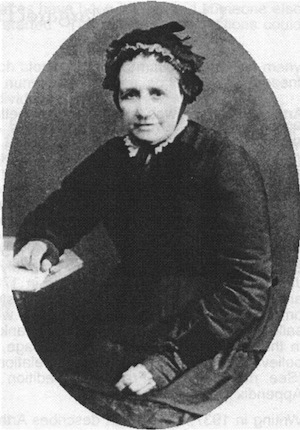 Great granddaughter Margaret Haine gained the impression from her mother and her uncles, that Margaret Henderson was a gentle loving person. 3 Lottie Dickins, my mother and Margaret Henderson’s granddaughter, was told that Margaret Henderson's brothers were both left handed, stuttered and were travelling preachers in Shetland. 4 Lottie’s father, Robert, told her he had a lawyer cousin called Henderson living in NZ and Margaret Haine believes there are Henderson relations in Canada. Margaret Henderson had birthing skills and was called on to attend confinements. She is also said to have had second sight, but no one has given me any stories to demonstrate this.
Great granddaughter Margaret Haine gained the impression from her mother and her uncles, that Margaret Henderson was a gentle loving person. 3 Lottie Dickins, my mother and Margaret Henderson’s granddaughter, was told that Margaret Henderson's brothers were both left handed, stuttered and were travelling preachers in Shetland. 4 Lottie’s father, Robert, told her he had a lawyer cousin called Henderson living in NZ and Margaret Haine believes there are Henderson relations in Canada. Margaret Henderson had birthing skills and was called on to attend confinements. She is also said to have had second sight, but no one has given me any stories to demonstrate this.
Lottie tells us that Margaret Henderson had sixteen children including two sets of twins. Seven of these children, including the twins, died as babies. There is no official record of all these births but this does not mean they did not occur, as stillbirths or babies who died soon after birth may not have been registered. Of the surviving children, six came to Australia. Of those who did not come to Australia, Barbara Robertson died at the age of twenty-two before the family left Shetland, and the fate of John and Peter is uncertain. The children who came to Australia were Agnes, James, Arthur Jnr, Margaret Jnr, Robert and William Adie.
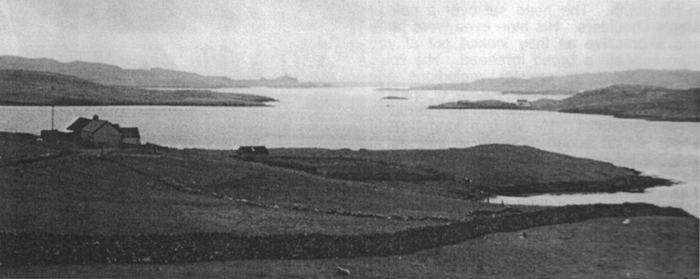
A Shetland Farm
An isolated farm at Aith Voe with fine stone walls of the type the Robertsons would erect in Victoria.
1 R. Robertson, The Port Campbell Revival, p.47
2 R. Robertson, The Port Campbell Revival, p.53 and p.50 respectively
3 Interview with Margaret Haine, April 2000
4 information from Lottie Dickins recorded by her daughters Marie Nemec and Margaret Worrall
page 5
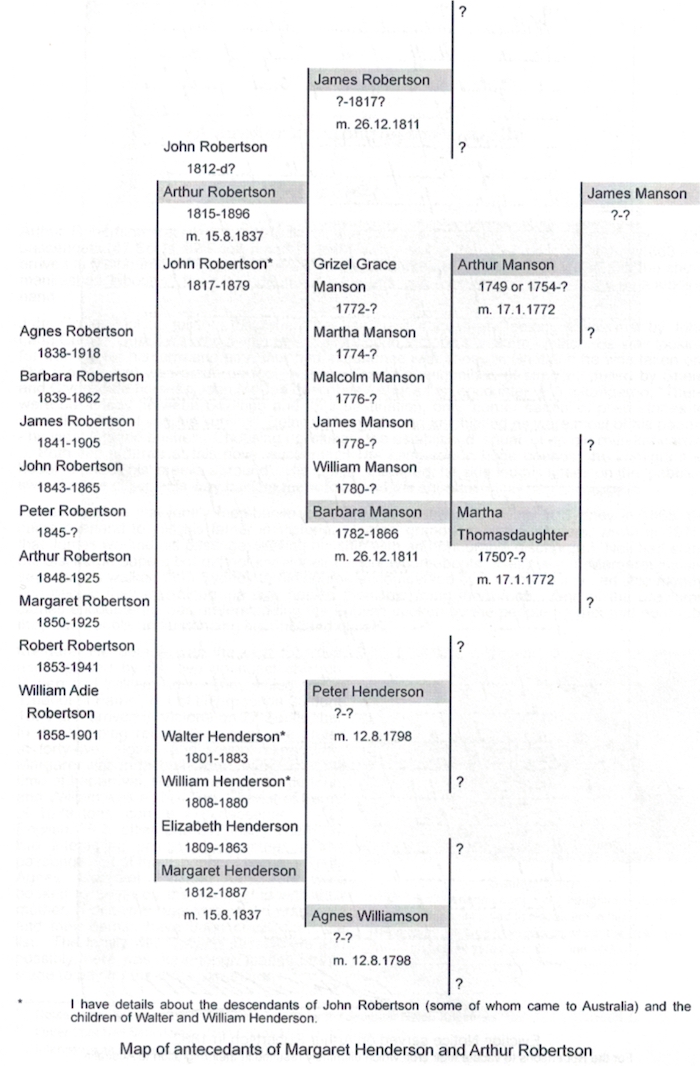
page 6
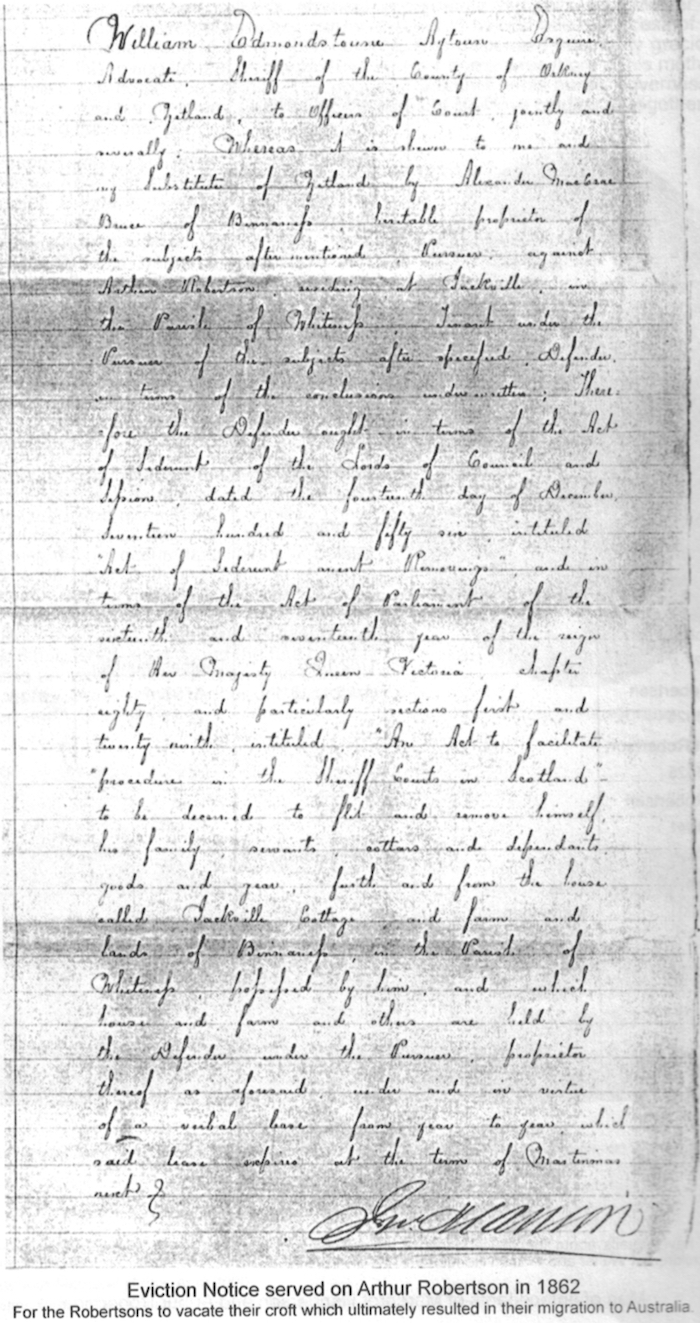
Arthur Robertson travelled to Australia on the Vanguard, a ship of 1303 tons carrying 232 passengers (47 Scots, 82 English and 97 Irish), which sailed from Liverpool on 21 July 1863 and arrived in Melbourne on 1 November. Arthur disembarked at Geelong. He is listed in the ship’s manifest as ‘labourer’, but it is understood in the family that he worked his passage as a leading hand.
John Collins McCue tells us that when the Vanguard docked at Geelong it was met by John Lang Currie. Currie was the owner of Larra station in Victoria’s western district. He was looking for workers for his farm and as Arthur had experience with sheep in Shetland he was taken on. The trip to Larra was made on foot, walking beside a wagonload of supplies pulled by Shire and Clydesdale horses. John McCue describes Arthur’s first encounter with a kangaroo, “There were no fences between Geelong and their destination, only ‘corner cairns’ of piled stones to mark the limits of various ‘runs’. Being in the wilds and uninhibited as were most of his people - he went into the bushes. Choosing unwittingly the established ‘squat’ of an old man kangaroo. Both fled in terror at this novel encounter. The kangaroo in huge bounds, the immigrant in hobbled haste, his ‘breeks aground’. His dignity shattered, he skinned his knees on the ‘pebbled sward’ as he clawed his way back to the wagon and the squatter.“ 1
James was the first family member to join Arthur in Australia. Arriving in Sydney in 1865, he came overland to join his father in Victoria. James’ grandson, Neil Saunders, wrote in 1975, that James worked his passage, leaving his ship with an honourable discharge. 2 Neil had seen the discharge papers but did not know their current whereabouts. Neil's sister, Margaret Haine, says James walked from Sydney to Melbourne accompanied by a friend. They had little money and people they met along the way helped them by giving them food. One of the problems James encountered was understanding the English spoken by the people he met and no doubt they had trouble understanding his Shetland dialect! 3
Margaret Henderson was the next to arrive, accompanied by the two youngest children, Robert and William Adie. They sailed on the Chariot of Fame out of Liverpool on 29 June 1866 and arrived in Victoria on 22 September. In the shipping record their ages are stated as forty-five, eleven and seven respectively. Margaret was in fact fifty-four years old at the time of her arrival, Robert had turned thirteen, and William was eight. The Chariot of Fame of 1639 tons, carried 278 passengers - 31 English, 25 Scottish, and 242 Irish. There are two interesting points about entries in the passenger list of the Chariot of Fame. Firstly Agnes, Margaret Jnr and Arthur Jnr were booked to travel on the same ship with their mother. For some reason they did not do so and their names have been crossed off the list. The family were paying passengers and possibly there was not enough money at that stage to pay for the three extra fares.
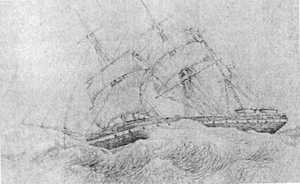 Sailing Ship. Miriam Robertson Lawson, the daughter of James Robertson, included this postcard in her album This may be the type of vessel on which the Robertsons travelled to Australia in the 1860s. >
Sailing Ship. Miriam Robertson Lawson, the daughter of James Robertson, included this postcard in her album This may be the type of vessel on which the Robertsons travelled to Australia in the 1860s. >
page 8
Secondly, listed with the rest of the family is Ann Robertson, widow, 23 years. Who was Ann Robertson and what happened to her? The passengers’ surnames are not listed alphabetically and the seven Robertsons appear as a group. John Collins McCue was told that John Robertson Jnr and his wife had intended to join the rest of the family in Australia and the reason Agnes, Margaret and Arthur, did not sail with their mother in 1865, was that they were waiting for John. Is it possible that Ann Robertson was his widow? However if the Ann Robertson, who sailed with Margaret Henderson was in fact John’s wife, they would have already known of John’s death, because Ann was listed as ‘widow’. All these questions must be left unanswered until and unless we obtain more information about the mysterious Ann Robertson.
 When their father had saved enough money, Agnes, Margaret Jnr and Arthur Jnr were sent for. It is understood that Arthur Jnr worked his passage. They sailed from Plymouth on 2 July 1867 aboard the John Temperly, 998 tons, carrying 356 passengers, Master - J W Tucker. The ship arrived in Melbourne on 26 September. The two girls are described as knitters and Arthur as farmer. Travelling on the same ship were a number of single women including Mary F Halls, age 18, ‘servant’. Mary Halls would later marry James Robertson.
When their father had saved enough money, Agnes, Margaret Jnr and Arthur Jnr were sent for. It is understood that Arthur Jnr worked his passage. They sailed from Plymouth on 2 July 1867 aboard the John Temperly, 998 tons, carrying 356 passengers, Master - J W Tucker. The ship arrived in Melbourne on 26 September. The two girls are described as knitters and Arthur as farmer. Travelling on the same ship were a number of single women including Mary F Halls, age 18, ‘servant’. Mary Halls would later marry James Robertson.
William Adie Robertson about the time the family migrated to Australia >
1 Notes written by John Collins McCue supplied by his daughter Helen Krigsman
2 Letter from Neil Saunders to John Collins McCue, 12 June 1975
3 interview with Margaret Haine. April 2000
How was it this family of Robertsons came to Australia? Who were they and what do we know about their origins? Why did they leave Shetland?
page 9
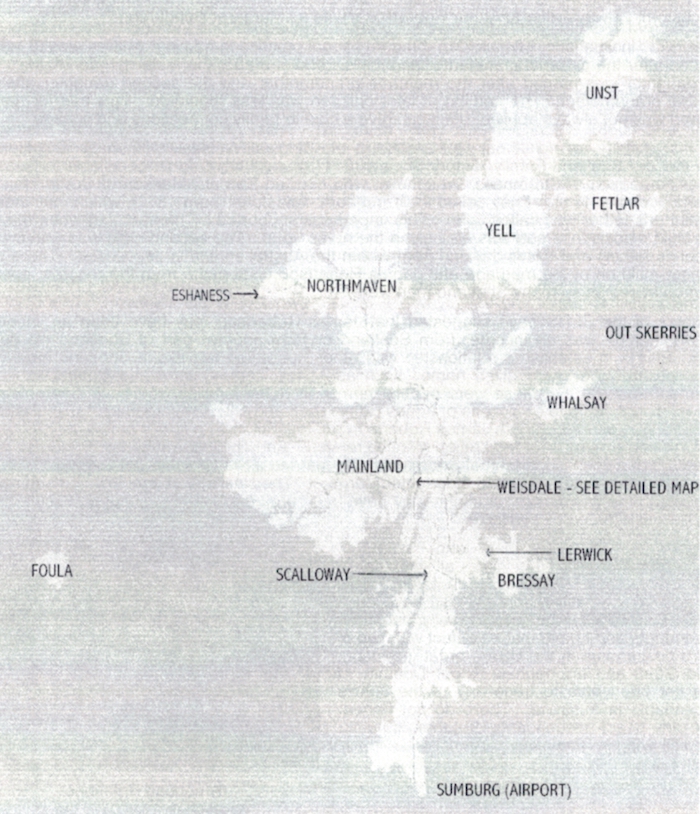
page 10
Robertson means son of Robert, and it is a common name in Shetland as well as in mainland Scotland. There is not necessarily any connection between Shetland and Scots Robertsons, although there is a tradition in our family that our Robertson line moved to Shetland from Scotland at some time unknown, because of religious persecution. I have no concrete evidence to support this. Indeed it would seem the Shetland line of our heritage is more Norse than Scots, and Marjorie Mathieson told me that her great grandfather Arthur Robertson, the first one to come to Australia, was often heard to say, ‘Achl The dirty Scot, we’re Norse’ - suggesting he saw himself as having Scandinavian rather than Scottish affiliation. Both Manson and Henderson are Norse names, Manson being a derivative of Magnus, and Agnes Williamson, according to Robert Robertson, was of Swedish extraction.
The standardization of surnames did not become common practice in Shetland until late in the 18th century. Prior to this the use of patronymics by the locals means it can be hard to trace lineage. We not only have the use of the suffix son, as in Robertson — son of Robert, and Henderson - son of Henry, but names such as Thomasdaughter — daughter of Thomas. William the son of Robert would be known as William Robertson but if William had a son called Thomas, he would be known as Thomas Williamson and so on. Women continued to use their own name after marriage and this is how they appear in the records until late in the 19th century. Following this custom, I always refer to Arthur Robertson's wife as Margaret Henderson.
While I was in Shetland, I was told that the traditional practice in naming children was to call the first son after the paternal grandfather and the second son after the maternal grandfather. The first daughter was named after the maternal grandmother and the second daughter after the paternal grandmother. The naming of later children was less regulated. This rule for naming children was not always applied, but it can give a clue to family connections and lineage.
The first definite record of our Robertsons in the Tingwall/Weisdale/Whiteness and Hellister area that the Shetland Family History Society (SFHS) and I have so far been able to locate, is James Robertson of Stromness, Whiteness, who married Barbara Manson of Cova, Weisdale on 26 December 1811. 1 They called their first-born child John (born 1812), which may indicate that Arthur’s father was called John. This is perhaps supported by the fact that when the first- born child died, a third son was also given the name John. The second child was Arthur (after Barbara’s father) and this is the one from whom the Australian line is descended. There were no more children of the marriage and James Robertson disappears from the records, possibly drowned at sea as so many Shetland men were.
Members of the SFHS have suggested that James Robertson may have been an ‘incomer’. But whether he was an incomer from Scotland or from another part of Shetland we do not know. Efforts to establish a relationship with other Robertson families in Shetland have been unsuccessful. We share given names such as Agnes, James, John and Robert with other Robertson families, but these were popular names in many families who have different family names. There seem to be dozens ofAgnes Robertsons and one is recorded in the Tingwall area in 1785. Was she related? A James Robertson of Moustoft, with a family of five, is listed in the 1804 Weisdale records for food relief. Was he related? And Thelma Watt of the SFHS has found the record of a John Robertson of Stromness who married a Philadelphia Tait in 1816. They had sons called John and Arthur and a daughter Margaret. The similarity of age, location and names suggests to me that James and John may have been brothers but this cannot be substantiated from the limited records available.
Our Arthur’s younger brother, John Robertson, was a shopkeeper. He lived all his life in Shetland but some of his descendants emigrated to Australia, Canada and the USA. I have quite extensive details about John’s family and their descendants and I have made contact with two of John’s descendant in the USA - great grandson, David Gunn and his nephew Roger Douthitt.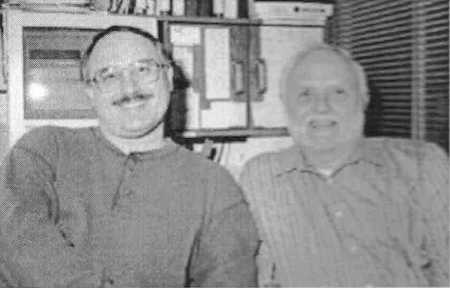 I have not been able to trace any of the John’s descendants in Australia. There do not appear to be any direct descendants of either Arthur or John still living in Shetland.
I have not been able to trace any of the John’s descendants in Australia. There do not appear to be any direct descendants of either Arthur or John still living in Shetland.
American relations, Roger Douthitt and David Gunn >
page 11
There are a number of books available which describe the history and traditional life of Shetland much better than l can do and any of you who have visited Shetland, and the museums there, will be aware of the difficult life our ancestors lived. 2 A harsh climate. High rates of child mortality. Menfolk lost at sea. Periods of famine when crops failed. 3 Oppressive lairds/landlords. Bureaucrats and clergy imported from Scotland intent on imposing Scottish ways of doing things. 4 And a political system that supported the landowners against their tenants. Before the 19th century when roads were built, transport in Shetland was by foot or by boat around the coastline. Individuals stayed very much within their own communities and communities were contained within a particular geographical area. Marriage options were generally limited to those living within those areas.
The reading l have done suggests that the inhabitants of Shetland and Orkney, along with the Highlanders of Scotland, were regarded by the English and Lowland Scots as an inferior race who were uncouth, ignorant and incapable of making the best use of the land they farmed. How similar this sounds to the attitude some of our forebears held and some people still hold with regard to the Aborigines who were displaced by white settlement in Australia.
The Highland clearances, when landlords demanded greater returns from their properties and replaced crofters and tenant farmers with sheep, occurred a little later in Shetland than elsewhere throughout the British isles. The main effect was felt in the 1850s and 1860s when hundreds of Shetlanders emigrated to Australia, New Zealand and Canada. There were programs for assisted emigration and Norah Kendall outlines some of these in her book With Naught but Kin Behind Them. Looking through the records of the Tingwall Sheriff Court Processes for the 1850s and 1860s, l was struck by the number of ‘orders for removal’ brought by landlords against their tenants. Some were absentee landlords who lived in the cities of England and Scotland. They seem to have had little sympathy for their tenants and described the clearances as ‘improvements’. An early version of economic rationalism?
The Shetland l found on my visit in May 1997, is of course very different to the Shetland of history books. However the wind blows just as it always has and island activities are still
page 12
very much controlled by the seasons and changing weather patterns. The Norse influence is strong and this makes Shetland different to Scotland and England. For me, the most lasting impressions of Shetland involve the colours, the sounds, and the touch of the wind. When I was there, the dominant colours were the blue of sea, lochs and sky, the grey of clouds and stone, and the bright green of new growth in the fields. There are not too many trees in these wind wound islands and there are few places where you are out of the sight of the sea. The sea, the wind and the seabirds are ever present.
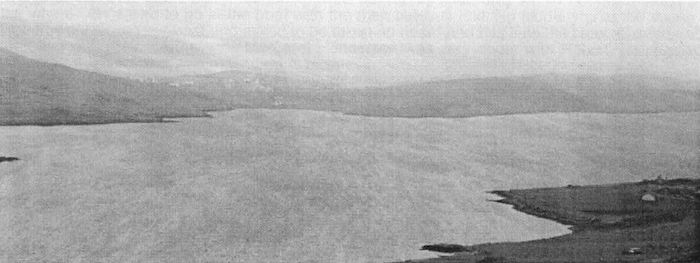
The Wind Wound lsle
Wind ruffles the surface of Weisdale Voe.
The registration of births and deaths did not became obligatory in Scotland until 1855, however the first all-Shetland census was held in 1841 and this was followed by further censuses at ten year intervals. These along with other records tell us something about our forebears. Although there is no record of James Robertson’s death, his wife, Barbara Manson, is described in the 1841 census as ‘widow’. The record of her death in 1866 at the age of eighty-four, states she was the ‘widow of James Robertson farmer’. We can assume that James was also a fisherman as farming and fishing were joint activities for crofters and he may have also been a seaman working on British ships that picked up crew in Orkney and Shetland. Barbara Manson’s death was registered by her grandson Arthur Robertson Jnr who signed with a cross. This suggests that Arthur Jnr may not have been able to write at that time.
Margaret Henderson’s father, Peter Henderson, is described in the census records as ‘fisherman’, as is her brother, Walter Henderson.
Arthur (the son of James Robertson and Barbara Manson) is listed at various times as farmer mason, and music teacher. We know from family stories that he was also a seaman. At the time of the 1841 census, he is recorded as being absent from home and the assumption might be made that he was away at sea. The women of the family would have all been involved in farming activities, as it was the women’s responsibility to maintain the farms while the men were away fishing during the summer months. Women were also knitters, and it seems an interest in knitting and other handicraft has come down through the family in Australia.
Arthur’s brother, John Robertson, is described in the census as merchant, grocer and farmer. While in Shetland I was shown the building where he had his shop at Strombridge. At the time of her death in 1881, his wife Joan is described as ‘widow crofter 2 acres’.
Arthur’s sons, James and John, are recorded in the 1861 census as ‘fishermen’. James was a crew member on whaling ships in 1858 and 1859. Whaling ships went out during the summer months to the seas around Iceland and Greenland. Family stories claim John had his own boat

Shetland Croft Museum, Southvoe circa 1870
The roof and the chimney were thatched with layers of turf and straw tied in place with straw ropes. Extra ropes were slung over the roof and weighted with large stones to keep it anchored against the wind. Light came from tiny skylights at eaves level. If and when the croft could afford it proper windows might be installed. The floor was flagstones or packed earth. The dwelling part of the building was divided into two rooms one for living the other for sleeping. The main focus was the hearth where a peat fire for heating and cooking, and for drying fish and meat, burned continuously. Adjacent to the living area, divided from it by a passage, was the byre where feed was stored and a milking cow tethered during the winter. Next to the cottage is the barn with bins for storing bare (barley) and oats and all the farming equipment. There was a hard floor for thrashing, sheep skin platens for sifting and sorting the grain; and a ‘quern’ (a hand turned stone mill) for grinding it. At one end of the barn was the kiln for drying grain; this is the round section slightly detached from the house above.
page 13
was a privateer against the French, and ran guns to America during the Civil War. More about these two later on.

John Robertson's shop, 2000
There have been several additions and alterations to the building.
Stories about the Robertson's life in Shetland have been handed down from one generation to the next. Most of those I relate here were told to my mother Lottie Dickins by her father Robert Robertson, and were recorded by my sister Marie and myself. ln many cases there are similar stories in other sections of the family.
When a whale was sighted, the men would go out in small boats to chase it. Each family represented at the kill got a share of the whale. On one occasion, when a whale ‘blew’, the older Robertson menfolk were away from home. Robert, who would have been about nine years of age at the time, knew that if his family were not represented they would not get a share of the whale. He asked to go in the boat with the men but was told ‘No laddie you're too young’. Robert went to another boat and asked to be taken on board and this time the crew relented and took him with them. Afterwards Margaret Henderson was very angry with Robert, for chasing whales in an open boat was a dangerous business.
Whale oil was used to put on bread or bannocks and when the men went fishing they wrapped their ‘sandwiches’ up and sat on them. The heat from their bodies melted the oil, which then soaked into the bannock. Whale blubber was also used to fuel lamps.
Money could be made by collecting down from birds nests on the cliff faces. Young men or boys were let down on ropes from the top of the cliff. This was another dangerous occupation and men sometimes fell to their death. “The men were either sailors or down collectors and were therefore either drowned, lost at sea, or fell to their death.“
A local superstition said that if you killed a lark you broke a toe; young Robert was a good shot with stones, he killed a lark and sure enough he broke his toe.
Each pupil had to bring peat to school for the fire and if they brought none then that pupil sat furthest from the fire.
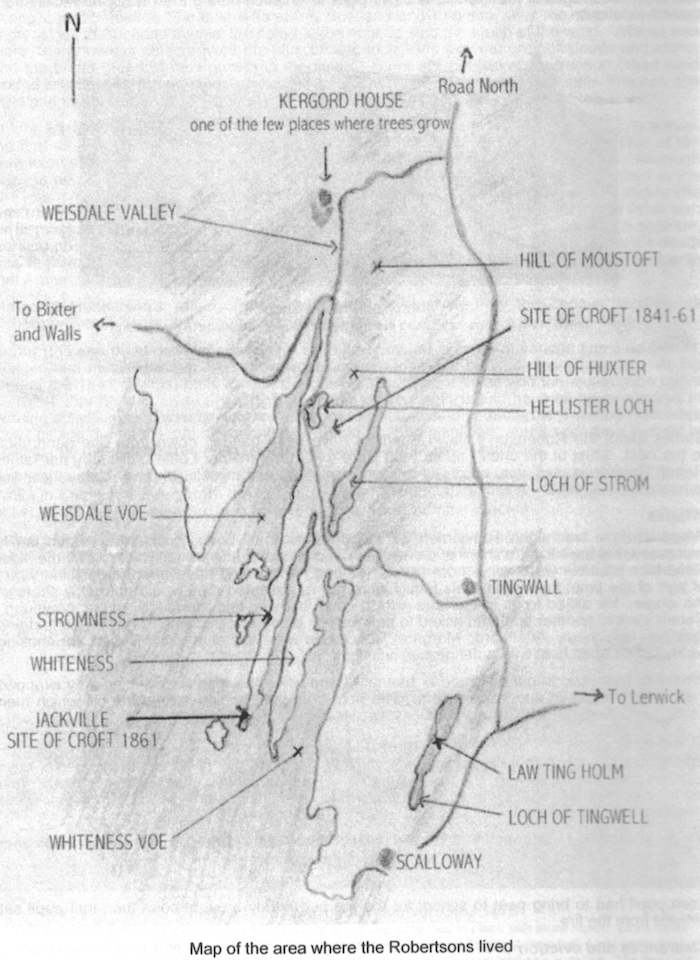
Coming home from a trip at sea Arthur Robertson discovered the Laird had fenced off the common land to graze his sheep. This made Arthur so angry he pulled the fence down and knocked the laird down. He was charged with assault and fined. Lottie believed this was the reason the family left Shetland. As my mother told the story, the laird was married to Arthur’s sister and lived in ‘the only two-storey house on the island‘. This is certainly not correct as Arthur did not have a sister and there were many two-storey houses in Shetland at the time. However the laird’s house may have been the only two-storey house at Hellister or Jackville where the Robertsons lived.
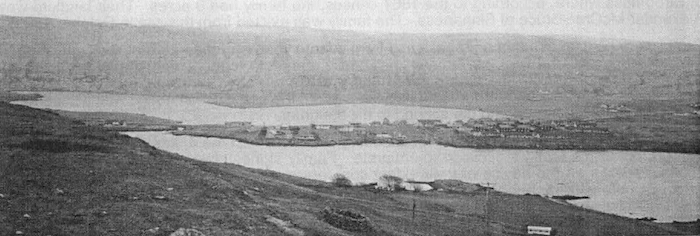
Weisdale Valley and Hellister Loch
View from Weisdale Hill on the western side of the voe.
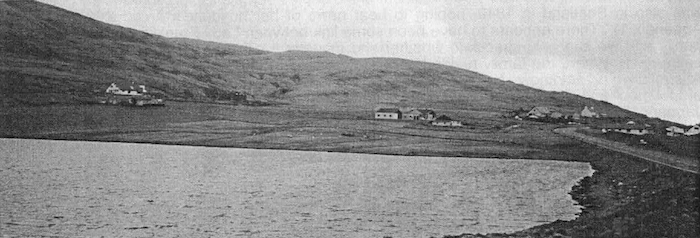
Hellister Loch
Showing the narrow section of land between the loch and the voe seen in the previous photograph. This is the area where the Robertsons had their croft at the time of the 1841 and 1851 census.
John Collins McCue has a variant of the same story, “Coming home from a whaling trip, Arthur Robertson discovered that his brother-in-law, having been sub-let the whole of the ‘hinterland’ by an English landlord, had enclosed the village within a dry stone wall and was charging rent for what had been common grazing. He knocked down then his brother-in-law and was prosecuted and fined." 6
Thelma Watt and I can find only the most tenuous relationship between the Robertsons and Laurence Calder, who was the family’s landlord at Hellister. John Robertson’s wife was Joan Smith and she had a sister called Philadelphia. The father of Philadelphia Smith's illegitimate son Robert, born in 1856, was Robert Calder, the son of Laurence Calder. Philadelphia obtained a court order against Robert Calder for the payment of “three pounds sterling per annum in name of aliment to an illegitimate male child”. This was to be paid until Robert Jnr reached the age of seven but it seems Robert Calder, who is described as a sailor, avoided his responsibility by taking himself elsewhere. Robert Jnr was recorded in the 1861 census as Robert Smith (4 years) but in 1871 he is recorded as Robert S Calder (15 years). 7
These stories demonstrate the unreliability of tales that are handed down from one generation to the next, becoming exaggerated or changed as they go. They do however give us clues to follow up. I was not able to verify the assault charge but it was while trying to locate a record of the assault case in the Tingwall Sheriff Court Processes that I found two eviction orders taken out against Arthur Robertson. If Arthur Robertson did in fact assault someone this may have well precipitated one of the two evictions.
The first eviction, in April 1858, was from the land at Hellister owned by (or sub-let to?) Laurence Calder. Living there at the time of the 1851 census, Arthur is described as "farmer, 4 acres, employs 2 labourers”. 8 After being evicted from Hellister the family moved to Jackville at the tip of Stromness where, according to the 1861 census, the family had 8 acres. Their landlord was Alexander McCrae Bruce of Binnaness. The family was evicted from this site in October 1862.
Crofts were held “in virtue of a verbal lease from year to year" and the order for removal charged the tenant to “flit and remove himself, his family, servants, cottors and dependents, goods and gear, forth and from the house called Jackville Cottage and farm and others held by the Defender.“ Unable to find Arthur Robertson in person, the first eviction notice was issued to his wife, Margaret Henderson and the second to his daughter.
The argument with the landlord not withstanding, we must assume it was this second eviction that prompted the family's decision to emigrate. Family stories claim that Arthur and Margaret chose Australia on the advice of their eldest son James. There is no record of James visiting Australia before 1865, but he would probably have heard about the country from other seaman with whom he worked. The family’s decision may have been influenced by the visit to Shetland in 1849 of Dr John Dunmore Lang who was a Presbyterian Minister and member of the New South Wales Legislative Council. He preached to large crowds in Stromness and Lerwick encouraging emigration to Australia. Lang was particularly keen to encourage Protestant female emigration as a way of redressing the disproportionate numbers of males and Catholics in Australia. 10
Lady Jane Franklin, who was Vice-President of the Ladies Female Emigration Society of London, was also in Shetland in 1849, hoping to hear news of her husband’s Arctic expedition, (see Appendix 1). There appears to have been some link between Lady Franklin and the Robertson family and we can only speculate whether she may have assisted or encouraged the family's emigration. Where the family resided between the time of their eviction and their departure for Australia we do not know. Nor do we know how and when they travelled to their departure ports of Liverpool and Plymouth. All we can be certain of is that Arthur Jnr was still in Shetland in January 1866 when he registered the death of his grandmother, Barbara Manson.
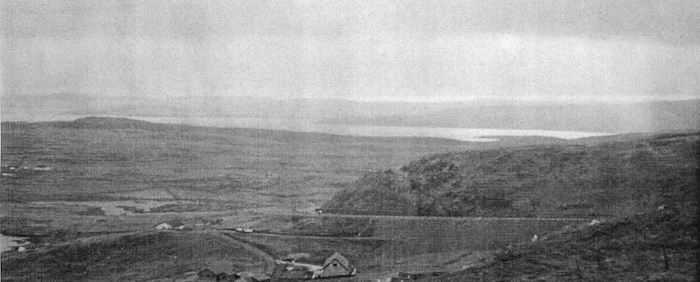
View across Whiteness to Weisdale Voe
1. I am indebted to Thelma Watt and other members of the Shetland Family History Society for helping me chase up our Shetland connections.
2. See bibliography
3. The potato famine in Ireland and the effect it had on Irish emigration is well known. Less well known is that the same crop failure, caused by the potato blight, affected Scotland and Shetland, where crofters were also reliant on potatoes as a staple food. The years 1846-1849 saw a series of crop failures. J. Nicolson, Traditional Life in Shetland, p.28 tells us that in the 1840s, “to prevent famine the British government, through the Board for the Relief of Highland Destitution began a programme of road building. The workmen being paid in meal." [Seems there is nothing new about work for the dole.)
4. Shetland did not become part of Scotland until 1469 when the King of Denmark pledged Shetland and Orkney as part of his daughter's dowry on her marriage to the future James III of Scotland.
5. From Lottie Dickins
6. Notes written by John Collins McCue supplied by his daughter Helen Krigsman
7. Shetland Archives
8. lbid
9. Extracts from eviction notice dated October 1862, see Chapter 1
10. N. Kendall. With Naught But Kin Behind Them, Chapter 16
page 17
Before moving on to the Australian part of our story, I am going to tell you the little I know about Barbara, John and Peter, the three Robertson siblings who did not come to Australia.
BARBARA ROBERTSON (1839-1862)
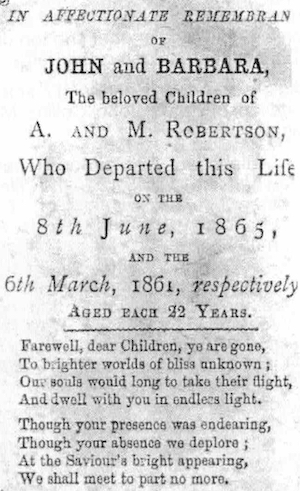 Born either at Scalloway on 30 November 1839 (Shetland Records) or at Hellister on 12 December 1839 (Parochial register held in Edinburgh), the second child of Arthur Robertson and Margaret Henderson. 1 She would have been named after her paternal grandmother Barbara Manson, as was the custom with the second daughter.
Born either at Scalloway on 30 November 1839 (Shetland Records) or at Hellister on 12 December 1839 (Parochial register held in Edinburgh), the second child of Arthur Robertson and Margaret Henderson. 1 She would have been named after her paternal grandmother Barbara Manson, as was the custom with the second daughter.
We know very little about Barbara. At the time of the 1861 census, she was living with her Uncle John Robertson at Strombridge and died there on 26 February 1862 (SR). Her death was registered by her brother John. A remembrance notice for Barbara and her brother John incorrectly gives the date of her death as 6 March 1861. l have a photocopy of this notice, which is from an unidentified newspaper; it is undated.
Remembrance notice for John and Barbara Robertson >
Tradition says Barbara died of tuberculosis (TB), a common ailment in cold damp Shetland. In one of the tracts called 'My Grandmother's Prayer' by Frances Saunders, the following is written:
Her passing was uncommonly triumphant. “Oh look” she exclaimed with her latest breath, “I see Jesus, He has come to take me home. No doubts were entertained as to her eternal Safety. 2
JOHN ROBERTSON (1843-1865)
Born at Hellister, Shetland, on 28 September 1843, the second son and fourth child of Arthur Robertson and Margaret Henderson. Recorded as being at Jackville in the 1861 census.
Stories about John and his exploits have come down through several sections of the family. John Collins McCue wrote in 1993:
page 18
John was the fourth child and second son, whose wife was the daughter of Adie. John led a rumbunctious life - was wealthy before he was 20 - mainly from pirating against French smugglers? He took his turn ‘on the whalers’ and normal fishing. When the American civil war erupted he turned his skills to gun running to support the English cause. He ran the blockade of Boston Harbour and was captured and sent back to England twice ‘in irons’. He ventured a third run and was captured again. This time he succum[b]ed to Pneumonia and TB. He had a premonition and left his violin with Agnes [his sister]. A member of the clan has it. I hold a death notice placed in a local paper [in Australia] - a joint notice of the death of Barbara and John with the date of their passing.
This is the same notice l have a copy of, and gives John’s date of death as 8 June 1865. I have not been able to verify John’s date or place of death and wonder if, like the date of death given for Barbara in the obituary, the date of death for John could also be incorrect.
Lottie Dickins said, “John had a boat of his own and went pirating off the Scottish and English coast against the French. Made money and had an honourable pardon by the [British] government.“ Yet another story tells us he was imprisoned in America and he may have died there. Lottie understood John had married a woman called Adie, adding that she too died of TB, and there were no children.
Adie was Arthur Robertson’s shipmate and bosom pal. John Collins McCue again:
Adie in fact, was a robust energetic wharfside brawler - the life-long friend and partner of G[reat] Grandfather Robertson. He was a member of the Tynvald [Tingwall] - the area where the R’s lived - farmed - fished and crofted. Part of their circuit took in the port of Archangel [in Russia]. Here we will pull down the blind. Coming home they discovered that the ‘lessee'[?] had fenced off the hinterland which cut off their oat fields. etc. G was so incensed that he “socked” him down. This operation entailed [?] the socks were pulled off, a rock the size of a big man’s hand inserted and swung with access to the farewell of activity [?]. For this assault GF was fined. He decided to emigrate. Adie vanished to other climates. His name occurs 7/8 times in the family out here [i.e.: Australia]. 6
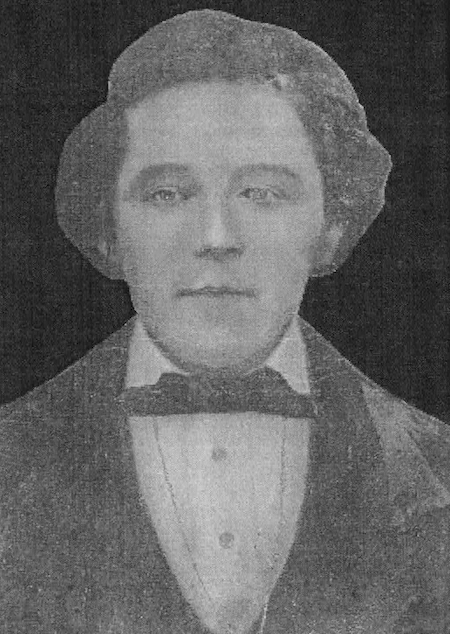
John Robertson >
Some credibility for this story comes from the fact that Arthur Robertson’s youngest son was named William Adie Robertson. William was the only child to get a second name and there is no earlier use of the name Adie in the family as far as l have been able to discover. in generations after William Adie, the name Adie was used exclusively for females. In Shetland, Adie, which is derived from Adam, can be either a family name or a given name and we do not know which it was in this case. The SFHS and I have searched the records to confirm a connection with the
page 19
Adie family but so far none has been found. The best we have come up with in the right time period is a William Adie, merchant of Delting, son of Thomas Adie. This fits in with Margaret and Arthur’s youngest son being named William Adie, but it is only surmise at this stage.
John McCue writes that John and his wife intended to join the rest of the family in Australia but died before he could do so. And John’s violin? Because Agnes did not play she is said to have handed it on to their younger brother Arthur.
PETER ROBERTSON (1845-?)
Born Hellister, Shetland, 15 December 1845, the third son and fifth surviving child of Arthur Robertson and Margaret Henderson. Recorded as being at Jackville in the 1861 census. After this Peter’s life is a mystery. He may have moved to the Scottish mainland according to both Lottie Dickins and John McCue, ‘apprenticed to a baker. His wife - no children - went back to her people when he died quite young’. 7
On the other hand Marjorie Mathieson tells me that when she was first married, neighbours of hers who came from Shetland (probably in the early 1900s), told her that Peter Robertson was the baker and ran the Post Office in Lerwick at the time these neighbours left Lerwick. And another relation, Rob Robertson, has provided the approximate date of death for Peter as being 1925. However Thelma Watt of the SFHS has not been able to find any trace of Peter in the Shetland records after 1861.
Peter's whereabouts must have been unknown to his siblings, as Gertie Grace remembers her grandmother Agnes ‘wishing she knew where Peter was’?
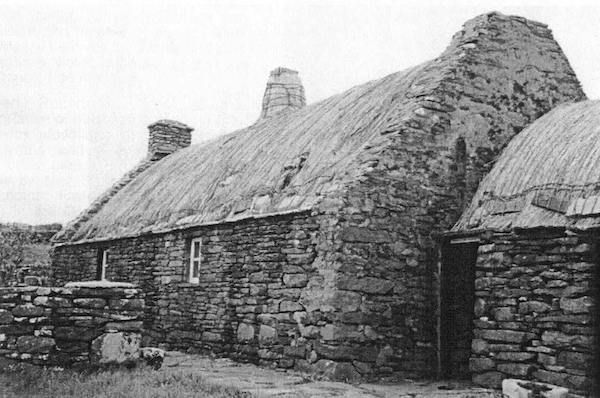
Shetland Croft Museum
See Chapter 3 for details.
page 20
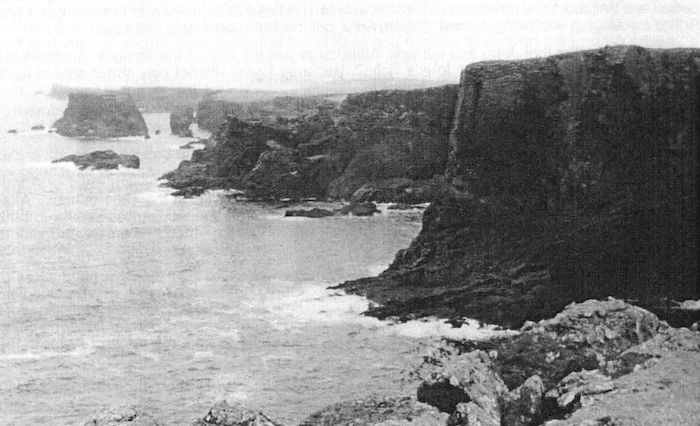
View of the Shetland Coastline at Eshaness, Noflhmaven
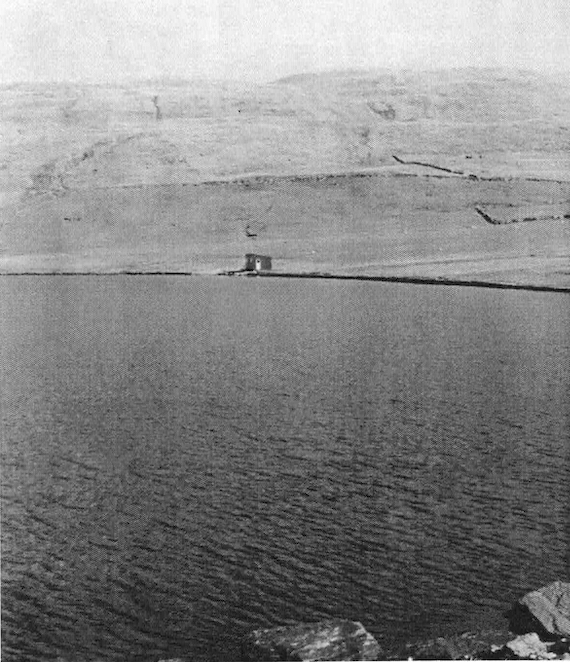
Hellister Loch
Near the site of the Robertson croft. Note the fine stone walls.
1. l have tried to check this discrepancy in dates, which occur for several family members. lt seems it is not unusual for there to be different dates in different records. The later date may be a baptismal date.
2. Frances Saunders is the daughter of James Robertson and there are two tracts with the title ‘My Grandmother's Prayer’.
3. J. Nicolson, ‘Traditional Life ln Shetland’, Chapter 2 tells us that smuggling was common during the 19th century. Another way of supplementing provisions and income was salvaging wrecks on the coastline.
4. Letter from John Collins McCue to Mac Dickins, 1993
5. information from Lottie Dickins recorded by her daughters Marie Nemec and Margaret Worrall
6. Letter from John Collins McCue to Mac Dickins, 1993. John’s writing is sometimes hard to decipher. hence the question marks.
7. From Lottie Dickins
8. Interview with Gertie Grace, April 2000
There are several themes that keep reappearing in the lives of Robertson descendants in Australia. These include music, handicrafts, religion and alcohol. l explore these themes as interludes between other sections.
Music, singing and dancing were an important social activity during the long dark Shetland winter, even though the Calvinist ministers who came from Scotland sometimes frowned on such frivolity. The most important instrument was the fiddle, with the gue - a two stringed fiddle of Norse origin - replaced by the modern violin in the 18th century. Greenland whalers carried at least one fiddler to entertain the crew on their long voyages away from home. 1
We know, that as well as being a seaman and a crofter, Arthur Robertson was a musician and teacher of music. Marjorie Mathieson believes the Wards had custody of Arthur's violin, but whether it is still in existence, I do not know.
Robert Robertson writes about the importance of music as part of the family’s religious devotions and I have copies of hymns and poetry written by him and other members of the family. One piece by Neil Saunders is dedicated to his mother Frances, “for her ministry of song in the General Hospital, Brisbane". (See Appendix 5.) Her father, James Robertson, gave Frances an autoharp on her eighteenth birthday in 1894. As a married woman living in Queensland she would play this to patients at the Brisbane General Hospital. One of Frances’ grand daughters has become a music therapist.
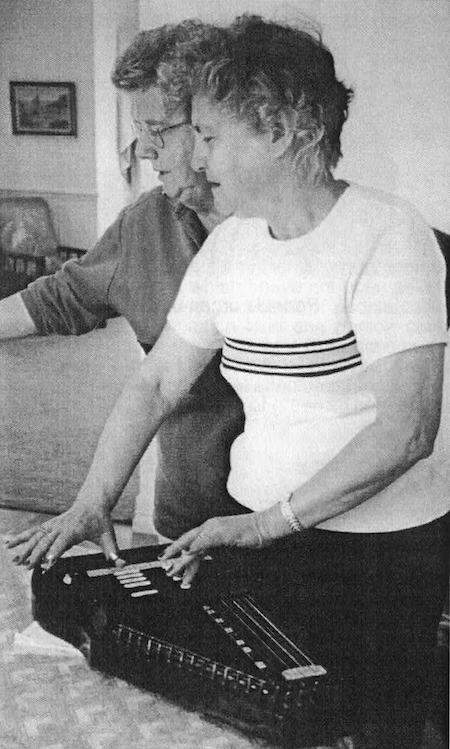 Music keeps being mentioned in the information and stories coming back to me from different sections of the family. My own mother had a fine contralto voice and sang at social and charity functions, and my Uncle Arthur’s singing of ‘The Mountains of Mourne’ has stayed with me from childhood. It was intended that my brother Neil would learn the violin. Being left handed, Neil insisted he should be allowed to use the bow in his left hand. Between lessons, he re-strung the violin accordingly. The teacher was not impressed and Neil's violin lessons did not continue for very long.
Music keeps being mentioned in the information and stories coming back to me from different sections of the family. My own mother had a fine contralto voice and sang at social and charity functions, and my Uncle Arthur’s singing of ‘The Mountains of Mourne’ has stayed with me from childhood. It was intended that my brother Neil would learn the violin. Being left handed, Neil insisted he should be allowed to use the bow in his left hand. Between lessons, he re-strung the violin accordingly. The teacher was not impressed and Neil's violin lessons did not continue for very long.
Rheita Mott’s Autoharp >
See Chapter 14. The player is Margaret Powell and her sister Dot Geary looks on.
There are many musicians in the family - singers and instrumentalists, professionals, amateurs and teachers of music. The gift of music carries right through to younger generations. When l am aware of the musical skills of individuals, I mention these in the potted biographies. l have been given copies of hymns and poetry written by family members and some of these are included in Appendix 5.
Of course not all the Robertson's descendants are musical. Rutherford Robertson told me that although his father could sit down at a piano and play almost anything asked of him, Rutherford did not inherit his ability. Peter Hogan, an uncle on his mother’s side, would try to get Rutherford to imitate his singing - ‘Up laddie, up the scale’. Uncle Peter’s efforts were doomed to failure. 2
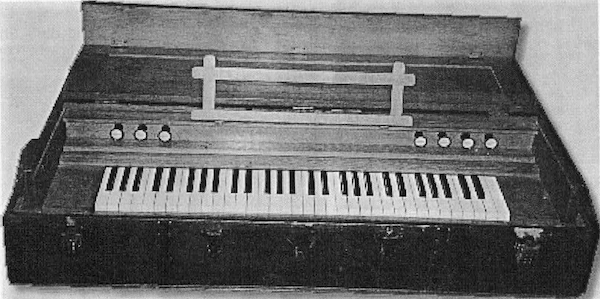
Portable organ used for the tent revivals run by Robert Robertson
Now in the custody of Pixie Robertson.
1. J. Nicolson, Traditional Life in Shetland
2. Interview with R.N. Robertson, March 2000

Mt Elephant: A recent view
As family members joined Arthur in the western district of Victoria the family settled at Lake Tooliorook near Derrinallum. 1 It was here that the eldest son, James, married in 1868. The family was still there in 1870, when Agnes and Margaret were married. Whether Arthur took up land in the area I do not know, but it seems probable. One story, which l have not been able to substantiate, suggests the Robertsons selected land in their name, on behalf of people called Manifold, as a ploy to get around the regulations limiting how much land one person could select. Lands department records show there were five lots in the name of J Robertson in the township of Derrinallum in 1867. Mt Violet, Mt Elephant and Mt Leura have all been suggested as a possible site for their first home. Certainly Robert had a sentimental attachment to the area where he spent his teenage years, writing a song about Mt Leura’s fields of green, “There an old slab cottage stood / In a gently sloping wood” 2

'Mt Leura's fields of green'
By the year 2000 the “gently sloping wood" has almost diappeared and European poplars have been planted.
Arthur must have quickly realized the potential for earning a living by building dry stone walls and sheds, a skill he and his sons brought from Shetland. The walls had the multiple advantage of providing fences for impounding stock, marking boundaries, providing fire breaks, and clearing the land of some of the millions of stones which dot the area as a result of volcanic activity in the long ago past. The Robertsons gathered around them a team of fence builders which undertook contract work for local landholders in the area around Camperdown, Derrinallum, and Skipton, east to Pomborneit in the Stoney Rises and as far west as Ellerslie and the Ballangeich and Drysdale homesteads. The stone fences at Larra Station were built by the Robertsons in 1869-70. This includes the stone gateway that was originally the entrance to the homestead, and which is now part of the public road. There is supposed to be a ‘signature’ mark on one of the stones but l was unable to find it when I visited the area in 2000. Those working with the Robertsons included Michael McCue, who would marry Agnes, and a man named Murnane, about whom l know nothing other than his name. 3 Progress was at the rate of ‘one and a half chains per day' and the men would camp out as they progressed along the extending fence line.

Stone fences in western Victoria.
This is the type of fence built by the Robertsons. >
Many of the stone fences in western Victoria are now protected under conservation legislation and the Corangamite Arts Council produced a book about the fences in 1995. 4 John McCue gives an account of Robertson involvement building the fences on page 83 of the book. An error in this account describes Arthur as John’s great uncle, when he was in fact referring to his great grandfather.
 Stone fence with embedded wooden slats to deter rabbits >
Stone fence with embedded wooden slats to deter rabbits >
From Derrinallum the family moved to Port Campbell. The chronology of the move is not clear, but it probably took place over a period of time, with family members moving about south western Victoria as the menfolk took labouring jobs or did contract work fencing and shearing. Lonely for the sea, Arthur Robertson visited and selected land at Port Campbell as early as 1865, but did not take possession of it until 1871. Robert writes, “When father first visited Port Campbell it was a veritable ‘no man‘s land.’ The Government refused him the selection of land where the town now stands, reserving it for a town. Land further up the river was obtained, and there he built a five-roomed stone cottage." 5 This land, near to the cemetery, is on the northeastern side of the bridge over Campbell Creek. On the Lands Department map it is marked as Lots 10 and 10a, divided by the present road to Timboon. (See the map on page 32.)
It seems the family’s early efforts at farming in the Mt Violet area were not a success. Arthur is quoted as saying, ‘Come boys, if we can’t make a living from the soil, we’ll make it from the sea as we have always done.’ This is supported by a comment added to a report about James Robertson‘s land reproduced in Appendix 4, which refers to another file, [possibly one about Arthur's land?]. It states, “The applicant and his sons were fishermen or connected with fishermen in Scotland and their ambition is to found a fishing station at Port Campbell." The idea came to nothing, for the Port Campbell coastline, with its the steep dangerous cliffs and off-shore winds, was not suitable for a fishing industry.

Heytesbury Forest >
A remnant section photographed in 2000. The area around Port Campbell was originally covered by dense forest which had to be cleared before crops could be planted.
Not everyone was happy with the move to Port Campbell and Lottie Dickins reported, “The family moved to Port Campbell when land opened up there because of their love of the sea - giving up better land and a better farm for poor land and virgin forest. Grandmother R was very upset as she did not wish to leave the district where they were established. All the women rode down side saddle through the Heytesbury forest - now cleared away and all farming land.“
Several sources suggest that the choice of Port Campbell was associated with the cliffs, which reminded the family of the cliffs at Eshaness in Shetland. The Eshaness cliffs are black, in contrast to Port Campbell's yellow sandstone.
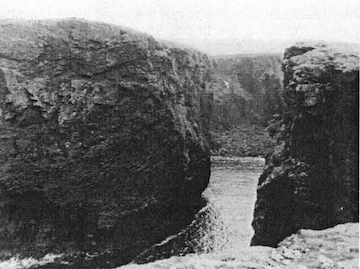
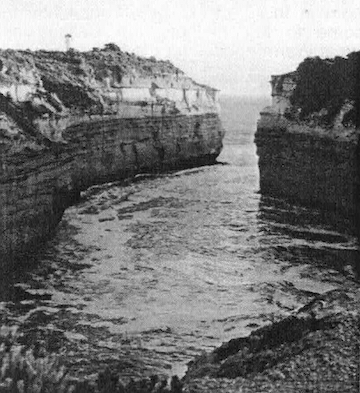
Eshaness on the west coast of Northmaven Shetland. — Loch Ard Gorge
near Port Campbell, Australia.
Margaret Henderson’s concern was probably well justified as descriptions of the early days at Port Campbell indicate a hard life. The isolation of the settlement and the difficulty of clearing dense forest and establishing crops such as potatoes and oats, meant food was sometimes scarce and families often went hungry. Obtaining supplies such as flour and tea involved a ride to Cobden - one day there, stopping overnight, and another back again. Robert writes, "... you must know there was no fatted calf which had ever been seen at Port Campbell in those early times. There was no grass to fatten a calf on.” However Arthur believed the area would prosper. "He tested his faith by making a small grass-tree area wallaby proof, digging it up, sowing oats and fertilizing it. He reaped a satisfactory return, which assured him that what he had done in a small way could, and would, be done in a large way some day” 7 Years later the use of super phosphate and trace elements would make the area more suitable for farming.
Neighbours of the Robertsons were Mr and Mrs Hector Mclntryre and Mr and Mrs John Henderson (not related to Margaret). The families became friends, giving each other support through difficult times, particularly the women who were often left on their own when the men were away working. The Mclntyre’s daughter was the first white child born in the area and Margaret attended her birth. The first death at the Port was the Henderson’s child, “which cast a shadow over every heart in the settlement.” 8
Arthur quarried stone out of the cliff near the lower section of the present cemetery, rolled it down the hill, cut it into suitably sized blocks, burned the lime, slacked it and mixed it, and built a substantial five roomed house for his family. lt became known locally as ‘the old stone house’. There is an old photo showing section of the house and a painting by Miss Maud Brown hanging above Di and Jeff McCue’s dinner table at Port Campbell. A more recent representation of the house was painted by Valerie Ward shortly before her death in 1990 and hangs in Gus Ward’s house.
 The Old stone House. >
The Old stone House. >
An early photograph of Port Campbell showing the bridge over Campbell Creek and a section of the Robertson's house. This photograph was used by Francis Robertson Saunders on the cover of her tract ‘My Grandmother's Prayer’.
While the house was being built, Arthur and Margaret lived in a 6 x 3 feet (roughly 2 x 2.5 metres) tent in the cavity from which the stone had been excavated. Agnes’ daughter, Robina McCue, was born in this tent in 1872, Agnes having come to her mother from Ballangeich (near Warrnambool) for the birth.
The stone house was completed in July 1872. The local stone was not the most ideal building material and a verandah surrounding the house was essential to protect it from the weather. Despite this protection the stone absorbed moisture and for much of the year the walls were green with damp. The stone house was eventually demolished. Margaret Haine remembers seeing piles of stones were the house had stood, when she was in Port Campbell in 1926. All the Robertson brothers selected land along the Campbell Creek valley, as did Michael McCue and George Chislett, who married into the family. The report mentioned previously, written by a mounted constable after his inspection of James’ block in July 1874, tells us the area was ‘heavily timbered and covered with dense scrub’. Robert describes an evangelising visit to the Mclntyre’s house at about this same date, “He at that time was a shepard [sic at Glenample where the wild dogs were troublesome to the sheep. Mrs Mclntyre appraised her husband of the proposed visit. Arriving at the hut we found him standing with his back to a log fire, shirted and trousered, with a saddle strap round his waist, his feet in unlaced boots.” 9
The lives of the second generation in Australia fall into two phases divided by the religious revival of 1874. The division is not sharp and I am sure the change from hard living settlers, struggling for survival, to respected God-fearing preachers, occurred more gradually and over a longer
page 27
period than Robert Robertson, writing in ‘The Port Campbell Revival’, seems to indicate. I write about the Robertsons and Christianity in Chapter 13.
Robert not only relates the Robertson family’s spiritual conversion, but he also gives us glimpses of the environment in which the family lived:
... homes scattered through the forest in winter time the bridle tracks were just streaks of gutters. There were no roads, no bridges and no culverts. Swamps, rivers and creeks were all full of water. To cross at the mouth of a river on a moonless night when a storm was on was to me rather gruesome. The river one was crossing always seemed to be much lower than the thundering breakers roaring outside. It seemed as if the horse and yourself must be overwhelmed. The waters were swirling around the horse’s legs as he waded through, and the sands under his hoofs were in constant motion. At such times I always had a feeling my horse was sensitive of danger. He and I were always glad when we were safely over. 10
Stories suggest a wild undisciplined bunch in the early days. There is certainly enough anecdotal evidence to suggest the Robertsons were heavy drinkers, with whisky their preferred drop. Lottie stated, “All the Robertsons were heavy whisky drinkers except Robert who was unable to drink because it made him ill. Uncle Willie and Jim and the sisters gave up drinking after becoming religious?" 11 Unlike his brothers Arthur Jnr continued drinking alcohol and Lottie told of living with her Uncle Arthur and Grandmother cum Aunt, Margaret Rutherford Cairns Robertson at Port Campbell, to help look after Margaret in her old age. Arthur would come home drunk and Lottie was terrified he would set the house on fire as he staggered around with a candle.

The Old Stone House
Painted by Miss Maud Brown in the 1880s. Note the scorch marks around the frame, which suggests the painting has been through one of the house fires mentioned in Chapter 7.
The Rev Jack McCue, when telling his daughters Marjorie and Marion about his childhood, related that the Robertsons were often so drunk they could hardly stand up. As a child, Jack would be put to sleep with a nip of whisky. It was Jack’s early experiences with the effects of the demon drink that turned him into an ardent temperance worker in later life. It certainly appears as if Michael McCue continued drinking heavily all his life and this might have been a point of contention between him and Agnes.
There are two stories about Robert in his late teens or early twenties. The first incident resulted from a disagreement with the local innkeeper. Robert rode his horse into the bar and with his whip he knocked all the bottles off the shelves. The second story involves the local coach
page 28
service. The coach was not scheduled to stop and Robert’s companion bet Robert £10 he could not stop the coach. Robert took him on, raised his gun and shot the lead horse. A slightly more charitable version of this tale has the need to stop the coach because a woman giving birth needed medical attention. Take your choice, either way the horse ended up dead.
In writing about his parents’ Christian faith and the family prayer sessions, Robert himself seems to make a small admission about his parent’s concern for their children's lifestyle by stating, “ln spite of prodigality, [their] prayers were priceless and painful to kick against. From the conversion of my parents until the salvation of their family would be over thirty years, giving a long time of prayer for these two.” 12
Lottie Dickins gives us a Cairns’ view on the Robertson family. Her mother and Uncle Sam, both Cairns, told her “the Robertson clan was very strong, which was never overcome and they shared the good and the bad. On one occasion they turned up at the Cairns property at Skipton and killed a milking cow for a feast. lf one of them experienced good fortune the others expected to share it and when one lot was having a hard time they would call on another family member to support them.” 13 This closing of ranks sometimes made it difficult for outsiders to be accepted. Arthur Snr made no secret of his hatred of the Sassenach - a term covering the English and Lowland Scots - and he proudly proclaimed his Norse descent. It seems Mick McCue, an Irish Catholic, had trouble being accepted by the family. Jack McCue claimed his grandfather never spoke to him when he was a child.
While the land was being cleared and crops established, other sources of income must have been needed and at the time James’ land was inspected in 1874, he was away from home, working for Mr Logan of Mt Elephant Station. Some indication of the movement of family members can be seen from the birthplaces of children. Agnes’ first child was born at Tooliorook in 1871, her second at Port Campbell in 1872, her third at Tooliorook in 1873, and the last two at Port Campbell. James’ first two children were born at Darlington in 1869 and 1871, the third at Cobden in 1873 and his fourth at Ellerslie in 1876. Margaret’s first child was born at Tooliorook in 1872 and her second at Ellerslie in 1876, her fourth in Melbourne in 1879 and the rest at Port Campbell.
Gradually the settlement began to prosper. The Robertsons ran a shop in the lean-to on the southern side of the house, supplying drapery, leather goods, dry provisions, and home made cider. Lottie related that in the early days, “Grandfather R had a store and sold cider. The excise officer Harrison analysed the cider and found it an intoxicating drink and Grandfather R was fined? 14 A similar story is attached to William Adie, but this time involving plum wine. These could be different versions of the same incident.

Present day view of Port Campbell and the site of the Old Stone House
page 29
Roads, albeit not very good roads, were built, and in 1882 Hector Mclntyre started a passenger coach service between Cobden and Port Campbell. Jack Fletcher writing in ‘The lnfiltrators’ tells of Mr McIntryre’s experience on Monday, 4 January 1887, “when practically the whole of the forest was on fire. The records show that he had to make "a dash through patches of fire which walled up each side of the road; the buggy was on fire three successive times and the flames extinguished, and the seat was burnt from beneath him before he reached his destination". 15
In 1888, the newly built community hall was used as a polling place for elections. The original ballot box is in the Port Campbell museum with a notice attached to it saying Arthur Robertson acted as polling clerk. ln the 1890s a shed attached to the old stone house was used by Bill Port as a cobbler’s shop. This was probably the same lean-to used earlier as a shop. Bill was an uncle of Jessie Port, wife of Arthur Ward in Generation ‘D’. He died in the middle of the decade at the age of nineteen or twenty from a ruptured appendix.

Ballot box >
Used in the first elections held at Port Campbell
John McCue writes that Arthur “went to Warrnambool regularly crossing the Curdies River at Peterborough. If the travelling was by horseback, the shorter trip was taken by Boggy creek - the horses ‘swum’ over and a break often made at the Le Couteurs. Trips were made in groups as far as Laang - concerts attended and contributed to. Horses were traded - cattle exchanged or sold - families intermarried - a new strata of living was established.“ 16
With the coming of the new century, we leave Margaret Henderson and Arthur Robertson behind and move on to take a more detailed look at the lives of their children. Margaret died at the age of seventy-five and was buried in the lower section of the Port Campbell cemetery on 26 October 1887. Arthur would live for another nine years. He died at the age of eighty-one and was buried beside his wife in the family grave on 30 December 1896. Other members of the family would later join them there.

Robertson Family Grave, Port Campbell Cemetery
Seated on the grave are Graeme and Heide Robertson.
page 30

An early view of Port Campbell from the hill
1. The name of the settlement called Tooliorook was later changed to Derrinallum.
2. See Appendix 5 for the full text of ‘Mt Leura's fields of green’.
3. The Murnane name appears quite frequently in histories of the Heytesbury Shire.
4. J. Black, ‘lf These Walls Could Talk - A report of the Corangamite dry stone walls conservation project’
5. R. Robertson, ‘The Port Campbell Revival', p.49
6. Lottie Dickins recorded by her daughters Marie Nemec and Margaret Worrall
7 R. Robertson, ‘The Port Campbell Revival’, p.13 and p.49 respectively
8 lbid, p.8
9 lbid, p.17
10. R. Robertson, ‘The Port Campbell Revival’ pp.7-8
11. Lottie Dickins recorded by her daughters Marie Nemec and Margaret Worrall
12. R. Robertson, ‘The Port Campbell Revival’, p.7
13, Lottie Dickins recorded by her daughters Marie Nemec and Margaret Worrall
14. lbid. According to Lottie, Harrison was the great grandfather of a General Harrison and Harrison family lives often touched Robertson family lives.
15. J. Fletcher, ‘The Infiltrators - a History of the Heytesbury 1840-1920’, p.97
16. Notes made by John McCue
Born 1838 - Died 1918 - Married name McCUE
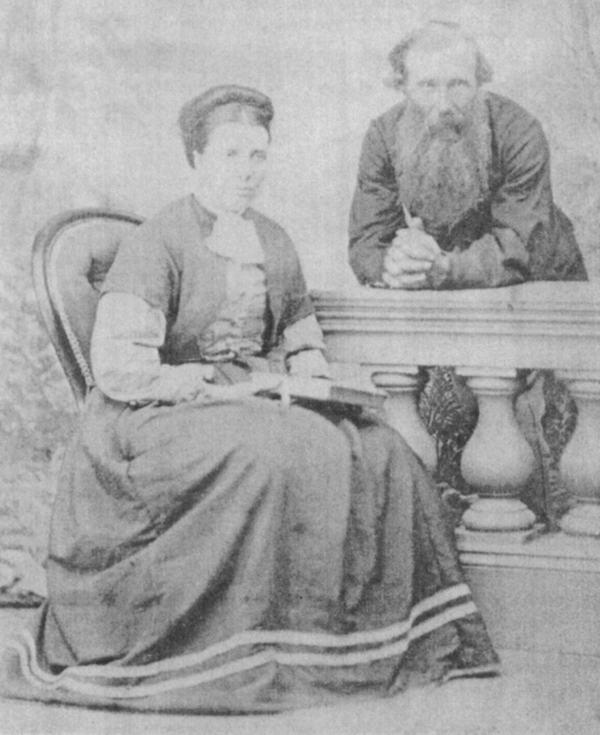
Agnes Robertson with her father Arthur Robertson
Agnes was the eldest of Margaret and Arthur's children and she was born at Scalloway, Shetland on 30 March 1838. Being the first-born girl she was named after her maternal grandmother Agnes Williamson. I have no stories about Agnes before she came to Australia.
Accompanied by her sister Margaret and brother Arthur, Agnes arrived in Australia in September 1867, after a journey of just under three months aboard the ‘John Temperly’. Agnes was twenty-nine years old and described on the shipping list as a knitter. John McCue tells us that Agnes provided a calming influence on the younger women she was travelling with when their ship was overtaken by a storm and the hatches battened down for several days. 1 After their arrival Agnes, Margaret and Arthur joined their parents at Derrinallum in the Victorian western district.
On 12 January 1870 Agnes married Michael Grace McCUE (1831?-1916) at Lake Tooliorook. The service was conducted by the Rev Edmund S Bickford, a Wesleyan Minister. Witnesses to the marriage were James and Arthur Robertson. Agnes and Michael had two sons and three daughters, Barbara (1871), Bean (1872), Arthur (1873), Aggie (1877) and Jack (1882). The family must have lived at Tooliorook for a time, as two of the three older children were born there. Later they took up land at Port Campbell where the two youngest children were born. It seems the marriage was not happy and Agnes is noticeably absent from family photos, which show Michael with some of his children. When their youngest
page 32
child was seven (about 1889), Agnes and Mick separated. Agnes and her eldest son, Arthur, lived at Smokey Point, while Mick lived with and cared for the other children in town, in a house on the corner of McCue and Lord Streets, Port Campbell.
The allotments shown are taken from an early Lands Department map and are referred to in the text.
page 33
Smokey Point, which is still a feature in the Port Campbell district, acquired its name from the Robertsons, according to Gus Ward. 2 Travelling by horseback to reach Port Campbell through the thick Heytesbury forest and coming out on the hill at Smokey Point gave the traveller a first sight of the ocean. It was customary to stop here for a rest and have a smoke before travelling down to the settlement.
We have lots of information and a lot of stories about Michael Grace McCue. The following account of his life has been put together from information supplied by his grand daughters, Marjorie Mathieson and Marion Parker, and other family members, as well as details gleaned from documents and rough notes left by John Collins McCue and supplied to me by John’s children, Jeff McCue and Helen Krigsman.
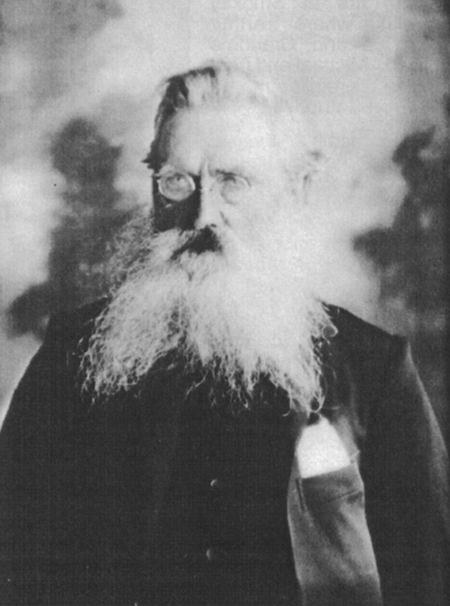 Mick was born at Ballinakill, Leix (pronounced Leash), Ireland, the illegitimate child of Margaret Grace. The date of his birth is uncertain but was possibly 29 September 1831. 3 On Mick's marriage certificate his mother’s name is recorded as Margaret Grace and his father's as John McCue, farmer. On his death certificate his mother is recorded as Margaret McCue nee McDonald and his father as John McCue, with place of birth as Queenstown, Clare. This is confusing. [Death certificates are notoriously inaccurate because the subject is not available to supply the appropriate information about themself!]
Mick was born at Ballinakill, Leix (pronounced Leash), Ireland, the illegitimate child of Margaret Grace. The date of his birth is uncertain but was possibly 29 September 1831. 3 On Mick's marriage certificate his mother’s name is recorded as Margaret Grace and his father's as John McCue, farmer. On his death certificate his mother is recorded as Margaret McCue nee McDonald and his father as John McCue, with place of birth as Queenstown, Clare. This is confusing. [Death certificates are notoriously inaccurate because the subject is not available to supply the appropriate information about themself!]
Michael Grace McCue >
When Mick was thirteen he went to sea as a cabin boy. He was in Waterford on 12 April 1849 when he enlisted in the British Army - 41st Welsh Regiment of Foot, whose headquarters at that time were in Cork, Ireland. His number was 2754 and he is described as being 5 feet 6 inches in height and aged 17 years and 9 months. Michael served in the Crimea War (1854-56) at Alma, Sevastopol and lnkerman and claimed to have seen the charge of the Light Brigade. We have the gruesome tale, handed down to his grandchildren, of him lying in wait for the enemy and chopping their heads off with a sword as they came through a narrow pass.
Michael was in lndia at the time of the mutiny in 1857. Other recorded postings included Cephalonia in Greece, 1851, Newcastle, 1861, and Sunderhead, June 1862. He carried the scars of two bullet wounds, one in his arm, the other where a bullet went through his nose and lodged in the roof of his mouth. He was granted a small pension - six pence for each wound, but the frequency of this rate is unknown. Both Marjorie and Jeff tell me there was a silver medal acknowledging the various campaigns Mick served in, but what has happened to this, no one seems to know.
Mick ended his army career in India and was discharged at Agra on 20 January 1867 - good conduct, 1 penny a day - having reached the rank of Quarter-Master Sergeant with his own batman to attend to him. From lndia, Mick migrated to Australia, arriving at Geelong, Victoria from Calcutta aboard the ‘Eldorado‘, on 30 March 1867. He is listed as British Army, aged 35 years. He was known at that time as Michael GRACE.
Marjorie Mathieson writes:
“He told my Dad [Mick's son, the Rev Jack McCue] he wrote to his ‘father and got permission to use [the] McCue name. We think his mother married John McCue (widower) the grandfather of the family. We were told a priest arranged a Michael Grace McCue marriage. Hearsay [claims] his biological
page 34

Cottage in Ireland
Where Michael McCue lived as a child.
father was English royalty. Marion visited the McCues in Ireland and they certainly knew of Michael and where his mother came from. Michael lived in a stone cottage that still stands on their farm. Kate put up a defensive wall against information and Marion was told he was a stray who came to the McCues in the potato famine. [There are] conflicting reports due to ‘shame’ of ‘no father’. My aunts had knowledge of his origins but kept secret. His mother disowned him when he married a protestant, however, Grandma McCue [Agnes] wrote to her when her children arrived and she wrote back. Letters destroyed in a fire at Smokey Point where Arthur McCue and Grandma lived. Michael and [the] other four children lived in Port Campbell. 4
Marjorie again, “Michael told Dad that his father John McCue was a very wild man who, when he had a disagreement with a neighbour, backed his horse into the neighbour’s door until it was kicked in.”
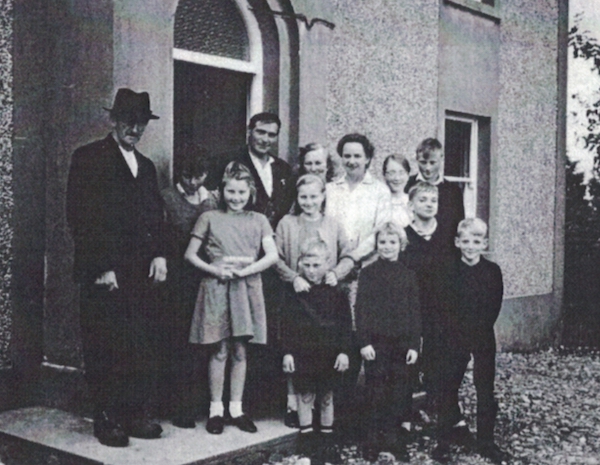
Parker Family and possible Irish relations
Left to right: Thomas McCue, son of Mick McCue‘s half brother. Thomas’ daughter and son in law Kate and Jack Hennessy and six of their eight children. Marion McCue Parker is in light colours and her three children are on her left in front, Marcia, Michael and John. Taken in Ireland in 1968.
Marion and Bill Parker and their three children visited the McCue farm at Ballinakill, Leix in September 1968. 5 There they met Thomas McCue, his daughter Kate McCue Hennessy, his son in law James Hennessy, and six of Kate's eight children. Thomas’ father (also called Thomas) was the half or stepbrother of Michael Grace McCue. During the visit Kate stressed that there was no blood relationship with her visitors. [Were they worried that Marion had come to claim an inheritance?] After Marion returned there was some follow up correspondence with the Irish McCues but this eventually petered out. 6
At Geelong it was customary for squatters to meet incoming boats so they could pick up workers, and this is how Mick found his way to Allen’s ‘Lang Currie’ station at Derrinallum. From there he
page 35
moved on to nearby Lake Keelunga Lara. He worked as a stonemason with the Robertson brothers, helping to build stone fences between Mortlake and Terang, west of Stoney Rises, and this is apparently how he got to know Agnes Robertson.
Hearing stories about Michael one cannot help but get the impression he was a cantankerous soul. One of his descendants described him as being ‘impossible to live with’. He drank heavily, which may have suited the Robertsons at the time they first knew him, but would not have fitted in with the squeaky clean image they presented after becoming evangelists. His other sins, in the eyes of the Robertsons, included being Irish and Catholic.
Michael is however, listed as a founding member of the Baptist Church at Port Campbell. Marion Parker tells the story of his baptism and conversion to his wife’s religion with Michael saying, ‘Ah Agnes l never meant to do this, l meant to make a Catholic out of you’. And Agnes’ response, ‘Ach Mick you’d never do that’. It seems the Robertsons later ‘kicked Michael out of the church’, because of his drinking and godless ways! Michael returned to the Catholic Church in his later life.
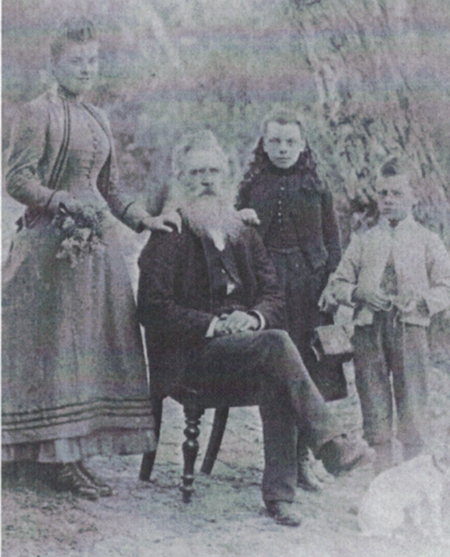
McCue Family >
Michael McCue with his children Robina, Agnes & John
We do not have as many stories about Agnes. She was musical and the possessor of a beautiful singing voice with a wide range. A photo of her in old age shows her wearing a coat and hat, firmly clutching a bag on her lap. I am told the photo was taken when she had been ill, so it would be unfair to judge her from this representation.
Barbara Rogers tells us, “Grandma McCue [Agnes] used to live at Port Campbell at Smokey Point in later years, with Uncle Arthur McCue until she went to live with Aunt Agnes Mott at Gama East where she passed away. Grandfather McCue [Michael] lived his last years with Barbara and Edwin Crouch at Panitya near Pinnaroo, SA. Nobody else would have him he was so obstreperous.” 7 Clive Crouch’s father told him that every Sunday Mick would put on his good clothes and go for a walk down the street at Panitya. It didn’t matter if the temperature was 105°F Mick would be dressed in suit, vest, tie and top coat, with hat and cane, and off he would go, giving his cane a twirl every few steps. 8
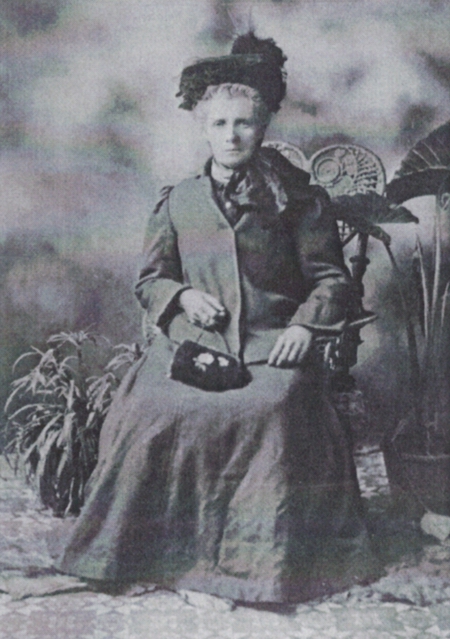 Agnes Robertson in her later years >
Agnes Robertson in her later years >
While living with the Crouchs, Barbara would only allow Michael an eggcup full of whisky each night. On one occasion however, he got on the grog and was making such a nuisance of himself, Barbara locked him out of the house. Mick kicked at the door shouting, ‘Let me in
page 36
Barbie, let me in’. Barbara sent one of the children to fetch Edwin from up the paddock to come and settle Mick down.
Michael died at Panitya at the beginning of 1916 and was buried at Murrayville by a Methodist minister! Barbara Rogers believes he died of gangrene after stubbing his toe. Agnes died, aged eighty-one years on 24 December 1919 and was buried on Christmas day in the Woomelang cemetery. There is a memorial to Agnes and Mick on the McCue grave at Port Campbell.
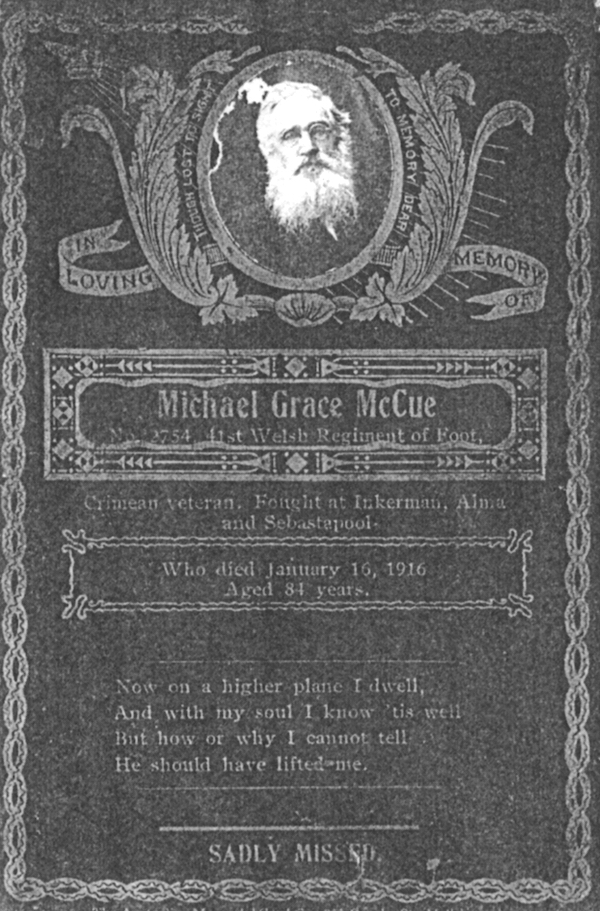
‘In Loving Memory Of’ Michael Grace McCue
1 John Collins McCue’s notes.
2 Interview with Gus Ward, April 2000
3 Documents are contradictory and in a letter Mareon Perkins, who is one of Agnes and Michael's great grandchildren, suggests the date is 1832, December 2000.
4 Letters from M. Mathieson, 1998/99
5 Telephone conversation notes with Marion Parker, 3.3.1999
6 Details about Michael’s Irish half-siblings are contained in Appendix 1
7 Letter from B. Rogers, 9.9.1999
8 Interview with Clive Crouch, April 2000
Appendix (not part of the book): documents and images relating to the military career of Michael Grace McCue
(This appendix was added to the online version of the book by Garry Gillard. The researcher and author is Diane Oldman.)
The first document is the record of a District Court Martial in Newcastle, Jamaica in 1857. For reproduction on this page, I've had to reduce images of all documents in size, and these two pages may not be easily readable. The line relating to Michael Grace reads thus.
Date of entry: 1858 January 1st; rank: Private; name: Michael Grace; Regiment: 41 Foot; where trial held: Newcastle Jamaica; date of trial: 7 November; nature of charge: Habitual Drunkenness; sentence: 56 days with hard labour & stoppages (meaning stoppage of privileges – usually the grog allowance); remitted: 28 days hard labour

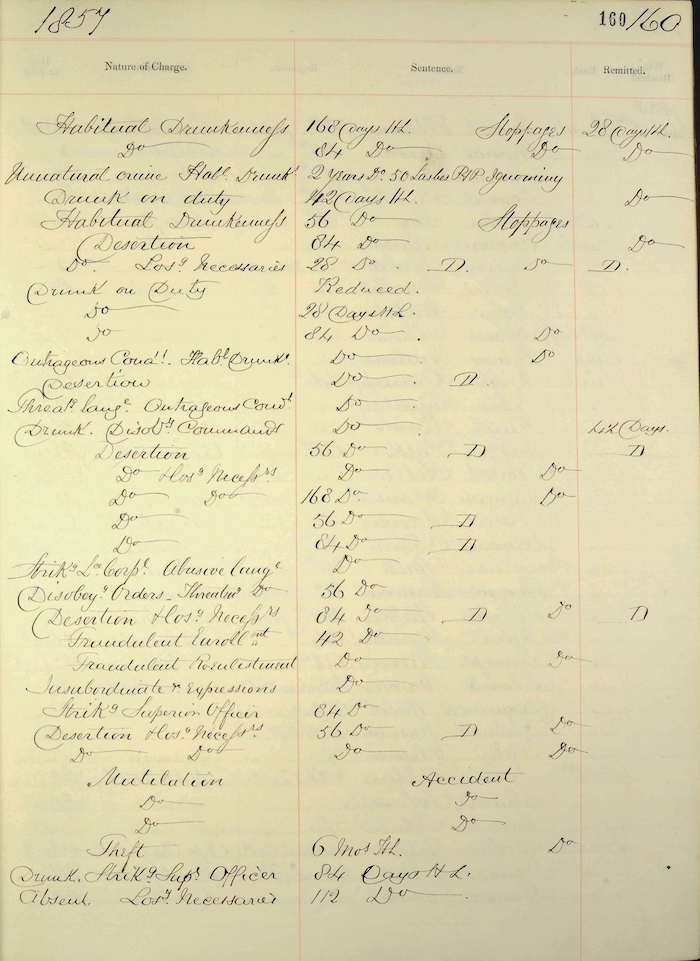
These are copies from the War Office series medal rolls from WO100-29. The documents show that Private Michael Grace was awarded the Crimea Medal with bars for Alma, Inkermann, and Sevastopol.
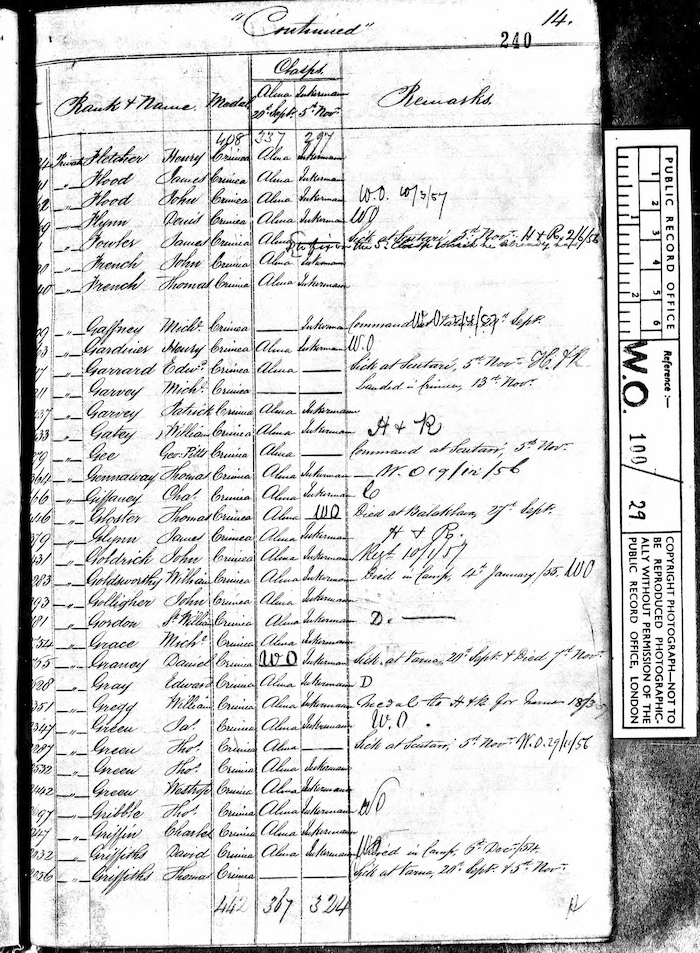
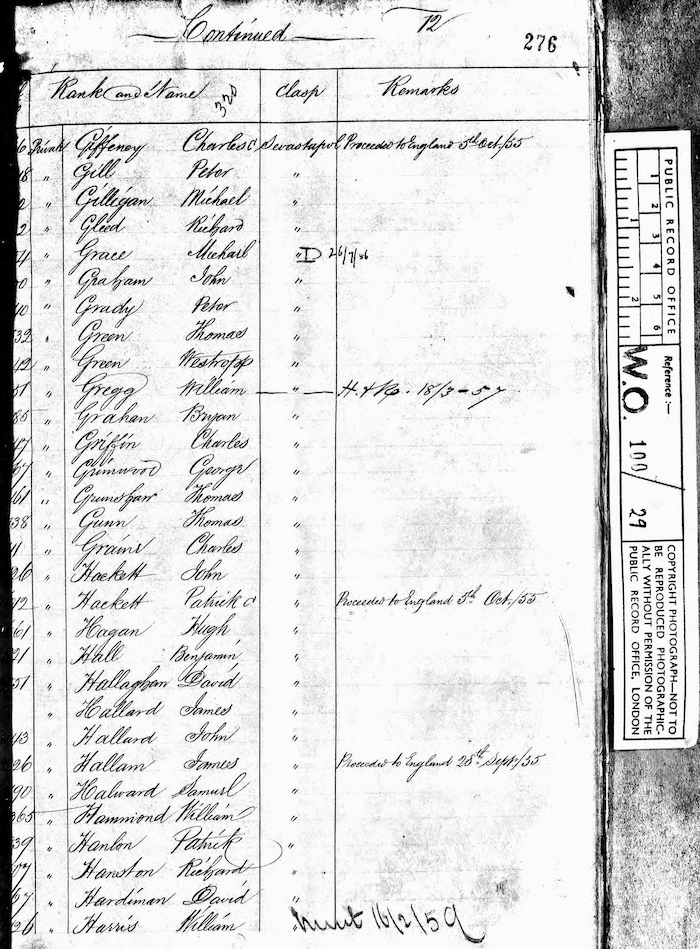
Below is a Crimea Medal with bars like those awarded to Private Michael Grace.

The following three documents have to do with Michael Grace receiving a Deferred Pension. Usually a deferred pension is offered at age 60. The first document indicates that he got 4d. (per day) on his DP (deferred pension). The date ties in with his sixtieth year.
The second is a record raised at the time of his discharge and examination for an invalid pension.
The third indicates he was entitled to a DP in 1881 – which seems to be a clerical error for 1891.
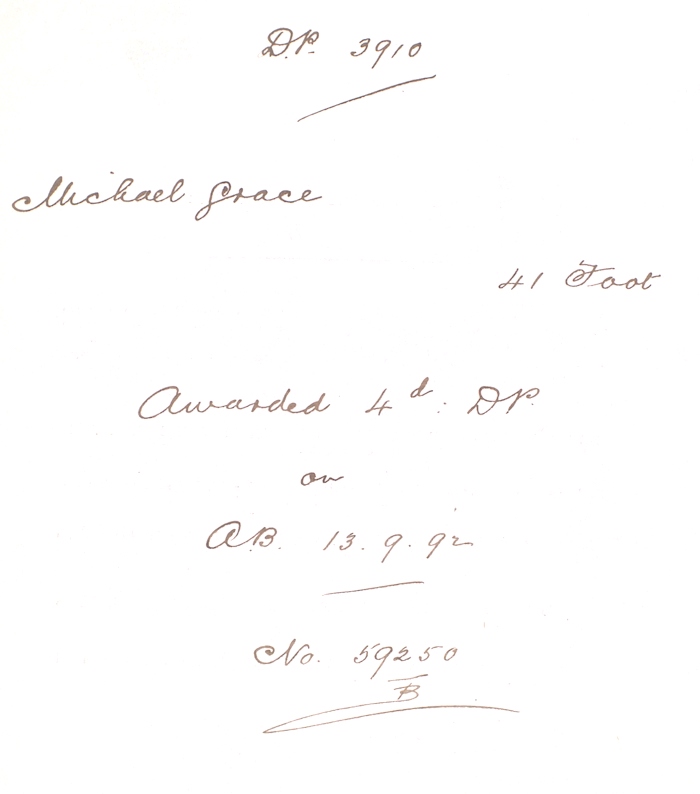
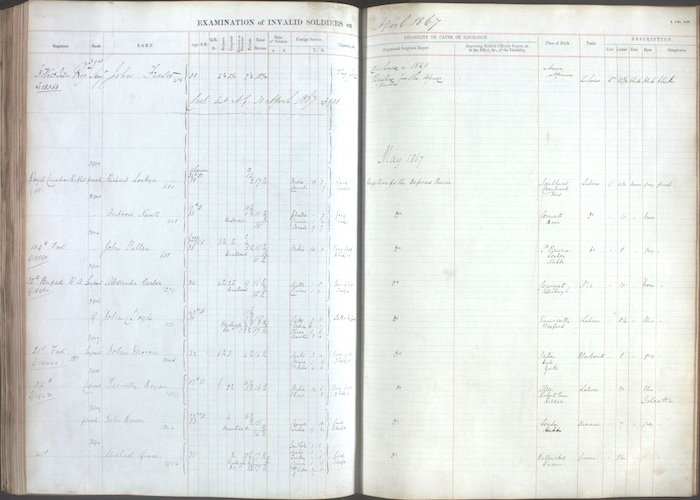
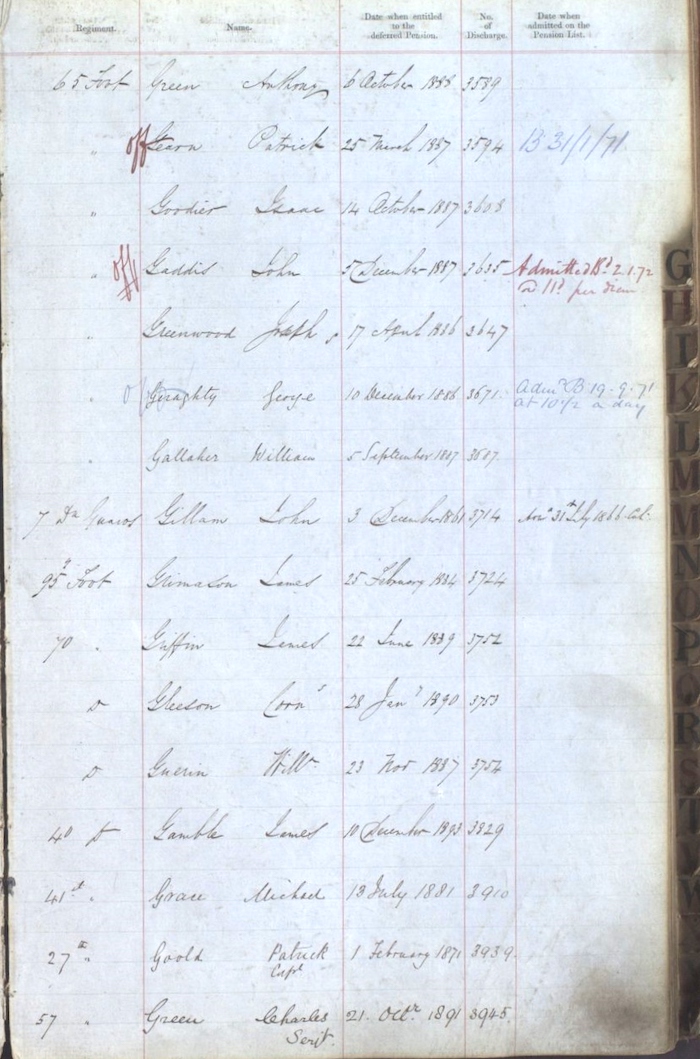
War Office series WO97 documents - records of the non-officer class of the British Army, retained when a soldier discharges to pension - the Chelsea Pension in fact.
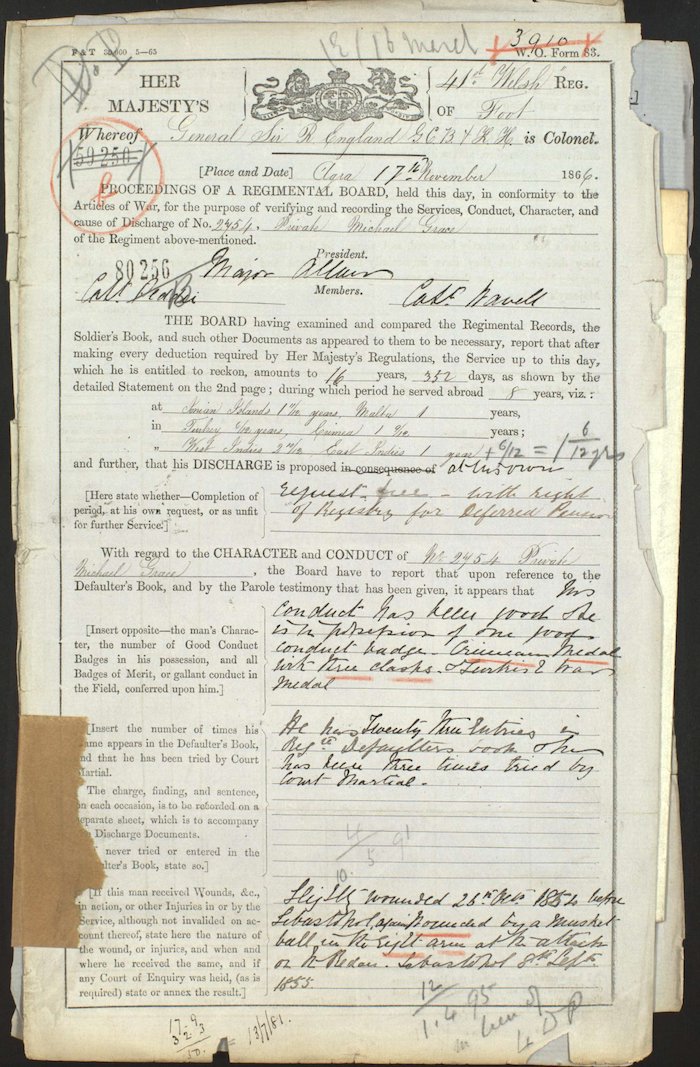
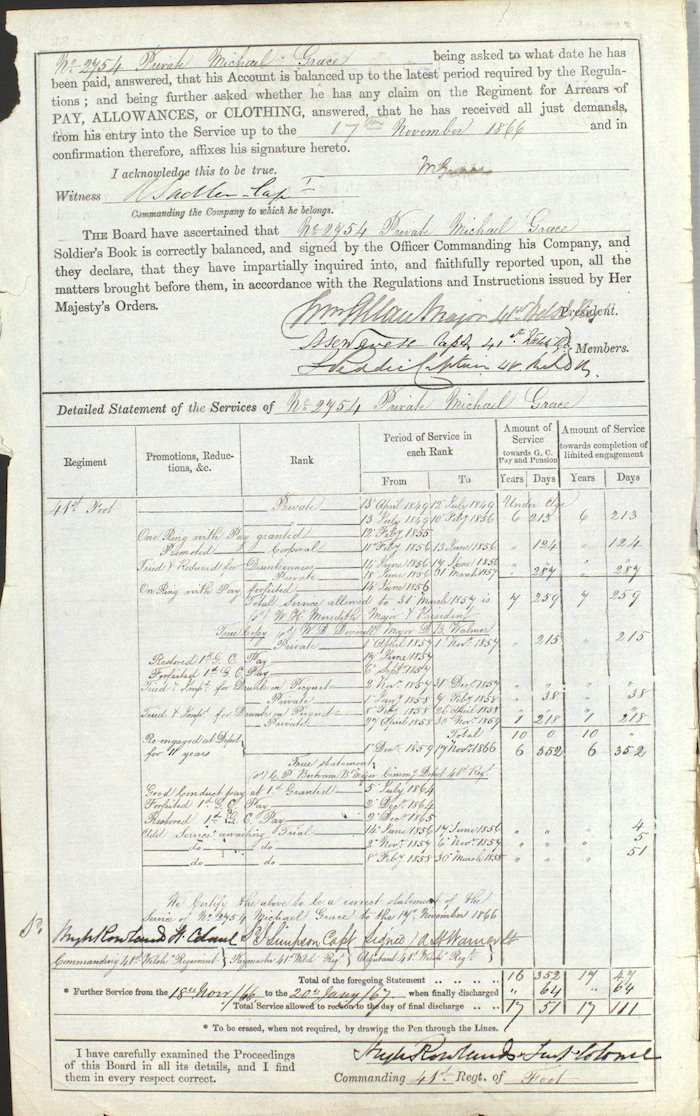
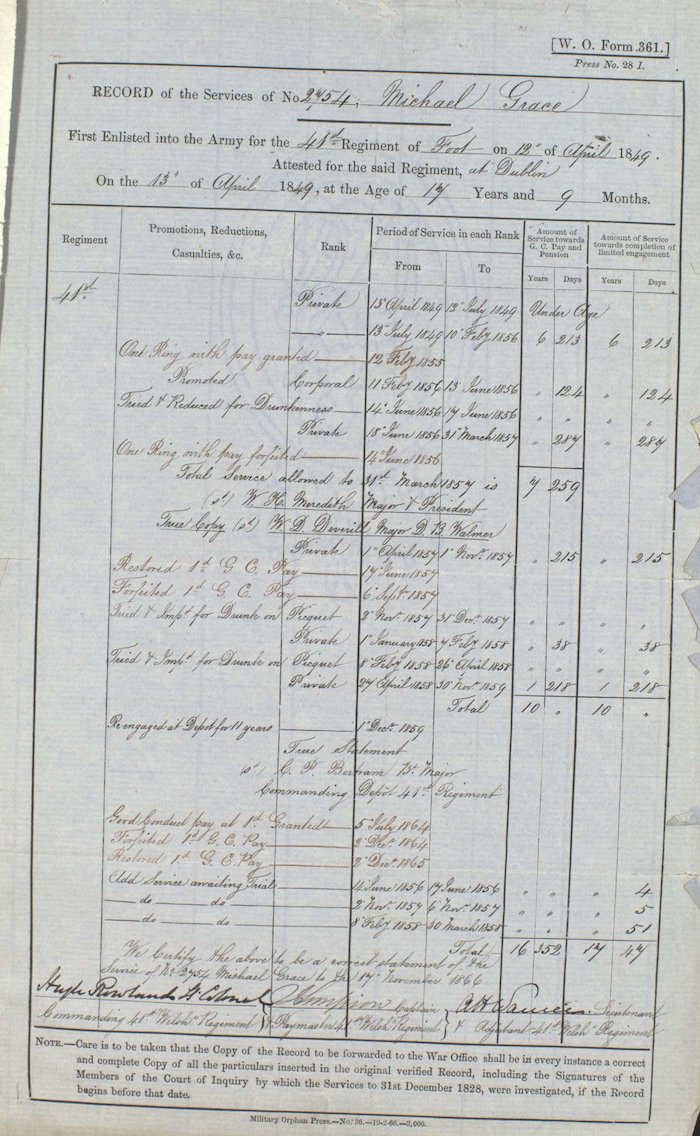
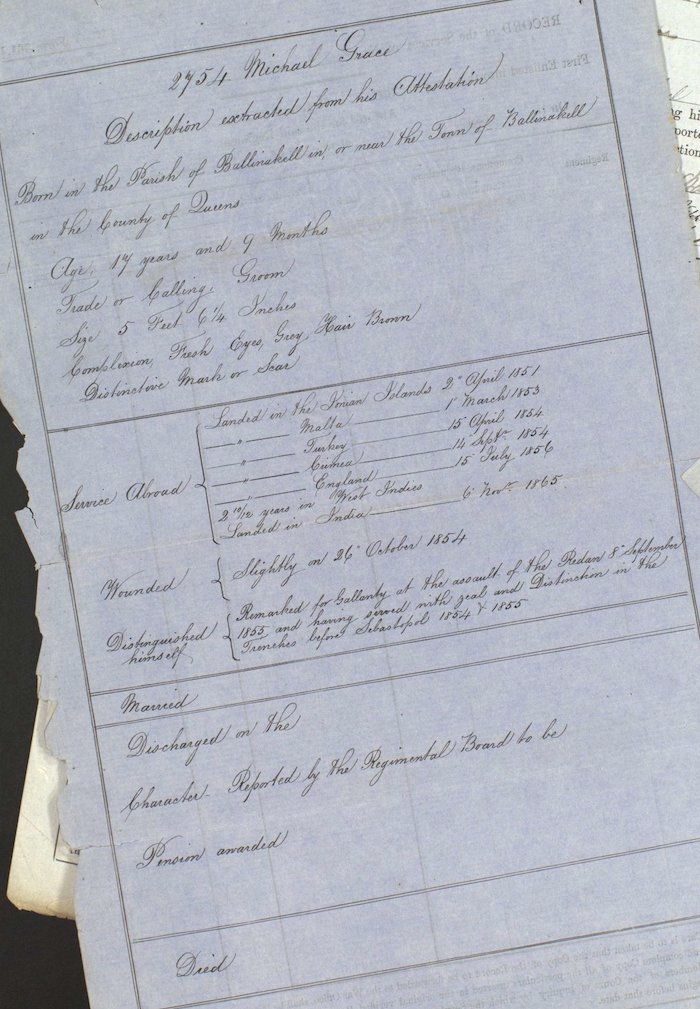
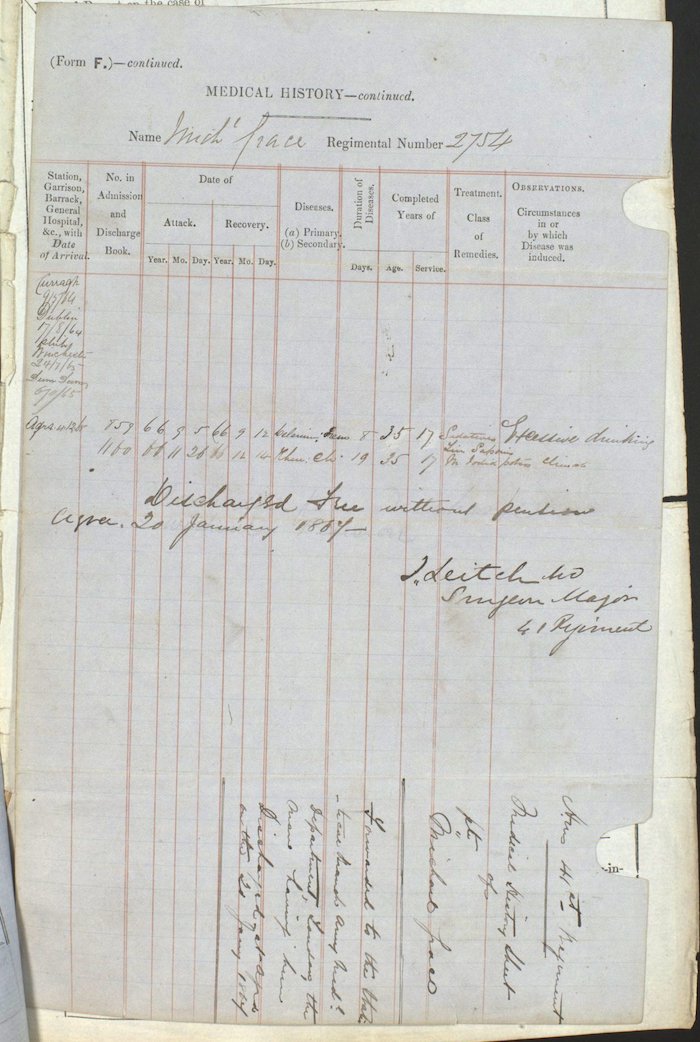
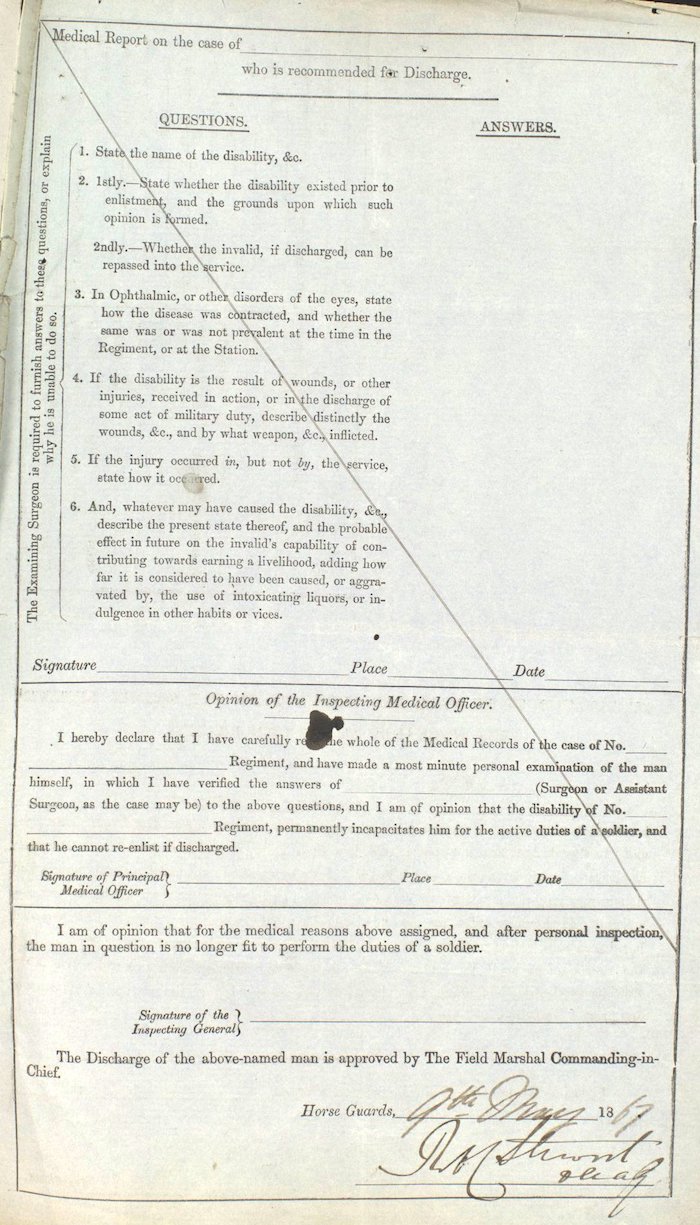
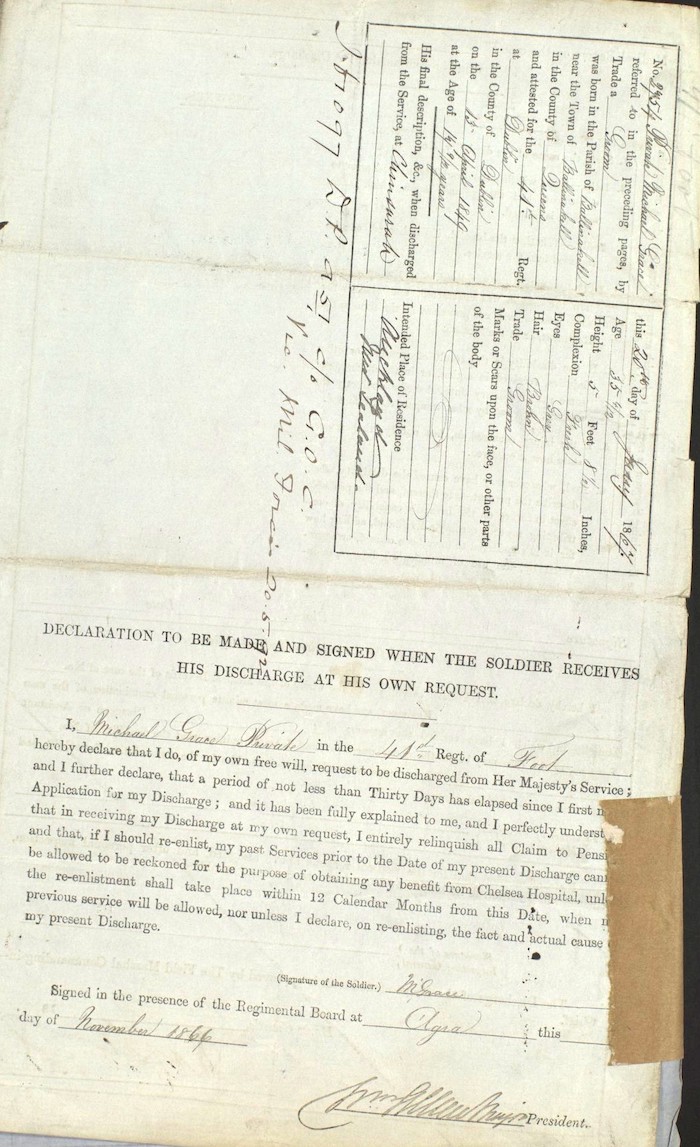

The remaining four pages are the attestation documents.
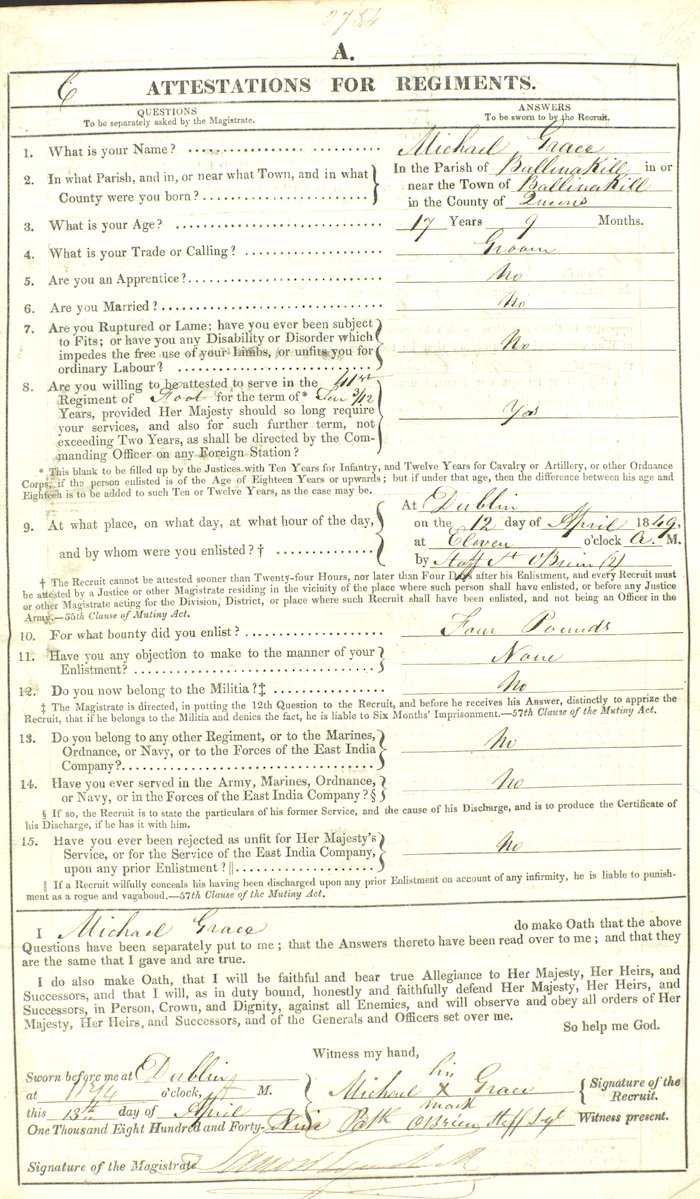
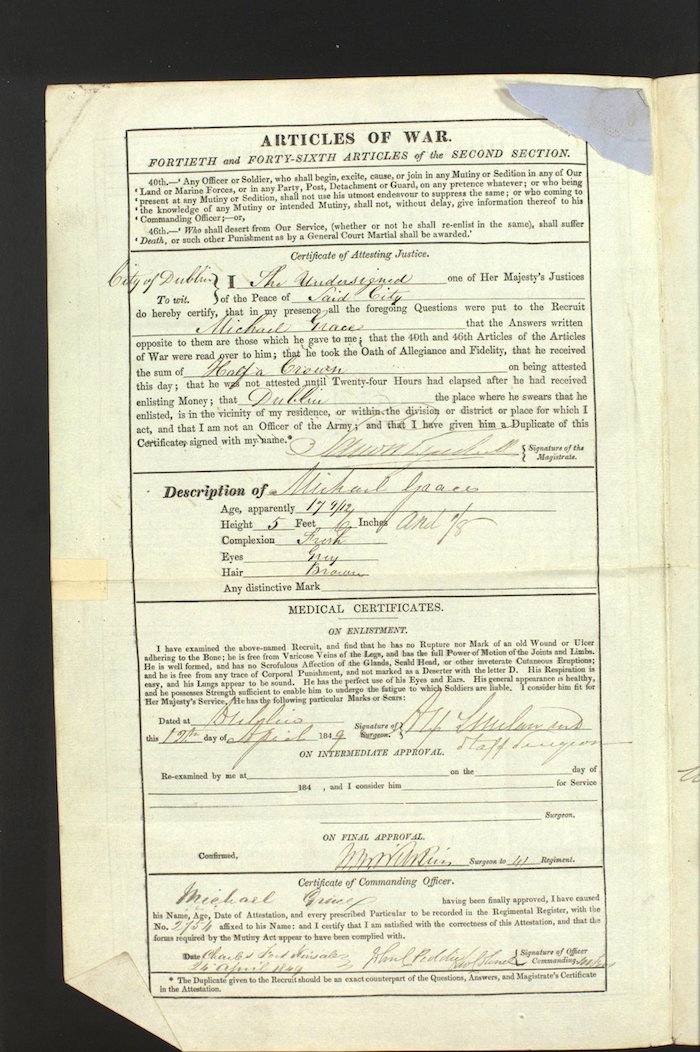
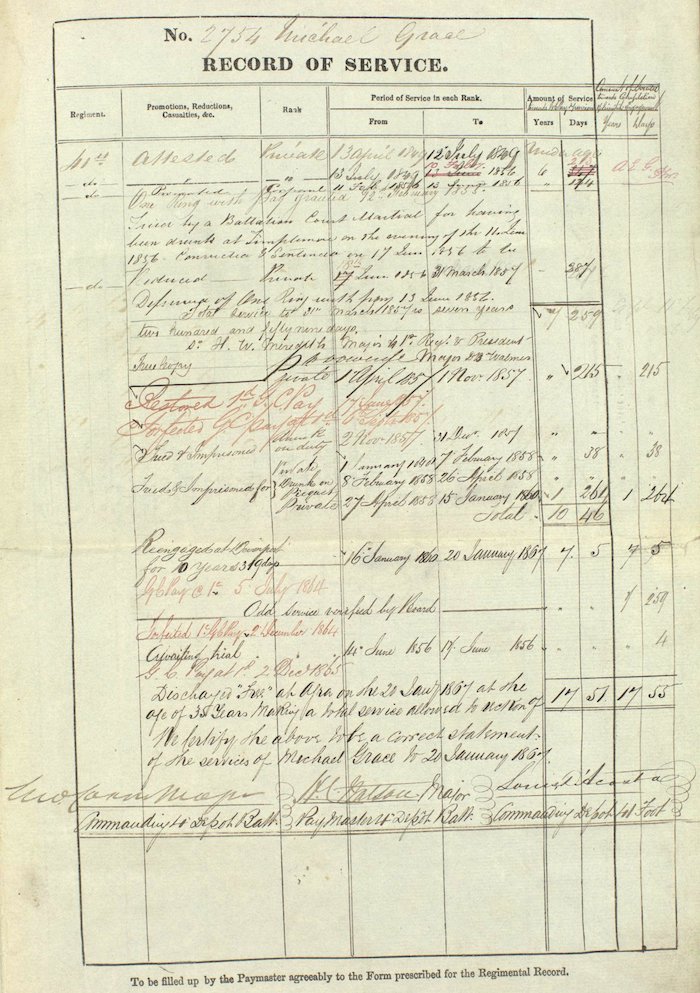
All of the above documents have been made available by the kindness of researcher Diane Oldman - to whom many thanks. See also her website for Crimean War veterans.
Born 1841 - Died 1905
James was born at Hellister, Shetland on 16 September 1841. As with some of his siblings we have an alternative date recorded and this is 14 October 1841. Named after his paternal grandfather, James was the third surviving child and eldest son of Margaret Henderson and Arthur Robertson.
James was both a fisherman and a sailor before coming to Australia. His grand daughter Margaret Haine tells us he had ‘sailed around the Horn’ on sailing ships several times before he was twenty. Climbing into the rigging he knew ‘one wrong step and I’ll be in hell’. We know for certain that he was a crewmember on the whaling ships ‘Polar Star’ and the ‘Agostina’ in 1858 and 1859, as his name appears in the ships’ records. In the second ship his age is given as nineteen years.1
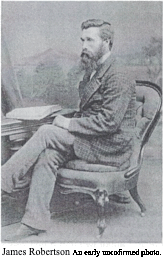 James was the first family member to join Arthur in Australia, arriving in Sydney in 1865. On 1 September 1868, James married Frances Mary HALLS (1848-1924) at Tooliorook, Victoria. Fanny was born at Blaxsall, Suffolk, England on 31 December 1848, the daughter of Edmund Halls and Eliza Abbott. On the marriage certificate James’ occupation is given as stone waller, his father’s as mason and Edmund Halls’ as publican. The ceremony took place in the house of Arthur Robertson (Snr?) at Tooliorook and was conducted by the Rev Sam Corrie, according to the rites of the Church of Scotland. Witnesses were Agnes Robertson and John Lillico (or Sillico?).
James was the first family member to join Arthur in Australia, arriving in Sydney in 1865. On 1 September 1868, James married Frances Mary HALLS (1848-1924) at Tooliorook, Victoria. Fanny was born at Blaxsall, Suffolk, England on 31 December 1848, the daughter of Edmund Halls and Eliza Abbott. On the marriage certificate James’ occupation is given as stone waller, his father’s as mason and Edmund Halls’ as publican. The ceremony took place in the house of Arthur Robertson (Snr?) at Tooliorook and was conducted by the Rev Sam Corrie, according to the rites of the Church of Scotland. Witnesses were Agnes Robertson and John Lillico (or Sillico?).
Margaret Haine understands that Fanny was actually brought up by her grandmother. One of her treasured possessions was a sampler worked by her mother Eliza Abbott at the age of twelve in 1831. This was handed on to Fanny’s daughter Frances and then to Margaret Haine. The sampler, which is in a very frail condition, is now in my custody.
Fanny came to Australia in 1867, believing that in Australia it was possible to pick up gold in the streets. She sailed in the ‘John Temperly’, with James’ siblings, Agnes, Margaret and Arthur. The shipping list records Fanny as servant. She was travelling with two single friends and there are no other Halls listed on the ‘John Temperly’. Fanny became friendly with Agnes and Margaret and decided to accompany them when they joined their family in western Victoria. Her two English friends found employment in Geelong and later married men called Cooper and Wilson.
James and Fanny had five sons and three daughters, John, Abbott Arthur, Frederick, Frances, James Need, William De Witt, Alice and Miriam, born between 1869 and 1887. Alice died as a two year old and John died from pleurisy in 1891 aged twenty-one.
In “Mount Elephant, - a History of Derrinallum and Darlington Districts”, Arthur and James Robertson are listed as trustees for a site of 2 acres to be reserved for a Wesleyan Church in
page 38
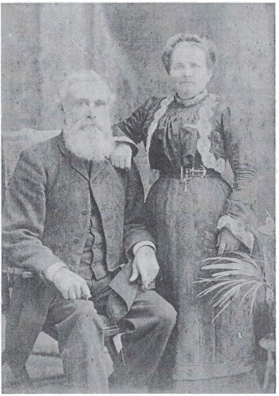 the township of Tooliorook. 2 However the date given for this is 1861 and as Arthur and his son did not arrive in Australia until 1863 and 1865, we must assume that either the 1861 date is incorrect or there was another family of Robertsons with similar names living in the Mt Elephant district. The five house blocks at Derrinallum township registered in the name of J Robertson in 1867, probably belonged to our James Robertson. 3 Neil Saunders wrote in 1976 about having visited Derrinallum in the late 1920s and mentions a “blue stone cottage standing alone. ... It was occupied by an elderly lady who told me that it once belonged to a Mr Robertson who built it for his bride, and who planted the large tree growing in front”. 4
the township of Tooliorook. 2 However the date given for this is 1861 and as Arthur and his son did not arrive in Australia until 1863 and 1865, we must assume that either the 1861 date is incorrect or there was another family of Robertsons with similar names living in the Mt Elephant district. The five house blocks at Derrinallum township registered in the name of J Robertson in 1867, probably belonged to our James Robertson. 3 Neil Saunders wrote in 1976 about having visited Derrinallum in the late 1920s and mentions a “blue stone cottage standing alone. ... It was occupied by an elderly lady who told me that it once belonged to a Mr Robertson who built it for his bride, and who planted the large tree growing in front”. 4
James Robertson and his wife Frances >
The various locations in which his children were born tell us that James never stayed in one place for long. James and Fanny were living at Ellerslie when their fourth child, Frances, was born in 1876. On his daughter’s birth certificate, James is recorded as ‘stonemason’. A year later at Woodford, his son’s birth certificate records him as ’labourer’. Documents in the possession of Margaret Haine indicate that James owned land at Ellerslie, which he sold to a James Need in 1878. Robert Robertson mentions that his brother James conducted revival meetings at Grassmere and Purnim, not far from Ellerslie.
James also took up land at Port Campbell and the official report following the inspection of his land by a mounted constable in 1874 (already quoted in Chapter 6) gives us a clear picture of an early selection. 5 The purpose of the inspection was to assess whether one tenth of the land was suitable for cultivation. James was not in residence at the time, working away from home at Mt Elephant.
The report describes, “A slab hut with bark roof, and slab and stone chimney, 18ft by 10ft, in good repair, erected about two and a half years. A paling fowl house with shingle roof 7ft by 5ft in good repair, erected about two years. About thirteen and a half chains of log and brush fence and about eight and a half chains of rough picket fence in good repair erected about two and a half years. About two acres grubbed and cleared and about six acres cleared by cutting dense scrub and collecting and burning dead timber. The land is very heavily timbered and covered with dense scrub. About 2 acres cultivated - crop potatoes. This area forms part of the land cleared. I consider that one tenth of the land is fit for cultivation”. I believe this land was later transferred to Arthur Robertson Jnr.
At some stage James went to the gold rush in Western Australia, but we do not have a date. In WA he suffered a serious illness, which convinced him that chasing gold was not what he was
page 39
supposed to be doing. He made a bargain with the Lord that if he survived he would return to Victoria to undertake evangelical work. While in the tent hospital in WA, James “had the joy of leading a fellow sufferer to the Cross”.6
In a letter headed ‘Camperdown, 27 August 1889’, James writes to the Rev S Chapman7 about the success of the missionary work he has been conducting. I have retained James’ spelling.
I Baptised 5 at a place called Pumborniet [Pomborneit] And I expect to Baptise 3 more soon. So you see the Lord has been with us. Now I need not tell you I am sorry to give this work up. But I must do so. To do this work I must keep a Horse, and to keep a Horse here meens 10/-s per week, this along with lost time travelling back and forward is more then I can stand out of My Slandar income. So I am fort to Sail My Horse. Now I thought it would be wise to write and let you know, because the placeses I have been holding will soon be fild by other Denomations, if you intend to make a start here Now (it seemes to me) is the time. 8
A second letter, dated 19 November 1889, is to the Rev E Harris and is written from 27 Langridge St, Middle Park, South Melbourne. In this letter James asks for assistance in obtaining a 'responsible position’ as a home missionary.
... I have been working for this last 14 years as home Missioner for our beloved Denominetation But hav never been recognised as such, because I was not payed by your home Misshon, Nor did I want to, because I could soport my salf and do all the work that was to be done in my Nebourhood. But now, as you know, I have come here with my family. The main rason for me doing so is that I may give all my time to Evangelesitek work.
The family was probably still living in Melbourne in 1891, as this is where their eldest son died in March of that year. On John’s death certificate his father’s occupation is given as 'boarding house keeper’. Margaret Haine understands her grandparents had a boarding house in Mildura at one time but cannot give us a date. Possibly it was Fanny who ran the boarding house while James was doing other things such as joining the gold rush in WA or travelling around as a home missionary.
Margaret Haine also told me that James and Fanny sponsored one of Fanny’s relations, possibly her sister, to come to Australia. Fanny made James wear white gloves when they went to meet the ship when it docked in Melbourne. The relation did not like Australia and returned to England. This might have been about 1900. The family was certainly living at Moonee Ponds, a Melbourne suburb, in 1903 when Frances Jnr was married.
By this time James had joined the Evangelical Society and was again serving as a home missionary, travelling extensively around Victoria, preaching and holding open-air meetings.9 While undertaking a mission at Natte Yallock, James contracted influenza, followed by pneumonia. He died at the Methodist parsonage in Avoca, on 23 October 1905 and is buried there.
It is not clear where Fanny lived after James’ death. All her sons had left home, Frances was married and living in Queensland and Miriam also moved to Queensland. This would have left Fanny on her own. She made a trip to visit her relations in England. Neil Saunders writes, “I was 5 years old and treasure two postcards which my grandmother posted to me, one from Ceylon the other from Gibraltar, while she was on a voyage to England in 1908.”10 It seems Fanny’s son, Frederick, paid for the trip after finding a gold nugget in WA. Returning from England, Fanny supported herself by sewing and Margaret Haine thinks she lived with Cairns relations of the Robertsons in Victoria. Margaret remembers her grandmother coming to visit them when her family lived in Nambour.
Fanny accompanied her daughter Frances’ family when they moved to Sheffield, Tasmania after World War I. In Melbourne on the way to Tasmania, Fanny suffered a stroke and on arrival at Davenport she was taken straight to the hospital. She died at Sheffield on 22 July 1924.
page 40
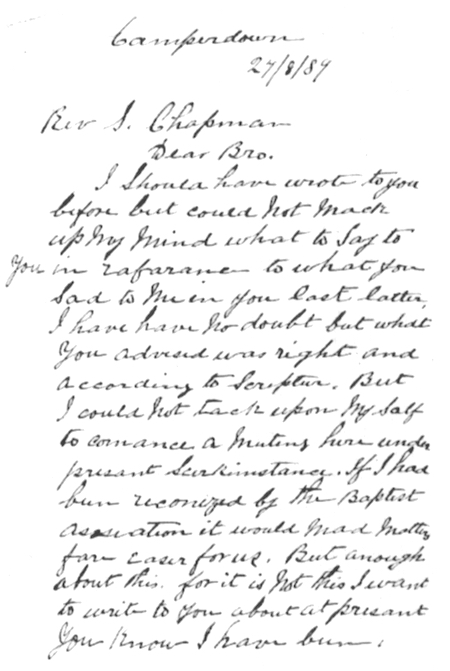

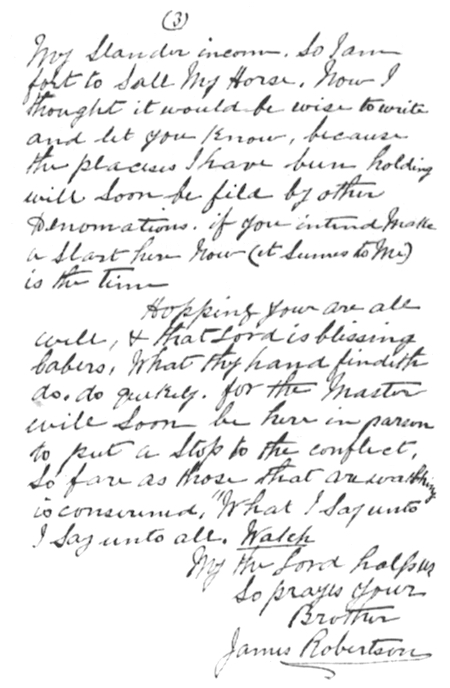
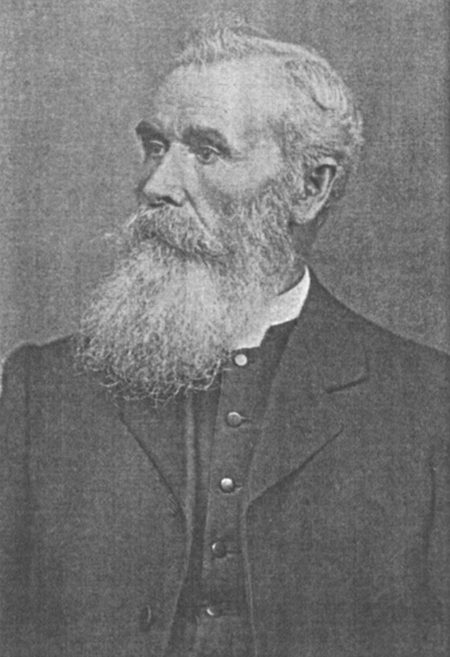
Letter written by James Robertson to the Rev. S Chapman
James Robertson in later life
1 Shetland Archives
2 P. McGregor and L. Oaten, ‘Mount Elephant - a History of Derrinallum and Darlington Districts’, p.50
3 Section 5 - Lots 5 to 9 - Information obtained by M. Magilton from Victorian Lands Department records
4 Letter from N Saunders to J McCue, 13.4.1976
5 A copy of the report was obtained by M. Magilton from the Public Records Office in Melbourne, it is reproduced in Appendix 4
6 R. Robertson, The Port Campbell Revival’, p.21
7 The Rev Samuel Chapman was Chairman of the Home Missionary Society in Victoria.
8 Copies of the two letters from which I quote were supplied by Matthew Magilton, who found them in the Archives of the Baptist Historical Society while doing research into the life of his relation James Magilton, who was also a Home Missionary
9 The Australian Evangelist’ No 24,24.11.1905
10 Letter from N. Saunders to John McCue, 12.6.1975
page 41
Born 1848 - Died 1925
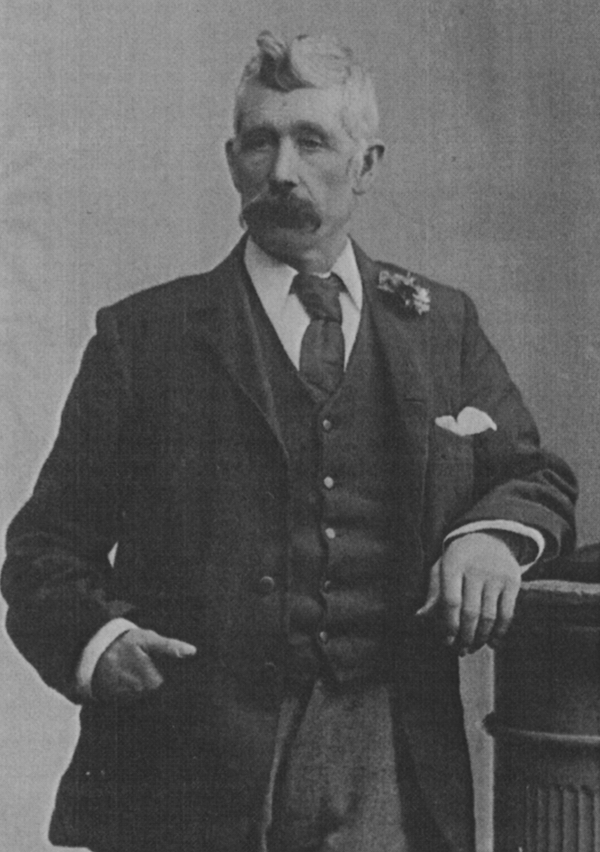
Arthur was born at Hellister, Shetland on 22 June 1848, the fourth son and sixth surviving child of Arthur Robertson and Margaret Henderson. He came to Australia with his sisters Agnes and Margaret on the John Temperly, arriving in September 1867. On the shipping list he is recorded as ‘farmer’, but it is understood in the family that he worked his passage, possibly as a helmsman.
At the age of twenty-seven, Arthur married Margaret Rutherford CAIRNS (1830-1914) at Margaret’s Derrinallum property, on 3 September 1875. Margaret was forty-five years old. Their only child, Willimina Jemima Edith (Mime) Robertson, was born two months later at Skipton. Margaret was a widow with twelve children. On the marriage certificate her occupation is recorded as ‘sheep farmer’, Arthur’s as ‘stonewaller’. One of the witnesses was Arthur’s brother James. The name of the other witness is illegible.
Margaret was born at Bridge of Allan, Scotland the daughter of John Rutherford (a doctor of medicine) and Margaret Stewart. Five months before Arthur and Margaret were married, Arthur’s brother Robert had married Margaret’s daughter Mary Jane (Molly) Cairns (See Chapter 11.)
There seem to be two sides to the story of Arthur and Margaret’s marriage. My mother Lottie Dickins, who was the daughter of Mary Jane Robertson nee Cairns tells us, “Margaret’s first husband George Cairns planned that his children should be trained for professions and he left a will stating that his estate was not to be divided until the last of the children reached 21. However after their marriage Arthur and Margaret moved to Port Campbell and Arthur sold all the movable stock and equipment for his own use. The trustees of the will did not stop him.” 1
The impression Lottie got from her mother was that George Cairns’ children were resentful of Arthur’s action, because instead of being educated they had to work on the farm and got little when the estate was finally wound up.
The other side of the story comes from Marjorie Mathieson, who gained the impression from her father that the Robertsons thought Margaret Rutherford Cairns was onto a pretty good thing getting a young husband.
Arthur and Margaret moved to Port Campbell. Margaret’s younger children presumably went with them as Samuel and Kate Cairns are listed among the first pupils at the Port Campbell School in 1877. Her eldest son George Cairns also moved to Port Campbell and worked as a blacksmith as his father had done before him. Some of his descendants still live in the area.
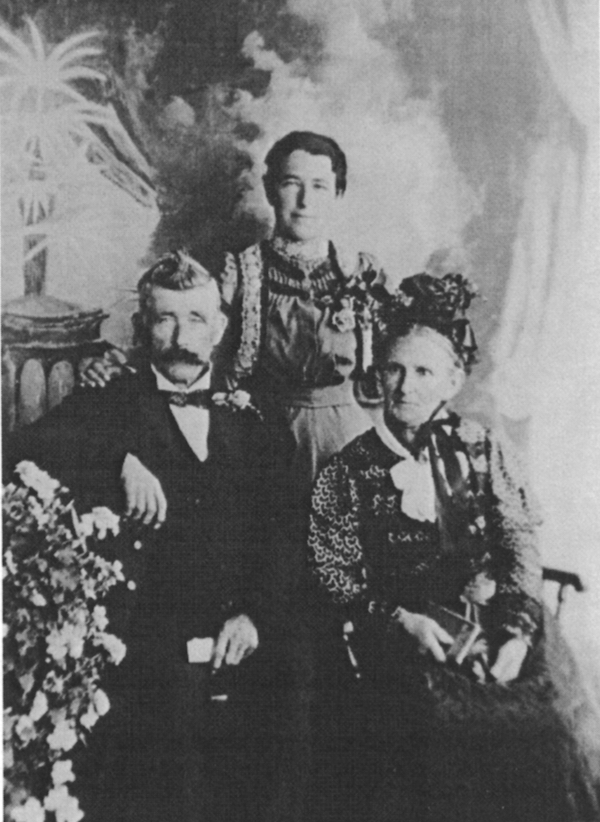
Arthur took up 18 acres on Lot 12, next to his father’s selection. This was not a large piece of land and money from the vegetables he grew would not have been enough to support the family. 2 Arthur had a shearing shed and he had a marine lease on the coast between the Sherbrooke River and Campbell’s Creek, which was about five miles long by one mile wide. Here he grazed sheep and he made more money from this than anyone realized, leaving about £1000 when he died.
< Arthur Robertson with his wife Margaret and their daughter Willimina
In December 1880, Arthur Robertson placed an advertisement in the Camperdown Chronicle: “a summer residence at the seaside of from one to five rooms can be obtained with or without boarding”. 3 This may have been Arthur Jnr or it may have been his father. Either way it looks as if the Robertsons were taking advantage of the growing development of Port Campbell as a holiday resort.
Like his brothers Arthur was an evangelist. In a letter to the Rev S Chapman of the Baptist Church, dated 29 October 1889, James Magilton writes from Yarma Station near Cressy, that he is “at present with Arthur Robertson conducting the Shearer’s Mission.” 4
Arthur was a member of the lifeboat and rocket crew at Port Campbell. The story of the wreck of the Fiji on 5 September 1891 at Moonlight Head, an uninhabited section of the coastline 16 miles east of Port Campbell, is related in several books. 5 Arthur was one of those attending the rescue operations and his brother Robert writes about the rescue in dramatic fashion:
As captain of the Port Campbell life-boat crew, Arthur, with his own team, rushed with the life-line to the scene of the wreck of the Fiji, and the crew came to shore, hand over hand, on that thin line through the
page 43
surging waters, sometimes on the waters and sometimes under the water - mostly under the waters - for seventeen of them were at one time on the line, all clinging and struggling for dear life in the briny, swirling waves. 6
Gus Ward told me his great grandfather’s story when I visited him in April 2000. The interview was recorded on tape and I have done a small amount of editing.
Arthur was in the rocket crew and they took the first cart, which was a spring cart, out to the Fiji, which was probably 4 to 6 hours drive, out to Moonlight Head and the Ocean Road, the track, went right on the cliff top. They got the first gear there with the rocket and the small equipment and were able to fire a rocket across the ship. And he [Arthur] was said to be the one to fire the rocket getting the light equipment across. It was his job. Now what I am telling you is authentic ’cause the man who told me this story was the Methodist home missionary from Cobden who was sent out to bury the bodies of the dead that were washed up the next day. He had to ride a horse from Cobden to Moonlight Head. Now what happened, the heavy equipment from Port Campbell had to be brought by horse and dray which was much slower and they set up a signal or a message on the cliff face to wait for a number of hours till the heavy equipment came. But the sailors decided to come hand over hand across the line to the shore, and there were eleven coming hand over hand on the line when a big sea came and took the lot of them into the sea and drowned the eleven. Later when the heavy equipment did arrive and they could get the breeches buoy across, they saved the captain and some others. The captain was brought in here and stayed in Arthur’s house for two or three nights until there was a train going from Camperdown to Melbourne. Subsequent to that, because my grandmother [Mime] was learning the organ, he sent her a gift of a music case, and I’ve seen that. It was beyond repair and had to be discarded eventually.
Lottie believed there was a film made of the Port Campbell rocket crew, with Arthur directing a practice with lifeboat and rockets. Robert, Lottie’s father, had seen this film and he mentions it in the section about Arthur in The Port Campbell Revival. I tried to locate the film through the National Film Archives and the Victorian State Library but have found no trace of it, nor of anyone else who has seen or heard of it.
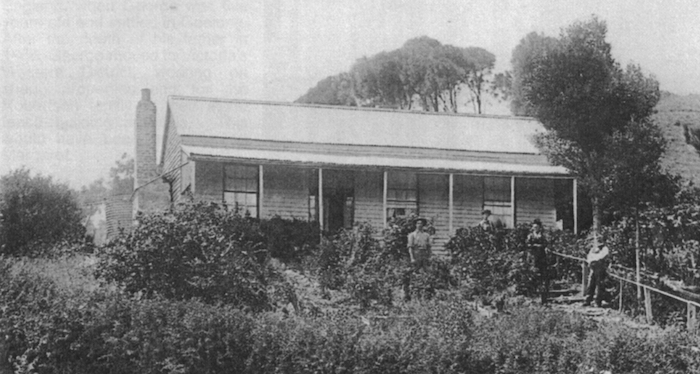
Arthur Robertson's house at Port Campbell
In the garden are from left to right: Chris Ward, Willimina, Margaret, and Arthur.
Margaret Rutherford Cairns Robertson died in 1914 at the age of eighty-four. She was an interesting person who sounds as if she had a strong character. She deserves a separate account of her life. Lottie felt close to her maternal grandmother and lived with her at different times. I have stories about Margaret Rutherford that Lottie has handed on to us. The lives of
page 44
her Cairns descendants are intertwined or run parallel with those of the Robertson descendants at Port Campbell.
In 1918 Arthur was married for the second time, to Eliza Perry GRIFFITHS, his housekeeper. Eliza, who was sixty-one years of age, had been previously married, had one child and was widowed in 1898. She was born in Monmouthshire, South Wales to Simon Jones and Margaret James. The marriage of Eliza and Arthur took place at ‘Blackwood Bank’, Port Campbell, in a service conducted by Baptist minister Walter Ward. The witnesses were Arthur’s niece, Ann Adie (Nan) Robertson, and his daughter Willimina Ward.
Arthur kept a rowing boat down at Campbell Creek. He would go out in this and guide incoming ships around the reef. He believed that one day it would be possible to dredge the swamp area in the lower section of Campbell’s Creek and make a good harbour. Two of the boats that used to come to Port Campbell in the 1920s were the Doris and the Gem. They carried about 100 tons of cargo, bringing in stores and taking out cheese, sheepskins and oats. The cheese came from factories at Lower Gellibrand and Princetown. It was brought down the Gellibrand River by barge, and from Princetown by horse and dray to Port Campbell.
By this time Arthur and his sister Margaret were the only generation ‘B’ Robertsons still living at Port Campbell. Arthur continued taking an active part in the local community. He is mentioned a number of times in Fletcher’s books about the Heytesbury Shire. As part of his missionary work he had the ‘oversight’ of the Port Campbell Baptist Church from 1892 to 1925. Arthur died at the age of seventy-seven in 1925. He and Margaret Rutherford are buried in the Robertson family grave at Port Campbell.
Until recently Gus Ward, one of Arthur and Margaret’s great grandsons was still living at Port Campbell, on land selected by his great grandfather. According to Gus’ brother Chris Ward, this land did not revert to the family until after the death of Arthur’s second wife. 8
1 From notes dictated by Lottie Dickins to Marie Nemec
2 Interview with Gus Ward, April 2000
3 J. Fletcher, The Infiltrators, p.252
4 A copy of this letter was supplied by Matthew Magilton who found it in the Victorian Baptist Historical Society records. At Robert Robertson’s suggestion James Magilton is writing to ask for work with the Home Missionary Society. James Magilton worked as a home missionary until his death from tuberculosis at the age of twenty-nine, in 1894.
5 For example: M. McKenzie, Shipwrecks ... and More Shipwrecks, McKenzie, Peterborough, Victoria, 1974
6 R. Robertson, The Port Campbell Revival
7 Interview with Gus Ward, April 2000
8 Letter from Chris Ward, February 2001
page 45
Born 1850 - Died 1925 - Married name CHISELETT
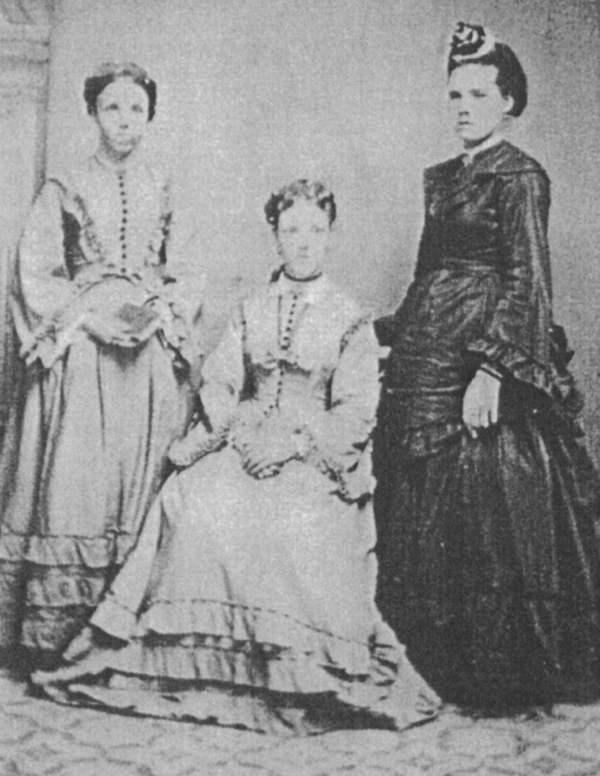 Born at Hellister, Shetland on 14 November 1850, Margaret was the third daughter and seventh surviving child of Arthur Robertson and Margaret Henderson. She would have been named after her mother. Margaret arrived in Australia in 1867 accompanied by her sister Agnes and brother Arthur. She was sixteen years of age and her occupation is given as knitter. The new arrivals joined their family in the Lake Tooliorook / Derrinallum area of Victoria.
Born at Hellister, Shetland on 14 November 1850, Margaret was the third daughter and seventh surviving child of Arthur Robertson and Margaret Henderson. She would have been named after her mother. Margaret arrived in Australia in 1867 accompanied by her sister Agnes and brother Arthur. She was sixteen years of age and her occupation is given as knitter. The new arrivals joined their family in the Lake Tooliorook / Derrinallum area of Victoria.
Margaret Robertson with two friends
Margaret is on the right >
At the age of nineteen, Margaret married George CHISELETT (1844-1894) at Tooliorook on 15 July 1870. George's family had come to Australia from Somerset, England, when George was five years old and settled in Geelong. After the death of his father in 1866, George moved to Victoria's Western district, working on sheep properties and for the Robertson family in their stone fence building activities. This would have been how he met Margaret.
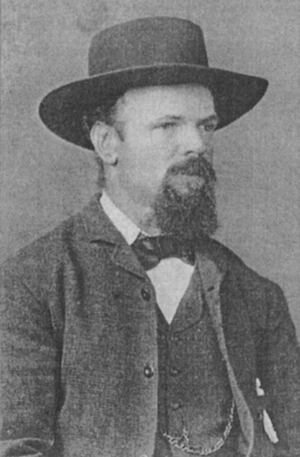 < George Chiselett
< George Chiselett
Margaret and George had eleven children including two sets of twins. Only five of the children lived to full maturity. These were Arthur (1872), Selina (1876), Muriel (18823, Ruth (1885) and Willliam (1888). Margaret's third child was stillbom and the first set of twins died soon after birth in 1884. Susan Chiselett, the fourth child, was working as a domestic in Melbourne in 1899 when she contracted typhoid fever and died, during an epidemic of the disease. She was twenty years old. Barbara, the youngest child, died of rheumatic fever in 1904 at the age of thirteen. Robert Chiselett (William's twin) was accidentally killed in 1909 when he was working in a quarry not far from Port Campbell. While blasting rock one of the charges failed to detonate. Robert went to investigate, only to have the charge go off and kill him. He was one month short of his twenty-first birthday.
page 46
Ruth Chiselett's son Gordon Croft, published The Chiselett Story in 1981 1 and from this we learn much about Margaret and her family. Margaret's first child was born at Tooliorook. The family then moved to Ellerslie where Margaret’s brother James was living, and the next two children were born there. Susan was born in Melbourne, but why Margaret was in Melbourne we do not know. By this time the rest of the Robertson family had settled at Port Campbell and Margaret and George joined them there in 1880. Margaret's younger children were all born at Port Campbell.
The ChiseIett’s first home at Port Campbell was a slab hut on flat ground adjacent to the cemetery. The family lived there for seven years. 2 In 1887, when Margaret's brother Robert moved his family away from Port Campbell, the Chiseletts moved into Robert's house on high ground 2 km further north along the road to Timboon. This would appear to be Lot 7 on the Lands Department map, which is marked in the name of G Chiselett, however Gus Ward tells me that this land was not cleared until it was eventually acquired by his grandparents Mime and Chris Ward, who lived there in a house called Blackwood Bank. 3
Gus believes the Chiseletts' house, called the 'Pines' - was in fact one part of Lot 7A, which is on the other side of the present Timboon Rd. Gus has provided me with a photograph of this house. l am not sure how this fits in with other information obtained from Gus Ward who tells us that Arthur Robertson Jnr either sold or gave a section of his land to Margaret on condition that if she sold it. Arthur was to have first offer. Perhaps this was the land east of the cemetery where the Chiseletts first resided at
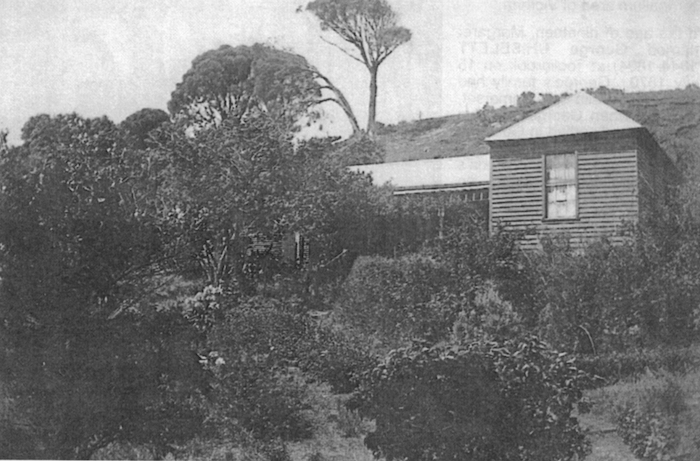
Chiselett House at Port Campbell in 1928
page 47
Port Campbell. In the event Margaret and Arthur had a falling out and Margaret sold the land to someone else. 4
From necessity George Chiselett spent much of his time working away from home. In 1894 he and son Arthur were working in Beulah where another Robertson brother, William Adie, was living. George suffered from asthma. While staying at Thorne’s Coffee Palace, he became ill and after a short illness he died there on 18 December. He was buried in the Beulah cemetery with the service conducted by William Adie Robertson. George's grave is unmarked.
Margaret continued living at Port . Campbell. Arthur Chislett was working away from home and by late 1900 he was married and living near Cobden. Selina and Susan left home to work as domestic servants in Melbourne. ln his book about the Chiseletts, Gordon Croft published two of Margaret's letters to her daughter Selina, at the time she was working in Melboume. Apparently unable to write herself, Margaret had to rely on others to write for her. In a letter dated 2 June 1900, she states - “I have been buying the papers for the last nine months as I could not get them from your Uncle as none of them come here, and I am not sorry. Arthur and your Uncle had a row and ordered him out of his house and so all of them is not coming.” 5 The Arthur mentioned was presumably Margaret's eldest son and we can only speculate whether the uncle mentioned was Arthur Robertson, as he was the only Robertson (apart from Margaret), still living in the area at the time. Of course the reference could have been to one of the Chiselett uncles.
 George Chiselett and Margaret Robertson Chiselett >
George Chiselett and Margaret Robertson Chiselett >
Selina married Henry Croft in 1904 and Ruth married Richard Croft in 1905. The two Crofts were brothers. William, who was the youngest surviving child after his twin brother Robert was killed in 1909, continued to live at home until 1911, helping to run the family's small farm. Muriel found domestic work in Melbourne but after Ruth married, Muriel returned home to live with her mother and help run the farm.
In 1923 Muriel married James Dickinson and moved to Murrayville. Shortly before her death Margaret moved to Camperdown to live with Selina and Henry Croft. She died in the Camperdown hospital on 18 October 1925 in her 75th year. She is buried in the Port Campbell cemetery.
From time to time Margaret would visit relations and Gertie Grace remembers Margaret Chiselett as big, tall and upstanding. “She was a trick of a woman that one. Very forthright and she didn't choose her words nicely either sometimes. The exact opposite of Grandma [Margaret's sister Agnes]. Grandma was very sedate and very religious. One day she was up home visiting Grandma and [my] Mum was rushing around. [Margaret asked]:
‘Agnes what are you making such a fuss for today?‘
‘I've got the minister coming for breakfast.‘
‘Those dills, I hate them devils’
‘Margaret, oh Margaret, how could you say that about God's ministers’. 6page 48
Seems Margaret did not have the same religious fervour as her brothers and sister and Gertie confirms this, “She wasn't of the same ilk, she definitely wasn’t, l don't know what was wrong with her.” I have been told George Chislett was a lay preacher, however his and Margaret's names are not included in the list of members who joined the Port Campbell Baptist Church before 1900. Margaret's brothers and sister are all listed as members, as is her eldest son Arthur. Maybe the hardships and losses in her life had made Margaret more cynical than her siblings. She has been described to me as a hard, cold woman with little sympathy for others. According to her grandson, Norman Chislett, Margaret expected to be waited on and would say to his mother, ‘You know Emmy, work will never hurtya', while she herself never did much. Norm believes it was Emma rather than Margaret who nursed young Barbara when she was dying of rheumatic fever.
To her son Margaret advised, ‘Keep the reins in your own hands Arthur, keep the reins in your own hands’, and this, according to his son Norman, is certainly what he did. 8
1 G. Croft,The Chiselett Story. See also Gordon's other book Croft Family History: 1803-1974.
2 G. Croft,The Chiselett Story, p.39
3 interview and correspondence with Gus Ward
4 Interview with Gus Ward. April 2000
5 G. Croft,The Chiselett Story, p.45
6 Interview with Gertie Grace, April 2000
7 Interview with Norman Chislett at Boundary Bend, April 2000
8 This seems to me a very Robertson trait. The Robertsons, both male and female. liked to be in charge of their own destinies and seemed keener about telling others how to behave, than to do the bidding of others.
page 49
Born 1853 - Died 1941
Born at Hellister, Shetland on 8 May 1853, Robert was the fifth son and eighth surviving child of Margaret Henderson and Arthur Robertson. There are stories about Robert’s early life in the section on ‘Life in Shetland’. As with those stories, much of the following information comes via his daughter Lottie.

Robert Robertson’s Box >
The box in which he brought all his possessions to Australia in 1866.
Robert was thirteen years of age when he arrived in Australia. All his belongings were contained in a small box made of Scottish pine. This box has neatly dovetailed corners and measures 45 x 27 x 23 cm. Over the years the box has been used as a toolbox and a saw bench, roughly repaired and painted. It is now in my custody and I have stripped the paint off and restored the box to the natural wood.
Soon after reaching Geelong, Robert broke his arm and was in the Geelong hospital. While in the hospital he was recruited to assist the medical staff with a man who had cut his throat and this experience gave him a lifelong dislike of hospitals. Robert moved with the family to Lara, then to the western district where Lottie believed the family had a property at Mt Elephant or Mt Violet.
Robert and Mary Jane CAIRNS (1859?-1942) were married by license, according to the rites of the Presbyterian Church at Derrinallum on 3 April 1875. The signature of the minister is difficult to decipher but his surname appears to be Ellerman. The marriage certificate gives Mary's age as fifteen, with consent for her marriage being signed by her mother. Robert is recorded as being twenty-two, a stone waller presently of Derrinallum but his usual place of residence as Port Campbell. The marriage was witnessed by Margaret Cairns Snr (her eldest daughter was also called Margaret) and Michael McCue. Mary Jane, who was known in the family as Molly as well as Mary, would have been about five months pregnant at the time of her marriage. She was the seventh child and third daughter of Margaret Rutherford and George Cairns. (See Chapter 9 on Arthur Jnr.). Molly’s date of birth is uncertain and several of the Cairns children seem to have been unregistered. I understand the day of birth is July 5 and to fit in with other children in her family it would have had to be in either 1859 or 1860.
Taking his wife to Port Campbell, Robert built a slab hut on the land he had selected. Lottie Dickins tells us, “Robert took contracts for building stone walls (farm fences) and stone sheds. Uncle Jimmie and his two sisters’ husbands [Chiselett and McCue] worked for him at different times. Molly and Auntie Frances [James’ wife] used to camp on the job with the men and do the cooking. Sometimes Molly was left by herself for days at a time - it was then the koalas would cry like babies and frighten her. Later when she had children she would be by herself with the children for long periods.” 1 Returning home one day, Robert found the house reduced to ashes
page 50
and the family's possessions destroyed. ‘There will be no need for me to take off my coat to start again‘ he is reported to have said, ‘because l have no coat to take off.' 2
The turning point in Robert’s life was the ‘Great Christian Revival‘ that swept through Victoria in the 1870s. Robert, along with other members of the family, heard the ‘call’, and decided to dedicate his life to
Piecing together the events of the revival and Robert's life as an evangelist is not easy. There seem to be a number of contradictions in reports from various sources. This includes Robert’s own version of events, published in 1937 - The Port Campbell Revival - from which I have already quoted extensively. Robert tells us he wanted to be baptised in Melbourne and the detailed description he gives of his meeting and subsequent contact with the Rev Samuel Chapman of the Collins St Baptist Church, suggests this man was an important influence on the person Robert was to become. Chapman came to Melboume from Scotland in October 1877 and he preached at Port Campbell in 1879, 3 so Robert's visit to him must have occurred some time between these two dates.
The minister's study was " at the back of the church. Making my way to the study door, l knocked and a clear distinct voice rang out, “Come in!" I was taken with the voice. I thought I detected a manly, cheerful ring in it. l opened the door and stepped into a cosy room, with a big coal fire burning in the grate.
“Sit down!” said he pointing to a chair on the right of the fire. He set himself down on a chair on the opposite side of the fire. Then we two men sat for a brief moment looking at each other and reckoning each other up. Mr Chapman was well groomed and well attired. He looked to me just the cultured city clergyman in a comfortable study as he looked at me, dressed as l was in a suit of “reach me downs," with hair and boots to match, straight from my forest home.
We looked to be very different men outwardly, but under all the externals we were alike in one trait, viz., in each of us there burned a desire to lead men to Christ. 4
From his obituary we learn that Robert had little formal education and started his working life as a tanner. He worked as a shearer and later as a shearing contractor. He continued working at these occupations while devoting ‘all his spare time in seeking the salvation of others.’ His brother Arthur supplied him “with teams and vehicles to do work in the shearing sheds". 5
page 51
Whether Robert means he was shearing sheep or undertaking evangelical work is not clear, probably both.
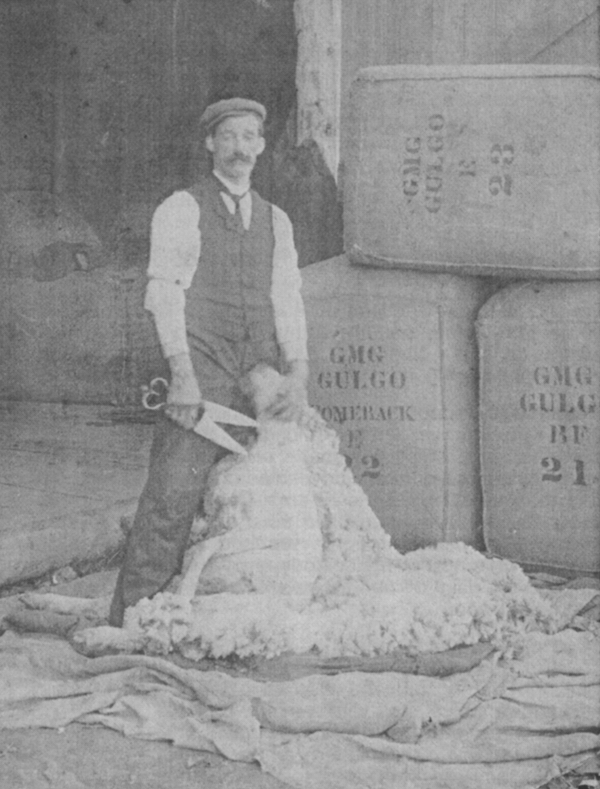
In preparation for the evangelical work he was to undertake, Robert studied English, Greek, Latin and Science. He was indeed a self-educated man and continued to study throughout his life, and encouraged the pursuit of learning in his children. He was never ordained, but was always known as either Pastor or the Rev Robertson.
Robert Robertson - the shearer >
We should not underestimate the role of Molly Cairns in encouraging Robert's evangelical work and shouldering the burden of raising her children very much on her own. Robert himself pays tribute to her in his writing and tributes to Robert rarely fail to mention the contribution to his work that his wife made. This is relatively unusual for the time when the role of a wife was rather taken for granted and left unspoken.
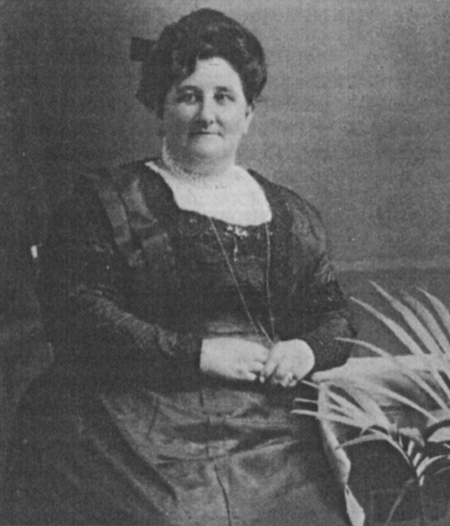
Mary Jane Cairns >
Robert and Molly had nine children, Rab, Nan, Josh, Arthur, Margaret, Glady, George, Lottie and Stuart born between 1875 and 1898. “When an epidemic of diphtheria visited the Port, Mrs Robertson had five of the children down with it at one time. By careful nursing she saved them all. There was as far as possible one free night in the week at her home, when the young people could invite their friends to the house. The evening would be spent in song and useful conversation; perhaps a reading or debate.” 6 Describing his mother to his daughter Pixie, Arthur Robertson said of Molly, ‘She might be doing some household task such as the washing and someone would come to the door and need advise or someone to pray for them and she would dry her hands off and leave whatever she was doing to attend to them." 7
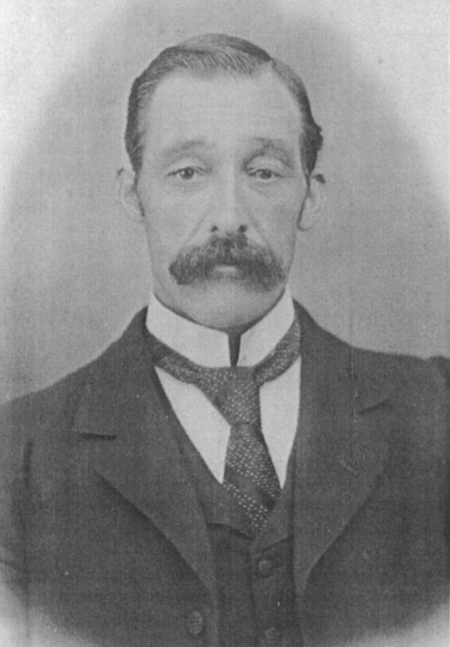
Robert Robertson - the evangelist >
Insistent that his children should be educated, Robert moved his family away from Port Campbell because the educational facilities there were inadequate. This, according to Gordon Croft, was in 1887. 8 Jack McCue told his daughter Marjorie that Robert gave away ‘his block of land at a revival meeting, much to his Aunt Mary's distress’.
The family moved to Chilwell in Geelong and then to Belmont where they lived for eighteen years. Robert and his brother James joined the Evangelical Society as home missionaries. From that time on, Robert was often away from home, travelling throughout Australia and New Zealand, preaching and holding revival meeting. Vickery, a wealthy Victorian manufacturer, sponsored the tent missions he conducted throughout NSW. He would be away for anything up to nine months at a time, and the trip to NZ was even longer.
page 52

Sacred Solos
The cover includes a portrait of Robert and his son Arthur.
Robert was a gifted and moving speaker as a story related in his obituary demonstrates. A tent mission he was conducting “completely stranded a theatrical company in one town, making it impossible for the play to get an audience. In desperation the manager appealed to Mr Robertson to close down for one night in order to permit the company to get an audience big enough to finance the show and let it get out of town." 9
Stephen Sharp in a tribute to the Rev Robertson writes, "His descriptive faculty was unsurpassed, and he made the scenes he depicted live before his audience. His style, in the highest sense, was dramatic, and it sat perfectly on him, but not of the kind that lent him to imitation." 10 Robert wrote poetry and hymns, the latter in cooperation with his sons Rab and Arthur. A selection of Sacred Solos written/compiled by Robert Robertson was published, probably in the 1920s.
An example of Robert's writing style is contained in a 1939 Christmas card to Lottie. The Shetlander‘s affinity with the sea still seems to be there for Robert in his old age.
page 53
Seasonal greetings - may 1940 be your best of all years - you are on the crest of the wave of life - we are, as the western bound vessels - vanishing behind the cloud banks of life's years. With torn sails, rent cordage and only now a wreck and soon will be upon the shore, telling there life's perils o'er.
Despite the many tributes made to Mary Jane, we must wonder if she was always happy with Robert's behaviour and absences from home. Robert himself writes, at times she had to stand with uplifted eye and hand, crying: ‘The way is dark, my Father take my hand, and through the gloom lead safely home Thy child.'" 11 Lottie spoke of hard times when her father was absent for long periods and the family had to live on charity. Sometimes Lottie was sent to stay with relations, including her maternal grandmother, supposedly for her health, but perhaps also to relieve the financial load for Molly. Barwon House where the family lived after leaving Belmont was apparently a ‘grace and favour’ residence and part of the charity Lottie spoke of. “What an unhappy time that was," according to Lottie. Arthur, Glady and Lottie were all married at Barwon House, between 1914 and 1916.
Robert's affiliation with the Baptist church did not always run smoothly. At one point he argued with the authorities over some issue - Lottie suggests it was to do with his relentless opposition to drinking and smoking - and went to work for the Presbyterian Church. When the Presbyterians brought in a retiring age of seventy, Robert, who was well over that age at the time, went back to the Baptists. Jack McCue, visiting his Uncle Bob and Auntie Molly in the early 1930s, found they had no income, so he gave over his pulpit with its fee of £3 to Robert. Jack took their case to the Baptist Union and was instrumental in getting Robert called to the Baptist Church at Merlyston. Finally it was back to Belmont (Peary St) and permanent retirement.
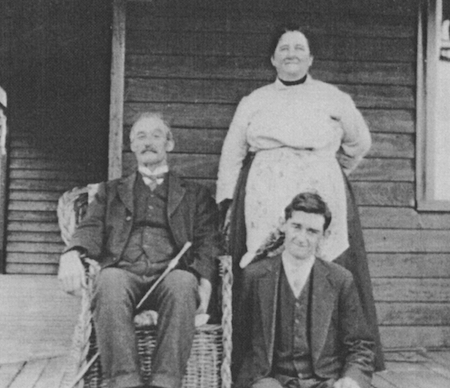 Robert and Molly Robertson with their youngest son Stuart at Dartmoor Manse in the 1920s >
Robert and Molly Robertson with their youngest son Stuart at Dartmoor Manse in the 1920s >
I was born towards the end of my grandparent’s life and only knew them as two old people we used visit at their home in Belmont, Geelong. I do not recall ever having a conversation with either of them, but I do remember the wonder of the music box that stood on a table in the front hallway. Marjorie Mathieson tells me that Grandpa used to keep a supply of the pennies in his pocket. These were needed to make the music play and he would hand the pennies out to visiting children. 12 On the other side of the fence, out the back of the house, there was a park with swings and slides and we children would be sent out there to play while the adults talked. In her old age Molly suffered from diabetes and dementia. In the garden at Peary St. red geraniums grew beside the path leading to the house and Molly was convinced they were little red men who came into the garden at night, ‘from over the bay’.
page 54
On the wall of the dining room at my mother's home in Melbourne there hung a fine photographic portrait of Robert in profile, taken in later life - white thinning hair and pince-nez glasses, head bent as he attends to the book he is holding. My mother Lottie Dickins adored her father. She told me that some months before his death she was aware of his presence standing at the end of her bed, even though he was far away in Geelong. She said that he told her he was ill and he would not recover.
Robert was the last surviving member of the family who had come to Australia from Shetland. He died at Geelong on 21 January 1941 and is buried at Port Campbell. Mary Jane died on 4 May 1942 and is also buried at Port Campbell.
Robert's mind was active till the end, as was his interest in life and the betterment of others. In 1937 Robert wrote, “The Federal Government should place two of our educated aborigines at Canberra as members of Parliament to represent the native interests. The Government should place there two cottages for the use of themselves and their families, paying the ordinary M.H.R. stipend to them. Under proper conditions, the race would increase. At present the conditions of our northern natives do us no honour. Were they in a mandated territory the League of Nations would have something to say about it. Our newspapers at times expose the seething filth forced upon our simple natives by sampan crews, whom our gunboats ought to chastise, and drive from our northern shores all such deeds and the doers of such deeds." 13
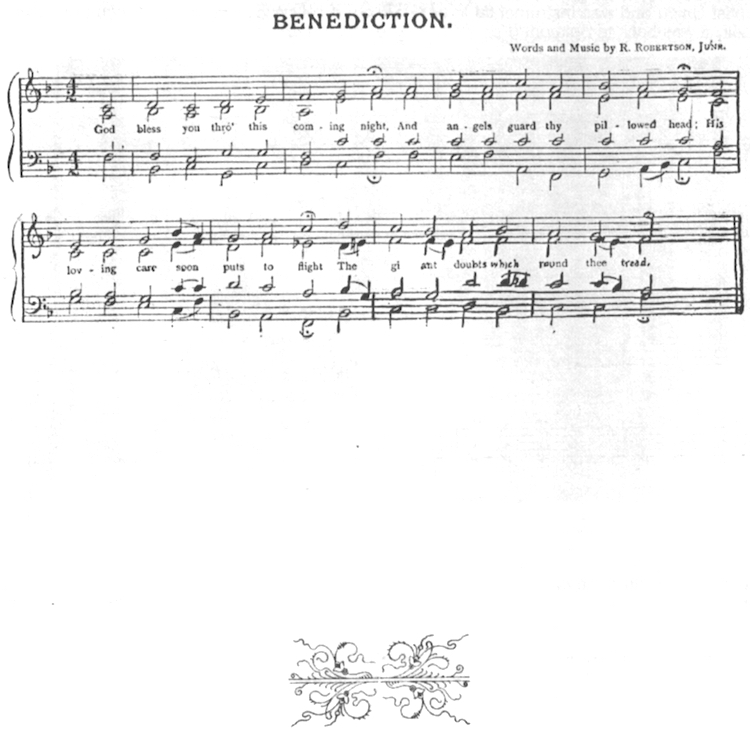
‘Benediction’ from Sacred Solos by R Robertson Jnr
1 Lottie Dickins, recorded by her daughters Marie Nemec and Margaret Worrall.
2 Paper cutting of Robert's obituary printed in the ‘Australian Baptist’, 11 February 1941
3 J.F. Wllkin, ‘Baptists in Victoria - our first century‘
4 R. Robertson, ‘The Port Campbell Revival’, p.33
5 Ibid, p.29
6 R. Robertson, ‘The Port Campbell Revival’. p 60
7 Interview with Pixie Robertson. March 2000
8 G. Croft. ‘The Chiselett Story". p.40
9 The Australian Baptist, 11.2.1941
10 Stephen Sharp, from a paper cutting kept by Lottie Dickins, dated 4.4.1941. The format suggests it is taken from The Australian Baptist.
11 R. Robertson, ‘The Port Campbell Revival’, p.59
12 Interview with M. Mathieson, March 2000
13 R. Robertson, ‘The Port Campbell Revival‘. p.63
page 55
Born 1858 - Died 1901
Although the family in Australia believes William Adie’s birth date to be 23 July 1858, Shetland records tell us he was born at Hellister, Shetland on 23 March 1858. He was the youngest child of Margaret Henderson and Arthur Robertson and he may have been named after a friend of his father. 1 William was eight when he travelled to Australia with his mother and brother, Robert, in 1866. William’s granddaughter, Beryl Oakes, has provided a photo of him taken about that time.
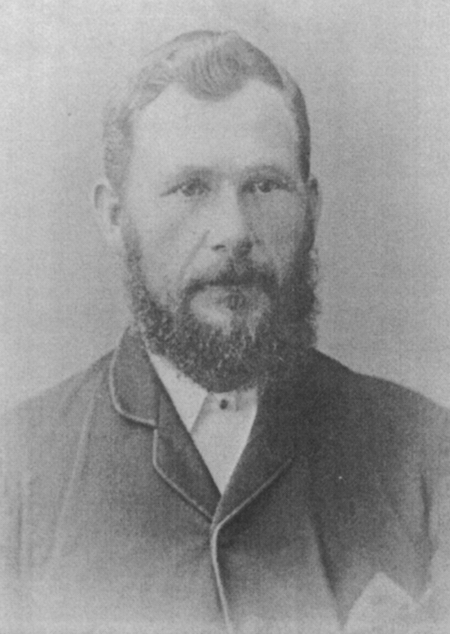
Comments I have read about Willie lead me to believe he was a much-loved younger brother.
William Adie Robertson >
Robert describes him as having “a high sense of justice and a strong sense of duty” and he “shrank honestly from leadership”. 2 William is recorded as one of the rescuers at the scene of the Loch Ard wreck in June 1878. One of the two survivors, Eva Carmichael, relates,
“In the darkness of the night a young man named William Robertson of Port Campbell and William Shields, under the superintendence of Mr Gibson, conveyed me up the steep lofty precipice. I cannot understand how they succeeded in bringing me to the top. It must have been a work of great difficulty and great danger.” 3 Beryl Oakes has a piece of the rope used in the rescue, which William kept as a memento.
Robert tells us the following story about Willie on the occasion of a visit to Beulah by the Rev Allan Webb, “The Yarriambeac was in flood and without a bridge to cross on. To keep the appointment at the Sunday services, William carried Mr Webb on his back through the flooded creek. Thus Mr Webb was kept dry to carry on the service.” Robert continues, “One of the horses William bred was his favoured hack. She would carry or follow him over anything he asked her to do, and on a pinch she would leave 80 or 90 miles behind her any day without a murmur if he wished her to do so, and after a good roll in the sand and a feed was ready to talk with her master about the next tramp on the work of the mission.”4
Willie was a farmer as well as an evangelist and several sources credit him with the donation of land for the Port Campbell Baptist Church, built adjacent to the cemetery at Port Campbell in
page 56
1885-86. ‘Victory,’ a hymn written by William in 1894 and sung to the tune of Annie Laurie, is included among the family writings. (See Appendix 5.)
In 1889 on 8 November, Willie married Jane MATHIESON (1858-1948) at Port Campbell. Jane was the ninth child of John Conely Mathieson and Catherine McMillan who had a farming property called ‘Woody Park’ at Princetown near Port Campbell. 5 An older sister, also called Jane, had died in 1856 at the age of two years. William Adie was first engaged to Jane’s older sister Kate (Catherine Isabella) and Jane was blamed for the break-up of Kate’s engagement. Her marriage to William caused a rift between her and the rest of her family. The marriage took place at the residence of Arthur Robertson in Port Campbell (whether Arthur senior or junior is not known) with Robert and Margaret Robertson as witnesses. Kate never married. 6 William and Jane had four daughters, Margaret (1890), Flora (1892), Ruby (1894) and Adie (1899). Also a son Willie (1896) who died soon after birth.
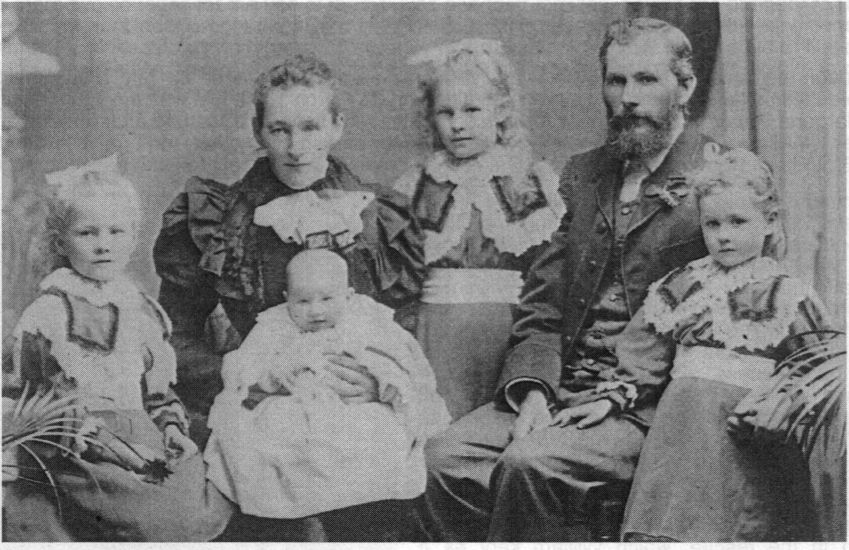
William Robertson Family, 1900
Left to right: Flora, Jane holding Adie, Margaret, William Adie and Ruby
Willie and his family moved to Beulah in 1892, and for nine years, William served as a home missionary for the Baptist Church, covering a large area in the district around Beulah, including Rainbow and Hopetoun. The story of his mission is recorded in The Romance of the Home Missions’ and the ‘Rainbow Jubilee Historical Outline’. 7 Both publications include a touching tribute to William written by the Rev N L Beurle in 1902. It is headed ‘Jonathan, a True Story of Home Mission Work’. Beurle was a young teacher when he first met William and he gives us this description:
... a man under forty, but with hair fast turning grey, and the look of one much older. ... His hat was lying beside him and the grizzled hair was matted in damp, disorderly masses round his hot brows. His sleeves were rolled up to the elbow, showing hairy and sun browned arms; his hands were broad and hard, evidently the hands of a worker. ... He had honest eyes; I never quite knew the colour of them, but they were grand fearless eyes, that never looked down in shame. His voice was kindly, with a good broad Scot’s accent.
page 57
Willie’s niece, Barbara McCue, lived with the Beulah Robertsons from about 1892 to 1901, and her brother Jack joined her there in 1899. Jack’s daughter, Marjorie Mathieson, tells us Uncle Will was responsible for encouraging her father to study after Jack McCue left home, and Jack is mentioned in the The Romance of the Home Missions as one of the men who assisted William on his preaching circuit. 8 Marjorie writes, “Aunt Jane was well known to us as children. Dad lived with them at Beulah. [Her] daughter Margaret was Mum’s bridesmaid, later lived, with her family, at Canterbury, Melbourne.” 9
At Beulah, William was fondly known as 'the Bishop’. The family’s house was built or perhaps just renovated and extended, with the assistance of labour, gifts and donations from William’s parishioners. It was known as 'Ex Dono’ (I am told this means 'out of gifts’). 10 A letter dated 4 February 1895, from Willie to Mr Walrond, secretary of the Home Mission, reports the completion of the house and lists expenses including - contractors price £50, varnish 5 shillings, carting loam 9 shillings, wall paper 6 shillings, and extra coat of paint £1/15/-. Willie comments, “...the Beulah manse will now be a little more worthy of the name now than it was before, and we find the increased accommodation a great blessing,...the extra coat of Paint is just what was needed and makes the House look splendit.” 11
Jane and William’s first child was born at Port Campbell. The other children were born at Beulah. William James, born in 1896, lived for only two weeks. He was buried in the cemetery at Beulah and after William’s death the baby was disinterred and placed in his father’s grave. William’s health deteriorated over a period of years and he died at Beulah on 17 September, 1901 and he is buried there. He was forty-three years old. William died of tuberculosis, as did two of his daughters twenty years later.
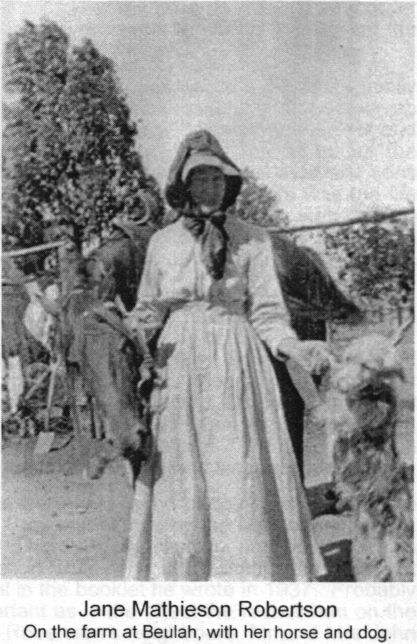
After William’s death Jane ran the farm at Beulah.
The farm provided the town’s milk supply. Jane was a physically strong woman, about 5ft 10in in height, with a ‘poker down her back’. She had worked on her parent’s dairy farm before her marriage and when she left home her father is supposed to have said that he ‘lost the best man I ever had’. There are two photos of Jane in working clothes taken between 1910 and 1920 - long skirt and a hat firmly anchored by a scarf tied under her chin. In one photo she sits on her horse sidesaddle - which is the way she always rode.
In 1920 and 1922 Jane lost her daughters Ruby and Flora to TB. In 1926 she left the farm at Beulah and went to live in Armadale, a Melbourne suburb. When her two remaining daughters Margaret and Adie married, it was arranged that Jane would live six months at a time with each of them. After staying with Adie for a time Jane visited her unmarried sisters Kate, Margaret and Flora, in Sale. While she was there she became ill, so Margaret took her home to Dimboola and she lived with the Horman family for the rest of her life.
Granddaughter Beryl remembers Jane with great affection as ‘a second mother’. She used to read the Bible to Beryl and discuss what they had read.
Beryl describes her as the “the truest Christian I ever came across”. 12
Jane led an active life, attending church regularly.
She helped Margaret in the house and loved working in the garden. Twelve months before she died Jane fell and broke her hip and became bedridden. She died in 1948. Her body was cremated and her ashes placed in William Adie’s grave at Beulah.
page 58
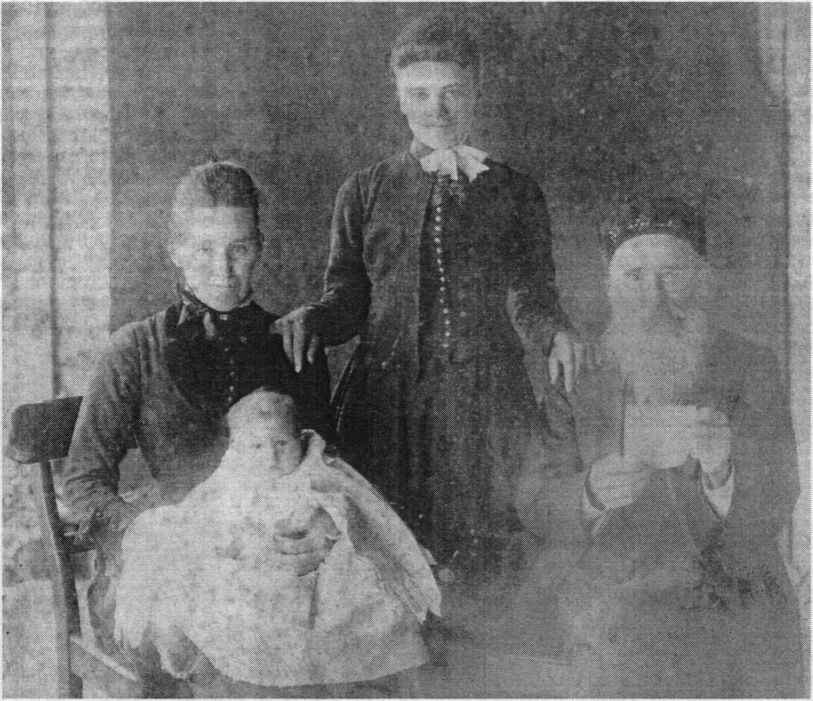
McCue-Robertson Family Group, circa 1890
Left to right: Jane (Mathieson) Robertson holding daughter Margaret, Aggie McCue, Michael McCue
1 See Chapter 4 detailing the life of William Adie’s older brother John Robertson
2 R. Robertson, The Port Campbell Revival’, p.25
3 M. McKenzie, ‘Shipwrecks ... and More Shipwrecks’, p.43, also D.E. Charlwood, The Wreck of the Loch Ard’ p.63
4 R. Robertson, The Port Campbell Revival’, p.25
5 See notes on the inter-relationship of the Mathieson and McCue families in Appendix 2
6 Information supplied by M Mathieson in November 1998, from Ainger Vincent (Vin) Mathieson’s history of the Mathieson family.
7 F.J. Wilkin, The Romance of the Home Missions’. The golden ‘Jubilee Historical Outline of the Rainbow District Baptist Churches’ was published in 1945, and is partly based on Wilkin’s book. See also F.J. Wilkin, ‘Baptists in Victoria - our first century'
8 F.J. Wilkin, The Romance of the Home Missions’, Chapter III
9 Letter from M. Mathieson, 1998
10 Interview with Maurine Port, March 2000
11 Copy of letter from W.A. Robertson to Mr Walrond supplied by M. Magilton
12 Interview with Beryl Horman, April 2000
page 59
The influence of religion and a fundamental Christian belief on the Robertson family will be obvious from what I have already written about their lives. The origins of this influence preceded their arrival in Australia. In the ‘Centenary History of the Port Campbell Baptist Church’ we are told that Margaret and Arthur and their daughters “had been converted under the preaching of the Haldane Brothers, Independent (Congregational) evangelists who had conducted missions throughout the Hebrides, Orkney and Shetland Isles”. 1 And several sources relate that Margaret Henderson’s brothers were preachers in Shetland.
A great deal has been written by various family members about the religious side of the family’s life, and there can be no doubting the faith and passion of these writers about the important role Christianity has played in the lives of the family. At the same time, for me as a recorder of events, it is sometimes difficult to sort out the rhetoric and flowery language used, from the reality of what actually took place.
On visiting the Port Campbell area for the first time and deciding this was the place the family might settle, Arthur is said to have “knelt ... and covenanted with his Calvanist God for an inheritance of land for all of his family”. 2 It would seem however, that although Arthur and Margaret continued their religious observance after arriving in Australia and Port Campbell, the boys of the family were not much interested. Frances Saunders writes, “Grandmother’s sons were approaching manhood and were still without God and without hope. Theirs was the life of the soil and of the saddle and the spur - when a thirty mile ride on horse back was only an added joy, if it brought them to young people’s gatherings where they could sing and dance and play the fiddle. Only the dawn brought them home from these nights of wild delusion.” 3 Seems young people have not changed much in a hundred and thirty years!
In a previous section I mention that Arthur Snr and James may have had an association with the Wesleyan Church in Derrinallum and Agnes was married there by a Wesleyan minister. James was married according to the rites of the Church of Scotland. With a scarcity of ordained ministers and places of worship in new settlements, it was probably a case of using whatever facilities and whichever authorized marriage celebrants were available. Different Protestant sects often shared the same building. This occurred in Port Campbell when the Union Church was built in 1879, and shared by Presbyterians, Anglicans and Baptists. The Union Church stood on the McKay property some 5 km inland from the coast. It has long since disappeared.
Before the Union Church was built, religious services were held in the parlour of the ‘old stone house’, “usually conducted by Mr Robertson [Arthur Snr], sometimes by the Missionary, whose circuit extended from Cudgee throughout the forest”. 4 There are slightly differing versions, which tell us about ‘the Christian Revival’ at Port Campbell in 1874, and the building of the Baptist church there. Robert gives his account of the Revival in the booklet he wrote in 1937. Probably the order of events and who did what is not as important as is the effect the revival had on the lives of those involved. Early converts included the Robertson’s neighbours, Mr and Mrs John Henderson, and Mr and Mrs Hector McIntyre, along with James, Robert and William Robertson and James and Robert’s wives, Frances and Molly. Frances Saunders gives an account of her father James’ conversion and also of how Robert overheard his mother praying for him. 5 Robert speaks devotedly of his mother’s faith and her pleasure at her sons’ conversions.
page 60
Music was an important part of the family’s religious observance. Robert writes, “All the family were musical and made family worship very pleasant. The four parts of music were very common at family prayer which was of a very simple form. A portion of Scripture was read, a hymn, psalm or paraphrase was sung, and then we all kneeled down and father led prayer. If he was absent, mother prayed. The prayer was brief and pointed, and extempore, I do not remember a prayer read or merely repeated in my father’s house.” 7
Seems not everyone was convinced of Arthur Snr’s Christian devotion. The Rev W McIntyre is reported as claiming, ‘Arthur Robertson is no Christian, he goes down the hall playing ‘Kathleen’.’ This same Rev McIntyre when preaching one day, stopped to admonish some of the boys in the group stating, ‘One of these days you boys gunna wake up and find yourselves dead.’ 8
The Port Campbell Baptist Church was constituted at a meeting held in the senior Robertson’s house on the 17 December 1884. Present at this meeting were the Rev S Chapman from Melbourne and the Rev A Steele from Warnambool. Members of the new church are recorded as James, Robert and William Robertson, James' wife Frances, two of his sons, John and Frederick, and Henry Buzzard. 9 I find it interesting that the names of Arthur Robertson Snr and Margaret Henderson are not recorded as members of the new church either then or later. We must assume they remained faithful to their Calvanist associations.
In his 1937 booklet, Robert takes credit for initiating and raising funds to build the Baptist Church on land near the cemetery donated by his brother William. Robert states however, “if it had not been for the cool, wise counsel of Mrs Robertson [his wife] I doubt even now if the Church could have been built”. The church building was completed in 1886 and the Jubilee programme tells

Port Campbell Baptist Church, on its original site near the cemetery
page 61
us it cost £90 and had seating for 80 people. In following years other members of the Robertson family joined the church. The names of Agnes and Michael McCue and their daughter Barbara are listed, as is Robert’s wife Molly, Arthur Jnr and his wife Margaret and daughter, Mime. We also find the names Magilton, Le Couteur, Mathieson and Ward - families that would be linked to the Robertsons by marriage. Margaret and George Chiselett’s names are noticeably absent, but Margaret’s son Arthur Chislett is listed.
The church building was eventually moved from its original site near the cemetery and is now part of the Baptist complex in the Port Campbell township.
Although the early membership of the church was never more than forty-five, the Baptist community at Port Campbell produced fourteen ministers, eleven of whom were descendants of Margaret Henderson and Arthur Robertson.9 James, Arthur, Robert and William Adie all became evangelists and/or home missionaries. In the next generation, three of Robert’s sons, Robert, Joshua and George, became ministers of religion, as did Agnes’ son, John Robertson (Jack) McCue, and her grandson, Arthur Crouch. James eldest daughter, Frances, married a Baptist Minister (Henry Ebenezar Saunders) and their eldest son, Henry McNeil Saunders, was also a minister. William Adie’s daughter, Agnes Adie, married the Rev Henry Roy Samuel Tunks. Ministers and lay preachers continue to appear down the family line as family members or their spouses.
Robert Robertson and Jack McCue were both well known during their lifetimes. Robert with his travelling evangelism, his tent missions and eloquent preaching, touched the lives of many people. Jack McCue was known for his temperance campaigning. His willingness to ‘take on’ the establishment often attracted the attention of the media.
Biographical material, religious tracts, hymns and poems written by family members attest to their Christian faith. Some of these are presented in the Appendix 5. Christianity continues to be a guiding influence in the lives of many Robertson descendants, although the churches they belong to are not necessarily Baptist.
There are other descendants who do not profess a Christian belief or have moved away from organized religion. What I find interesting about many of these people is the way they demonstrate the same energy and the same passion for whatever cause it is they espouse, as our forebears had for Christianity. There is plenty of evidence among family members of a strong social conscience and a desire to make the world a better place, although the path chosen to achieve this may be different in the diverse descendants of Margaret Henderson and Arthur Robertson.
1 J. McCue, ‘Port Campbell Baptist Church - History'
2 Ibid
3 F. Saunders, ‘My Grandmother’s Prayer’
4 Port Campbell Baptist Church Jubilee - Souvenir Programme’, author unnamed
5 F. Saunders, My Grandmother’s Prayer - The story of my fathers’ conversion’
6 R. Robertson, ‘The Port Campbell Revival’
7 Marjorie Mathieson, 8.2.99
8 ‘Port Campbell Baptist Church Jubilee Programme’
9 Newspaper cutting, dated 6.5.1961. The article is under the heading ‘In the Churches’ and marks Jack McCue’s 80th birthday. The name of the newspaper is unknown.
page 62

page 63
This section looks at the lives of Generation ‘C’, the grandchildren of Margaret Henderson and Arthur Robertson, all of whom were born in Australia. The chapters are arranged according to their parentage.
With the passing of the first two generations of Australian Robertsons, we find the lives and paths of their descendants beginning to diverge. Margaret and Arthur’s grandchildren married and came under the influence of other families. Many moved away from the Port Campbell area, and events, which were to affect all Australians, helped to shape a new generation.
On the whole, close family contacts were maintained in this next generation, with visits back and forth, long and short, between family members. Some lived in close proximity to their parents, siblings and cousins. Young people would be sent to live with older relations for health reasons, job opportunities or to help out when there were new babies or older folk to be cared for.
Other sections of the family maintained only tenuous contact with their relations. Two of James’ sons drifted off into the unknown and I have very little information about their lives. Another two of James’ sons, who settled in Western Australia lived in adjoining suburbs, but were seemingly unaware of the other’s presence near by. In the following generation, second cousins working in the Victorian police force were acquainted with each other but did not know they were related.
Today, the descendants of Margaret Henderson and Arthur Robertson are spread throughout Australia. Some have moved overseas. The only Australian state or territory where I have been unable to find any relations is Tasmania. There are still Robertson descendants living in and around Port Campbell. There are descendants who have maintained links with farming and those who choose to live in small country towns. However, like the majority of Australians, many Robertson descendants now live in cities.
Barbara Margaret Henderson McCUE (1871-1976) - MARRIED NAME CROUCH
Eldest child of Agnes Robertson and Michael McCue, born 7 January 1871 at Lake Tooliorook, (now Derrinallum) Victoria. Probably named after her mother’s dead sister. The name Henderson does not appear on Barbara’s birth certificate but she always believed it to be part of her name. The following details are pieced together from a variety of sources.
Barbara McCue attended the Loch Ard shipwreck at Port Campbell in June 1878. She and her sister Bean and brother Arthur ‘rode out through the backwater on their ponies, to view the wreck.’ There they saw the porcelain peacock that was washed up on the beach and is now in the Maritime Museum at Warrnambool.
From Barbara Rogers we learn, “My mother lived at Port Campbell and went to school there and when she was 16 years old lived with [her] Grandfather and Grandmother Robertson and cared for Grandma Robertson who was bedridden. She milked cows, took the milk to the creamery and did all the cooking and housework. She could not speak highly enough of Grandfather Robertson and her uncles, his sons”. 1 Marjorie Mathieson also tells us ‘Auntie Barb lived with Arthur Robertson [senior] to help with the work (milking cows, etc).’ 2
page 64
As a child, Barbara helped to steam and shape the arches for the windows in the Port Campbell Baptist Church and she was the first organist at the church after it was completed. Barbarasang with a fine soprano voice. Contained in Appendix 5 is a poem Barbara is thought to havewritten.
At some time during the 1890s Barbara went to live with, and keep house for her Uncle Willie and Aunt Jane at Beulah. Her mother Agnes suffered from hay fever and Lottie Dickins tells usthat Barbara, Bean and Aggie McCue all had weak chests and all eventually moved to the drierclimate of Northern Victoria. It was at Beulah that Barbara met her future husband. Barbara toldher youngest daughter they met at a cottage meeting where she was playing the organ. Edwinwalked in and Barbara said to herself, ‘this is the man I will marry’. Edwin described her as ablonde with blue Irish eyes. Seems it was love at first sight!
Barbara married Edwin CROUCH (1871-1950) at the Baptist Church, Beulah on 23 March 1898. The bride’s uncle, William Adie Robertson, conducted the service. Edwin was a cousinof Tot Collins, who would marry Barbara’s brother, John. Edwin was a farmer at Sea Lake andwas nicknamed Tim because he was always being helpful like Timothy in the Bible. The Crouchfamily - two brothers with their wives - came to Australia from Kent, travelling on the ‘Appolene’,which was the first ship to berth in the Port of Adelaide, on 12 October 1840.
Between 1899 and 1913, Barbara had nine children including two sets of twins. Stephen, who was a twin with Willie, died soon after birth and is buried beside Edwin Crouch’s sister, Ida Crouch, at Berriwillock, Victoria. Clifford (1910) died of Bright's disease in his third year and Clive who was Barbara Jnr’s twin, was killed in a riding accident at the age of seven. The surviving children were Arthur (1899), Ellie (1901), Willie (1903), Eddie (1905), Norman (1907) and Barbara (1913).

Crouch Family, circa 1911
Left to right: Michael McCue, Arthur, Willie, Edwin Crouch with his arm around Norman, Eddie, Ellie and Barbara (McCue) Crouch holding Clifford.
page 65
As a child of nine, Lottie Robertson was sent north because of a weak chest and she lived with her cousin Barbara for two years. This was at Woomelang and would have been about 1902.
Making a living in the Mallee was not easy and Barbara and Edwin seem to have moved about a lot; Willangie, Brim, and Woomelang. For a time Edwin worked on the construction of the railway line between Melbourne and Mildura, only coming home to his family at Woomelang a tweekends. During this period, when he was working about halfway between home and Mildura, his son Arthur developed diphtheria. There was no train so Edwin walked overnight along the line to get back to his family. Medical facilities were not easily accessible and families had to manage as best they could. Edwin’s mother (Elizabeth Crouch) acted as a mid-wife and was present at the birth of Raymond McLean, whose daughter Margaret, was to marry Barbara and Edwin’s grandson, Ken Crouch, many years later.
Edwin and Barbara Crouch >
Barbara and Edwin had a farm at Panitya and the three youngest children, Clifford and twins Barbara and Clive, were born there. Michael McCue lived with them at Panitya and died there at the beginning of 1916. Eddie Crouch told his son Ken, “the farm at Panitya was in a ten mile wide strip that ran from the Murray River and NSW border to the Southern Ocean, known as the ‘Disputed Territory’ as both Victoria and South Australia claimed it, the border not being in line with the NSW/SA border for some reason”. 3
The Panitya farm did not prosper. The land was good but the block was not big enough to support an income. Edwin became insolvent and the land was taken off them. Barbara Rogers was seven when they left Panitya. The family was at Cowangie share farming in 1921when Clive was killed, and Ellie was married there in 1922. Edwin continued share farming and as one contract finished, the family would move on to another farm. Over the years the family lived at Karawinna, Walpeup, and at Nadda and Renmark in SA, then Milawa, where one of the boys took up land, and Merrinee North. The land at Merrinee was repossessed by the government for redevelopment, four blocks being combined into larger more viable lots. These were then put up for re-selection. The outgoing farmers received compensation. The family moved to Port Campbell, farming there for a time and helping to look after Agnes’ brother, Arthur, when he was an invalid.
Barbara and Edwin were finally able to retire, buying themselves a house and settling atTurriff, with money left to Barbara through Arthur McCue’s estate after his death in 1938. Daughter Ellie (Ribbons) and son Willie lived near by with their families. After Edwin’s death, Jack Ribbons and his son, Alan, bought Barbara’s house and organized for it to be moved to Sea Lake, where Barbara's sisters Bean and Aggie also lived.
Barbara Rogers describes her father as “a poor man, a battler, a very peaceful man - could have been a journalist or a news reporter - wrote a good hand - wherever he went he contributed news items to the local paper - which he received free in return.” 4 Edwin was a lay preacher in the Methodist Church and would conduct services when no minister was available. He was a big man and put on weight as he aged. He experienced prostate trouble and died at the Mildura Hospital in 1950, aged seventy-nine. He is buried at Woomelang.
page 66
Among her many skills, Barbara included knitting and crochet. Barbara Jnr remembers her mother staying up all night to crochet a pair of booties for a baby to wear to church the next morning.

In later life, Barbara lived with Barbara Jnr and Stan Rogers at Sea Lake. I have been told that unlike her sisters Aggie and Bean, who had reputations for being cantankerous and difficult in their old age, Barbara was always patient and easy to live with. She maintained her energy right up to the end of her life and was always gracious. We have the story of her attendance at her 100th birthday reception, which was held in the town hall at Sea Lake. Not wanting to tire her, the family suggested she wait until the guests were assembled before they took her to the party. She however had other ideas, ‘Haven’t I taught you girls any manners, we should be there to greet the guests when they arrive’. Using a similar argument, she would not go home until the last guest had departed. During the proceedings a local dignitary stood holding the letter of congratulations from the Queen, while he made a long drawn out speech. Prompting him on, Barbara said, ‘Hurry up and give it to me’. 5
Next morning Clive Crouch, who had been staying with his Auntie Ellie, wanted to say goodbye to his grandmother before leaving. He waited until about 9.30 a m. because he didn’t want to go round too early. He found Barbara sitting at the table with a cup of tea and a couple of dry biscuits. 'Gee Grandma,you’re up early, having breakfast already!’‘ Breakfast boy! This is morning tea. I’ve been up and made my bed and done the dishes’. Everyone else was still in bed. 6
Another story tells of Barbara getting a lift to town. After completing her business she was returning to the car when she saw, from a distance, the driver getting into the car. Frightened she would be left behind she lifted up her skirts and ran. The sight of an elderly Barbara running down the street with her skirt hitched up caused much amusement amongst the locals.
Perhaps the most delightful story about Barbara is this one told by Alan Ribbons:“Grandmother lived with her daughter Mrs Barbara Rogers and Stan Rogers [her] son-in-law. Now Stan had a little dog called Joe. One day Stan said, ‘Now Grandma - when I die I want you to see that my little dog Joe is shot and put in the grave with me.’ Grandmother’s reply, ‘Oh is that so. What happens if your dog dies first, do we shoot you and put you in the grave with him?’ Not too bad for a 102 year old lady. Grandmother said she got no reply.” 7
Barbara died at Sea Lake on 1 November 1976, at the age of 105 years and 9 months. She is buried at Woomelang. There are a number of Barbara’s pieces of wisdom recorded in Appendix 5, and I have copies of newspaper articles published at the time of her 100th and 105th birthdays.
page 67
Robina (Bean) Adie McCUE (1872-1953) - MARRIED NAME LE COUTEUR
Second daughter and second child of Agnes Robertson and Michael McCue, born at Port Campbell in 1872, probably on 3 May. Anyone wishing to obtain a copy of Robina’s birth certificate should be aware that in the Victorian records her name is spelt Reberri Eddy McCue. The file number is 7613.
Bean or Beanie, as she was generally known, was delivered by her grandmother in a tent where the Robertsons lived, while Arthur was building the old stone house. Agnes and Mick were not permanent residents of Port Campbell at the time, but Agnes had returned to her mother for the birth. One story describes Bean’s birthplace as a cave. The tent was in fact pitched for protection in a cave-like structure in the cliff face near what was later the Port Campbell cemetery. This had been formed by the Arthur’s excavation of stone for the house he was building.
Robina is listed as one of the first pupils at the Port Campbell School in 1877. 8 Later (1894) she was the sewing mistress at the school.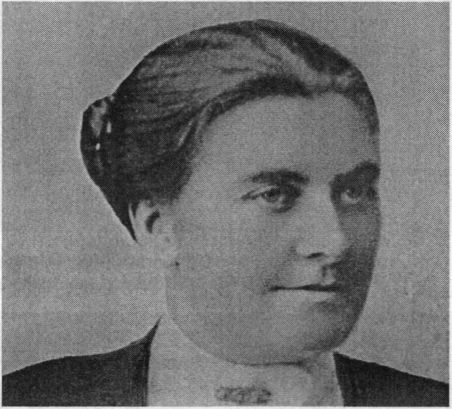
Robina McCue Taken at the time of her marriage to Henry Le Couteur >
Bean married Henry LE COUTEUR (1871-1941), a Boer War veteran, and they had three children, Elma (1904), George (1905) and Stuart (1906). The Le Couteur family came to Australia from the Channel Islands. Henry was an uncle of Archie Mathieson who married Robina’s niece, Marjorie McCue. 9
I do not have a date or place for Bean and Henry’s marriage, but we do know the family moved from the southern coastal area of Victoria to the drier north in about 1910, because of Robina’s asthma. She suffered from severe asthma all her life. Henry obtained work as a ganger for construction of the railway in the Mallee, moving about as the job required.
The family went with him living in makeshift accommodation of tents and lean-tos. Two undated photos, taken at Cowangie, show just how rough this life was. The photos appear to be taken at the same campsite and an estimate of the ages of the children dates the photos at about 1914 or earlier.
To ensure the children would have schooling Bean took in Miss Till, the schoolteacher, as a boarder. Whether this was while they were living in tents or after they built a house is not clear. An extract sent to me from a book called Kow Plains and Beyond, 1849-1988, tells us that Bean and Henry bought three separate blocks of land in Cowangie township in 1913, 1919 and 1921, and the Le Couteurs ran a boarding house on the first of these. “... at lunch time school children would be sent to fetch a billy of tea from Mrs Le Couteur for the teachers’ lunch. Mr Le Couteur was the first railway repairer (ganger) at Cowangie, and also had cattle yards ... He supplied milk to the town”.10 The Le Couteur name appears on the list of contributors for building the first hall at Cowangie in 1913.
Later Henry and Bean lived at Turriff, in a house next to the local hall where there are now tennis courts. Barbara Rogers writes that the families of the three McCue sisters “lived in the same area and had a close relationship. Aunt Robina was witty - glib tongued, but intelligent and extremely loyal. Once Mother [Barbara Crouch] had a kidney disorder and Aunt Bean took her and Clive out to her place and nursed her through it. When we lived at Merrinee - when I was a teenager - Mother had trouble with her nerves, Auntie Bean and Uncle Henry drove straight through the bush from Cowangie in a horse and cart, and Auntie stayed until Mother recovered”. 11
page 68
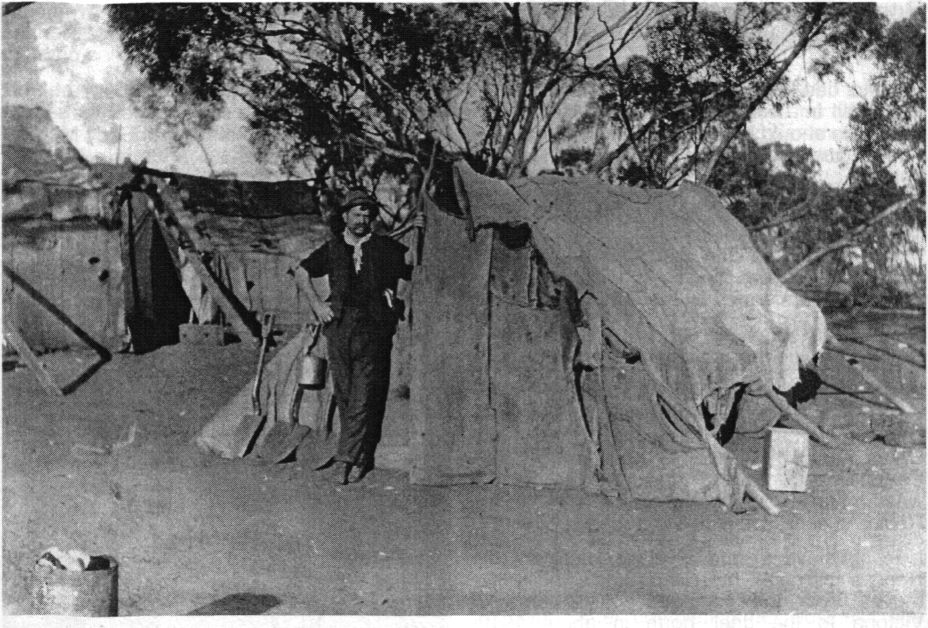
Le Couteur camp site at Cowangie, circa 1914 Henry, dressed in working clothes, stands in front of a tent made out of chaff bags.
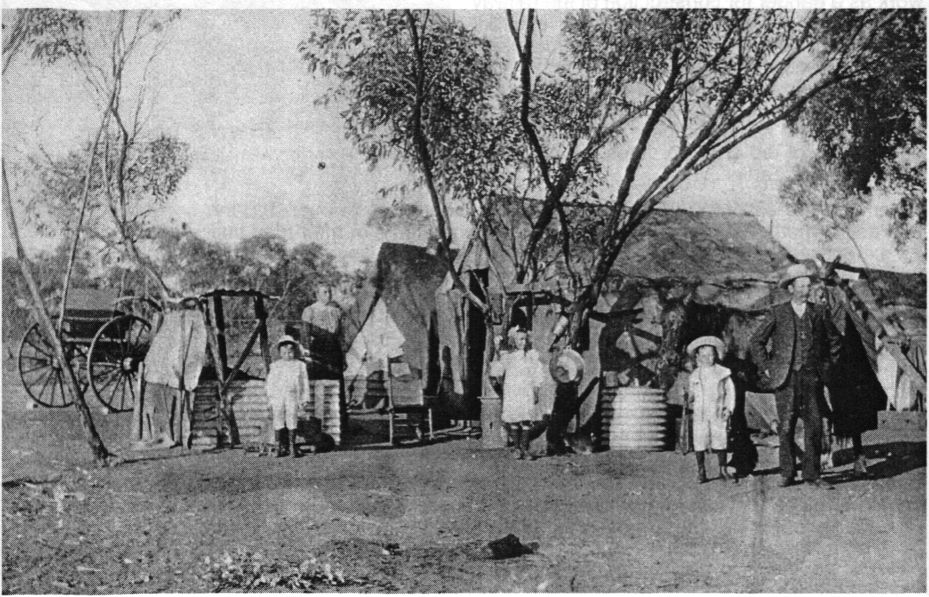
Le Couteur camp site at Cowangie, circa 1914. Left to right: Stuart, Bean, Elma, George, Henry. Henry is wearing his good clothes and a fob watch. Bean and the children are also dressed nicely for the occasion, the children with boots and socks, Elma with bows in her hair and the boys with hats. The tent in the first photograph is just right of this scene. Note the horse and gig, the corrugatedwater tank and a corrugated iron and timber construction, which was probably the cooking area. There are tools and household utensils and a little bit of luxury in the form of a cane-backed rocking chair.
page 69
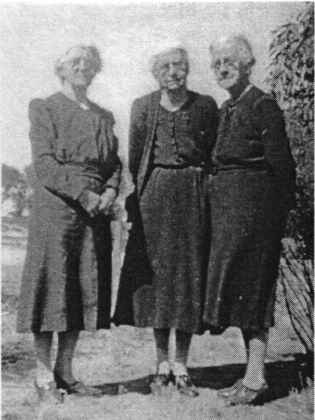
McCue sisters at Turriff Left to right: Agnes, Robina, Barbara >
After Henry died in 1941, son George and his wife Arvon lived with Bean. Bean believed in discipline. Every day when her grand-daughters Lesley and Beanie came home from school she made them sit on the couch for ten minutes without moving, so they would learn discipline. 12
Arvon nursed Bean in her old age. I have been told most emphatically, “She made Arvon's life hell!” (See notes on George and Arvon in Part IV.) Robina died at Turriff at the age of eighty-one. Both she and Henry are buried at Bendigo.
Arthur McCUE (1873-1938)
Arthur was born at Tooliorook in 1873, the eldest son and third child of Agnes Robertson and Michael McCue.13 Arthur was known by a variety of names. Mick or Micky, (as was his father, it was apparently a nickname they both disliked). Norm Chislett knew him as Brooley McCue, and in Barbara Rogers family he was called Jiddy (apparently a contraction of ‘did ya’ or ‘did he’).
I have probably heard more stories about Arthur than any other member of the family. He has been described to me by different people as a loner, difficult, unappreciative, bad tempered, aggressive, domineering, a very angry sort of person, an old devil and a proper dirty old man. Not the best of references, but as you will see, he did have some saving graces. I have not seen any photographs of Arthur but I am told he was like his father in looks and in character. He was a big, strong man. One of his saving graces was a beautiful booming singing voice with its range of four octaves. Alan Ribbons remembers him visiting Willie Crouch at Laang, driving along in a buggy with two grey ponies singing The Wild Rover’ at the top of his voice.14 An appropriate song perhaps, in view of Arthur’s temperament.
When Agnes left Michael in about 1889, she went to live with Arthur on the farm at Smokey Point. Arthur built her a two-room house there. At some stage the house burnt down and many of the family papers and letters were lost in the fire. I have not been able to discover the date of the fire.15 After the fire Agnes lived with her daughter Aggie. Items saved from the fire include a painting of the ‘Stone house’ - smoke stained and the paint slightly cracked. This is now in the custody of Jeff and Di McCue. Gertie Grace has another charred relic from the fire, an extract of birth for Agnes Robertson issued on ‘the twenty second day of March, eighteen hundred and sixty seven’ - three and a half months before Agnes left for Australia.
Arthur lived rough. One of my favourite stories, told to me by several people, is about him cutting bread for visitors, then flinging the remaining loaf at the wall where it was speared onto a convenient spike. This is where he kept the bread. The land, with his hut on, was later bought by Arthur Ward, who used the hut as a pigpen. The land then passed to Gus Ward and when Gus eventually demolished the hut, the 6-inch spikes were still in the wall. 16
page 70
The Lords were one of the earliest families to settle at Port Campbell and Gus tells of an argument Arthur had with William LordJnr, which resulted in Arthur selecting 600 acres of land above the Loch Ard Gorge to spite William. According to Gus, Arthur never used the land himself but fenced it so that William Lord could not use it to run his sheep. Marion Parker however, writes that Arthur used the land for running beef cattle and horses.17 On maps of the area this land is Lot 31, marked in the name of JR McCue.
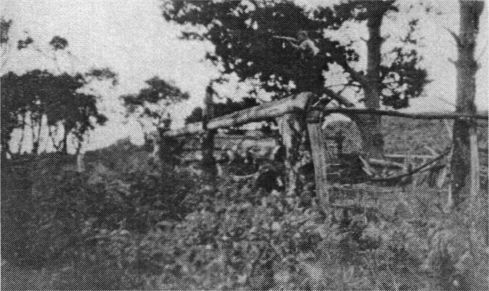
< McCue’s bullock yard at Port Campbell.
I have not been able to locate a photo of Arthur McCue, perhaps the unidentified man with the rifle here is Arthur.
A different side of Arthur McCue is shown in a story told to me by Port Campbell resident Etty McKinnon, nee Lord, the daughter of Stewart Lord. Etty is convinced that Arthur saved her life when she was six years old in 1930. Her family lived some way past the Port Campbell cemetery, along the present Timboon Road, and on this particulard ay, Etty was accompanying her father in a buggy with two in hand, on a trip to town. When Stewart got out of the buggy to open the gate the horses bolted, taking a terrified Etty with them. There were some men working on the road with picks and shovels and they tried to stop the horses but failed. Arthur was riding up the road from the direction of the cemetery. He jumped off his horse and ‘flung himself at the two horses and stopped them’. 18
Norm Chislett tells us Arthur would sometimes turn up at church when his brother Jack was preaching. Dressed like a swaggy he would sit in the front pew and do his best to embarrass his brother. 19 Marjorie Mathieson describes her Uncle Arthur turning up at her parent’s house when he was ill. When she was about twelve Arthur stayed for six months, ill with high blood pressure:
"He sent me to the grocer for six pounds of dry biscuits to celebrate his birthday. The grocer sent me back to confirm the order. Back I went and brought home the whole six pounds of Uneeda biscuits. He’d kept them in his room and as we went past he’d yell, ‘Have a biscuit’. He didn’t believe in washing as ‘it weakens you’ and wouldn't use electric light 'it makes you hot’. Called Mum [Tot McCue] ‘the foreign woman’. When he got better he rose one morning and left. I didn’t see him again till I was eighteen.
"He would appear on our doorstep in rough clothes with his swag on his back. He would be leaning on the verandah post puffing and panting. Mum nursed him but he was not appreciative and extremely vulgar in his comments. Dad in the finish would not let Mum go into his room and looked after him himself.” On another occasion he slept in Jack’s study - “till he was well enough to travel, and Stuart and George Le Couteur came and took him up north to his sisters." 20
One of Arthur’s nicer traits was his devotion to his mother and he missed her terribly when she went to live with her daughter at Woomelang. He went up to Woomelang and there he suffered a stroke. Keeping in character, Arthur made a difficult patient, shifting between the homes of his sisters Barbara, Robina and Aggie. Gertie Grace remembers, “He came up our way shearing ... and took a stroke. He was months and months off work and lived between his sister Robina in Bendigo and my mother [Aggie] ... but oh he was hard to live with. I said to Mum it was probablybecause of the stroke but she said he had always been like that."21
Arthur had substantial property in the Port Campbell area, some of which he cleared and farmed. He bred and trained ponies and these were much sought after. Gertie Grace mentions that Arthur ‘owned quite a lot of land around the district’ and this was left to his siblings. The town blocks were sold and the money divided between Barbara, Robina, Agnes and Jack. Jack McCue bought out his sisters’ shares in the 600 acres opposite the Loch Ard Gorge. The Ward
page 71
family bought land adjacent to Mima Ward and several lots in town were bought by Marjorie Mathieson and later sold. 22
Arthur McCue never married. There are tales of his amorous and not always welcome attention towards women (including chasing Rheita Mott around the kitchen table until Agnes came to Rheita’s rescue) and a romance with his cousin Margaret Robertson (Robert’s daughter), which her family put a stop to.
In later life Arthur was a diabetic. He died at Eaglehawk, near Bendigo, on 6 February 1938 at the age of sixty-five and as he had requested, he was buried beside his mother at Woomelang. His great-nephew, Tim McCue, has the black tin box in which Arthur kept his possessions. Tim’ sfather, Jeff McCue, has Arthur’s bible. Half of one page is missing; Arthur used it to make acigarette when he had run out of cigarette papers!
Agnes (Aggie) Grace McCUE (1877-1977) - MARRIED NAME MOTT
Fourth child and third daughter of Agnes Robertson and Michael McCue, born at Port Campbell on 28 September 1877.
Aggie attended school in Port Campbell and I have a copy of a Certificate of Exemption from Compulsory Attendance dated 1 April 1892. This is the year, according to Marjorie Mathieson, Aggie was working as a domestic in a doctor’s house in Melbourne, however Gertie says her mother never worked in Melbourne and this job would have been in Geelong.
Suffering from chest trouble, Aggie was advised by a doctor to go to a warmer climate. She went to the Victorian Mallee, where her sister Barbara was living at Woomelang, and it was here she met her future husband. Aggie was a good tennis player and the couple met at a young people’s gathering. Both Aggie and Barbara had accents that have been described to me as Scottish, but were perhaps a mixture of their parents Shetland and Irish accents.
Aggie and Henry John MOTT (1878-1947) were married in the Galiquil East Public Hall on 24 June 1903. The service was performed according to the rites of the Baptist Church, with Thomas Nichols the officiating minister. Witnesses were the bride’s brother, Jack McCue, and Setelia Adelaide Mott. Henry was the son of John Mott and Mary Maria Sinai 23 Copeland, and hewas born at Telangatuk. Like his father, his occupation is described as farmer. The Mott family were involved in whaling out of Port Fairy in the 19th century. Some of Henry’s brothers moved to Western Australia and there are Mott relations in that state.
Aggie and Henry had five children, two girls followed by three boys. The youngest boy, Harold Henry, lived for two months in 1917, dying beside the road near Lacelles as his parents were attempting to get him to the Hopetoun hospital. They had already taken him to Sea Lake but the doctor was away and they returned home before going in the opposite direction to Hopetoun the next day. Henry had to travel on to Beulah to get a coffin, before the group returned to Woomelang for the burial. “All this travelling was done by the same pair of horses and it rained for most of the 3 days. The road was just a quagmire. The horses being very leg weary, lay about for 3 days, as the water was sometimes up to their bellies in some places.” 24 I am told a song was written about this sad event, but I have not been able to obtain a copy. An autopsy discovered the child had a ‘hole in the heart’ and doctors were surprised he had lived so long.
The Mott’s eldest boy, Mervyn, died of Bright’s disease at the age of twenty-five in 1933. He is buried in Melbourne’s New Faulkner cemetery. The surviving children were Gertie (1904), Rheita (1907) and Russell (1911).
The Mott family had farms at Galiquil East and Henry was at first share farming there with his brother Alf. Henry sold his share and he and Aggie moved to a farm at Kaniera (now known as Culgoa). When this farm was sold, they went to another farm at Keith in SA. Finally in 1910, they selected land near Turriff and lived at Gama East for the rest of Henry’s life. As well as
page 72
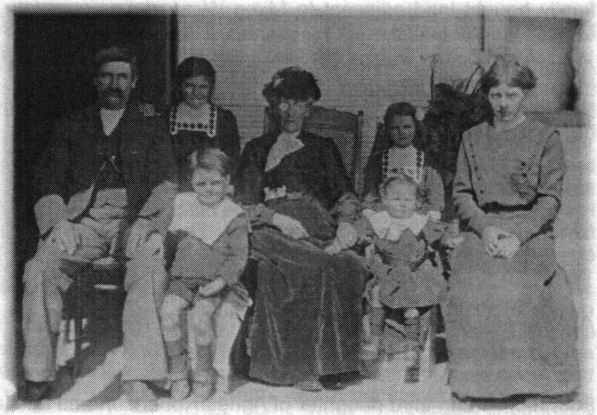 contributing to the family farm, Aggie had a property of her own. ‘It’s my block and money from the wheat goes into my bank.’ 25
contributing to the family farm, Aggie had a property of her own. ‘It’s my block and money from the wheat goes into my bank.’ 25
Mott Family, circa 1913 Left to right: Henry, Gertie, Mervyn, Agnes RobertsonMcCue, Rheita, Russell, Aggie Mott >
Gertie writes that Aggie “was a wonderful mother and I have lovely memories of her loving kindness to us as children and always as teenagers she wanted the best for us (her childhood was not the happiest). My father was a lovely patient man, supported her in all that she said or did, for the good of his family. So what more could you wish for.” 26
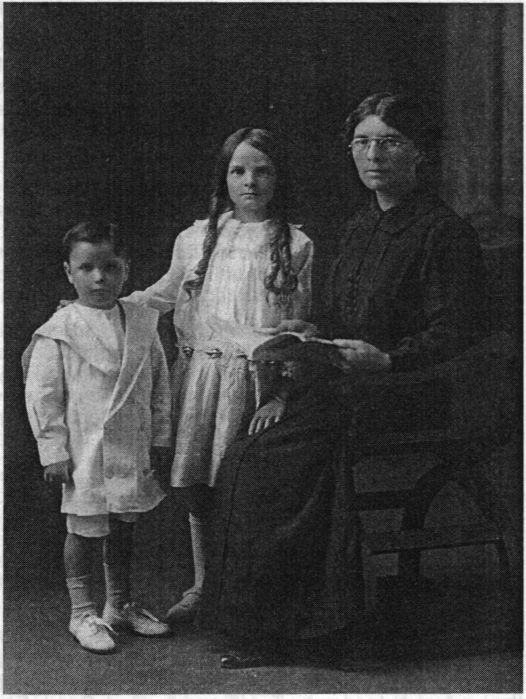 Like so many other Robertsons, Aggie was a singer (a soprano) and played the organ for church services. Alan Ribbons tells us that in church Aggie would sit in the front pew, leading the singing half a bar ahead of everyone else.27 She encouraged her children’s musical ability with music lessons. Rheita was given an autoharp and Mervyn a violin. After Aggie’s death Gertie inherited the family piano. She still has the piano, as well as Mervyn’s violin. Gertie’s daughter, Margaret Powell, has the autoharp.
Like so many other Robertsons, Aggie was a singer (a soprano) and played the organ for church services. Alan Ribbons tells us that in church Aggie would sit in the front pew, leading the singing half a bar ahead of everyone else.27 She encouraged her children’s musical ability with music lessons. Rheita was given an autoharp and Mervyn a violin. After Aggie’s death Gertie inherited the family piano. She still has the piano, as well as Mervyn’s violin. Gertie’s daughter, Margaret Powell, has the autoharp.
Aggie with two of her children. The identity of the children is uncertain, probably Rheita and Russell. >
Barbara Rogers writes, “Aunt Agnes was so ladylike - always wore hat andgloves - even when shopping. She’d come and visit us - Mother and her would talk Gaelic to each other and laugh and laugh. Of course the three girls were very Irish. Aunt Agnes wa sa lovely singer. They were always so hospitable.” 28
Aggie seems to have had an independent and dominant personality. When she went driving with Russell, she would insist on sitting in the front seat while Vivienne sat in the back.
After Henry’s death from a stroke, Aggie lived in a house next to Rheita and Bert Mitchell’s farm. This house had been the Baptist manse at Turriff and was shifted out to the property at some time before the Mitchells moved onto the farm. Rheita’s daughter, Sue, says Aggie came over to sleep at Rheita and Bert’s and used the toilet there, as there was no toilet at Aggie’s house. She came with us to church and when we went visiting to Gertie’s
page 73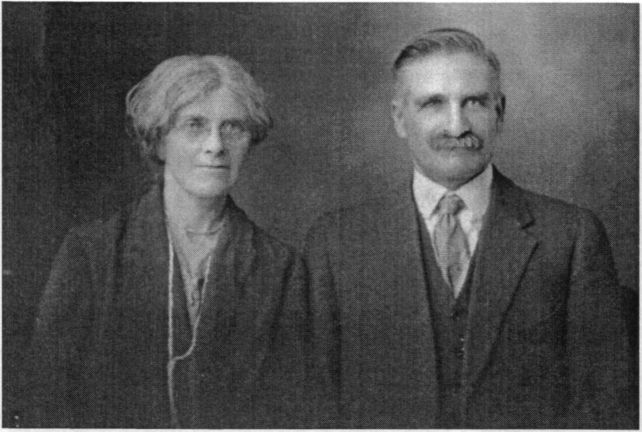
Aggie McCue Mott and Henry Mott >
and to Uncle Russ - was company for mum when we were at school or awayand the men out working. It was great when Uncle Jack and Auntie Tot used to drive up from Melbourne in their black Morris and stay a fewdays. Auntie Barb would also come across from Sea Lake. Grandma had a nice garden with lots of rosebushes in it and self sown cosmos, a very colourful sight”. 29
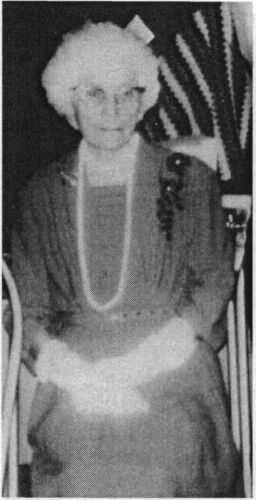 In later life Aggie moved in with the Mitchells, and she expected Rheita to wait on her, which Rheita patiently did. When Rheita could no longer look after her because of her own ill health, Aggie went to live with Gertie and Mac Grace. By this time she was in her mid nineties and with advancing age she had become difficult and demanding. Her great granddaughter, Colleen Barnes, says she was a ‘bit scared’ of Aggie. She would sit in a chair in the passageway and if she wanted anything she would bang on the floor with her stick. “We were too scared to go past her in case we copped the stick.” 30
In later life Aggie moved in with the Mitchells, and she expected Rheita to wait on her, which Rheita patiently did. When Rheita could no longer look after her because of her own ill health, Aggie went to live with Gertie and Mac Grace. By this time she was in her mid nineties and with advancing age she had become difficult and demanding. Her great granddaughter, Colleen Barnes, says she was a ‘bit scared’ of Aggie. She would sit in a chair in the passageway and if she wanted anything she would bang on the floor with her stick. “We were too scared to go past her in case we copped the stick.” 30
Aggie Mott >
In the middle of night she would bang on the bedroom wall and demand a cup of tea or she would want to get up and dressed. This meant Gertie getting up to light the stove and helping her mother to dress. If Gertie refused Aggie would say, ‘There’s no sympathy in you, you’re not a sympathetic person at all. I want to go back to Rheita.’ Gertie writes: “I had to wait to help her drink it [the tea] as her hands were very shaky and it went all over her and the bed. Rheita used to fill a small thermos and she got herself a drink, but when she came to me she could no longer get the thermos open or pour it out into a cup without spilling it everywhere.” Eventually Gertie, who was in her seventies, could no longer cope, “the thing that finished me was lifting her about as she became very weak and could not turn in bed or get up to go the toilet without help.” The family decided Aggie should be admitted the hospital in Ouyen. Aggie protested, claiming ‘Russell wouldn’t let you do this’, but it was Russell who actually took her to the hospital. Rheita died on the 7 May 1977. Aggie died three weeks later, two and a half months short of her 100th birthday.
John Robertson Thomas McCUE (1881-1975)
Fifth child and second son of Agnes Robertson and Michael McCue, born at Port Campbell on 5 May 1881. Professionally he was known as the Reverend Robertson McCue, to family and friends he was known as Jack.
Suffering from asthma, Jack was indulged as a young child and allowed to run wild. He had only three years of broken schooling. As a lad he worked in the bush with his brother Arthur and went shearing with him on the Manifold property at Talinga. Arthur was much harder on Jack than Jack was willing to put up with, and at seventeen he packed his swag and walked out. His sister Aggie was working as a domestic for a doctor in Melbourne (or it may have been Geelong) and the doctor’s wife took Jack in. It was at this time Jack met his future wife Sarah Edith COLLINS
page 74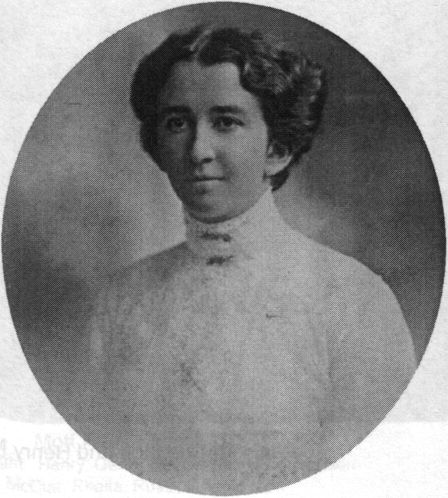
Sarah Edith Collins >
(1886-1971), known as Tot or Totty, a name given to her by her father when she was a little tot or toddler. Sarah Edith was the sixth child and second daughter of James Collins and Sarah Corfield’s ten children. She was thirteen when she met Jack and they were each other’s only sweethearts. Marriage however had to wait.
Jack moved on to Beulah where another sister, Barbara McCue was ‘helping out’ the William Adie Robertson family. William Adie persuaded Jack to go back to school, and he would sit at the back of the ordinary classes at the local State School. He eventually obtained his university entrance and attended the Victorian Baptist College (1911-1913), while studying Greek and Hebrew at Melbourne University.Having obtained his theological qualifications, Jack become ordained.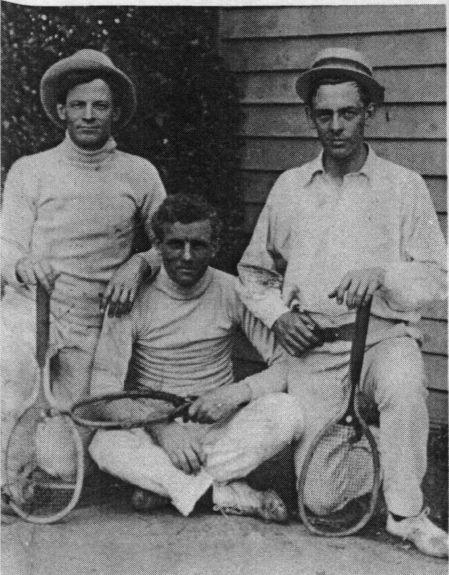
Jack McCue, the sportsman, on the right, with two of his friends. >
Before entering the Baptist College, Jack worked as a home missionary at Normanville, Kerang and in the Wimmera. In the newly developed coal mining district at Wonthaggi, Jack ran the first of his anti-alcohol campaigns. “The ‘Blue Pigs’ were the two-gallon licenses issued to men outside the boundary of the no-license Government town, and the licensees used to sell the beer to the miners. When he [Jack] left, the townspeople - drinkers and non-drinkers - gave him a dinner and a goldwatch.” 31
Jack’s anti-alcohol stand was a reaction to the drinking he had seen in his family as a child. Prohibition, or at least the reduction of alcoho luse, became a life-long crusade for Jack. He must have felt the use of alcohol for medicinal purposes was all right, as in a 90th birthday interview for Melbourne Herald he is reported as saying “alcohol should be available only on a doctor's prescription, like drugs.” 32
After his ordination, Jack married Tot Collins on 8 September 1914. They had three children, Marjorie (1915), John Jnr (1917) and Marion (1922).
Jack’s pastoral work took him to St Kilda (1914), Castlemaine (1916), Moreland (1922-24) and West Preston (1931-37). Between 1924 and 1931, Jack took up a position with the Anti-Liquor League and after 1937 he worked with the Local Option Alliance and later the Victorian Temperance Alliance, of which he was the secretary for many years.
page 75
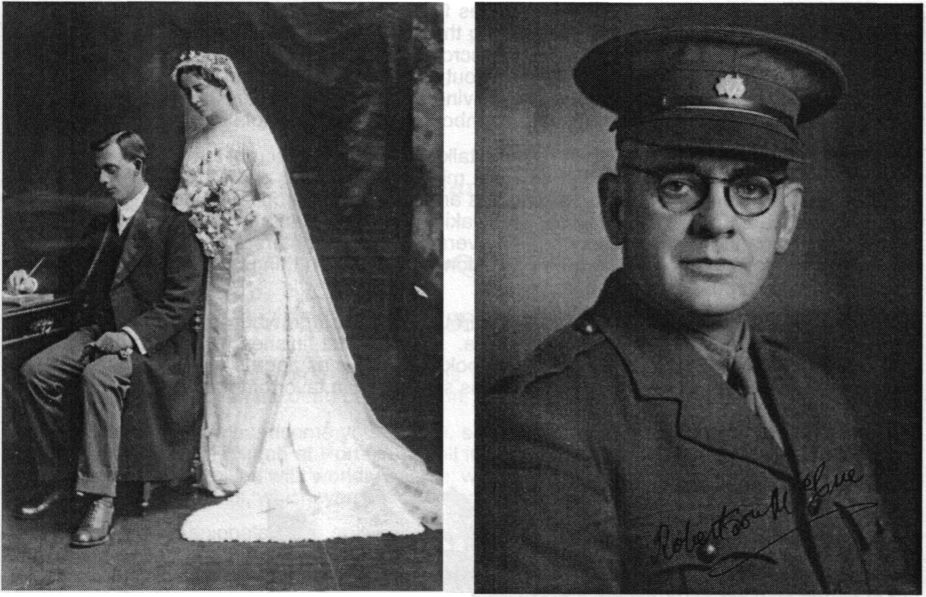
Jack McCue and Tot Collins. Wedding photograph, 8 September 1914.
Jack McCue in uniform as a YMCA chaplain during World War 2.
Grandson Jeff McCue recalls that Jack always wore his clerical collar, even when relaxing. He was “a big strong man who could carry a bag of wheat on each shoulder”. He carted hay with Jeff and Alden when he was over seventy, ‘throwing them up four high’. “He was good to my brother and I and to Mum ... a nice bloke.” 33
Jack was very much a family man and kept in close contact with his sisters and brother, his cousins, and their families. As executor of his brother Arthur’s estate, Jack was responsible for the sale of Arthur’s property and dividing the proceeds equally between himself and his three sisters. Jack bought the 600 acres near the Loch Ard Gorge. Jack’s daughter Marion writes that the land was poor and Jack “sought the help of Victorian Agriculture to test the soil and suggest what was needed for good pasture. This advice was willingly given and Dad proceeded with obtaining local knowledge and prepared and fenced experimental plots. A local farmerand his son were employed to carry out this work. Good results were obtained and young beef cattle purchased. They did well. More ploughing and appropriate super spread. I spent many holidays there working with my Mum and Dad clearing, ploughing, harrowing and spreading super. We had purchased a Bren Gun Carrier, 34 minus its turret, a blade on the front. Tractors were unobtainable after the War.” 35
Jack sold the property in the 1950s and with the proceeds, he and Tot were able to purchase a home for their retirement. The house had a separate flat that could be let to tenants. The Baptist Church provided no superannuation for its ministers.
Jack had a Morris Oxford motorcar and this car comes into several of the stories I have been told about him. Jeff McCue again, “He rang me up. ‘Can’t drive it any more Jeff, I’m ninety-two, they won’t let me drive it any more. Could you come down and pick it up?’ Di and I went down and drove this old unroadworthy black Morris Oxford from 2 Wills St, Deepdene down to a little farm at Curdie Vale. He wanted to have a last drive. Down the road, Di and I in the back seat. He bipped the cars and up the side of the creek. I said ‘Cripes you’re cutting it close grandpa.’He said, ‘Paints thick boy, paints thick’.” 36
page 76
Another story involving Jack and his car comes from Ken Crouch. “We once took Uncle Jack McCue up to Sea Lake to see Grandma during the 1970s. He was then in his late 80s or early 90s I think. As we passed a train, he looked across and said, ‘Ever hit one of those things, my boy?’ I said ‘No Uncle Jack’ and he told me about hitting a train at a level crossing at Eaglehawk (near Bendigo) years before, when he was driving a Morris Oxford car. He said - ‘I hung onto the steering wheel; Aunt Tot hung onto the dashboard. It took the whole front off the car’.”37
Tot and Lottie Dickins used to spend hours talking to each other on the phone. Actually it seemed to us Dickins kids it was Tot who did most of the talking and Mum would sit knitting, the phone propped on her shoulder, saying yes and no in the appropriate places. One time she went to sleep while Tot was chatting on, and waking up with a start she hoped the next yes and no she put in was the correct response. Conversely, Tot’s daughters thought it was Lottie who did most of the talking. Tot left us a bit of wisdom to help when things are not going quite right - ‘Tack tired onto tired, and start again.’
Tot and Jack were living in retirement at Canterbury in Melbourne when Tot died in 1971. Jack died four years later at the age of ninety-three. John Sorrell finishes his 90th birthday article about Jack by saying, “The old man is 90 but looks 70. He is as aggressive, as pugnacious and as clear-headed as ever. And that, I suppose, is something in favor of total abstinence.”
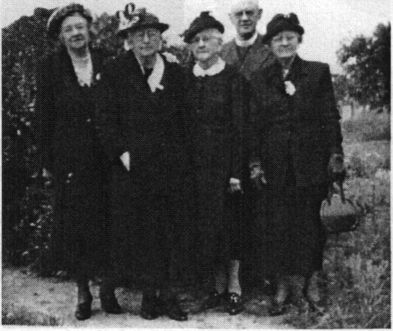
McCue siblings, circa 1950
Left to right: Tot, Bean, Barbara, Jack and Aggie >
1 Letter from B. Rogers, September 1999
2 Quotes from M Mathieson are taken from letters and interviews in 1998-2000
3 Letter from Ken Crouch, September 2000. This confusion about the border is apparent in some of the stories I have been told, which describe towns close to the border as being in South Australia when they are actually inVictoria.
4 Letter from B. Rogers, June 2000
5 Told to me at a family gathering in Portland, April 2000
6 Interview with Clive Crouch at Portland, April 2000
7 Letter from A Ribbons, January 2000. This story was also told to me by Clive Crouch.
8 J. Fletcher, “The Infiltrators”
9 See Appendix 3 for details of the relationships between the Robertson - McCue - Le Couteur - Mathieson - Crouch - Croft families. Takes a bit of working out!
10 R Wilson, Kow Plains and Beyond, 1849-1988, p.76
11 Letter from B Rogers, June 2000
12 Interview with Heather Richards nee Le Couteur, April 2000
13 Stories about Arthur come from a number of sources including Gertie Grace, Marjorie Mathieson, Marion Parker, Jeff McCue and others referred to in the footnotes.
14 Letter from A Ribbons, February 2001
15 I have been told of at least two fires involving the destruction of family effects and it is difficult to work out which one is which, as I have no dates or definite locations. Jack Fletcher records that bush fires swept through the district when the forest was still standing and some settlers lost everything.
16 Interview with Gus Ward, April 2000
17 Letter from M Parker, 29.8.2001
18 Interview with E. McKinnon at Port Campbell, April 2000
19 Interview with Norm Chislett, April 2000
20 Interview with Marjorie Mathieson, March 2000
21 Interview with Gertie Grace, April 2000
22 Information from Gus Ward, Marjorie Mathieson and Marion Parker. Marion was involved in preparing the probate and transfer documents while working as a law clerk for Maurice Black and Co.
23 I have been given several different spellings for this name but Gertie Grace tells me this is the way it is spelt on her grandmother’s gravestone, letter from G. Grace, 10.2.2001
24 Taken from a short piece called 'A Very Sad But True Story’ written by Gertie Grace
25 Interview with Alan Ribbons, April 2000
26 Letter from G. Grace, July 2000
27 Interview with A Ribbons, April 2000
28 Letter from B. Rogers, June 2000
29 Letter from Sue Boyd, 16.7.2000
30 Interview with Colleen Barnes, April 2000
31 Newspaper cutting, dated 6.5.1961. The article is under the heading ‘In the Churches’ and marks Jack’s 80th birthday. The name of the newspaper is unknown.
32 Interview by John Sorrell published in the Melbourne Herald newspaper, 7.5. 1971
33 Interview with Jeff McCue, April 2000
34 After World War II another relation, James Norman Robertson in WA, was employed in converting Bren Gun Carriers for farm use. See Chapter 22.
35 Letter from M Parker, 29.8.2001
36 Interview with Jeff McCue, April 2000
37 Interview with Ken Crouch, April 2000
page 77
JOHN GEORGE HALLS ROBERTSON (1869-1891)
Eldest child of James Robertson and Frances Halls, born at Darlington on 6 October 1869. Probably named after James’ dead brother John.
Photos of John show a handsome young man, seemingly full of life. He is listed as a founding member of the Baptist church at Port Campbell in 1888. His niece Margaret Haine was told by her mother that John mixed with worldly people; went to plays and enjoyed the theatre. Margaret has John’s opera glasses, which were among her mother's effects.
Apart from these snippets, the only information we have about John is provided by the registration of his death in the Victorian records. His occupation is recorded as clerk and that of his father as boarding house keeper. John died at the age of twenty-one from ‘pleurisy with effusion’, in the Gipps ward at the Melbourne Hospital on 29 March 1891. He was buried in the Melbourne ‘new cemetery’. The undertaker was T H Allen and the attending ministers/witnesses at the burial were J A Archibald and G A G Clowes.
There are four other deaths recorded on the same page as John’s death, all in the Gipps ward at the Melbourne Hospital and all buried at the new cemetery. Mr Clowes witnessed the burial of all five, suggesting perhaps that he was some sort of official.
ABBOTT ARTHUR ROBERTSON (1871 - 1948)
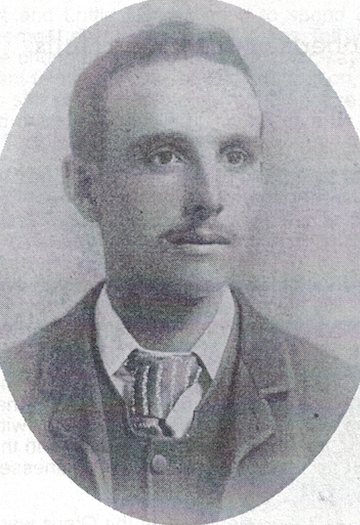
Second son of James Robertson and Frances Halls, born at Darlington on 17 February 1871. The name Abbott comes from his maternal grandmother’s maiden name and Arthur from his paternal grandfather.
I have been told that Abbott Arthur went to the gold rush in Western Australia with brothers Frederick, James and William. Gold was discovered by Paddy Hannan at Mt Charlotte, WA in June 1893, so the brothers' search for gold would have been after that date. Abbott is thought to have returned to Victoria where he married and had two daughters, one called Dorothea. Margaret Haine remembers Abbott visiting her family and describes him as a ‘shocker’. He was always short of money and as he walked around, he would scan the ground for cigarette butts, which he picked up and reused. He would say, ‘Have you been to Moonta?’ as if describing the ‘last place on earth’. This suggests he may have worked at the Moonta Mines in South Australia at one time. He worked on the Murray River locks in the 1920s and as a draughtsman at Lakes Creek Meat Works, Rockhampton in Queensland during the 1930s, then for Vestey in Sydney about 1935. Margaret also tells us he was separated from his wife and family, but they took him in and cared for him in his old age. [Interviews with Margaret Haine in 2000 and 2002]
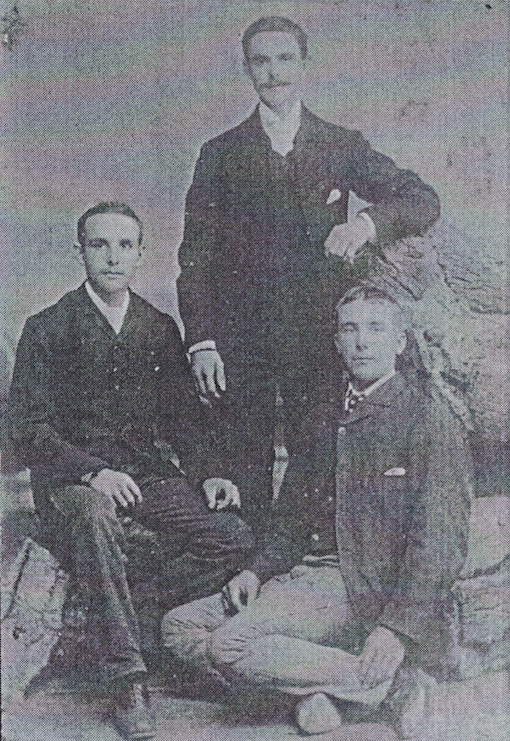
Abbott’s death certificate states that he was married twice. The certificate provides no details of the first marriage and I have not been able to find a record of that marriage or any children from it. From the South Australian records I have discovered that Abbott’s second marriage to Sylvia Charlotte SWIGGS took place at Croydon, SA on 5 February 1910. Sylvia was the daughter of William Thomas Swiggs and Louise Laker Hamilton. She was nineteen years of age and single. Abbott is recorded as a thirty-nine year old widower. [The marriage is recorded in the SA register in Box 242, p. 255]
James Robertson’s Sons
Thought to be Abbott, John and Frederick
The death certificate does not record any children from the first marriage, and the names and occupation of Abbott's parents are stated as unknown, which suggests his second family knew little about the Robertsons. Abbott and Sylvia’s children are listed on the certificate as Freda Sylvia - 38 years, Frederick Arthur - 36 years, Dorothy Ethel - 34 years, and William James - 29 years. It would seem that Dorothy and Dorothea are probably the same person. I have made contact with relations on the Swiggs side of the family but unfortunately they know nothing about Abbott, Sylvia or their children and I have had no success in tracing any of Abbott Arthur’s descendants.
Abbott died on 12 October 1948 at 14 Price St, Regent, in the city of Preston, Victoria. On the death certificate his occupation as given as draughtsman and the cause of death as “Broncho-pneumonia - 2 days, and Myocarditis - 10 years". Abbott Arthur was cremated at the Faulkner crematorium on 14 October 1948, with the service conducted by D Mathieson.
FREDERICK PETER ROBERTSON (1873-1945)
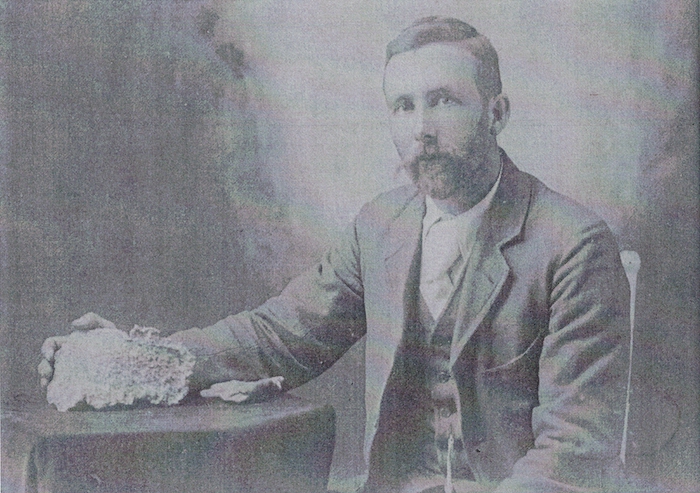
Frederick Peter Robertson with his gold nugget
Third son and fourth child of James Robertson and Frances Halls, born at Cobden, Victoria on 4 April 1873.

Frances Halls Robertson with her son Frederick
When he was a boy Frederick fell out of a tree and broke his arm. His uncle Michael McCue said to him, ‘What dost thee doin up the tree, dost want to break thy titherirum?’ On another occasion when one of the boys was looking for the hammer, grandfather James told him - ‘gang dhu an sick it’ - meaning 'go you and seek it'. [Interview with Margaret Haine, November 2000]
Margaret Haine has a photo of Frederick with a large gold nugget he found while prospecting in Western Australia. She believes the money raised from the sale of the nugget was used to send his mother on a trip to visit her relations in England in 1908.
Frederick married Edith TAYLOR (1881-1966) at Mt Magnet, WA, on 6 October 1915. They had two children, lvy (1916) - and Peter (1917). Frederick owned a gold mine at Payne's Find, WA, which he sold for not much money. Later he had a contract to cart wood for another gold mine at Hill 50, Mt Magnet.
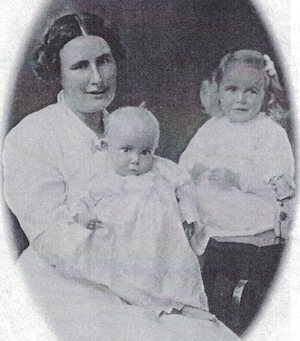 Harry Strickland worked with him and that is how Frederick's daughter lvy came to meet and marry Harry Strickland. [Letter from Desma Strickland, 2000]
Harry Strickland worked with him and that is how Frederick's daughter lvy came to meet and marry Harry Strickland. [Letter from Desma Strickland, 2000]
Edith, Peter and lvy Robertson
Frederick never got over the death of his son Peter during World War II and died after a stroke in 1945. Edith Taylor died in 1966 at the age of eighty-five years.
Although Frederick lived in the next Perth suburb to his younger brother James Need Robertson, it seems the two families were unaware of each other’s presence. According to Ian Strickland, his mother Ivy died believing she had no relations on her side of the family.
FRANCES MANSON ROBERTSON (1876-1965) - MARRIED NAME SAUNDERS
Fourth child and eldest daughter of James Robertson and Frances Halls born at Ellerslie, on 4 June 1876. A mistake was made on the birth certificate, according to her son Neil, and Frances’ name is spelt Francis and her sex recorded as male.
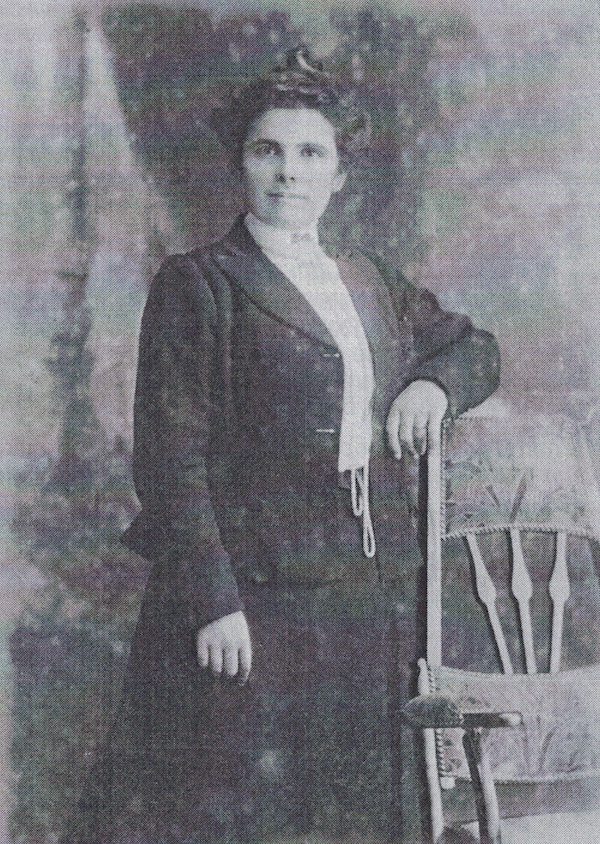
Frances Manson Robertson at 25 years
Frances trained as a home missionary at the Dr Angus Bible College in Adelaide. This was a residential college that trained both home and foreign missionaries. Henry Saunders also trained there but at a different time and the two did not meet each other until later. [Information about Frances and Henry was obtained from their youngest daughter Margaret Haine, and from Henry Saunders obituary, published in the The Queensland Baptist, 15 April 1960.]
In February 1903, Frances and Henry SAUNDERS (1876-1960) were married at the Albert Park Baptist Church in Melbourne. The reception was held in a marquee erected in the yard of the house where James and Fanny lived at Moonee Ponds. Photos of the wedding suggest it was quite an elegant affair with two bridesmaids and a flower girl. One of the bridesmaids was Frances’ cousin Nan Robertson.
Henry's parents were Thomas Saunders and Ruth Lade. They had a property at Mickleham outside of Melbourne and Henry was the sixth of their ten children. They must have also had property at Coburg, as Thomas was on the Council there and was responsible for planting the gum trees outside of Pentridge jail, an act which led to much teasing among friends and family. [By one of those strange coincidences in life, Peter Williams, another descendant of Thomas and Ruth Saunders, is a friend of mine. I {MDW} can put anyone wanting more information about the Saunders and Lade families in touch with Peter.]
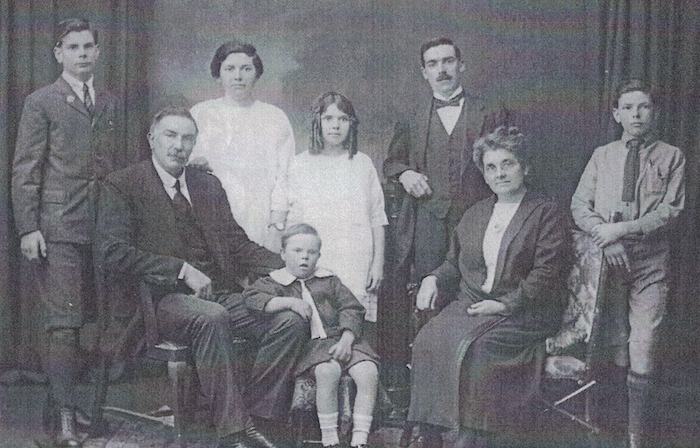
Saunders Family, circa 1928 Left to right: Gordon, Henry, Frances Jnr, Douglas, Margaret, Neil, Frances, Alan
Frances and Henry had seven children. The places of birth of Neil (1904), Frances (1906), Hazel (1908), Gordon (1912), Alan (1914), Margaret (1915) and Douglas (1918), give us an indication of the family’s frequent moves, as they were all born in different localities; Boort and Alexandra in Victoria, Beaudesert in Queensland, Latrobe and Sheffield in Tasmania, and Albion and Enoggera in Queensland. Hazel died in Tasmania from meningitis at the age of three.
Henry Saunders started training for the Baptist ministry in 1903, working at first as a home missionary. Based at the Baptist Church in Beaudesert, Henry served the Logan/Albert district for two and half years. He was advised to go south for health reasons and in September 1910 he was called to the Moonah Baptist Church in Tasmania, followed by churches at Latrobe and Sheffield. Henry was ordained 1911 while the family was living in Tasmania. We must assume that Henry’s health improved as his next move was back to Brisbane (Albion and Enoggera) in Queensland.
Rejected for war service on medical grounds during World War I, Henry devoted himself to the work of the Young Men’s Christian Association in camps and organizing War Savings Groups. Later he was secretary of the Queensland Temperance Alliance.
The family returned to Tasmania sometime after the end of the war, accompanied by Frances’ ailing mother. Fanny Halls died at Sheffield in 1924. ln 1925 the family was at Rainbow in the Mallee of Victoria, where Frances’ Uncle, William Adie Robertson, had served before them. The stay at Rainbow was relatively short and the family moved on to spend about six months at Port Campbell. From here Henry was called to Bendigo, then to Portland.
For a time Henry made a living as a travelling salesman in the country area around Bendigo, selling drapery and haberdashery. He mixed this with missionary work and called his business the ‘Highways and By-ways Mission’. Sales fluctuated and in some places ‘he was lucky to sell a pair of boot laces’. On the whole however he did quite well and according to his daughter Margaret, he made more money this way than he ever did as a church minister.
Frances was always very involved in church activities, helping her minister husband and often taking services at the various out stations where they served the Baptist Church in Victoria, Tasmania and Queensland. She wrote two tracts entitled ‘My Grandmothers Prayer’ which relate the tale of the Robertson family’s conversion during ‘the great revival’. There is a piece written by her in the ‘Jubilee Historical Outline of the Rainbow District Baptist Churches’, published in 1945, outlining work undertaken while at Rainbow. We learn from this publication that Henry owned his own car, which he used for parish work.
Margaret Haine tells us that Henry reckoned he could divine water and offered to locate water on Mime Ward‘s farm at Port Campbell. He did find water but it was brackish and of little use.
The family finally settled in Queensland. Here Frances would visit patients at the Brisbane General Hospital, singing to them while accompanying herself on the autoharp her father had given her on her eighteenth birthday. A hymn entitled ‘To the Heart’ was written by her son Neil and dedicated to his mother ‘for her ministry of song in the hospital’ (see Appendix 5).
In the 1930s and early 1940s, Frances was a member of the Oriental Missionary Society and served for a time as general secretary for the Society in Queensland. Meetings were sometimes held in the family home and Frances got to know members of the local Chinese community as well as those visiting from overseas. The society was very concerned about the Japanese invasion of China and Frances was responsible for writing to the Prime Minister expressing this concern. The Chinese Central News Agency published the following resolution from the Rockhampton branch of the society in March 1938:
We the citizens of Rockhampton appeal to the Prime Minister of Australia to intercede with the League of Nations on behalf of the defenceless people of China against Japanese aggression, requesting the League of Nations to institute all measures within its power for the prevention of further slaughter of innocent people. [Newspaper cutting in the possession of Margaret Haine]
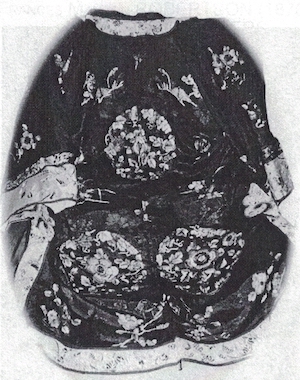
Chinese poster and gown
Margaret Haine possesses a letter addressed to Mrs Saunders from the National China Military Council, dated 21 March 1938, thanking the Rockhampton group for their resolution, on behalf of Madame Chiang Kai-shek.
Frances expressed her concern in a practical way by organizing ‘A Mile of Milk‘ and speaking on the radio to advertise the campaign. She achieved her goal and the tinned milk collected was sent to help sustain babies and children suffering because of the Sino-Japanese war. As a token of appreciation Frances was presented with a beautifully embroidered Chinese jacket. The jacket, along with Frances’ autoharp, is now in the custody of Francis’ granddaughter Kirstin Robertson Gillam.
Both Frances and Henry died in Brisbane, Henry at the age of eighty-four and Frances at the age of eighty-nine years.
JAMES NEED ROBERTSON (1877-1953)
Born at Woodford, Victoria on 10 October 1877, the fifth child and fourth son of James Robertson and Francis Halls. His birth certificate, which is in the possession of his youngest grandson, Garry Gillard, states that witnesses to James Need’s birth were his father and his grandmother, Margaret (Henderson) Robertson. Evidence of business dealings between James Robertson and a James Need at Ellerslie in 1878 suggests that this is where James Need Robertson’s name came from. [These documents are in the possession of Margaret Haine and are referred to in the section about James Robertson.] He was generally known as Jim.
James Need sounds like a colourful character. It seems he started to study for the Baptist Ministry but left. One story has him climbing out through a window to escape from the seminary. He is quoted as saying ‘I could say the words, but I couldn’t live the life’.
Pre-1900, James Need was a fireman on a Murray River paddle steamer. At some stage he went off to join the gold rush in Western Australia and he married Christina BENNETT (1880-1968) at Claremont, WA in December 1906. Christina was born in Ballarat and how she got to WA we do not know. Her mother, also called Christina, came from Stirling, Scotland. Christina worked as a domestic and at the time of her marriage was employed as housekeeper by the Shugg family, who lived in John St, around the corner from the municipal yards at Claremont where James was working. Knowing she had neither money nor family, her employers arranged for the marriage to take place at their house.
Christina and James Robertson and their family
The couple moved back and forth between Victoria and Western Australia. Their first child, Adie, was born at Ballarat in 1907, Norman was born at Claremont in 1910, and Mollie at Geelong in 1915. In 1913 James was construction foreman for building the Geelong abattoir. The family finally settled in Maylands, Perth next to the suburb of Bayswater where James’ brother, Frederick, lived. The two families were apparently unaware of each other’s presence. James Need worked in a variety of construction jobs, including the pipeline for water to Kalgoorlie, and with the Claremont Municipal Council, known at that time as the Claremont Roads Board. His grandson, Garry Gillard, has letters and references relating to his work history.
Graeme Robertson, another grandson, writes:
I remember my Grandfather, James Need Robertson very clearly. He used to call all his male grandchildren “Boy” and all his female grandchildren “Girlie”, regardless of their names. He was a real ‘bushie’ and when staying up on his daughter Adie’s farm in the Jibberding (Wubin) area of WA he use to camp in a tent about half a mile from the homestead where I use to visit him when I was there on my many visits. Keeping in mind that my mother and I lived on the farm with the Reudaveys for two years of the Second World War and I started school at the Jibberding School with the Reudavey children. [Letter from Graeme Robertson, 10.12.1998]
Jim had a block of land, now incorporated in the Reudavey property. He kept pigs for many years as a source of income, building pig sties just below the mud brick house at ‘Limberlost’. (See notes on James’ Reudavey grandchildren in Part IV.)
The house in which the Robertsons lived at 98 Eighth Avenue, in the working class suburb of Maylands, belonged to Christina. She saved to buy the house and on her death it was left to her five grandchildren. [Graeme Robertson has the original contract showing Christina Robertson as the purchaser in her own singular right.] The house has now been demolished and three units are built on the site. The Maylands house was a centre for family activities in Perth and many of the family photographs are taken there. Originally there were only four rooms and a verandah but rooms were added and the verandah enclosed until there were eventually ten rooms. Christina took in relatives or friends as boarders, including the Cummins boys who were related on either the Halls or Bennett sides of the family. When James Need went camping on the farm at Wubin, Christina would stay in Perth to look after her ‘paying guests’. As the Jibberding children got older, some of them lived with their grandmother, Christina, and Aunt Mollie at Maylands and went to school, tertiary training or work in Perth. When Rod Reudavey was attending Claremont High School he boarded with Norm and Gert Robertson who lived just up the street, on the opposite side of the road to 98 Eighth Avenue.
Christina was known to her friends as ‘Teen’. She was a talented dressmaker. “Gran was good at ‘turning’ clothes. Unpick and reverse the material and remake into a new garment. She loved millinery, reshaped hats, dyed them and trimmed them into new models. [She would say] ‘Just because you are poor you don’t have to look poor’." [Letters from Phillis Dolling, 1999] She was a small woman, just on 5 feet tall and Graeme tells us that Christina's “legs were so short she had to have a footstool to rest her feet on, even when she was sitting in a lounge chair. She was an absolute first rate lady and l have fond memories of her.”
James died of heart failure in 1953 and Christina died in 1968.
WILLIAM DE WITT ROBERTSON (1879-?)
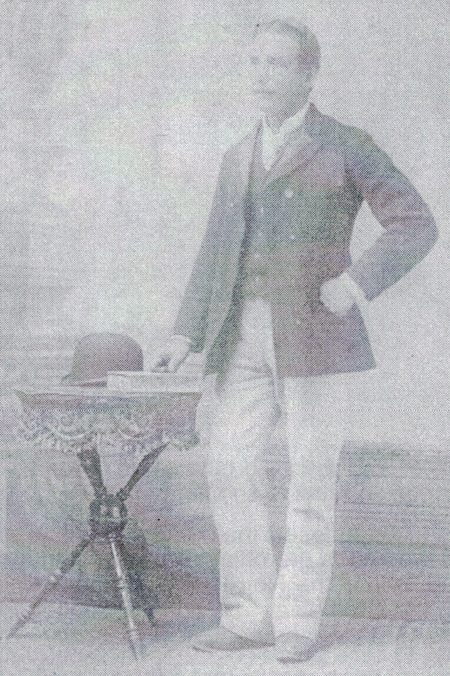
Sixth child and youngest son of James Robertson and Frances Halls, born at Port Campbell on 19 February 1879.
William is a mystery. No one seems to know much about him, not even how he got the name De Witt. He is thought to have gone to the gold rushes in Western Australia with other members of the family but after that, nothing! I have not been able to find any trace of him in WA records.
William de Witt Robertson
Authenticity uncertain
My daughter, Lisa Worrall, tells an amusing story that seems worth relating here, even if it does involve a flight of fancy. In her work as a geologist, she was out on a field trip north of Kalgoorlie. One of the other geologists on the trip was Ian Reudavey, who is the great grandson of James Need Robertson. They had never met before but Lisa recognized the name and the relationship. While they were out in the middle of nowhere, they came upon a skeleton half buried in the sand. They decided that they must have found the missing William De Witt.
MIRIAM BAEYERTZ ROBERTSON (1887-1970) - married name LAWSON
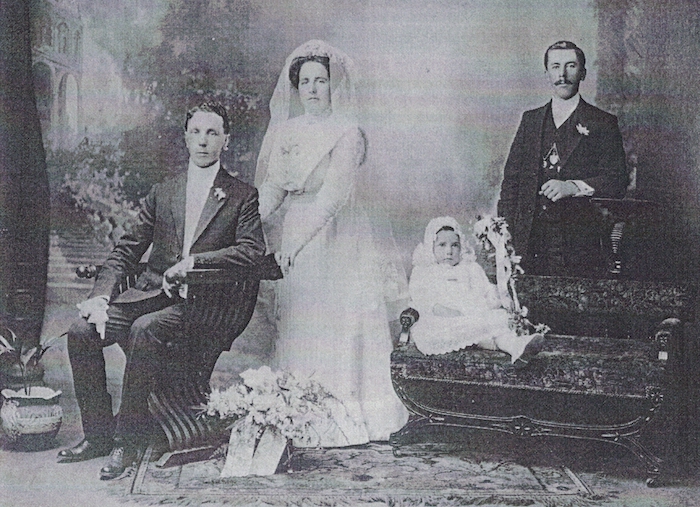
Miriam Robertson and David Lawson on their wedding day, 10 September 1910 [with her cousin Rab Robertson? and unknown child]
The youngest of James Robertson and Frances Halls’ eight children, born at Cobden on 18 June 1887. In the Victorian records Miriam’s name is recorded as Marion Bazaret Robertson (file number 18404). Her second name was that of an evangelist her mother admired. Miriam apparently hated the name and would be extremely embarrassed if she was asked to give her full name.
 William de Witt (?), Miriam and James Robertson
William de Witt (?), Miriam and James Robertson
Margaret Haine relates that much money was spent on having Miriam taught music. She was both a pianist and a violinist and after her father’s death in 1905 when Miram was eighteen, she was able to make a living by teaching music. James’ death caused the break-up of the family home. Miriam’s sister, Frances, was married and living in Queensland and the boys had all gone to the goldfields in Western Australia. Miriam had to decide whether to join her brothers in WA or her sister in Qld. Her brothers told her she would easily get a job as a waitress in WA but this did not appeal to Miriam, so she decided to go and live with Frances at Beaudesert. [Interviews with Margaret Haine, April and November 2000]
 It was in Beaudesert that Miriam met and married her husband, David LAWSON (1886-1968). David worked in the office at the local butter factory. The couple married in 1910 with Miriam’s brother-in-law, the Rev H E Saunders conducting the service and her cousin Rab Robertson giving the bride away. David had come to Australia from Scotland. Later he was to work as the secretary of a department store in Brisbane.
It was in Beaudesert that Miriam met and married her husband, David LAWSON (1886-1968). David worked in the office at the local butter factory. The couple married in 1910 with Miriam’s brother-in-law, the Rev H E Saunders conducting the service and her cousin Rab Robertson giving the bride away. David had come to Australia from Scotland. Later he was to work as the secretary of a department store in Brisbane.
Frances and James Need (?) Robertson
Margaret Haine recalls that ‘Uncle David’ recited poetry such as 'It’s good to be British today’, and played the ocarina, to entertain the family. He never owned a car but would hire one, along with a driver, to take the family on outings to the hills or to local beauty spots for picnics.
Miriam and David had three daughters, Winifred, Gwen and Irene. David died in Brisbane in 1968 and Miriam died two years later.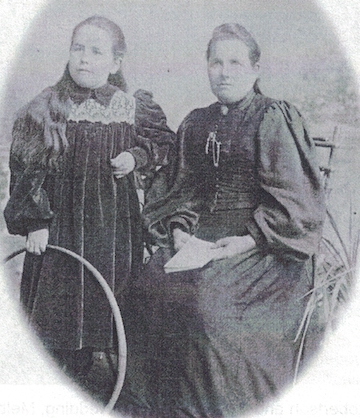
Miriam with Frances Snr Robertson
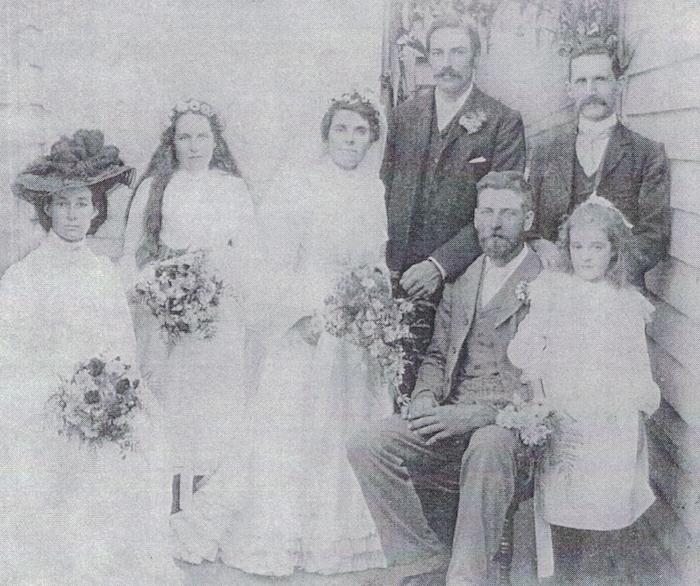
Frances Robertson and Henry Saunders on their Wedding Day, 1903
Nan Robertson, Frances' cousin was her bridesmaid.
Extended family at Frances Robertson and Henry Saunders Wedding, Melbourne 1903
This photograph includes Frances Halls and James Robertson as well as Nan Robertson who is a bridesmaid.
page 89
Willimina Jemima Edith ROBERTSON (1875-1955) - MARRIED NAME WARD
Only child of Arthur Robertson Jnr and the youngest of Margaret Rutherford Cairn’s thirteen children, born 2 November 1875 at Skipton. Known as Mime or Mina. I have been given a number of different spellings for Willimina’s name; the one used here is the spelling she used when she signed her name as a witness on her father’s second marriage certificate.
Soon after Mime’s birth, Arthur and Margaret moved from Derrinallum, where Margaret had property, to Port Campbell. Mime must have grown up in the company of her Cairns half-siblings, the youngest of who were only a few years older than Mime. Sam and Kate Cairns are listed as attending the Port Campbell School in 1877.
Mime was friendly with her cousins Nan and Frances Robertson and there is a posed photo of them together in the possession of Margaret Haine.

Boer War training camp picnic Far left Chris Ward, far right Minnie Ward.
A touching tribute to Mime was written by Hilde Knorr.1 In this Knorr talks about life in Port Campbell when she stayed with Mime. She also relates about Mime and Chris Ward’s romance, as told to her by Mime:
page 90
“They had grown up as neighbours almost, but it wasn’t until he was setting out for the Boer War that he had spoken of his love. ... There were several young men going away that day ... She was standing with a little group, waiting to say a last goodbye, when the boys rode up. ... Chris was riding a little behind the others and he was quiet. ‘I was always fond of him, but as I watched him riding up I thought: Dear God, if anything should happen to him, how shall I live? By the time he came to where I was, the others had surrounded his companions, and I was standing alone with my eyes on the ground, trying to cope with my unfamiliar feelings. He stopped beside me, and leaning down, put his hand gently under my chin, and turned my face up to his. I had to struggle to meet his grave young eyes. Just for a few seconds he looked at me, then he said ‘You will wait for me, won’t you Mime?’ I nodded, for I couldn’t speak. He let me go and joined the others. ... Still trembling I watched the horsemen as they turned the bend in the road, and were lost to us’."

Chris Ward On his return from the Boer War.

Chris Ward and Mime Robertson On their wedding day 1903.
Chris returned from South Africa two years later. He had risen to the rank of Lance Corporal and bore the scar of a wound in his right arm. Mime married Christopher WARD (1876-1918) in 1902.
They settled down as farmers at Port Campbell gradually clearing their land and running dairy cows and pigs. Their block, which is marked on the Lands Department map in the name of G Chiselett, was on the corner of Timboon and Currell’s Roads. It was called ‘Blackwood Bank’. Gus Ward believes his family acquired the land “by adverse possession [payment of back rates for twenty-eight years].”2
Chris’ parents were Peter Ward and Eliza Stagg and he was the eighth of their eleven children. This was a local family and the Ward name appears frequently in Fletcher’s history of the Heytesbury Shire. Wilbur Oswald Ward, the Baptist minister was Chris’s older brother. In 1906 Chris was captain of the Port Campbell Rocket Crew and in 1912 he purchased a milking machine, which was the first in the district.3
The following story, which comes from Gus Ward, gives us some idea about life in the Port Campbell area before the First World War. I have done some minor editing:
“Uncle Henry Cairns’ son-in-law, Sidney Petty, was an Englishman who came from Brighton, England. [He] just saw an ad for going to Australia. All he had ever done in Brighton was deliver flowers for a florist. He arrived in Melbourne somewhere around 1910 and saw a job at Peterborough and got on a train and came to the end of the world. It was just forest. My grandfather
page 91
Christopher Ward happened to be at the Timboon railway station and saw this bewildered kid get off the train and knew he was from ‘the old country’ and asked him where he was going. He said ‘I’ve got to get to Peterborough,' so Chris took him and put him on a wagon going to Peterborough. The poor fellow, he had to get up at 4 o’clock and feed the horses at the Peterborough Hotel and cut chaff and he’d never done work in his life before. My grandfather said to him ‘if you ever get a day off come across to Port Campbell’ and he did and he finished up marrying one of Mime’s Cairns nieces and he lived in Australia for the rest of his life. He didn’t last too long on the farm, he went back to Melbourne and worked in the ES&A bank until he retired.”4

Frances, Isla, Mime and Arthur Ward, circa 1916
Mime and Chris had one child of their own, Arthur Christopher, born in 1905 and an adopted daughter Isla, born in 1904. Isla was the daughter of Chris’ sister Minnie Michel. Just when she came to live with Mime and Chris is uncertain and possibly it was an informal arrangement rather than a formal adoption.5
Later the family included Frances Isobel Ward, the daughter of Chris’ brother Walter and Isabel Thompson. Fanny was born in 1899. Her mother died in 1903 and Walter remarried in 1907. Fan came to live with Mime during World War I, to help with the household while Chris was away: “I stayed on with the family working on the farm with my cousins Isla and Arthur until I was married to Norman Magilton at the age of twenty-six.”6 Fanny is the grandmother of Matthew Magilton. Matthew has contributed information about the Ward and Magilton sections of the family.
In July 1917 Chris rejoined the army and went off to fight in World War I. In his recruitment papers Chris is described as five foot ten and a half inches tall, 168 pounds in weight and as having blue eyes and fair hair. His occupation is recorded as dairy farmer. Chris was appointed to the 4th Light Horse Regiment and served in Middle East. He was made a temporary Lance Corporal in May 1918, but reverted to Trooper the following month when he was taken off duty and hospitalised with dysentery. He did not rejoin his regiment until 7 September. On 30 September 1918, Chris was ‘killed in action'.7
The circumstances of Chris’ death are uncertain. There are two very different versions within the family and as I have not been able to substantiate either of these from the records, I include both. Chris’ army record gives no explanation other than: “The only information to hand is to the effect that he was killed in action about 2 miles north of Sasa and 300 yards on [the] west side of the main road to Damascus”.8 His burial place is unknown but presumed by the army to be beside the road near where he was killed. There is a memorial panel for Trooper C N Ward in the Jerusalem War Memorial Cemetery.
Gus Ward writes about his grandfather: “He, being a Lance Corporal in the Cavalry, had to gallop in front of his platoon to take the surrender of a German division. As he lead the charge, a German bent down, picked up a rifle, which had been laid on the ground, and shot him, the leader, in the back as he went past. ... This is authentic, told to my father by returned soldiers who were with him”.9
page 92
The other version, which comes from John McCue and Lottie Dickins, is that Chris was shot by his own sentry. If in fact Chris was killed by ‘friendly fire’ - which is not as uncommon in war as we may like to believe - the army would not have told the family, and in consideration of the feelings of the bereaved it is possible Chris’ army mates might have also presented a more acceptable version.
Whatever the circumstances of Chris Ward’s death so close to the end of hostilities, the sad reality for his family was that he did not return home. The army records reveal that Mime made efforts to discover her husband burial place right up until 1923. Margaret Haine believes Mime was asked to forgo her army pension because she had been left quite well off. Mime wrote back to the appropriate department saying she would forgo her pension if they could give her back her husband.10
Chris left his property in the ratio of five parts to Mime, one part to Isla and four parts to Arthur. Mime and her half brother, Bill Cairns, were appointed executors.10 11 With Bill’s help, Mime carried on running the farm until Arthur was old enough to take over. Bill Cairns married twice but it seems he was ‘unattached’ at the time he was helping Mime.12
Mime continued living and farming at Port Campbell. She is named as one of the leading landowners of the district, in an article published in the ‘Cobden Times’ in June 1922. Arthur McCue’s name is included in the same list.13 Hilde Knorr, in the piece I quoted from earlier, gives us a picture of Mime as a gentle God loving and hospitable woman. She describes “a quality of blessed homeliness” about the room into which she was shown, “the snowy marcella quilt and frilled pillowcases, the old marble washstand with basin and jug filled with clear rain-water under the white, white towels, the tiny trailer roses on the wall-paper, and the framed text over the bed.”14
Mime was one of the participants at the Jubilee of the Port Campbell Baptist church in 1935. The programme tells us she had played the organ and led the singing at the church for thirty years until ill health prevented her from continuing. Mime died in 1955 and is buried in the Port Campbell cemetery.
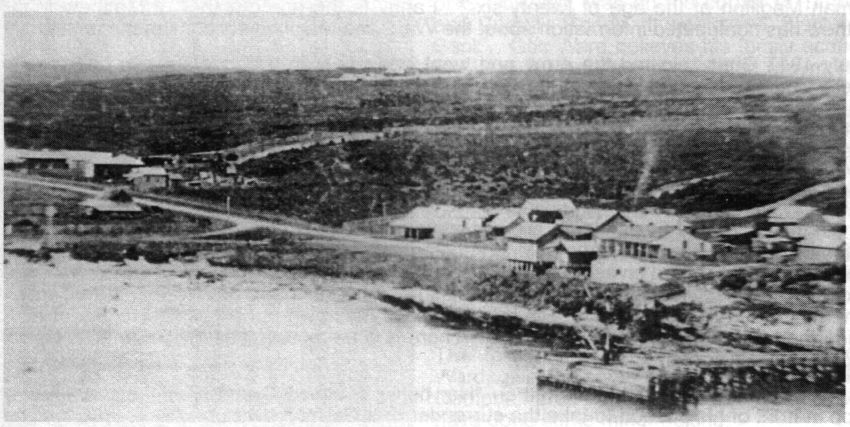
Early photograph of Port Campbell
The building on the foreshore at the left was the blacksmith shop of George Cairns, Mime’s half brother.
1 Hilde Knorr nee Dent, published under the heading From the Uttermost Coasts’, in The Messenger', a Catholic Church newsletter, 1 July 1957
2 Judith Ward, 21 October 2002
3 J. Fletcher, ‘The Infiltrators’, p.264 and p.268.
4 Taped interview with Gus Ward, April 2000
5 For more information about Isla Ward’s background see Part IV
6 Taken from notes written by Frances Ward Magilton about her life, in the possession of Matthew Magilton
7 A copy of Chris Ward’s army record is in the possession of the author
8 Letter to Mime dated 27 June 1921, there is no heading on the letter but it is signed by the officer-in-charge of Base Records
9 Letter from Gus Ward, 5.11.1999
10 Interview with Margaret Haine, April 2000
11 The probate certificate is included in the Army records
12 Interview with Gus Ward, April 2000
13 J. Fletcher, 'The Infiltrators’, p.221
14 Hilde Knorr writing in The Messenger'
page 93
Note the different spellings, with Arthur using Chislett and William using Chiselett
Arthur John CHISLETT (1872-1951)

Arthur Chislett and Emma Staub, 1900
First child and eldest son of Margaret Robertson and George Chiselett, born at Tooliorook on 17 February 1872.
Arthur was shearing at Beulah with his father in 1894 when George Chiselett died there.
While working in the Wimmera, Arthur met Emma STRAUB (1879-1969) and the couple married in Melbourne in 1900.1 They lived on a dairy farm at Cobrico near Cobden, for the first years of their marriage. Gordon Croft says they moved to Lah in 1911, where Arthur bought a tractor and chaff cutter and worked as a contractor cutting chaff. In 1913 he bought an orchard near Warracknabeal.2 By this time, six children had been born into the family and four more were added by 1922. The children were George, Albert (who died soon after birth), Bertha, Grace,
Keith, Clarence, Gordon, Lindsay, Stanley and Norman.
Like his father and other members of his family, Arthur suffered from asthma.
This was apparently one of the reasons prompting the family’s move in 1916 or 1917 to northern Victoria where the climate was warmer and drier. Arthur had no trouble with asthma after the move. At Merbein on the Murray River, Arthur took up fruit growing for the dried fruit industry. His seven sons worked on the farm.
Arthur took an active interest in community organizations; schools, the Ratepayer’s Association and the Auxiliary for the Blind. He was secretary of the Merbein Church of Christ, and a Life Governor of the Base Hospital. Becoming involved in local government, he served on the Mildura Shire Council for twenty-two years and was President of the Shire for two terms.3
Norm Chislett describes his father as a rather distant figure of whom he has few happy memories. On one occasion when Norm was sick in bed for a month, Arthur hardly came in to see him. He reckons his father had it pretty good with all the family working for him. Norm and Claire (Gordon Chislett’s widow) speak of Emma with great affection - a caring person who carried the load of looking after the family. She had no mod cons and worked hard. The washing
page 94
was done with a ‘plunger’ and all the water had to be carted. She used to cut down clothes from one child to the next, and sold milk to make extra money.4
In 1943 Emma and Arthur sold their farm at Merbein and retired to Mildura. Arthur died there in 1951 at the age of seventy-nine. Emma died in Adelaide in 1969 at the age of ninety. They are both buried at Mildura.

Arthur Chislett’s Family Left to right, back row: Keith, Gordon, Stanley, George, Clarence, Lindey, Grace, Bertha. Seated: Norman, Arthur, Emma
The Folk from the Wind Wound Isle
was done with a ‘plunger’ and all the water had to be carted. She used to cut down clothes from one child to the next, and sold milk to make extra money.5
In 1943 Emma and Arthur sold their farm at Merbein and retired to Mildura. Arthur died there in 1951 at the age of seventy-nine. Emma died in Adelaide in 1969 at the age of ninety. They are both buried at Mildura.

Arthur Chisiett’s Family Left to right, back row: Keith, Gordon, Stanley, George, Clarence, Lindey, Grace, Bertha Seated: Norman, Arthur, Emma
page 95
Margaret Henderson Selina Georgina CHISELETT (1876-1939) - MARRIED NAME CROF
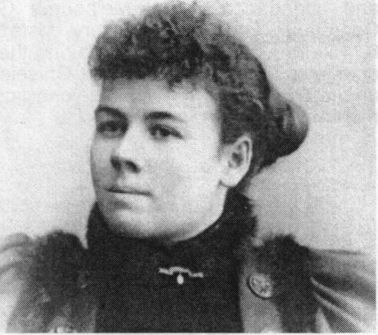
Selina Chiselett
Second child and eldest daughter of Margaret Robertson and George Chiselett, born at Ellerslie on 11 November 1876. Known as Selina.
Gordon Croft, in his books about the Chiselett and Croft families, says that after their father’s death in 1894, it was necessary for the Chiselett girls to make their own living.6 Selina’s first job was with a Dr Fleetwood in Warrnambool. She moved to Melbourne where she and her sister Susan obtained work as domestics. For some years Selina worked as a cook at the Queen Victoria Hospital in Melbourne.
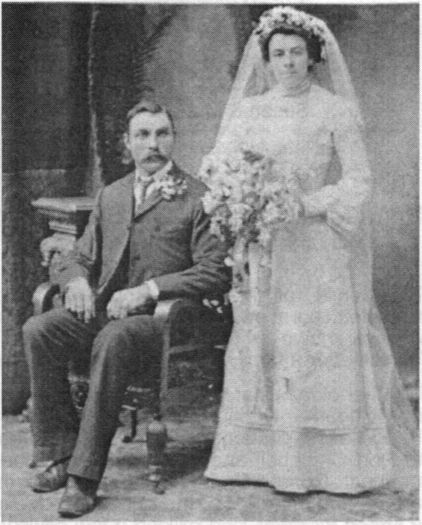
In 1904 Selina married Harry CROFT (1872-1949) at Port Campbell. Harry was the sixth child of Henry Croft and Ann Merrett. Both the Croft and Merrett families had come to Australia from Gloucestershire in England. Before moving to Port Campbell in 1884, the family lived on the western side of Peterborough, further along the coast towards Warrnambool, at Croft’s Bay.
Selina and Harry initially settled on a farm at Curdies Inlet but later moved into the Croft home at Newfield, inland from Port Campbell. This farm was called ‘Dursley’ after the town where Ann Merrett had been born. The property is now owned by Jeff and Di McCue. Jeff is descended from Margaret Robertson’s sister, Agnes.
Selina and Harry had one child, a daughter named Ruby (1905). In 1919 the family moved to land near Camperdown, but lived there for only two years before moving into Camperdown township and early retirement. Selina’s mother came to live with them shortly before her death in 1925.
Selina died in 1939 at the age of sixty-three. Harry lived for another ten years. They are both buried in the cemetery at Camperdown.
Harry Croft and Selina Chiselett On their wedding day in 1904.
Fourth child of Margaret Robertson and George Chiselett, born at Ellerslie on 2 January 1879.
After her father’s death in 1894 Susan found work in Melbourne as a domestic. While she was there a typhoid epidemic broke out and Susan was one of the victims of the disease. Her sister Selina was the only family member with Susan when she died on 27 February 1899, and it was Selina who arranged for Susan’s burial in the Baptist section of the Melbourne General Cemetery.
page 96
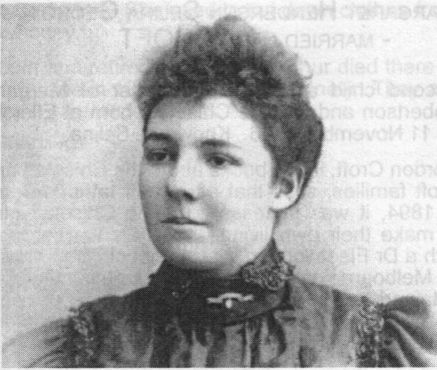
Susan Chiselett
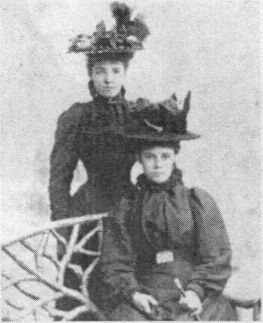
Susan & Muriel Chiselett
Gordon Croft gives details of a receipt for the burial as follows: “One Cloth-covered and Mounted Coffin, inside lined and upholstered; and including Hearse and pair of horses and attendance to the Melbourne General Cemetery. Cost £4. Cemetery costs £2-10-0.“ Gordon also tells us that during the same epidemic Susan’s Uncle John Chiselett was another victim, dying at Geelong just one month after Susan.7
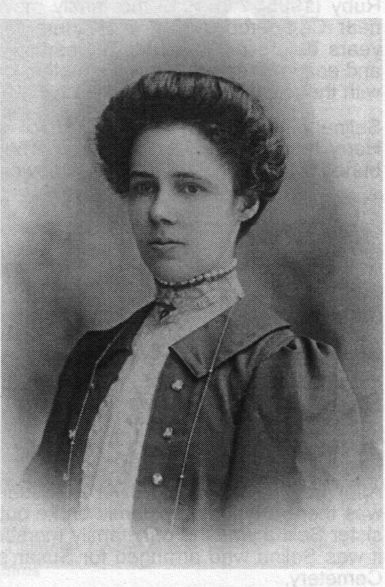
Muriel Chiselett
Edith Muriel Wilson CHISELETT (1882-1963) - MARRIED NAME DICKINSON
Fifth child of Margaret Robertson and George Chiselett, born at Port Campbell on 8 March 1882. Always known as Muriel. She was given the name Wilson after a family her mother was friendly with.
Like her older sisters, Muriel found work as a domestic in Melbourne, working for a Miss Puckles at Moonie Ponds as a parlour maid. In 1905 Muriel returned to Port Campbell and lived with her mother until she married. Gordon Croft tells us, “She took the place of a man and did most of the outside work, slaughtering a sheep for meat, and milking a few cows was all in a day’s work.”8
At the age of forty-one Muriel married James DICKINSON and they lived on a dairy farm at Newfield. They had no children. I have no other information about James except that he died before his wife. Muriel died at Timboon in 1963 and is buried at Port Campbell.
page 97
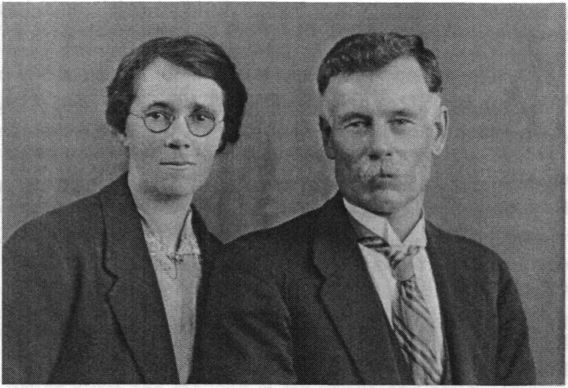
Murial and James Dickinson
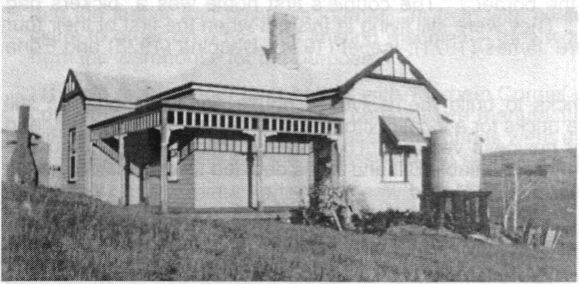
Dickinson homestead, Port Campbell
Elizabeth Ruth CHISELETT (1885-1940) - MARRIED NAME CROFT
Eighth child of Margaret Robertson and George Chiselett born at Port Campbell on 22 November 1885. Known as Ruth.
Ruth sometimes substituted for Muriel in her work for Miss Puckles and she also worked as a domestic at the Eye and Ear Hospital in Melbourne. In 1905 she married Richard CROFT (1878-1947) who was the younger brother of Selina’s husband. It is interesting to note here that Dick and Harry’s older brother, George Croft, married Margaret Mathieson who belonged to the same Mathieson family some other Robertson descendants married into (see Appendix 3). I believe George and Margaret’s son, Aenger Croft, has written a history of the Mathieson family, but I have not been able to get a copy this.
Ruth and Dick had a farm called ‘Widdicombs’, across the road from his parents’ farm, and the first two of their three children were born there, Muriel (1906) and William (1909). Their third child, Gordon, was born at Pinnaroo. Ruth was another member of the family who suffered from asthma and she and Dick moved to Murrayville in the Mallee for the sake of her health. There they established from scratch, a wheat and mixed farm, living in a tent beside a bore before their house was built. The family remained at Murrayville until 1937, when they moved to Nirranda on the south coast.
Norm Chislett remembers his Auntie Ruth using some sort of inhalation pipe to ease her asthma. He also tells us that a seemingly minor incident when Ruth was pierced with a sewing needle, resulted in a severe infection and Ruth’s arm had to be amputated.8 In 1940 Ruth died following
8 Interview with Norm Chislett, April 2000
page 98
a bout of asthma and was buried in the Warrnambool cemetery. Her husband joined her there seven years later.
William Adie Robertson CHISELETT (1888-1948) and Robert John CHISELETT (1888-1909)
William and Robert were the youngest children and the second set of twins born to Margaret Robertson and George Chiselett. They were born at Port Campbell on 18 June 1888.
The boys continued living with their mother during their teenage years, finding work around the district. Robert was killed in a quarry accident in 1909, shortly before his twenty first birthday (see Chapter 10).
In 1911 William went to live with his sister Ruth and her husband at Murrayville. There he helped them to clear scrub and establish their farm. In 1919 he moved on to Merbein to go into partnership with his brother Arthur on a ‘dried fruit’ block.
In 1920 William married Doris TYLOR (1895-1991). Doris grew up in Adelaide and came to Merbein to pick grapes on a cousin’s property. She could not return to Adelaide “because an outbreak of pneumonic flue closed the border”9. The couple’s first home was a “pickers bag hut on a property near the township”. They were still living in this hut when the first of their four children was born. The children were James (1921), Isabel (1924), Despina (1928) and Edna (1930).
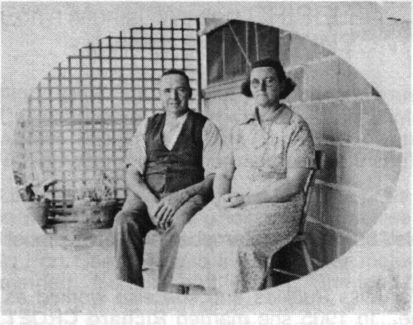
William and Doris Chiselett
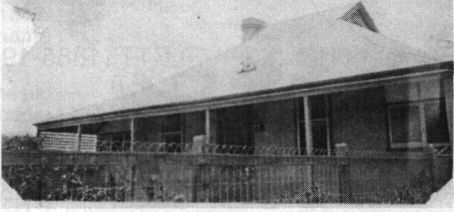
Chiselett’s home in Merbein
William and Doris made cement bricks to build themselves a house and this house is still standing in Merbein. They also made bricks for a local doctor to build his home and surgery and earned money this way to start their business venture. The summer following their marriage was extremely hot and with no cool drinks available Bill and Doris decided to establish a cordial factory. The cordial factory was opened in 1921 and was run by the family until it was sold in 1970.
Isabel and Erik Nordin give us a vivid description of the cordial factory:10
“Doris’ father came up from Adelaide to help start it. He brought the recipes for syrup making and soft drink manufacturing with him and began in partnership with Doris and William.
“The first efforts were fairly crude. The bottles were from the bottle collectors and were washed in a large trough with hand held bottle brushes. The water was heated in a large copper and bucketed into the trough. The clean bottles were then rinsed with water jets whilst they were upside down on a system of pipes, then allowed to drain on a board with holes to hold them upside down. When drained they were place in boxes to be filled.
page 99
“Later on they arranged a system of a revolving brush that made work easier. Despina was at the trough one time and her hair was caught in the brush and was pulled into a tangle around it. Luckily someone turned the motor off before too much damage was done to her hair but one side of her head had to be cut free and she lost half her hair.
“The syrup was made of sugar and water in a 30 gallon glass lined vat. When dissolved it was filtered into buckets and the flavouring essence and citric acid were added for each specific flavour. Fruit juices were added to the fruit flavoured syrups.
“The syrups were poured into a copper container which had 4 cups (each holding 4 oz) on a centre spindle with pipes attached to the cups. The empty bottles were placed on these pipes and the weight of the bottle raise the cups and 4 oz of syrup ran into the bottle. They were then covered and taken to the filling section.
“William would fill each bottle with soda water on a machine one at a time working it with one foot on a pedal. The soda water was made in a carbonator which mixed CO gas and water to the required pressure for different flavours - 601b for plain drinks, 50Id for fruit drinks, 1001b for soda water. This soda water of 1001b was used to fill soda syphons.
“Under the pressure many bottles would burst and resulted in cut hands and arms. This method of manufacture was a slow process and meant many hours of toil during the hot weather. At night after working all day Doris would do the bookwork, keeping accounts and the ledger and business journal. To help with finances she also made jumpers and skirts to order on a two bed knitting machine - they would buy Paton’s 2ply wool in bulk from the warehouse for the purpose.

Cordial Factory, Merbein 1921
“The old stone ginger beer bottles with ‘Merbein Cordial Works’ logo are rare and valuable collectors items. The first stone bottles were manufactured in Scotland and were sealed with cork and tied with string. The soda syphons were also made in England and came in colours of blue, pink and clear glass with the name logo also on them.”
As the children grew older they worked in the factory labelling drinks and packing crates, and at the age of fourteen Isabel left school and took over the task of running the family’s domestic arrangements.
William was known as 'generous Bill’ because he gave free drinks to organizations that were fund raising. He suffered all his life from chronic asthma and smoked a herbal tobacco, called Tatulla, to clear his chest. Gradually the disease debilitated him and he died just short of his sixtieth birthday. He is buried in the Merbein cemetery.
The family continued running the cordial factory but after it was sold in 1970, Doris moved to Geelong where she lived with daughter Isabel and her husband. She spent the last nine years of her life into a nursing home and died there in 1961 at the age of ninety-five.
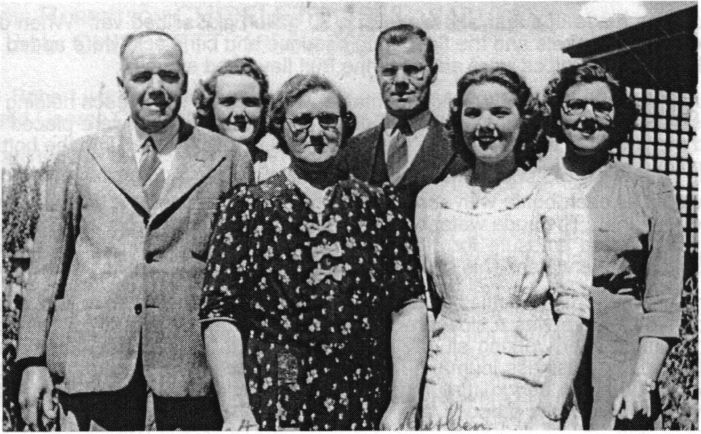
William Chiselett’s Family
Left to right: William, Despina, Doris, James, Edna, Isabel
1 Straub is sometimes spelt with an 'e’ (Straube) in the Victorian records
2 G. Croft, The Chiselett Story'
3 Obituary, from an unknown newspaper
4 Interview with Norman Chislett and Claire Chislett, April 2000
5 Interview with Norman Chislett and Claire Chislett, April 2000
6 G. Croft, ‘The Chiselett Story’ and ‘Croft Family History 1803-1974’. For details about Margaret Robertson’s children I have relied heavily on the information gathered by Gordon and presented in these books.
7 G. Croft, ‘The Chiselett Story’, p.54
9 Letter from Erik and Isabel Nordin, 8.3.2001
10 Information about this section of the Chiselett family was supplied by Isabel and Erik Nordin. The piece about the cordial factory is taken from the letter, 8.3.2001
page 101
Stories related to me by family members suggest that Robert and Molly’s household was a dynamic one, full of strict rules, yet full of change as people came and went. Life flowed around Robert’s evangelical work. Molly supported him in this but occasionally it meant hard times. Robert would go away on one of his tent missions and Molly had to make ends meet as best she could, often relying on charity to support herself and the children still at home. Margaret Haine supplied a ditty that Robert used to sing: 1
When the purse is rather slim
And the bills are coming in
Then Satan needn’t grin
Alleluia
I’ll be strong in the belief
That the Lord will send relief
He’s a never failing chief
Alleluia

Barwon House, circa 1912
Stuart Robertson Jnr gives us a picture of family life at Barwon House at the beginning of World War I, when he, his parents and his sister Mary lived there for a time:
“There was always a most interesting life style going on, with Grandpa, Auntie Nan - who round about that time was Secretary [of the Western Australia Women’s Temperance
page 102
Union], She used to wear a white enamel badge tied in a bow with WA and some description of the Women’s Temperance Union. Aunt Margaret used to swan around as she usually did when she was mistress at Geelong Grammar. Uncle Stuart was always there and he was supposed to be my guide, philosopher and friend. Grandpa, who seemed to be in and out of the place quite frequently - away on preaching rounds - and Grandma was my absolutely sole help.
“One time there I apparently did something that aroused the ire of my father and I scuttled away and escaped him. He went through the house looking for me and couldn’t find me for the simple reason Grandma, in her great big long black skirt, had me hidden under her skirt in between her legs.”2
Prayers in the house, night and morning, were led by Robert if he was home, and by Molly if he was away. The prayers were apparently long and tedious for small children. Stuart tells us, “it was the done thing to get down off your chair and kneel with your head resting on the seat of the chair”. He can still call to mind the smell of the chair leather. His sister Mary recalled having to stay perfectly still and the roughness of the horsehair couch filling. Her grandmother, taking pity on her, would surreptitiously slide her skirt over the seat so that Mary's face rested on the skirt rather than the horsehair.3
According to Stuart, everyone came back to Barwon House sooner or later and would “stay there for some length of time. They would come home because they had no place else to go.”4
At the back of Barwon House was a three-storey timber building where shearers and farm hands used to stay. Stuart was only allowed to go there if his Uncle Stuart accompanied him. From here the land sloped down to the Barwon River. Nearby lived a family known as the Windmill family. Stuart believes they were something to do with the manufacture of leather, and they were also involved with the ‘Christian invasion’ of New Guinea. They were building a motor launch in

Robert Robertson Family
Taken at Barwon House at the time of Lottie Robertson’s wedding to Sid Dickins on 4 January 1916.
Left to right, standing: Arthur, George, Josh, Glady, Stuart. Seated: Lottie, Rab, Robert, Molly, Nan, Maggie.
page 103
their yard as part of this involvement. Everyone from round about, including Stuart, came to watch the boat being launched. It was rolled down to the river on logs.
Two stories about the family come from Margaret Haine.5 Back in those days there were varying grades of butter. For everyday the family used the cheapest grade of butter, but visitors were served a better butter. One time when a visiting dignitary was being entertained, there was a lapse in the conversation. Clearly heard in the ensuing silence was one of the boys saying to his brother, ‘Hand me the bad butter’.
On another occasion Nan was standing looking out of a window and described to others in the room with her, the approach of a young man and women coming from opposite directions across the paddock behind the house. Eventually the couple met and kissed. Lottie was too small to see out the window and was desperately trying to drag a chair across so she could climb on it and see out, exclaiming all the time that she did not believe Nan, for such a thing could not be happening.
Robert (Rab) ROBERTSON (1875-1961)
First child and eldest son of Robert Robertson and Mary Jane Cairns, born at Port Campbell. It was accepted in the family that Rab was born on 8 August 1876, however the Victorian records show he was actually born in 1875, four months after his parents marriage. Whether the more respectable date of 1876 was perpetrated by his parents or Rab himself we shall never know. It does however tell us something about the mores of the time.
As a small child, Rab went out with his father when Robert was building stone fences. Rab’s job was to find the small stones that fitted in between the larger stones, which made up the walls.
Rab probably received his primary and secondary education in Geelong. He had a fine singing voice and photos of him as a young man show him to be dark haired and good looking. He went on to train for the Baptist ministry at the Baptist College in Queensland and was among the first group to graduate from the college.

Fanny Daniell and Robert (Rab) Robertson
When his brother Josh was preaching at the Baptist Church in Gympie, Rab made a trip to see him. While there, Josh introduced him to Fanny Jane DANIELL (1873-1961). Fanny was the youngest child of William Jeremiah Daniell and Jane Jackson, who ran a haberdashery and drapery shop in Gympie. She was a student teacher and organist at the Congregational Church. Because she wore glasses Fanny was known to her pupils as ‘Fanny four eyes’. She was partially deaf, a disability which became worse as she got older. Rab and Fanny were married in Gympie in 1907.
page 104

Brothers Rab and Josh Robertson in Brisbane >
Rab’s first ministerial appointment was to the Sandgate Baptist Church and it was at Sandgate the couple’s two children, Mary and Stuart, were born in 1908 and 1911. In 1910 when Rab’s cousin Miriam Robertson married David Lawson at the Beaudesert Baptist Church, Rab gave the bride away. On his departure from the Sandgate church, Rab was presented with an illuminated address by the congregation. The original of this is now in the collection of the Brisbane Baptist College.
Leaving Sandgate in 1914, Rab moved his family to Victoria, where they lived at Barwon House in Geelong with Rab’s parents and other members of the Robertson family. The details of this period are unclear but it seems Rab had no church appointment in Victoria until called to the Elsternwick Baptist Church in about 1916. Prior to the move to Elsternwick, Fanny went back to her parents in Gympie. Whether Fanny intended this to be a temporary or permanent separation is not known. Richard was told by his mother Mary, that she was seven at the time, and she wrote a pleading letter to Fanny asking her to come back and Fanny did return.6
When the ministry at Elsternwick finished, the family moved to a house called ‘Helen’s Lea’ at Ripponlea. Stuart remembers this as a fine two-storey house that had been built by a Judge Hood. It overlooked vacant land and there were few other houses about. From the top floor there was a view out to Port Phillip Bay, Point Ormond and St Kilda and at night they could see the lights of the city. The house is now part of Shelford Girls Private School. Rab was called to the Sale Baptist Church. Fanny and the children continued to live at Helen’s Lea for a period before joining Rab in Sale. The family lived in Sale for seven years, returning to Melbourne in 1928 and again residing at Elsternwick. Rab then worked for a time as an itinerant preacher with the Victorian Baptist Union. His daughter Mary would sometimes accompany him on these tours of duty, while Fanny and Stuart, who was attending Melbourne High School, remained at Elsternwick.
Rab's last calling was to the Kyneton Baptist Church from 1929 to 1935. Rab’s brother George was the Presbyterian minister at Tylden, a short distance away from Kyneton, and the two families would get together for picnics, and the brothers would go fishing together. In photos recording these occasions Rab is always dressed in his clerical garb of black suit, ‘dog collar’ and Homburg hat. It was at Kyneton that Rab bought his first and only car. In Sale he had had a horse and jinker but prior to that all his pastoral work had been carried out on foot.
The time at Kyneton finished badly. Rab did not get on well with the church council and finally had a serious argument with the church secretary. Stuart believes his father was blackballed with the Baptist Union and Rab did not receive another appointment. Stuart describes his father as conservative in his work but good at mixing with those who had nothing to do with the church. When I asked Stuart what Rab did in his retirement his answer was - “Nothing, he did nothing!”
In retirement Rab and Fanny lived at 10 Ormond Rd, Ormond until 1961. They then moved to a cottage on the property at Vermont belonging to Mary and her husband Sid Dickins. There, Mary could look after them. Fanny was by this time blind as well as deaf. Finally the couple moved to a nursing home and they died within six weeks of each other, Rab at the age of eighty-six and Fanny at the age of eighty-eight years.
Anne Adie ROBERTSON (1877-1958)
Born at Port Campbell on 28 July 1877. Always known as Nan, she was the eldest daughter and second child of Robert Robertson and Mary Jane Cairns.
Like so many other members of the family Nan worked as a music teacher. She had a close friendship with her cousins Mime Robertson and Frances Robertson and was Frances’ bridesmaid when Frances married Henry Saunders in 1903.
Nan was the secretary of and organizer for the Women’s Temperance Union in Victoria and later in WA. This was the leading women’s organization of its day, radical in outlook, working for female suffrage and dealing with other feminist issues, including its better known campaign against alcohol and the effect of alcohol on family life. Nan went to America for the WTU in 1922
page 105
and on her return she visited her cousin Frances (Robertson) Saunders in Tasmania. She was in WA at the time her brother Arthur and his family were living there in the 1930s.


Nan Robertson with her cousin Willimina Robertson — Anne Adie (Nan) Robertson
Lottie tells us Nan returned home to live with her parents during the Depression because she was unable to get work, and stayed on to look after them in their old age. She was unmarried and had no issue. She supplemented her income by doing beautiful handiwork and I have a well-worn rug she crocheted for me as a child and a shawl she made for my mother. After her parents died, Nan stayed on in the family home at Belmont which she shared with her brother, Stuart.
Second son and third child of Robert Robertson and Mary Jane Cairns, born at Port Campbell on 11 May 1880.5
The family moved to Geelong where Josh received both his primary and secondary education, the latter at the now defunct Central College. He qualified for matriculation at the age of fifteen. Looking for work and having no money, he walked overnight to Melbourne, a distance of some 70 km, to answer an advertisement for a job, only to find the position had been filled before he got there. A relative lent him the money to return to Geelong by ship. He then found work with the Geelong Gas Company.6
About 1900 Josh went to Queensland and worked as a Home Missionary in the district around Roma and after that at Sandgate (1903-04). He attended the Queensland Baptist College where his brother Rab also studied, qualifying as a Baptist Minister and working with the Evangelical Society of Australia. While in Queensland, Josh met and married Josephine (Josie) HOGAN (1875-1939), the daughter of Joseph Hogan, a sanitary contractor, and Anna Maria Ness. Their only child Rutherford Ness Robertson was born in Melbourne in 1913.
In 1909 the couple moved to Melbourne where Joshua was appointed to various parishes; South Melbourne (1909-12), Footscray (1912-13) and Brunswick (1913-17). During and after the First World War, Josh was a chaplain with the Citizen’s Military Forces. In 1917 he enlisted for active service with the Australian Expeditionary (Imperial) Forces. He served as a chaplain in France for two years. While in France Josh made a trip to see his brother Gladstone, who was serving in the AIF, only to find Glady had died from wounds sustained in action the day before Josh got there.
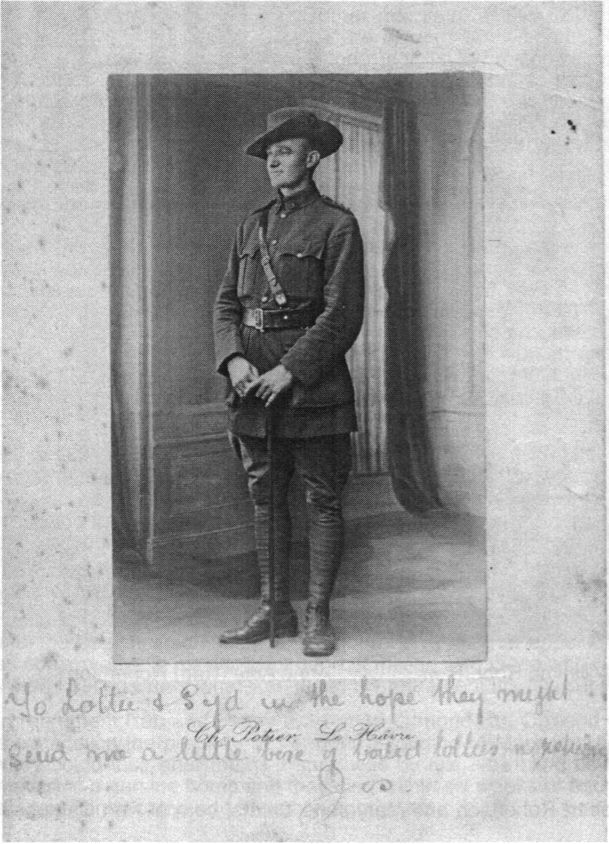
< Joshua Robertson
Josh sent this post card to his sister Lottie from France during World War I and it shows Josh in uniform as an Army Chaplain.
On his return to Australia in 1919, Josh was appointed to the Canterbury parish in Melbourne and was there until 1926. During this time Josh studied for and obtained his Bachelor of Arts from Melbourne University. The family moved to Christchurch in New Zealand where Josh was Minister at the Oxford Terrace Baptist Church. While in Christchurch, Josh obtained his Master of Arts from the Canterbury College, as well as a Diploma of Social Science. Returning to Australia in 1930, he was called to the Petersham Baptist Church in Sydney and served there until 1946.
Josh’s son Rutherford describes his father as an “evangelical type preacher in the strong family tradition. He would call for people to announce that they had accepted the Lord, people would come out the front and a prayer would be said over them. In parallel with this he had a very strong belief in the social responsibility of Christianity. He was way ahead of most of the preachers of his time in this respect.”7 Rutherford also tells us that his father was able to have divergent views on various issues with other people, but still remain friends with them.
It seems however that Josh got into trouble with some of his parishioners for his interest in politics and his concern about social issues. These people thought he should give all his time to preaching the gospel and the saving of souls, and not waste time on questions of whether the community was behaving properly. However the more his parishioners objected the more determined Josh became to continue his involvement.
In May 1937, the Rev Joshua Robertson is quoted as saying: “A great deal of confusion exists with regard to the relationship that there is between the teaching of Jesus and the application of
page 107

that teaching to the problems that face organized society in its political, economic and general social movements”.10
Joshua and Josephine Robertson Christchurch, New Zealand circa 1929 >
Josh was a keen sportsman, playing tennis, cricket and football (Australian Rules), captaining the Queensland State side in the latter sport in 1906. During his association with the army as a padre he used to referee boxing matches. His other interests included membership of a Masonic order and of the Royal Geographical Society. He was a life governor of the Melbourne General Hospital. In March 1941 he was awarded the Australian Efficiency Decoration, as Chaplain 2nd class for his service with the Australian Military Forces Eastern Command.

Josie died in January 1939 following an unsuccessful operation. The next year Josh married Jessie Walters COLLINS (1883-1963). On the marriage certificate, Jessie is described as spinster. The officiating minister was Josh’s brother Rab.
< Joshua Robertson and friends:
Robert Rutherford, Josh, Josie Robertson and friends on a ship from New Zealand, circa 1930
Grandnephew Richard Dickins gives us two stories about Josh in his later years." When Richard was in his last year at high school, Josh came with Richard’s mother, Mary, to the school speech night. He insisted on bringing with him a small case containing his academic robes just in case he was asked to go up on stage. With some difficulty, Mary persuaded him to leave the case in the cloakroom.
When Josh was eighty-seven or eighty-eight he had to re-sit a driving test to continue with his driving license. He was very proud of the fact that he got 100% for the test and the policeman who tested him said he wished some of the younger drivers could drive as well.
After his retirement Josh continued to assist for short periods at various churches in Victoria, South Australia and the ACT. Jessie died in 1963, and Josh moved to Canberra to be near his son Rutherford. Josh died in Canberra at the age of ninety-one. He is the longest living person in Robert’s line up to the time of writing and I think he would like holding that record!
 Arthur ROBERTSON (1883-1948)
Arthur ROBERTSON (1883-1948)
Fourth child and third son of Robert Robertson and Mary Jane Cairns, born at Darlington on 12 December 1884.12
Pixie Robertson tells us that as young boys, her father and his younger brother Glady were inseparable and ‘bits of tear-aways’. Like their Shetland ancestors they used to go looking for birds nests up and down the cliffs at Geelong. Their father was often away and their mother was busy with domestic duties or attending to people who came knocking on the door looking for help, so Josh was given the responsibility of keeping an eye on his younger brothers. One of Arthur and Glady’s tricks was to fill a round cocoa tin with lead sinkers and roll it over people’s bare toes. Josh got into trouble about this one night and was ranting and raving about the two boys. Glady was going to roll the tin over Josh’s foot but in his excitement he threw it instead and hit Josh on the back of the head. After this Arthur would refer to Josh as ‘Sneaky Patchy Baldy Head’.
Josh attended College but the younger boys went to the State School. Glady wagged school for quite a long period, spending his time working in the Chinese market garden. Covering up for Glady at school, Arthur told tales about Glady being sick - being better - then worse. His teachers were very concerned. One day when Arthur was in the street he saw the State School Headmaster coming down the street and Josh going up the street. He decided to remove himself and hid in the blacksmith’s shop. “And how’s the poor little lad?” the headmaster asked Josh. The deception was revealed.
Arthur is described as a gentle person, but if he lost his temper, which he did rarely, it was a case of ‘run for cover’. If any of his brothers were bullied at school, Arthur would seek out the bully after school and give him a thrashing.

Receipt for the organ Arthur purchased for use during tent missions
Arthur had a light baritone voice and a number of people have mentioned the joy of listening to his singing. Each person has their own favourite song. Daughter-in-law Lucy Robertson’s was The Boat Song’ by Amy Castles. The song I best remember is ‘The Mountains of Mourne’, and I still get goose bumps when I hear it sung. Arthur was both a violinist and a pianist and he was able to accompany singers no matter what key they chose to sing in.
Arthur would sometimes accompany Robert on his tent missions. I have a copy of a receipt for Arthur’s purchase of a portable organ for £36 dated 1920. This organ was used for the tent mission. Pixie Robertson has the organ.
Rutherford Robertson tells of meeting a church minister who attributed his ‘calling’ to Arthur. When he was a young lad the tent mission came to his town and associating big tents with thing such as circuses the boy went to have a look see. He had his head under the flap of the tent trying to see what was happening when Arthur came walking past. 'You’ve got that far laddie, you might as well go the whole way,’ said Arthur, putting his boot under the boy and pushing him right into the tent. The result was the boy’s conversion and he later became a Baptist minister.13
page 109
Arthur married Lillias Clare CAMPBELL (1888-1965) on 28 November 1914, in the drawing room at Barwon House. Joshua Robertson performed the service and witnesses were George Gordon Robertson and Mary E Tomkinson. On the marriage certificate Clare is recorded as Teacher of Redbank Plains Old.’ and Arthur as ‘Gauger of Barwon House, Marnock Vale, Geelong’. An amusing mistake on the certificate describes Arthur as a spinster. Clare was the third child and second daughter of grazier James Campbell and Louise McGarvie. She was a leap year baby, born on the last day of February 1888. At the time of his marriage Arthur was laying underground pipes and earning the substantial sum of £500 a year. The couple had three children; Ian (1915) was born at Geelong. Pixie (1918) and Rod (1926) were both born at Renmark.

Arthur’s certificate of exemption from army service >
During the First World War Arthur and his brother Glady applied to join the AIF on the same day, 17 January 1916. Glady was accepted. Arthur was rejected as ‘medically and physically unfit for Active Military Service’, apparently because of a chest condition.
The family moved to Renmark in South Australia and went into partnership with Clare’s uncle, Jim McGarvie, in a property called ‘The Hermitage’. Before her marriage Clare had lived with Uncle Jim, after she had been teaching in Tasmania. Jim was friendly with the Cutlack family who had an orange grove called ‘Lancing’ and Clare became friendly with Joan and Nancy Cutlack. This began a connection between the families, which culminated in Arthur and Clare’s son, Rod, marrying Lucy Basey, Nancy's daughter . Clare gave Nancy a shower tea when she and Alan Basey were married in 1925. Subsequently the Cutlacks moved to Adelaide and Arthur and Clare bought ‘Lancing’ from them. Son Rod has a receipt for a £100 down payment on ‘Lancing’ dated 1925.
Times were hard and no matter how good the orchardists were at growing the fruit it was difficult making a living out of fruit growing. Many of the fruit growers walked off their land, including the Baseys who went to Adelaide where Lucy was born in 1928. In the meantime Jim McGarvie heard of an opportunity for farming in Western Australia and went there to investigate. On 30 April 1928 he sent Arthur and Clare an enthusiastic reply paid telegram. I have added punctuation for ease of reading.
“I have inspected property thirteen hundred acres, good house, five rooms, water laid on, near school, good railway. Town Wongan Hills line 130 miles from Perth. Price 5700 pounds giving in Tractor, Harvester, Drill Disc Cultivator, and two thirds share in 250 acres of wheat. We will have no work to do until after harvest. They will take over my mortgage and three hundred pounds cash. Balance can remain five years 7 per cent. I am satisfied good. What do you think? Reply at once McGarvie, Gordon's Hotel, Murray St, Perth.”
The place was ‘Wenscote Barton’ via Wongan Hills, and the family’s move there coincided with the start of the Depression. The nearest town was Ballidu. It turned out the farm was useless because of a poisonous weed growing on the property. They could not even graze cows because of the weed, so had goats. Ian and Pixie used to milk the goats and the family had goat’s milk, goat’s butter and goat’s cheese. The goats wore a yoke to stop them getting through the fence into the wheat. Rod, who was a toddler at the time, insisted on having his own yoke and would wander around all day with his yoke on.
Lucy recalls the difficult years of the Depression in the 1930s when, as a small child, she attended a one-teacher school with children whose families lived out in the scrub in tents or humpies made out of corrugated iron. The only children who came to school with shoes were
page 110
the ones whose fathers had jobs. Her father worked as an accountant/manager of the Woorinen packing shed so Lucy’s family had a house.

Section of the telegram sent to Arthur and Clare by Jim McGarvie >
Arthur, Ian and Jim McGarvie tried harvesting and distilling eucalyptus oil. This they did successfully but they could not get into the European market. They wrote to Frank McDougall (a family friend married to Joyce Cutlack) who was an Economic Councillor to the Australian High Commission in London. Rod has letters in which 'Mac’ explains the lack of commercial viability for the product because of an oversupply in Europe.
Clare, Ian, Pixie and Rod moved to Perth so the two older ones could go to school. They lived in a rooming house where they had the use of the front room, a verandah and a shared kitchen at the end of a long hallway. Half the time there was no money to buy food and Rod tells us the story of Pixie preparing an evening meal with three pots on the stove, then walking up the hall with the steaming pots, past the other boarders, sweeping into the front room and carefully closing the door behind her. Two of the pots contained nothing but boiling water, the third contained three slices of bread covered with cocoa made with water.
A neighbour called Ralph Currie made tomato sauce. He had a T-model Ford truck and he and Clare drove around trying to sell the eucalyptus oil and the tomato sauce. Stopping on a hill in one town they put a stone under the wheel to stop the truck rolling backwards. However the load on the back was too heavy and the truck tipped up with its front wheels in the air and all the bottles of oil and tomato sauce tipped out. That was the end of that venture.
Pixie remembers staying in Perth with ‘Uncle’ Jim (James Need Robertson), his wife Chris and their three children, “The older girl [Adie] was engaged to a farmer and Molly was a teenager”. On another occasion the family stayed in accommodation run by the Women’s Temperance Union. Nan Robertson was working for the WTU in WA at the time. Whether these visits were before, during or after their time at Wongan Hills is not clear.
Clare sold all her jewellery and her beautiful riding clothes and Arthur his tools, but despite the hardship Rod and Pixie say they never felt deprived. The children knew they had to be educated, ‘that was in the family, part of the Scottish thing’. There are some tales about their early education in the sections about Pixie and Rod’s lives.
After the failure of the farming ventures, Ian went to Carnarvon as a jackeroo. Sid Dickins, the husband of Arthur’s sister Lottie, offered Arthur a job in their grocery business, so they managed to buy Arthur some decent clothes and he went back to Victoria. Clare, and the children eventually joined him and they lived in Kerr Crescent, Camberwell. Arthur drove trucks for SE Dickins and supervised some of the stores but resigned in support of his sister at the time of Sid and Lottie’s divorce.
Arthur died of throat cancer in 1948. As his death approached, Arthur worried that he had never been baptised. His brother George was serving at the Presbyterian Church in Malvern, so the family rang him and he came over within half an hour and baptised Arthur. The family was impressed by how gentle and patient George was with his brother.
Except for two periods working as a governess on properties in NSW and SA, Clare lived the rest of her life in Melbourne. When her grandchildren came along she spent one day a week with them. Rod tells us that his mother was an “indifferent cook but a real home maker. She had a keen eye for good furniture much of which she acquired at Young’s Auctions in Camberwell, where she became known as ‘the lady in the Astrakhan cap’. She was an inveterate arranger of furniture and one learnt to be observant about this in order to avoid sitting down on a chair or bed which wasn’t there. She loved flowers and the house was graced by her beautiful floral
page 111
arrangements, which she spent so much time on, she was still in her dressing gown when guests arrived. We remember her saying often, ‘Let’s make plans’, which could mean designing houses with the inevitable complication of middle rooms with no windows, or simply indulge in flights of fancy. For she was always a dreamer - and a very charming one at that!”14 Clare died of heart failure in 1965.
Margaret ROBERTSON (1885-1950)
Fifth child and second daughter of Robert Robertson and Mary Jane Cairns, born at Port Campbell in 1885. Known as Maggie.

Maggie and Lottie Robertson on the steps of Barwon Bank, circa 1908 >
Maggie was a teacher at Geelong Grammar School from 1914 until February 1931. She had Primary Registration. Michael Collins Persse, Curator at Geelong Grammar School in May 1999, supplied the following information:
“Miss Robertson taught the little boys in Junior House during the first years of the school at Corio (after it moved from Geelong). She lived at the school in a house in Biddlecombe Avenue, and ate with the Matrons, being the only woman on the teaching staff. I have always heard nice things (eg. from Sir James Darling, Headmaster 1930-1961) about “Robbo” as she was affectionately known.”
The school magazine, ‘The Corian’, of May 1931 paid the following tribute to Margaret, under ‘school notes’ on page 8:
“We were very sorry when early in the term Miss Robertson left us. For a great many years, as mistress of the first form, she has directed our youthful minds on to paths of wisdom and if some of us have not gone very far it was not for want of a good beginning. When she left, the Senior Prefect presented her with a cutlery set on behalf of those who, remembering how good she was to them, could also appreciate the amount she had done for them.”
And under ‘Junior House’ on page 77:
“We are very sorry indeed to say good-bye to Miss Robertson, who has been with us for so long. Her work in the junior form and her helpfulness in so many directions will cause her departure to be greatly felt. She was presented at an assembly of the School with a case of cutlery from her many friends. Her influence has been felt throughout the School, and she carries with her our sincere good wishes.”
The thing most people seem to remember and comment on about Margaret are the airs and graces she assumed. She dressed stylishly and often wore a long string of pearls. Marjorie Mathieson tells us these were left to her by a theatrical friend along with much of the friend’s elegant clothing.15 Auntie Margaret sometimes looked after the older Dickins children when Lottie was busy with another confinement and the children do not have happy memories of her school ma'am discipline. There was not normally any limit on the amount of milk the children drank, but Marie recalls that Auntie Margaret dealt out a set quantity of milk for each child each day and they were not allowed to have any extra. Neil remembers her sleeping during the day when she was supposed to be minding the children and his mother having to get up to attend to them. Other nieces and nephews have happier memories of Margaret and remember her with great affection.
 Maggie Robertson >
Maggie Robertson >
She is holding her niece Barbara Dickins who was born in March 1933.
Margaret never married. A budding romance with her cousin Arthur McCue has been mentioned, but the family firmly put a stop to this. There is also the suggestion she had a beau or may have been engaged to a man who was killed during the First World War. I have three postcards sent to Margaret from two different soldiers during the war. The first two are continuous with a final card or cards, along with a signature, missing. The writer mentions his experiences travelling through Egypt, France and England (the train, the scenery, the boats etc). Margaret is addressed as ‘Dear Maggie', so I wonder if these cards are from one of her brothers or some other relation. The third card is from a Frank Hennessay who addresses her as ‘Dear Miss Robertson’ - "Hope you are persevering with the cello. I am looking forward to hearing you on my return”.
Margaret requested that after her death and cremation, her ashes should be sprinkled over Corio Bay. Sid Dickins hired a small plane to carry out this task.
William Henry Gladstone ROBERTSON (1888-1917)
Sixth child and fifth son of Robert Robertson and Mary Jane Cairns, born on 1 July 1888, at Port Campbell. Known as Glady.
Glady and his older brother Arthur were great mates. There are stories about the two of them in the section on Arthur, and it seems Glady was not much interested in getting an education.
In his army records, of which I have a copy, Glady is described as five foot seven and a half inches tall and weighing 145 pounds, with dark complexion, grey eyes and brown hair. His occupation is recorded as ‘drainer’.
Glady married Alice HARLOCK (1886-1957) the daughter of William Harlock and Sarah Dillon of Pomborneit, at Pomborneit in 1913. They had two sons, Rad (1914) and Locky (1915), both born in Geelong. On his recruitment paper Glady gives his wife’s address as Newtown, Geelong. This was later changed to Barwon House, so Alice must have moved in with her parents-in-law at some stage during the war.
Glady joined the AIF on 17 January 1916. He served in France and rose to the rank of Sergeant in the 60th Infantry Battalion. On 27 September 1917, Glady was wounded in action at Ypres.
He died at the 11th USA General Hospital, Camiers on 3 October 1917, and is buried in the Etaples Military Cemetery.
page 113

William Henry Gladstone (Glady) Robertson >
Taken in 1916 before his departure for France.
A letter to Robert Robertson dated 18 January 1918 and signed by General W H Birdwood, relates that on the morning of 26 September Glady took part in an attack on Polygon Wood east of Ypres:
"... During the same evening, when your boy’s company was in the support trenches, the enemy put down a heavy artillery barrage, preparatory to, and during their counter attack on the front line, causing considerable damage to our trenches.
It was particularly at this stage that your boy distinguished himself. Throughout the bombardment he moved about freely, regardless of all personal risk, and his courage and coolness under very trying conditions were invaluable in setting a fine example to his men. He rendered splendid service in reorganizing the company, when the enemy attacked and failed, and displayed great initiative in leading his men forward to meet the enemy.
It was while doing this, that to my great regret he was wounded. His commanding officer informs me that he was very shocked to receive the news, that his wounds proved fatal, for though he appeared to be badly shaken, he was as cheery when going down to the ambulance station, that those who saw him were deceived as to the seriousness of his condition.
Those who were with him cannot speak too highly of the fine soldierly qualities he displayed during the critical time I have mentioned, and I was so glad to have the opportunity of awarding him the Military Medal which he so thoroughly deserved for his good and gallant work.”16
There are two letters written to Alice, one is from Rose Butler, the nursing sister who was with Glady when he died and this reveals that he had a serious shoulder wound. The other is from Private Howard Iredale who served in ‘Robbie’s’ platoon. Both letters speak of the writers’ admiration for Glady and mention the photos he carried of his wife and children. They make sad reading.
Another two letters, reveal that the Military Medal sent to Alice was only inscribed with the initials W T Robertson. The medal was sent back so it could be re-inscribed with the G for Gladstone included. The letter Alice wrote is dated June 1918, and gives her address as 15 Volum St, Manifold Heights, Geelong.
I know very little about Alice’s life from this time on. One of her grand daughters tells us that Alice did not have an easy life with two small boys to raise. “I remember her telling me that the only way to separate them when they fought was to turn the hose on them. Her hair was white by the time she was thirty - Lock called her Snow. She was a gentle loving grandmother to me - in fact a second mother when my parents separated. I remember her with much love and affection.”17
page 114
In later life Alice lived in Cotham Rd, Kew not far from Lottie Dickins and she was one of the relations Lottie kept in touch with. I remember her as a tall upright woman with a gentle manner, wearing the matronly clothes that all middle aged women wore at that time.
Alice died at the Repatriation Hospital, Heidelberg, on 31 July 1957. She requested that her ashes should be scattered on her husband’s grave in France and her son Rad arranged for this to be done.
George Gordon ROBERTSON (1890-1954)
Seventh child and fifth son of Robert Robertson and Mary Jane Cairns, born at Geelong on 11 November 1890.
George worked for a time as either an engineer or an engineering draughtsman. According to his nephew Stuart Robertson, his architectural drawings of a bridge built over the Barwon River between Geelong and Belmont, hung in a frame on the wall at Barwon House. Another project George worked on was the design of the Hume Weir. George was also involved in building a bridge at Renmark, SA. The bridge collapsed and it was after this event that George decided to train for the Ministry.18 This is not meant to infer that George was in any way responsible for the collapse of the bridge, just that it appears to have been a turning point in George’s life.

George Robertson at 14, with his brother Stuart and his sister Lottie >
George’s time in Renmark must have coincided with his brother Arthur’s fruit growing venture, for there is an undated paper cutting, presumably from the local paper, lauding the brother’s singing of duets and individual solos, at a fund raising concert for ‘Mr Gibbon’s candidature in the Ugly Man Competition’.19 George was an accomplished pianist as well as a singer with a fine tenor voice.
George’s daughter Ailsa tells of the difficulties George had to overcome so he could train as a Presbyterian Minister. These included, “How to finance the procedure and pre-requisites in education such as two years study in Classical Greek prior to acceptance. I am not sure at what stage he entered Ormond College but he graduated in 1929 after six years study. During this time he spent two years in the Mallee at Ultima, where he batched with a Doctor in a shared house. ... [He told] of the hardships of the farmers in trying conditions of droughts and dust storms.
He and the doctor made a wooden coffin for a new born baby who had not survived birth.”20
In about 1922 George served as a home missionary at the State Electricity Commission’s men’s working camp in Yallourn. His daughter writes, “They were very rough times - dealing with men from all walks of life - reformed or not criminals (Squizzey Taylor often paid a visit) alcoholics and gamblers who handed over to him the major portion of their pay packets before a weekend of drinking and gambling.” George made friendships here that lasted for the rest of his life.
page 115
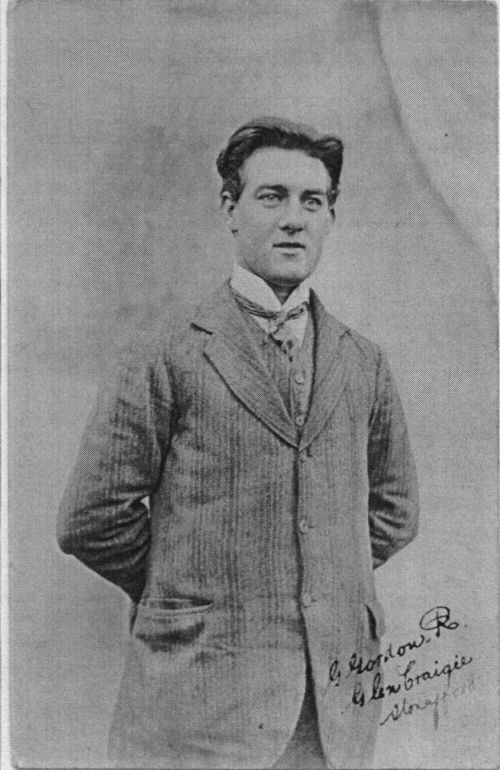
George Gordon Robertson >
A postcard was sent to Lottie with birthday wishes in June 1912.
In February 1930 George married Evelyn WADMORE (1893-1979). The two had known each other through the church in Geelong and George had sung at the funeral of Evie’s sister who had died from meningitis at the age of sixteen. “They lost touch but renewed friendships when they met on the train to Albury - she going to see her brother Will who had just been made manager of the Commonwealth Bank and he to work on the Hume weir. He offered to carry her case!” Marriage had to be put off until George had finished studying for the Ministry.
George’s ‘exit charge’ was the Presbyterian Church at Tylden in Victoria. Robert and Molly attended their son’s induction at Tylden, as did brother Rab and his wife Fanny.21 Rab was the Baptist minister at nearby Kyneton and the two families would visit each other. “A great friendship was built up between the two brothers and their wives.” George and Evie’s only child, Ailsa, was born at Kyneton in 1931. Evelyn was very sick after the birth and George’s sister Nan stayed with the family for at least a month to help out.
In 1933 the family moved to Traralgon where they “spent six happy years”. In 1939 George accepted a call to the Presbyterian Church in Bourke Rd, East Malvern. The move to Melbourne meant that Ailsa could attend the Presbyterian Ladies College.
Apart from his parish work George's special interest was as Convener of Chaplains for the Gaols and Hospitals. He was also a member of the Presbyterian Board of Education. “He was always in attendance at the Presbyterian Assembly held at the Assembly Hall in Collins St, where he met and mingled with as many colleagues as was possible.” Ailsa remembers coming from PLC East Melbourne on the Collins St tram to meeting him at the Thistle Tea Rooms’ next to the Assembly and being introduced “to all these wonderful people.”
George was forced to retire at the age of fifty-eight because of ill health. The family continued to live in Malvern. George “was clever with his hands and had many hobbies.” These included music, gardening (specializing in tulips, gladioli and dahlias) and making furniture from wood brought from the Gippsland forests. Ailsa and George enjoyed singing duets, “Ailsa playing his accompaniments as he and Arthur may have done years before.”
George died in 1954, Evelyn died in 1979. Ailsa pays the following tribute to her father: “He was a gentleman with a kind loving patient nature, who was inspired by the highest of moral principles for the betterment of mankind and with all this was the friend of everybody”.
page 116
Charlotte Spurgeon ROBERTSON (1893-1976) - married name DICKINS
 Third daughter and second youngest of Robert Robertson and Mary Jane Cairns’ nine children born at Geelong on 30 June 1893. She was named after the Baptist theologian Charles Haddon Spurgeon (1834-1892) and Lottie considered she was lucky not to have had the Haddon put onto her name as well.
Third daughter and second youngest of Robert Robertson and Mary Jane Cairns’ nine children born at Geelong on 30 June 1893. She was named after the Baptist theologian Charles Haddon Spurgeon (1834-1892) and Lottie considered she was lucky not to have had the Haddon put onto her name as well.
< Stuart and Lottie Robertson
Lottie gave the impression that her childhood was not particularly happy. By the time she was growing up, Robert had become an established evangelist and he was often away from home for long periods. During his absences Molly had to manage with her large family as best she could. Lottie was expected to be responsible for her younger epileptic brother Stuart and resented this. At the age of about nine she was sent to stay with her cousin Barbara Crouch at Woomelang in the Mallee, for two years. The reason given was that she had a weak chest and needed a dry climate.
Despite her intelligence Lottie’s schooling was limited and she left school at fourteen. She made up for this in later life by being a voracious reader of all kinds of books. When she was a semi invalid in her older years, her children would be sent up to the Kew Library to renew her books and it was always hard to find something she had not yet read. With her own children Lottie insisted they receive not only a good education, but were all trained for occupations with which to support themselves.

Lottie Robertson in her twenties >
After leaving school Lottie stayed at home and was expected to help her mother look after Stuart. Later she went to live with her Uncle Arthur Robertson at Port Campbell, to help care for her grandmother, the aging Margaret Rutherford Cairns Robertson. Lottie got on well with Grandma Rutherford, as she always called her, and felt closer to her than to her own mother. She told many stories about Grandma Rutherford and the handsome Geordie Cairns, who had been her grandmother’s first husband. She also told of Arthur coming home drunk and her being terrified he would set the house on fire as he reeled about carrying a candle. This gave Lottie a life long terror of house fires.
Lottie commenced studying at Art School in Geelong but her parents objected to her mixing with the male architecture students, and when she brought home a still life she had painted, of a cigar, cigar box and a beer bottle, her training as an artist was brought to an abrupt end.
A young man who was an atheist courted her. He had no objection to her religious participation and would walk her to church on a Sunday, wait for the service to be conducted, and then walk her home. Again parental disapproval interfered and the romance was ended.
page 117
In 1916 Lottie married Sidney DICKINS (1892-1964). Sid was the fifth child of Thomas Dickins and Henrietta Peake. Thomas Dickins’ family had a foundry and ironmongery business in Geelong. Sid and Lottie attended the same school, although they were one year apart in age. We know they were friendly as early as 1910, for there is an entry by Sid in Lottie’s autograph book, dated that year. Their marriage took place at Barwon House with Lottie’s brother Rab conducting the service. There are two photos of the wedding party, both family group photos with the bride’s parents as the central characters, rather than the bride and groom. These photos are reproduced at the beginning and end of this chapter. There were no photos of the bride and groom alone or with their attendants, as this, according to Lottie, was considered a form of vanity! Lottie wears a simple white suit.

Charlotte Spurgeon Robertson >
At the time of the marriage Sid was working in Sydney for the grocery firm of Moran and Cato, so the young couple moved there to live. It seems however the marriage was in trouble right from the start, as Lottie left Sid and came back home. Her father persuaded her to return to the marriage. Their first child arrived in 1923, with six others following. The last baby was stillborn towards the end of the 1930s. Of the surviving children, Mac (1923), Joy (1925), Neil (1927), Marie (1928) and Barbara (1931), were born when the family lived at King St, Geelong (now called Isabella St). Margaret (1934) was born at North Shore, Geelong.
On their return to Victoria, Sid and Lottie set up their own grocery business, starting off with the first shop in Geelong in 1920. Lottie told of making deliveries of groceries in a horse and cart, on Christmas Eve. The family’s own groceries largely consisted of rejects from the shops, such as bacon ends, broken biscuits and other damaged goods. As children we attended, and enjoyed, picnics, sporting matches and concerts run for and by Dickins store employees.
Sid was an astute businessman. One of his employees, an accountant, told me, ‘I never knew your father to throw away a piece of string’. In 1928 Sid and Lottie opened the first self-service store in Victoria, an innovative idea that caused conflict with the trade unions. During the Depression, bankruptcy was avoided by putting all the assets in Lottie’s name and the debts in Sid’s name. The creditors allowed Sid to continue trading and eventually he repaid all the money he owed. In appreciation his grateful creditors presented Sid with a Grandfather clock, and this is now in the custody of Richard Dickins. The firm of S E Dickins Pty Ltd merged with G J Coles & Co Ltd in 1958. By that time there were sixty-three Dickins self-service grocery stores around Victoria.
As well as helping in the early days of the business, Lottie was always involved in charitable activities and helping others. She would take in boys who had been kicked out of home and Sid would find them jobs in the business. Some of these men worked for S E Dickins all their lives. In 1937 when the business was again prospering, the family moved from Geelong to Melbourne. The big house at 281 Barker’s Rd, Kew, with its tennis court and large garden, was always full
page 118
of people. People of many races and from a whole variety of backgrounds. At one stage Lottie provided a halfway house for people exiting the Kew mental hospital (where Lottie served on the auxiliary). During World War II she provided a home to some Jewish refugees, and scores of servicemen and women, foreign and Australian, came to the house for ‘rest and relaxation’. There was always lots of debate and discussion, musical afternoons, book society meetings, dances, tennis parties, social activities and people staying over. Politics, religion, social welfare, history, films, plays and books, were all topics for discussion, and activities the family were encouraged to participate in.
A strong feminist, Lottie supported women’s causes, using a female doctor for her confinements, and a female solicitor. Despite being a member of the Liberal Party in Bob Menzies electorate, it was fairly obvious that if a woman was standing, Lottie voted for the woman, no matter what party she belonged to. At home, tasks were allotted according to age, ability and skill, rather than sex. The girls were never expected to wait on the boys.
Lottie had a fine contralto voice and had attended singing classes for a short time as a young woman. Throughout her life she sang at social and charitable functions and entertained her children with piano-accompanied monologues. Joy writes, “When we attended church, Mother’s voice would ring out loud and clear, singing in harmony. In my extreme youth I often wished she didn’t have such a loud voice which could be heard all over the church. However as I grew older and learnt to appreciate the quality of her voice, I judged all other singers in relation to hers and most are found wanting.” No matter how hard things were financially (and money was extremely limited after the Sid and Lottie were divorced) money was always found for musical activities - music lessons, musical shows, films and concerts.
Lottie and Sid’s marriage, which had always been shaky, deteriorated further after the stillbirth of their last child. In 1941 Lottie applied for a judicial separation but this was not successful. Then in 1944, Sid applied for and obtained a divorce. The next year Sid married Lottie’s niece, Mary Robertson, the daughter of her brother Rab.
Lottie was a natural mentor and people would come to her with their troubles. She would listen to them, empathize, and if they asked for it, give them advice. Sid visited and continued discussing his business affairs with Lottie, as well as taking an interest in the children, however after the divorce, he never interfered in Lottie’s management of the children. Even when she was bed-ridden in old age, Lottie’s doctor often made her the last visit of the day so that he could sit on the end of her bed and tell her about his growing family.

< Lottie in her older years
Like so many of her kinswomen, Lottie always had handicraft projects in progress.
Lottie was a great one for short pithy sayings, little packages of wisdom, and standard instructions her children could anticipate before they were even uttered. Some became family jokes, others were dreaded, and those of us who have children of our own find ourselves using the same sayings our mother used. Things such as the terrible threat of, ‘I’ll see your nose above your chin’, [took me years to work out that that is where my nose is anyway], or ‘Fools and children should not see things half done’. There are far too many of these sayings to record here.
Perhaps the saddest thing about Lottie’s life was the separation from sections of the Robertson family caused by Sid’s marriage to her brother’s daughter. She could not forgive the disloyalty of some of her siblings, and after the divorce Lottie and her children had little to do with the Dickins family and some sections of the Robertson family.
Lottie had her first heart attack at the age of forty-nine, around the time of the divorce. I was eavesdropping and overheard the doctor tell her in an admiring manner, ‘You stupid woman, you should be dead, but you are not going to die are you’. I felt very proud of her, for I knew she was determined to stay alive and look after us kids. As per the treatment of the day Lottie was ordered complete bed rest, but refused to go to hospital. A district nurse came in regularly and a series of women came in to do the weekly wash. Mac was away at the war and Joy, who was eighteen, took over most of the responsibility for organizing the house and the younger children. Jobs were shared out among us. Heart trouble (angina) plagued Lottie on and off,
page 119
until her death in 1976. She was cremated and her ashes placed near those of her daughter Barbara, at the Springvale crematorium. Recently her ashes were retrieved and her children are planning to re-inter them in the Robertson family grave at Port Campbell.
 Stuart Rutherford ROBERTSON (1898-1964)
Stuart Rutherford ROBERTSON (1898-1964)
Youngest child of Robert Robertson and Mary Jane Cairns, born at Geelong on 27 May 1898.
Stuart was epileptic. If he had been born a couple of generations later, Stuart’s epilepsy would have probably been controlled by medication and he could have lived a normal life. As it was, he spent his life being treated as an invalid. He lived with his parents until they died, then shared the family home at Belmont with his sister Nan until she died in 1958.
Stuart’s nephew, also called Stuart (Rab’s son), relates experiencing one of Stuart’s grand mal attacks when Stuart junior was about four years old. The two had been to an art show at the Geelong Town Hall. On leaving Stuart fell down on the footpath in a convulsion and the younger Stuart did not know what to do. Fortunately some passers-by came to the rescue.22
Lottie tells of having to be responsible for her younger brother when they were children. A delightful tale comes from Margaret Haine of Stuart responding to some action of Lottie’s by saying, ‘Remember Lottie, God gave me teeth and nails. They are sharp and I can use them’.23

Nan and Stuart smelling the roses at Peary St, Belmont, Geelong in the 1950s >
I have been told that when Nan died Stuart exclaimed ‘I’m free, I’m free. All this is mine.’ This suggests some resentment about the life he had been forced to live and the controlling influence of his family. Apparently however, Stuart was not specifically mentioned in Nan’s will, which was a sad lack of acknowledgment of the long period they had lived together and shared each others lives. Pixie Robertson believes the family effects were shared out amongst the family or disposed of by Josh and Rab’s daughter, Mary.24 Stuart’s life ended six years later in the Mont Park Home for the Aged.
page 120

Robert Robertson Extended Family
Taken at Barwon House at the time of Lottie Robertson’s wedding to Sid Dickins on 4 January 1916.
Left to right, back row: Arthur, Sid Dickins, George, Fanny (wife of Rab), Josh and wife Josephine, Stuart, Glady. Seated: Maggie, Clare (wife of Arthur) holding son Ian, Lottie, Rab, Robert, Molly, Nan, Alice (wife of Glady) holding son Locky, Arthur (brother of Robert).
Front: Rutherford (son of Josh), Stuart (son of Rab), Rad (son of Glady), Mary (daughter of Rab)
1 Interview with Margaret Haine, July 2002
2 Interview with Stuart Robertson, March 2000
3 Interview with Richard Dickins, March 2000
4 Interview with Stuart Robertson, March 2000
5 Interview with Margaret Haine. November 2000
6 Interview with Richard Dickins, March 2000
7 His birth year was thought to be 1881 but the Victorian records give it as 1880, file number 10848.
8 Information about Josh comes from his son Rutherford and Baptists in Victoria - Our First Century’, as well as other family members mentioned.
9 Interview with R.N Robertson, March, 2000
10 Paper cutting, unidentified newspaper, 2.5.1937
11 Interview with Richard Dickins, March 2000
12 The following is compiled from information and documents supplied by Arthur’s children, Pixie and Rod Robertson, and Rod’s wife Lucy, with incidental information from other family members.
13 Interview with Rutherford Robertson, March 2000
14 Letter form Rod Robertson, 25.10.2002
15 Interview with M. Mathieson, March 2000
16 I understand the original letter, and the ones from Butler and Iredale, are in the custody of Glady’s grandson Bill Robertson, along with the citation for the Military Medal.
17 Letter from Bobbie Chapman, June 2001
18 Interview with Stuart Robertson, March 2000
19 The paper cutting was provided by R and L Robertson
20 This and the following quotations are taken from a letter from Ailsa McLennan, June(?) 2001
21 The Kyneton Guardian, 28.3.1931
22 Interview with Stuart Robertson, March 2000
23 Interview with Margaret Haine, November 2000
24 Interview with Pixie Robertson, March 2000
page 121
Margaret Catherine ROBERTSON (1890-1949) - married name HORMAN
Eldest child of William Adie Robertson and Jane Mathieson, born at Port Campbell on 27 August 1890. Margaret was named after her two grandmothers.
 Margaret Robertson in her teens ... in her twenties
Margaret Robertson in her teens ... in her twenties 
The family moved to Beulah in 1892 and Margaret’s father died there when Margaret was eleven years old. Jane continued on the farm and Margaret and her sisters helped with the milking and other chores.
After leaving school, Margaret worked for Cust and Sons Pty Ltd, General Merchants in Beulah. She commenced in the drapery department but later moved into the office where she did clerical work. “She studied and became an accountant, then reached the position of Secretary to the company and was in charge of the office from 1918 to 1926.
She was most efficient and had exceptional ability, as stated by J W Cust Managing Director in his reference.” 1 When the family farm was sold in 1926, Margaret and her mother moved to Melbourne.
On 5 May 1927 Margaret married William Joseph HORMAN (1894-1963) at the Armadale Baptist Church. The Rev Dr Boreham conducted the service. Margaret’s sister Adie was married in the same church the following year. William Horman was the eldest son of William Ellis Horman and Mary Cobbe. He served in the AIF at Gallipoli and in France during World War I, rising to the rank of Sergeant. He was wounded in action and received a Military Medal for ‘bravery in the field’. 2 After their marriage Margaret and Bill lived at Dimboola, where William was the manager of Williams the Shoemen’s store. The couple had two children, Beryl (1928), and William (1932).
Margaret’s mother, Jane, lived with the family at Dimboola. “Grandma would take Beryl with her to the morning service at the Presbyterian Church; and in the evening Grandma would mind the children while Margaret and William attended the Methodist Church service”. In 1936 the family moved to Hartwell in Melbourne, then to Canterbury. They attended the East Camberwell Baptist Church.
page 122
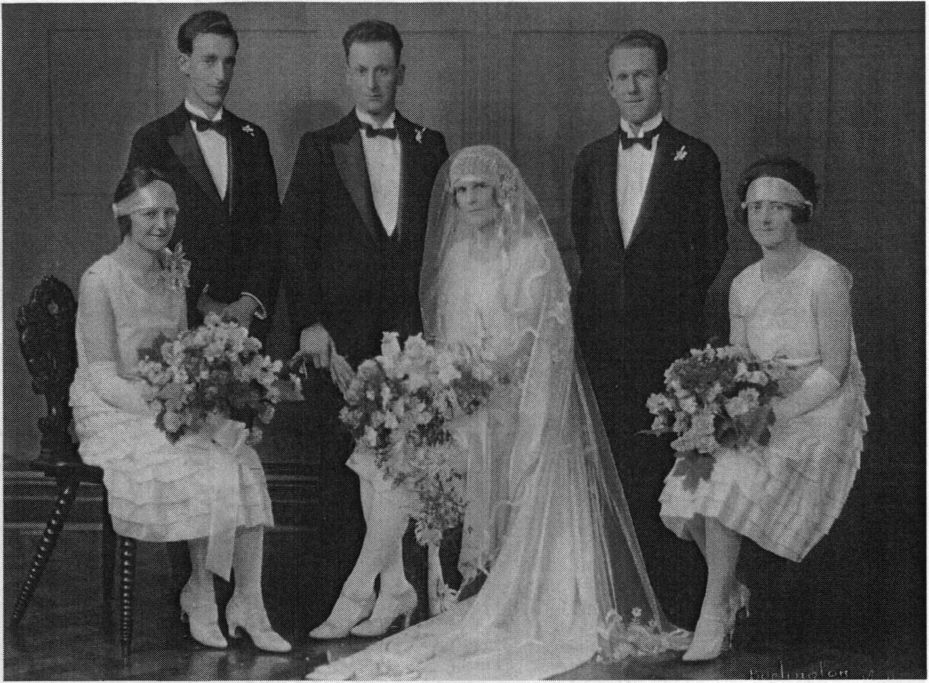
Margaret Robertson and William Horman
On their Wedding Day in 1927. The bridesmaid on the left is Margaret's sister Adie.
Margaret was very involved in church activities. She was President of the Ladies Guild and later President of the Eastern Suburbs Fellowship. She was a good public speaker and the author has been given a copy of an address written by Margaret Horman entitled ‘Shall We Worry’, based on texts from the Bible. Margaret belonged to the Country Women’s Association and during the Second World War she was a member of the Comforts Fund. She played the piano and sang with a lovely contralto voice. One of Beryl’s earliest memories is of her mother sitting at the piano, playing and singing to her.
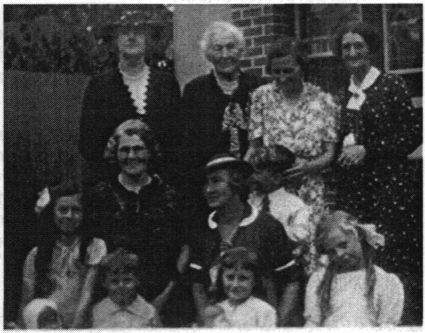
Horman family gathering
Margaret wearing glasses is in the centre. Her mother Jane is the white haired women at the back and daughter Beryl is at the right of the front row.
Later Margaret and Beryl played and sang duets together. Margaret wrote poetry and was a fine needlewoman. She was also a gifted artist, working in oils and charcoal and Beryl has some of her paintings.
When the family moved to Melbourne, William took up a position as executive inspector with Williams the Shoemen, going to the firm’s fifty-two stores checking shops, stock and books. William worked for Williams the Shoemen for fifty-five years and was still in their employ when he died after a heart attack in 1963. 4 His father had also worked for Williams the Shoemen for fifty years, “a unique family record in any firm.” Beryl describes her father as a strong man in both physique and character, with high moral values - things were black or white, good or bad. “He had a great sense of humour just like our mother.” 5
page 123
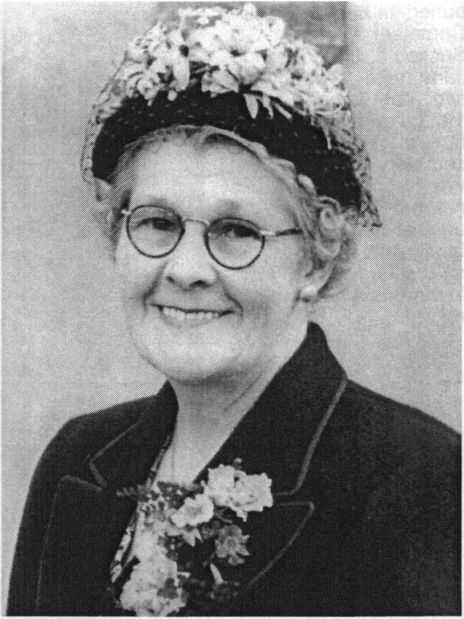 Margaret predeceased her husband, dying suddenly from a cerebral haemorrhage at the age of fifty-nine. She had outlived her mother by only ten months. The family were devastated by her unexpected death. Like her mother Margaret was cremated and her ashes placed in the family grave at Beulah.
Margaret predeceased her husband, dying suddenly from a cerebral haemorrhage at the age of fifty-nine. She had outlived her mother by only ten months. The family were devastated by her unexpected death. Like her mother Margaret was cremated and her ashes placed in the family grave at Beulah.
Margaret Robertson Horman, August 1949 >
Flora Jane ROBERTSON (1892-1922) and Ruby Barbara ROBERTSON (1894-1920)
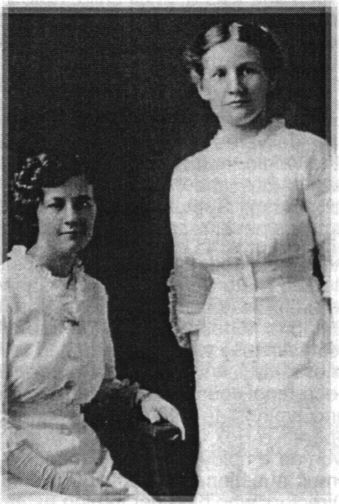
Flora and Ruby Robertson
I have put these sisters together as there seems to be some confusion about their lives and deaths and I have had contradictory accounts. They were the second and third children of William Adie Robertson and Jane Mathieson. Flora Jane was born either at Port Campbell or Beulah in 1892. Ruby Barbara was born at Beulah in 1894. The name Flora came from Jane’s sister, and Barbara from William’s sister.
Flora had typhoid fever when she was in her teens and all her hair fell out. When it grew back, her hair was a mass of tight curls.
Ruby was engaged to an Alan Whitney. Alan suffered from tuberculosis and because of his illness, he lived in a tent in the Robertson’s back yard at Beulah (fresh air and sunshine were part of the treatment for TB at the time).
“Ruby was very caring in nature and as she did the cooking for the household [she] would have tended Alan in his illness”. 5 Alan died before the couple could marry but he had passed his illness on to Ruby. In the process of nursing Ruby, Flora also contracted TB.
page 124
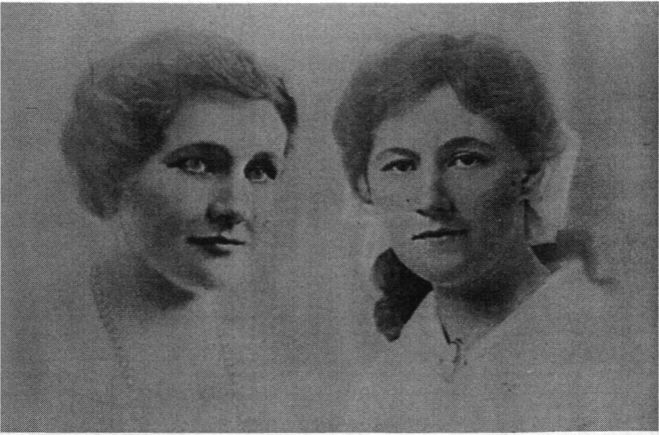 Flora and Ruby Robertson >
Flora and Ruby Robertson >
In an effort to combat the illness, Jane took the two girls to Queensland. Ruby died on 27 October 1920 and is buried in the Bald Hills Cemetery - Portion GD, Section 5, Lot 85. 6 Flora Jane died at Sandgate two years later, 2 August 1922, and is probably buried in the same cemetery as her sister. What appears to be a lot number - 265 - recorded against her name in the family bible, does not correspond with anything in the Brisbane Cemetery records.
Adie Agnes ROBERTSON (1899-1984) - married name TUNKS
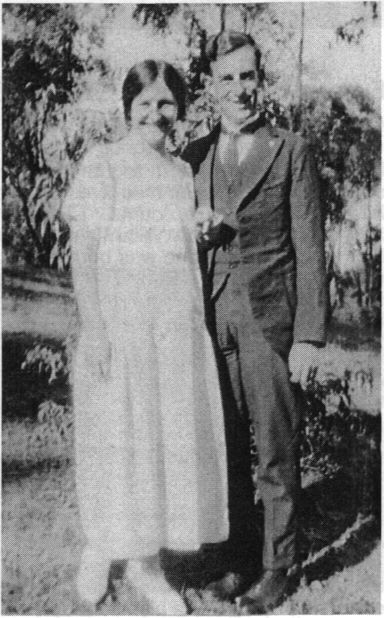
Adie Robertson and Roy Tunks on the occasion of their engagement
The youngest of William Adie Robertson and Jane Mathieson’s four daughters, born at Beulah on 8 December 1899. Adie’s names came from her father and his sister Agnes. Adie had no memory of her father as he died when she was twenty-one months old.
When she was a small child, Adie’s nightdress caught fire as she was standing in front of the wood fire after her Saturday night bath. Jack McCue, who was staying with the family at the time, grabbed her and rolled her in the floor rug, saving her life.
Like her sisters Adie helped on the farm. Before school she delivered milk around the town on horseback.
She would then take the cows to the paddock for the day. After school, the cows had to be brought home for milking. Sometimes Adie would fall asleep in class but was never reprimanded by the teacher.
Adie obtained her Merit Certificate in 1914 at the Beulah State School. In 1919 she went to Melbourne where she boarded with a Mrs Whitney in North Carlton. Whether this is the same Whitney family as Alan Whitney who was engaged to Adie’s sister is not known, but it does seem probable. Undertaking a secretarial course Adie became proficient in shorthand and typing. In 1920 she began working for the Cooperative Box Company at Yarraville. “Being the first woman employee of the Company, her ability was at times questioned by outside clients, but never by the Directors who held her in high esteem as evidenced by
page 125
their appreciation of her services and testimonial when retiring prior to her marriage.” 7
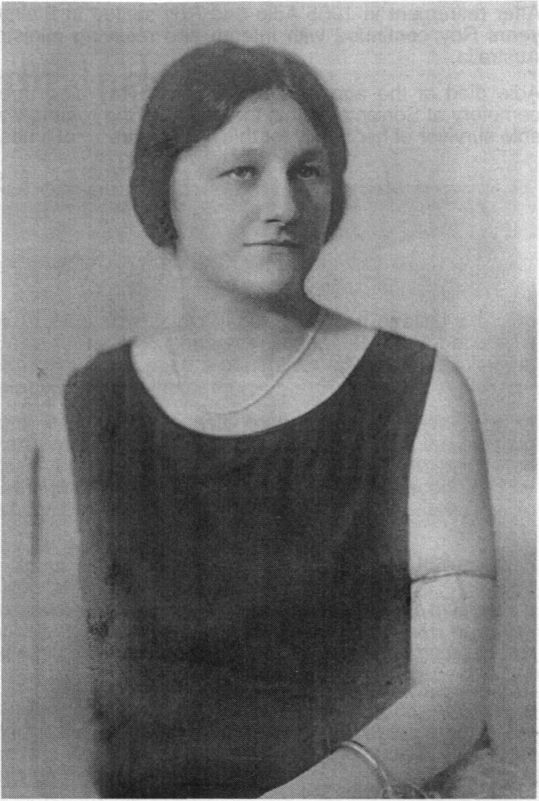 Adie spent some time in Brisbane when her mother took Ruby and Flora north for their health and Adie was at Sandgate when Flora Jane died there in 1922.
Adie spent some time in Brisbane when her mother took Ruby and Flora north for their health and Adie was at Sandgate when Flora Jane died there in 1922.
Adie Tunks >
Adie married Henry Roy TUNKS (1899-1987) at the Armadale Baptist Church on 12 January 1928. Adie remembered it as a very hot day with a temperature of 110°F at nine o’clock in the evening (approximately 43.5°C).
The couple had four children, Maurine (1928), Cynthia (1930), Spenser (1933) and Jocelyn (1941).
Roy Tunks had completed his training as a Baptist minister in 1927. He served at the Baptist Church in Sydney Rd, Coburg for eight years and also conducted services at Merlynston. 8 In 1936 Roy represented the Victorian Baptist Union at a Toe H Conference in London and enjoyed the experience of preaching in well-known churches there. While he was away, Adie and the three older children, along with Roy’s mother, lived at Sassafras in the Dandenong Ranges. It was the middle of the Depression and times were hard. “Though it was a difficult time financially, we all enjoyed such happy times walking and exploring Sherbrooke Forest with its huge towering eucalypts and myriad birds and always searching for the lyrebirds.
We walked to school so often when the clouds were drifting with us - they were happy childhood days.” Beryl Horman remembers being sent on the train to visit her aunt and cousins in Sassafras with two cases, a small one containing her clothes and a large one packed with food. 9
Returning from England Roy resigned from the Baptist Church, joined the Anglican Church and became an Anglican minister after undertaking two years training. In 1939 the family moved to Moorabbin where Roy was given charge of St David’s Anglican Church. He ministered there for twenty-six years. After World War II the area developed rapidly and “was no longer a sleepy small suburb halfway to Frankston”. Roy oversaw the building of a new brick church and this was dedicated in 1956.
Maurine writes about her mother, “Mum cared for us all with patience and understanding and always support for Dad in the activities of the Parish. She was loved by all and is remembered kindly.” Adie loved Scottish songs and the skirl of the bagpipes. She sang with the Church choir and was a member of the Royal Melbourne Philharmonic Choir which performed the ‘Messiah’ in the Melbourne Town Hall each Christmas.
Adie “loved riding and outdoor life, and always felt at home with cows and calves. When she was eighty years old she was delighted to ride in a 4WD to see the Angus herd on a friend’s farm in Tasmania.”
page 126
After retirement in 1965 Adie and Roy settled in Blairgowrie near Sorrento. Over the next ten years Roy continued with interim and relieving ministries in Victoria, Tasmania and Western Australia.
Adie died at the age of eighty-five and Roy died three years later. They are buried in the cemetery at Sorrento “within the sound of the roaring waves of Bass Strait - Mum had been the sole survivor of her family for thirty-five years ... at times she felt its loneliness.”
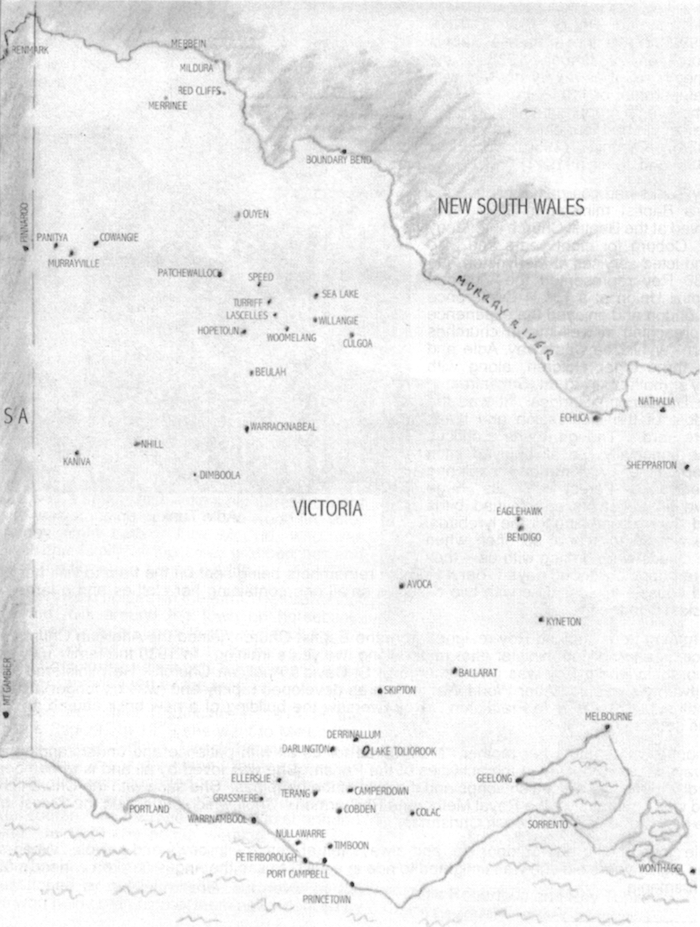
Map of relevant towns in Victoria, South Australia and New South Wales
1 Information about Margaret’s life was supplied by her daughter Beryl Oakes in letters and an interview, April 2000. This and other quotes are taken from letters.
2 William's Army record
3 This would include the period William spent in the AIF from 1915 to 1919.
4 Interview with B. Oakes, April, 2000
5 M Tunks, 17.9 2001
6 This information obtained from the Brisbane Cemetery Records in November 2000. They were unable to locate a record of Flora’s burial but this does not exclude her burial at Bald Hills or Redcliffe, which are the nearest cemeteries to Sandgate. There is no cemetery at Sandgate.
7 Most of the information about Adie comes from her daughter Maurine Port and this and other quotes are taken from her letter, 17.9.2001
8 F.J. Wilkin, ‘Baptists in Victoria’
9 Interview with B Horman, April 2000
page 127
The story of the Robertson family would not be complete without a section dealing with the influence of alcohol on individual lives. While for most Robertson descendants it has become a case of ‘alcohol - take it or leave it’, for others it has been a controlling influence, resulting in alcoholism at one extreme and crusading abstinence at the other.
As related in earlier sections, anecdotal evidence suggests that the first generations of Robertsons in Australia were great drinkers; with references to the use of whisky, the brewing and sale of cider and plum wine, and youthful irresponsibility that may have been exacerbated by the use of alcohol. As early as 1863 the prevalence of a sly grog trade was recognized by the newly formed Hampden and Heytesbury Council when it moved to employ a detective to prosecute sly grog sellers.1
Lottie Dickins claimed her father never drank because it made him ill and her Uncles Willie and Jim and their sisters gave up drinking after the religious revival of the 1870s. In 1881 Mr F. Harrison visited Port Campbell and gave a lecture on total abstinence. Later that year a liquor license was granted for Port Campbell: "... possibly a licensed public house will have the effect of doing away with sly grog selling which we have been informed has been going on for years in the district”.2
The Camperdown Chronicle reported a meeting at Port Campbell in August 1886, at which a committee was formed to ‘dethrone King Alcohol’. Mr W Robertson was appointed secretary of the new committee. “At the conclusion of a very successful meeting in the church, a number took the pledge and donned the badge of blue.”3
Lottie excluded Arthur Jnr from the list of those who gave up alcohol. She has not been the only one to report his continued drinking. Apparently Arthur was sometimes so drunk he had to be pushed up into the pulpit to preach. Once there he proclaimed the Lord’s word with passion.4 Agnes’ husband Michael McCue was fond of whisky and continued drinking throughout his life. And as a child, Jack McCue would be given a drop of whisky to put him to sleep.
Excessive drinking was not just a Robertson vice, Alan Ribbons tells of his paternal grandfather’s drunkenness and how as a child, he would have to help his mother deal with grandpa when his father was absent from home. Alan has a sign beside his front door declaring his house an ‘alcohol free zone’.
As related in the potted biographies, a number of family members drank heavily. It seems probable that one of the factors influencing James Need Robertson’s decision to give up his ministerial ambitions was a fondness for alcohol. He was certainly a heavy drinker in the memory of his grandchildren, although they believe this was mostly a social activity. There is a saying in that section of the family along the lines of: 'The family bought many bricks in the Peninsula Hotel at Maylands.’ James Need’s son Norman most definitely had a problem and lost his driving licence for life after a number of drink driving charges. By contrast, the influence of alcohol in that family had the opposite effect on their sister Adie and she was strongly teetotal all her life.
Adie illustrates the other side of the coin - a great abhorrence and life-long avoidance of alcohol. Some family members became very involved in the temperance movement of the first half of 20th century. Jack Robertson McCue’s involvement in the Anti-Liquor League, the Local Option Alliance and the Victorian Temperance Alliance is well recorded. One newspaper described him as “Victoria’s most famous wowser”.5 I don’t think it is a term Jack would have objected to. Jack was active in the various referenda and local option campaigns. At one time it was possible in Victoria for local districts to vote on whether a hotel license should be granted or whether their area should be alcohol free. Jack was able to claim success in many instances. In 1920 four hotel bars in Castlemaine were closed down. In the 1930 referendum, which offered a straight vote for or against licensing, 43% of Victorians voted for abolition. By 1938 the vote for prohibition dropped to 34%.6
In a letter to the Melbourne Sun in March 1953, Jack pointed out that “in 1907 Victoria had 3507 hotel licenses - today, with twice the population, she has less than half - about 1666, due largely to Victoria’s strong temperance sentiment.”7 Dry areas and local options were abolished in 1953 when a State Licensing Authority was set up in Victoria.
George Cairns told me that when Jack was on one of his anti-alcohol campaigns his brother Arthur would joke, ‘Jack’s on the beer again!’8
Others involved in temperance work were Nan Robertson, who worked with the Women’s Temperance Union in Victoria and WA, and Henry Saunders, who was secretary of the Temperance Union in Queensland.
As a child I heard tales of how alcohol turns your brain black and the first drink leads you on the road to ruin. None of this was taken too seriously. We had relations who refused to eat Christmas cake if it had alcohol in it, and pointing out that the alcohol evaporated with the cooking made no difference to them. The only alcohol in my mother’s house before World War II was strictly for medicinal purposes. When my brother Mac came back from the army at the end of the war Mum eased the rule about no alcohol in the house, deciding it was better for Mac to bring alcohol and his friends home, than to go drinking with his ex-army mates in hotels. I am sure she never breathed a word of this to Auntie Tot (Jack McCue’s wife) who was her friend. I’m glad to say none of us turned into alcoholics!
Among Robertson descendants as a group I have found a strong ambivalence about alcohol. Some individuals and sections of the family practice total abstinence. Others are accepting of alcohol on the basis that moderation is the key to safe alcoholic usage. And there are a few who have admitted to me their difficulties with the overuse of alcohol.
1 J. Fletcher, The Infiltrators’, p.9
2 Ibid, p.252. It is not clear from the way Fletcher presents this whether it was the magistrate granting the license or the applicant's solicitor who made this statement.
3 Taken from notes made by J. Fletcher, which are in the custody of the Port Campbell Museum
4 From Marjorie Mathieson and Marion Parker
5 The Melbourne Herald, 7.5.1972
6 Newspaper article by Geoffrey Tebbutt in the Melbourne Herald, 14.1.1956
7 The date of publication is not recorded on the copy of this letter that I have, but Jack’s letter is in response to one from Howard Palmer published on 13.3.1953
8 Interview with George Cairns, April 2000
page 129
Introduction
The following chapters deal with the great grandchildren and great great grandchildren of Margaret Henderson and Arthur Robertson - generations ‘D’ and ‘E’ on the charts. Again I have divided the potted biographies according to the individual's descent from Agnes, James, Arthur Jnr, Margaret Jnr, Robert or William Adie.
Over the years the family has spread out and contacts have weakened or been lost. This has made it harder for me to collect information about people and understandably there are some who have little interest in their now distant Robertson connection. The result is a patchwork of stories and biographies and there are many gaps.
Twenty years separated the birth of Margaret Henderson’s eldest and youngest children, Agnes was born in 1838 and William Adie in 1858. With the next generation (‘C’), thirty years separates the eldest and youngest members. James Robertson’s first child John George Halls Robertson was born in 1869 and William Adie’s youngest daughter Adie Agnes Robertson in 1899. Gradually the spread of the generations has widened and by the time we get to generation ‘D’, there is a space of forty-two years between the first and last born, Samuel Arthur Crouch in 1899 and Jocelyn Christina Tunks in 1941. The first member of generation ‘E’ is Agnes’ great grand daughter Betty Ribbons, who was born in 1924. The overlapping of generations means we have people in one generation who are contemporaries of people in the next generation. For this reason I have included generations ‘D’ and ‘E’ in each of Chapters 21 and 22. Chapters 23, 24, 25 and 26 only contain generation ‘D’.

Turriff store where several Robertson relations worked
Listening to the stories people have told me it seems the lives of this section of the Robertson family was centred around Turriff in the Victorian Mallee during the 1930s and 40s. There isn’t much there now. A town you pass through barely noticing its existence. Once it was a thriving community with post office, store, school and churches. At Turriff, people were able to get work and Gertie Grace was able to undertake the tuition she needed to gain her diploma from the London College of Music.
page 130
As married women the McCue sisters Barbara, Bean and Aggie, all lived at Turriff. Barbara and Bean had houses next to each other and Aggie lived across the road. Ken Crouch tells us they were referred to as ‘The Big Three’.
This description of a typical concert at Turriff comes from Alan Ribbons:
“Aggie Mott would sing ‘My Grandfather’s Clock’. Rheita Mott played her autoharp and sang ‘I Threw a Kiss in the Ocean’. Rheita and Gertie would play a piano duet, and Ruth and Dorothy Grace sang ‘Don’t Fence Me In’. Beverley Grace sang ‘Bimbo bimbo’. Betty and Nancy Ribbons would dance an Irish jig. George Le Couteur always sang The Old Rugged Cross’ and his wife Arvon, sang ‘Mother McCree’. The items would vary from concert to concert, except that George could always be relied on to sing ‘The Old Rugged Cross’. Money raised from the concerts went to the hospital at Ouyen.” 1

Turriff Memorial Hall
The harsh climatic conditions made farming difficult. Drought and dust storms are recurring themes in the stories I have been told about life in the Mallee. Alan Ribbons describes how his father, who worked for the railways, would have to get up at night, phone the gangers and go out to shovel sand off the railway line so the train from Melbourne could get through to Mildura. Sand chutes were used to try and deflect the sand. Posts were placed in the ground to support sheets of iron that were supposed to ‘shoot’ the sand over the line. 2
Rabbits were a constant problem for farmers but at least they provided food and additional income during the Depression. This ‘Rabbit Poem’ comes from Alan Ribbons. 3The author is unknown.
There were rabbits hot and there were rabbits cold
There were rabbits young and there were rabbits old
There were fat rabbits and there were lean rabbits
There were dirty rabbits and there were clean rabbits
There were big rabbits and there were small rabbits
There were short rabbits and there were tall rabbits
There were black rabbits and there were white rabbits
Rabbits for breakfast rabbits for tea
Rabbits stewed and rabbit roast
Rabbits in gravy and rabbits on toast
Rabbits by the dozen rabbits by the score
Rabbits by the hundreds and still more and more
Rabbit’s tender rabbits tough
When the minister was asked to say grace he said
Lord spare me from rabbits I’ve had more than enough
Another rabbit story comes from Bessie Crouch:
“Dad [her husband Willie Crouch] used to trap rabbits and we had ferrets too. We often went round the traps at night with the lantern and if there were rabbits in them, Dad would reset them and he often got two in a trap for the night. When we had a good number of skins, we would take them into Terang and sell them. If they were a good price we would have a decent meal but if the price was low we had a pie, which were 3d [pence] or 3 cents. 4
page 131
“Ribbons had bought a place about a mile or so from us and we used to have some good fun together. One day Auntie Ellie came over and as Dad was sick she and I decided we would take the ferrets in a box and go rabbiting. We caught sixteen rabbits but we weren’t game to kill them so we carried them home alive in a bag. They were grunting like little pigs on the way and we could hardly walk for laughing.”
Generation D
Samuel Arthur CROUCH (1899-1985)
Eldest child of Barbara McCue and Edwin Crouch, born at Berriwillock on 26 January 1899. Known as Arthur. 5
Arthur trained as a Church of Christ minister at the ‘College of the Bible’ in Melbourne. Part of his training involved preaching in various local churches and this is how he met his future wife, Florence SCHULZ (1911-1982). Florence was the organist at the Bayswater church. The young couple fell in love, but there were two reasons for putting their marriage on hold. Firstly, Florence did not wish to marry until she was twenty-one, and secondly Arthur had dreams of preaching in the United States of America.
Arthur sailed to America (1930?) to attend an International Convention of Churches of Christ in Washington DC. 6 At the convention he met a friend from the Bible College who was already established in the USA and he had connections with churches in Missouri. As a result Arthur became a circuit preacher for five of these churches. Once he was established in Missouri, Arthur sent Florence an engagement ring and the fare for the trip to America. She sailed on the ‘Mariposa’ leaving Australia on 14 October 1933. Arthur met her on her arrival in Los Angeles and after the legal wait of three days for a license they were married at the Church of Christ Tabernacle in Los Angeles on 7 November 1933, surrounded by a new group of Christian friends. The young couple then travelled to Missouri by bus. Their only child, Barbara Ruth, was born in 1935.
Arthur and Florence moved to Weston, not far from Kansas city. However the cold weather was not good for Florence, so they moved on to Apache in Oklahoma where they served for sixteen years. Other ministries include Brownville and El Compo in Texas, Marlow in Oklahoma, Sulphur in Louisiana and lastly in Allerton, Illinois.
Barbara Ruth relates the following story:
“One morning when we were living in El Campo, [when] I was about twelve years of age, a couple came to my Dad’s office and asked to be married. They did not want to be married in the church, but wanted a minister to marry them. All their papers were in order, so Dad agreed, told them to come back to the house in an hour, and he would perform the ceremony. He walked over to the house and told Mother what had happened. At that time, renovations were being made on the bathroom in the house, and among all the tools and materials, the commode was sitting in front of the sofa. Mother expressed her surprise at the news, began to laugh, and said, ‘Well, we’d better get busy and put this place in order.’
So we set aside the materials and put a ‘throw’ over the commode, she took some flowers from the bushes outside the house, and the house was clean and beautiful for the bride and bridegroom who never had an inkling of what had taken place.” 7
The community at Allerton made it possible for Arthur and Florence to visit Australia, where there was a reunion with Arthur’s mother and other family members. On their return to America the couple retired to Apache. Florence died there in 1982. For a time in 1984, Arthur lived with his daughter and her husband Martin Lies, in New York but finally decided to move to a Christian Retirement Centre in Jacksonville, Florida. Barbara and Martin were with him when he died there on New Year’s eve 1985. Arthur and Florence are both buried at Apache.
page 132
Elizabeth Ellen CROUCH (1901-1999) - married name RIBBONS
Second child and eldest daughter of Barbara McCue and Edwin Crouch, born on 1 March 1901 at Brim, Victoria. Known as Ellie.
Ellie married John Adrian RIBBONS (1894-1978) at Cowangie Methodist Church on 2 April 1922. The ceremony was performed by the Rev R Reid. Jack was the son of William Charles Ribbons and Esther Isobel Ryles of Pinnaroo, SA. Ellie and Jack had three children, Betty (1924), Nancy (1926) and Alan (1927).
Jack was a returned serviceman from the First World War. He bought a farm at Panitya after he came back from the war, but sold this and moved to Karawinna near Mildura. Alan Ribbons describes life there: “No rain, dust, dust and more dust, and [we] had to ride the pony home from school, the pony could see but not us. Three on the one pony, and when we got home Mum would have the kero lamps, also some candles on the table to see. Mum would also put old blankets on the window [to] keep the dust out - more like sand, then use the garden shovel to get the sand out of the kitchen again.” 8
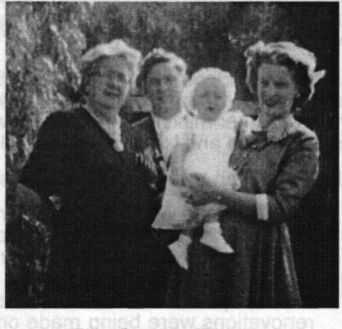
Ellie Crouch Ribbons With Alan, Nancy & Nancy’s daughter Rhonda 1949.
The family moved to a dairy farm at Laang, but there was no money so Jack worked on road building programs using his horses Doll, Ruby and Brownie. He made a living for the family but nothing extra, so the farm was sold and they moved back to dust and drought at Yarto East and another unsuccessful farming project. After this the family moved to Turriff where Jack worked on the railway line as a ganger and Ellie worked in the office ordering wheat trucks. Alan remembers Grandfather Ribbons staying with them when he was about twelve years old. Grandfather was an alcoholic and used to get the DTs. When his father was working away from home Alan would have to help his mother Ellie cope with Grandpa. As a result of this experience with his grandfather, Alan has never drunk alcohol. 9 Betty writes about her Ribbon’s grandfather, ”1 found him a gentle, kindly old fellow ... he was muchly appreciative of what we did for him later, when he was ‘dried out’ as it were.” 10
At Turriff Ellie’s parents and other members of her family lived close by. Ellie took in two boarders and accommodated the church ministers when they came around on circuit. She played the organ in the Baptist, Methodist and Anglican Churches. Betty tells us that despite the difficulties of life, the good times outweighed the unpleasant ones. She recalls gatherings at her Crouch grandparents’ house after church on a Sunday, for the evening meal. All the Aunts and Uncles would be there, “After we’d eaten we would gather around the old organ and sing the old hymns, and we all had a great time together.” 11
After the death of Edwin Crouch, Alan (who had moved to Sea Lake for work) and Jack shared the cost of buying Barbara Crouch’s house in Turriff and moving it to Sea Lake. Barbara lived there with Ellie and Jack (also Alan until he moved to Melbourne for work). Later Ellie and Jack lived in Geelong, where Jack died in 1978. Ellie then moved into a retirement village. She died just short of her ninety-eighth birthday.
Willie Robertson CROUCH (1903-1982) and Stephen CROUCH
Twin sons of Barbara McCue and Edwin Crouch born at Woomelang on 5 November 1903. Stephen died the same day he was born and is buried beside his father's sister, Ida Crouch, at Berriwillock, Vic. Willie was known as both Willie and Bill.
page 133
Willie had a struggling farm at Merrinee, “800 acres and had cleared 600 acres of it with an axe. The land had been opened up by the Closer Settlement Board who put houses on the places and provided some machinery and horses to work them after it was cleared. However the years were mostly dry then and it was hard to make a living.” 12 Willie also did butchering, delivering the meat to neighbours in a cart. In 1934 the Board reclaimed most of the farms, paying compensation. Willie received £60 for the eight years work he had put into the farm.
Alan Ribbons describes a visit from his Uncle Willie, “...you’d hear him coming for a couple of mile back down the road, he’d be singing at the top of his voice and yelling at the ponies - ‘G’deaar’up, g’deaar’up’, and he’d hit the creek, which was quite a bit of water, and the water would go ‘woosh’ everywhere, but he’d go straight through, never slowed up because there was a bit of water.” 13
Willie went shearing with his cousins George and Stuart Le Couteur. While he was staying at their parents place in Cowangie, Willie met Bessie LE COUTEUR (1914-2001). Bessie was Henry Le Couteur niece and she was visiting her uncle and his wife Bean. With money made from shearing, Willie bought an ‘Overland’ car and took Bessie to meet his parents at Merrinee. Bessie’s family lived at Nullawarre so Bill (as his wife refers to him) worked around that area for a time and then bought a small farm at Laang with the assistance of a bank loan. Like Ellie’s husband, Bill did road work to earn extra income, using a horse, a dray and a shovel.
Bessie and Bill became engaged on her twenty-first birthday and they were married four months later (March 1936) in her parents lounge room at Nullawarre. A Baptist Minister, the Rev Sam Watson, officiated and George Le Couteur was Willie’s best man. For their honeymoon the couple went on a camping holiday to Port Campbell. Bessie was the second child and eldest daughter of Archibald James Le Couteur and Florence Goldstraw. 14 Bill and Bessie had four children, Beth (1937), Clive (1940), Margaret (1943) and Lorraine (1946). Margaret died from meningitis at the age of two.
Bessie writes about life on the farm: “The kitchen wasn’t lined so we lined it with hessian and papered it with newspapers. ... Not many homes had bathrooms then and we had our baths in oval galvanized iron tubs. We also used them to wash the clothes in and white clothes and colour fast things would be boiled in coppers which were often outside. We had no copper at first so I boiled the clothes in a 4 gallon kerosene tin on the stove.” After about twelve months the farm was sold for a profit and the mortgage paid off. Bessie was expecting her first child so she and Norm moved into Warmambool where Bessie’s parents were now living.
After Beth’s birth Bill and Bessie moved back to the Mallee, living at Turriff. Bill worked at clearing the water channels in the winter and helping with the harvest and fruit picking in summer. “The channels were the water system to the Mallee and every year they would fill up with sand so the men would work with horses and big scoops to clear them out ready for the water to run. ... it was good money for those who worked on them.” 15
Deciding to get a house of their own, Bessie and Bill bought a block of land next to the Turriff hall and moved a house that cost them £50 from Patchewallock. While they were waiting for the house to be ready Bill worked at Speed helping to install new water pipes. This involved digging deep holes to find the old pipes. Bill and two others were working in a trench about two or two and a half metres deep when the trench caved in. His two mates managed to get clear but Bill was buried with only his head and one shoulder free. Bessie writes, “Dad said he never saw men work like they did to dig him out. ... I remember him driving home and casually saying ‘I got buried today’.”
At the time Bill’s injuries were not treated very seriously and he was soon back at work. However over a period of time he became more and more disabled with pain in his back and legs until he was no longer able to work. He was eventually diagnosed as having Spondylitis (a form of osteoarthritis). The couple now had two children and all their savings were gone. For a time they stayed with relations at Nullawarre and Grassmere. Bessie decided she had to get work and seeing an advertisement in the ‘Countryman’ paper she applied for and obtained work running a Post Office at Miram near Kaniva, starting in September 1942. While Bessie worked Bill looked after the children.
page 134
Bessie writes:
“It was a busy PO in those days as it was war time and I had to pay out military allotments to the wives of servicemen as well as child endowment and some pensions. I sometimes wonder how I did it as sometimes the phone would be ringing and the mail bags had to be got ready in time for the train and people coming in wanting things. I had to keep account of every phone call and write a docket for every trunk call. I had to do weekly and monthly balance sheets also order stamps and all the other things that were needed. ... I got £3 a week wages and we paid ten shillings a week rent, also kept ourselves and two children and saved a few shillings.”
Bessie left the Post Office when she was pregnant with Margaret and Bill was granted an Invalid Pension. They sold the house in Turriff to Bean Le Couteur for £140 and with the help of friends, the Church of Christ and the Department of Social Services, they built a house on a block of land at Kaniva given to them by Mr R M Williams. For the first time they had electricity. Bill supplemented their income by mending wheat bags but this income dried up when bulk handling came in. As well as making her own family’s clothes Bessie sewed for other people, which helped to supplement the pension.
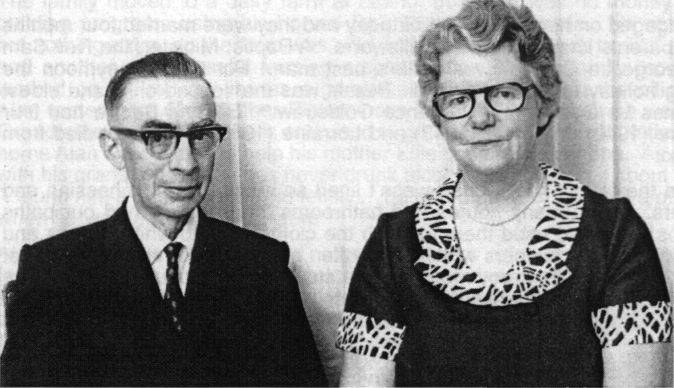
Willie Crouch and Bessie Le Couteur Crouch
Willie suffered from diabetes for the last twenty years of his life and died of stomach cancer in 1982. Bessie died at Kaniva in 2001. They are both buried at Kaniva. In ‘Family Writings’ there is a hymn Bessie wrote, which won first prize in a Church of Christ hymn writing competition.
A last story is about Willie Crouch and his mother. Mothers sometimes find it hard to get out of the role of being a mother and it seems Barbara Crouch was no exception.
Following the afternoon reception held to celebrate Barbara’s 100th birthday at Sea Lake in January 1971, the family was sitting out on the verandah in the evening heat. Willie, who was fast approaching seventy, looked at his watch and commented that it was ten o’clock already. ‘Yes Willie,’ responded Barbara, ‘time you were in bed, much too late for you to be up.’ 16
Edwin John CROUCH (1905-1966)
Fifth child and fourth son of Barbara McCue and Edwin Crouch born at Woomelang on 29 January 1905. Known as Eddie. 17
At the time of Eddie’s birth, his father was farming in the Woomelang district and working on the construction of the Melbourne to Mildura railway line. Ken Crouch tells us that when Michael McCue lived with Eddie’s parents at Panitya, Michael would take Eddie with him in the cart when he went to Pinnaroo to collect his pension from the Post Office. “Afterwards they adjourned to the pub where Michael ordered ‘a whiskey for me and a squash for the boy’. On the barman enquiring whether [Mick] wanted water with the whiskey, he was told in no uncertain terms ‘No, there is too much water in it already’.” Eddie was about twelve years old at the time and his job was to drive grandpa home again if he stayed too long in the pub.
page 135
As the Crouch family moved from one farm to the next, Eddie worked on the farm with his father. At one stage he worked for his Uncle Henry Mott at Gama and later he did seasonal work, fruit picking in the Red Cliffs area. He was friendly with his cousins Stuart and George Le Couteur. While fruit picking Eddie met Fred Finger, whose family were orchardists from Wantirna near Melbourne. Fred invited Eddie to visit and as a result he met Fred’s sister, Adah. Love blossomed and in 1935 Eddie married Adah FINGER 18 (1907-1991) at the Bayswater Church of Christ, Melbourne, in a service conducted by Pastor R Williams.
This was during the Depression and making a living was not easy. The couple moved to Mildura in search of work. Their first child was stillborn in 1936. Lindley (1938) and Ken (1940) were born in Mildura. Ken tells us, “transport there was bicycles, and while visiting friends in this manner, Eddie borrowed a baker’s bread basket to carry Lin in, perched on the handlebars of the bicycle”.
When Eddie joined the army in 1940 the family moved to Melbourne. Eddie’s army service was as a cook and his youngest son, Richard (born 1947), has his old recipe books which include items such as: ‘Stew for 100 men - take 451b meat, 601b potatoes, 201b onions, etc,’ and Treacle Pudding - 141b S R Flour, 41b dripping, 61b treacle, 11b crumbs, water to mix.’ After about a year Eddie was discharged from the army and he worked as a driver at a large flour mill. Next he worked in a produce store and after that for Trans Australia Airlines at Melbourne airport.
In 1953 Willie Crouch advised his brother of a farming opportunity at Kaniva and the Eddie Crouch family moved there, working a wheat and sheep farm on a share basis. In 1957 the family moved again, this time to Sea Lake where Eddie’s mother lived. His sisters Ellen and Barbara also lived there, the latter moving to Sea Lake with her family soon after Eddie’s family. This gathering of family provided a happy social life. At Sea Lake Eddie worked in the local store.
Eddie was a keen member of the Masonic Lodge both in Melbourne and Sea Lake. He had a fine voice and sang with both church and lodge choirs. Eddie died at Swan Hill after suffering a stroke, and is buried at Sea Lake. He was sixty-one years old. Adah survived him by twenty-five years.
Norman Percy Henderson CROUCH (1907-1968)
Sixth child and fifth son of Barbara McCue and Edwin Crouch, born at Woomelang on 22 August 1907.
Norm was married to Myrtle SELBY (1913-2001) at the Red Cliffs Church of Christ by Pastor Cameron on 4 April 1931. Their only child, Donald, was born the following year.
Bessie Crouch gives us this story about Norm and Myrtle. Willie Crouch and Norm decided they would go fruit picking near Swan Hill. “We took tents and camped close to the Murray River near where the job was. The men picked grapes and Myrtle and I decided we would too, so we asked for a job and took it in turns to pick - one in the morning and the other in the afternoon. Next day we would change over so one wasn’t picking in the heat of the afternoon all the time. The one not picking would look after Don and Beth [Bessie’s daughter].” 19
Norm was a horse breaker and trainer, and Ken Crouch tells us he still had horses in ‘the 1940s and 1950s when nearly everyone else had got rid of them in favour of cars and tractors’. Norm worked for the State Rivers and Water Supply, which ran the water channel system throughout the Mallee. The family lived at Speed and Norm was the ranger for the Turriff/Speed area.
Norm died in the Ouyen hospital at the age of sixty-one, following a stroke, and is buried at Woomelang. Donald had been running the bakery at Speed but after Norm’s death, he and his mother moved to Irymple. After Don died in 1977, Myrtle moved to Meningie in SA where she had relations living. She became blind in later life and lived in a nursing home in Meningie. Myrtle died in 2001.
page 136
Clive Oswald CROUCH (1913-1921) - twin with Barbara
The twins were the youngest of Barbara McCue and Edwin Crouch’s nine children. They were born at Panitya on 9 August 1913.
Barbara vividly recalls the death of her twin brother following a riding accident at the age of seven. The children took it in turn to bring in the cows for milking and on this afternoon it was Clive’s turn. Barbara was with her mother in the kitchen having her hair curled when there were shouts from the stable. The cart was got out and Clive was brought back to the house in this, suffering fatal head injuries. Clive had taken his pony down to the dam for a drink and as he went to remount, the horse was startled by a bird and shied. Clive was dragged with one foot in the stirrup. He survived unconscious for several days and then quietly died. ‘I could hear Mother pacing up and down in the kitchen at night, praying.’ After 80 years the pain of this event still brings tears to Barbara’s eyes and to the eyes of those listening to her as she told me the story when I visited her in April 2000.
The accident took place when the family was living at Cowangie and a pine tree was planted on the farm in Clive’s memory. Clive is buried at Murrayville.
Barbara Agnes Adie Erichsen CROUCH (1913-) - married name ROGERS
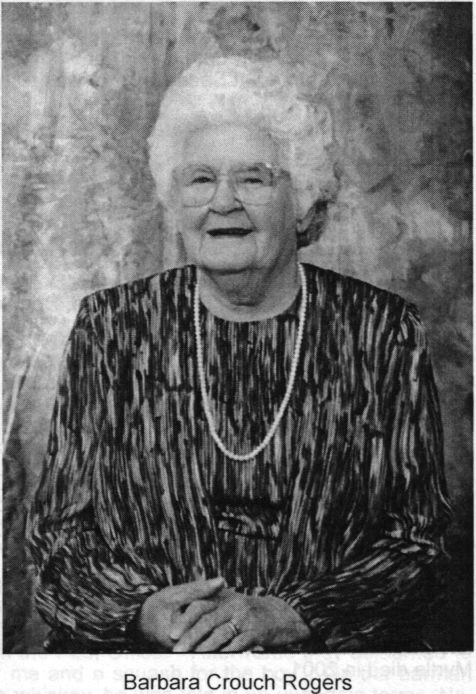
Barbara and her twin brother Clive were born at Panitya on 9 August 1913, the youngest children of Barbara McCue and Edwin Crouch. The name Barbara came from her mother, Agnes from her maternal grandmother, Adie after her great uncle William Adie, and Erichsen after Dr Erichsen who attended her birth. 20
Barbara attended various primary schools as her family moved around Victoria and South Australia, and gained her Merit Certificate. By then the family was living at Merrinee and the nearest high school, at Merbein, was 23 miles away. There were no buses in those days so Barbara undertook three years secondary schooling through the Correspondence School based in Melbourne, supervised by the head teacher at the local primary school. She worked as a temporary junior teacher at the Merrinee School, and later as sewing mistress. Barbara was twenty-one when her parents left Merrinee and she moved with them to Port Campbell. Moving again with her parents, this time to Turriff, she worked as bookkeeper in the general store.
In 1940 Barbara married Stan ROGERS (1912-1979) at the Turriff Methodist Church. The service was performed by Baptist minister Geoffrey Blackburn. Stan was a farmer. The couple had thirteen children born between 1941 and 1958. Two died at, or soon after birth. The eleven surviving children are Jennifer (1942), Bevan (1945), Barbara (1946), Arthur (1947), Heather (1950), Edwin (1951), Lyndon (1952), Lois (1953), Phillip (1954), Reta (1956) and Julianne (1958).
page 137
Stan had a lease at Merrinee North, and the couple farmed there for seventeen years. All the children except Julianne were born in Mildura. Barbara and Stan felt there was not much going for the young people at Merrinee, it was too isolated. There was a railway station, a shop cum post office, a public hall, some rural agencies and not much else, and the children had to go away to find work. So the Rogers decided to sell out at Merrinee North and bought a farm at Sea Lake, where they lived for the next seventeen years.
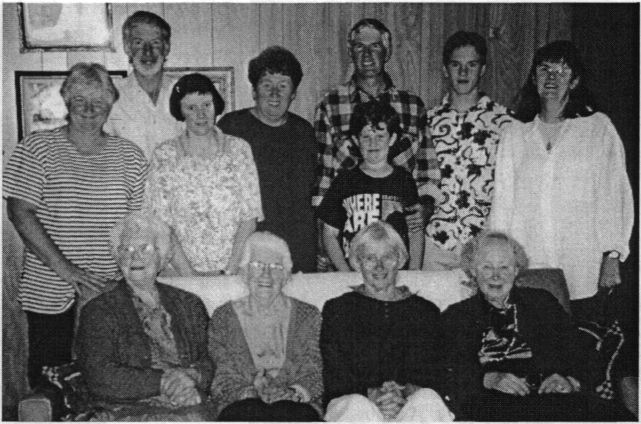
A Gathering of Agnes’ Descendants Portland, Victoria, April 2000
Left to right, back row: Janette and Clive Crouch, Raelene Powell, Anne, Laura and Arthur Rogers, Brendan Kiley, Barbara Francis,
Seated: Bessie Crouch, Barbara Rogers, Margaret Worrall, Betty Powell.
Barbara Crouch lived with Barbara and Stan Rogers until her death in 1976. Barbara’s sister Ellie Ribbons lived nearby and she helped with the care of Barbara senior. [There seems to be some confusion here as I have also been told Barbara Snr lived with Ellie and Jack Ribbons. Perhaps she moved back and forth between the two families], Stan died three years after Barbara Crouch, leaving Barbara Rogers and her youngest daughter Julianne on their own in the big house. Julianne then left home to study hairdressing. Another daughter, Barbara Francis, was moving with her family to Portland on the south coast, and invited Barbara to come and live with them. Barbara Rogers continues to live with the Francis family in Portland. In October 2002 there was a family gathering of Rogers in Sea Lake with over eighty family members attending.
Agnes Elma Emily Le COUTEUR (1904-1964) - married name COX
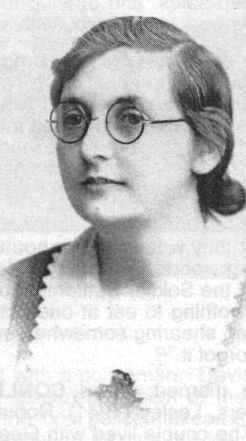
Elma Le Couteur Cox
Eldest child and only daughter of Robina McCue and Henry Le Couteur, born at Allansford on 10 July 1907. Always known by her second name.
Elma married Arthur COX (1902-1957) at Cowangie, Victoria in 1927 and they had two daughters, Mareon (1927) and Myra (1930) and one son, Harry (1932).
Arthur died in 1957 of cancer and is buried at Bendigo, Victoria. Elma died of heart disease seven years later and is also buried at Bendigo.
page 138
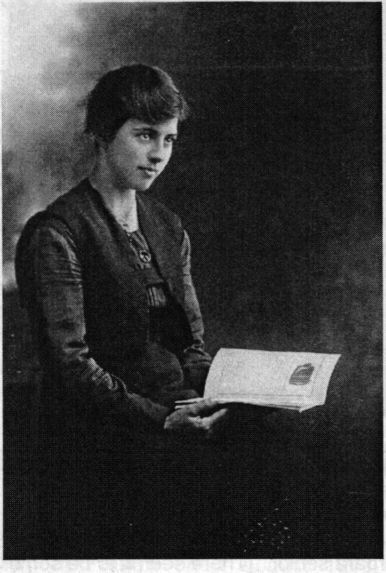
Elma Le Couteur
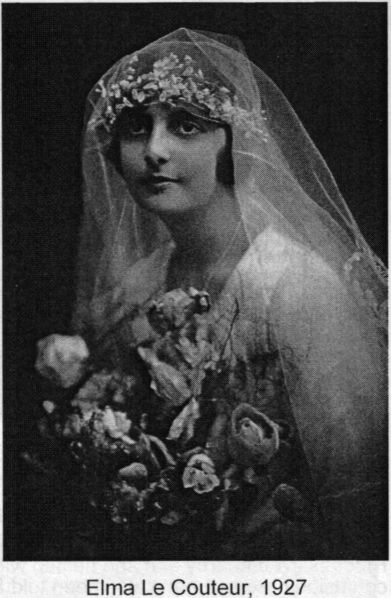
Leslie George Le COUTEUR (1905-1991)
Eldest son and second child of Robina McCue and Henry Le Couteur, born at Allansford on 22 May 1905. Always known by his second name.
George had a variety of jobs including shearer, drover, and wheat lumper at Turriff. For a time he worked as a labourer building the Great Ocean Road and at another stage he worked for the Lands Department. He broke horses, trained dogs and raised greyhounds. He even had a go at farming. George started his droving career by staying away from school, hanging around the sheep sales, and offering to drive the sheep out to a farmer’s property for him. His early shearing work was shared with his brother Stuart.
George drank heavily but I am told, ‘you wouldn’t know he was drunk when he sang’. At one stage George and his family lived in a house next to his aunt Barbara Crouch at Turriff. The walls of the shed were lined with beer bottles and when he moved out, Barbara got chaff bags from the horse yards, packed the bottles into them and dragged them down to the railway yard. Here there was a deep hole made by excavations for the railway line, and into the hole went the bags of bottles. Barbara then got the axe and smashed the bottles, stating categorically, 'no one will ever use these again’. 21
Despite his drinking, his teetotal Auntie Barbara was very fond of George and when he went to visit her they would talk for hours. After Edwin died, George would do jobs for Barbara such as chopping wood. Barbara told Ken Crouch that George had ‘nearly saved their lives’ when they were on the Soldier Settlement block at Merrinee during the hard times of the 1930s. “They had almost nothing to eat at one stage and George came through in a gig, heading home after he had been shearing somewhere, and he had a side of lamb and a bag of flour for grandma. She never forgot it.” 22
George married Arvon CONLIN (1918-1986) at Eaglehawk in 1940 and they had three daughters, Lesley (1941), Robina (1944) and Heather (1949). George always called his wife Con. The couple lived with George’s mother in Bean’s big old house and Bean needed lots of attention because of her asthma. She liked to be waited on and would call out to Arvon at 2 o’clock in the morning, wanting a cup of tea and ‘a thin slice of bread and butter please’. Arvon
page 139
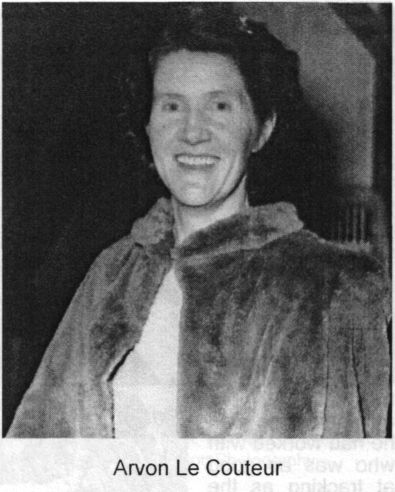
would have to get up and light the wood stove to boil the kettle. Looking after Bean, George and her children, as well as the agencies she ran, Arvon was always busy. She has been described to me as a remarkably placid person, who never complained. However, she instructed her daughter Heather, ‘When I get old and can’t look after m’self any more, whatever you do, don’t ever bring me to live with you.’
Despite her busy life Arvon managed to be ‘the best hostess around’. She and George had agencies for wheat and oats, which were run from the big kitchen under the house. In the summer Arvon was flat out answering phone calls and taking orders, and the large table would be covered in stuff, ‘Anyone who came in the door, it was - Have a cup of tea - Righto! - We’ll just move a bit of stuff. Things would be pushed around and a tiny corner cleared and cups laid out. Dorothy Geary says she and her mother, Gertie Grace, used to tidy things up, but next time they came around the table would be just as cluttered and a tiny space would again have to be cleared for the tea cups. 23
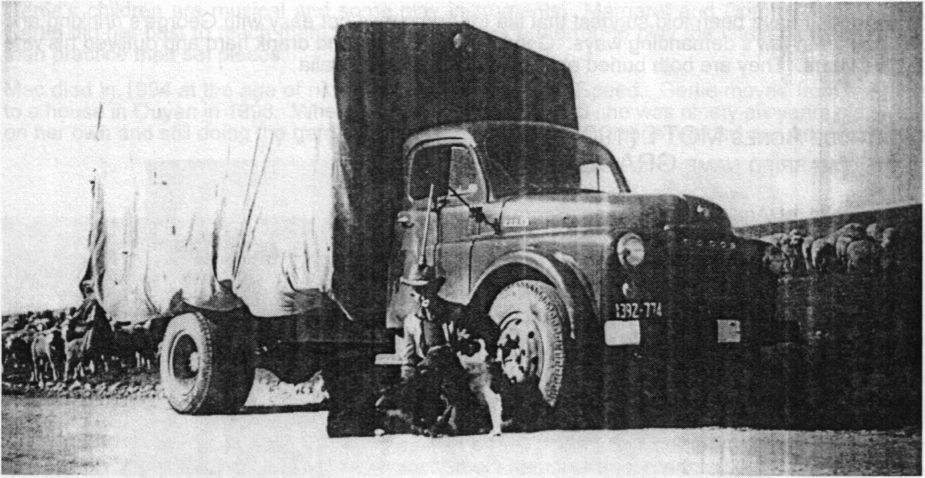
George Le Couteur With kind permission of Waikerie River News’.
George’s daughter, Heather, provided me with a copy of an oral history tape made by George in 1985 and an article published in the Waikerie newspaper on 11 September 1985. These record George’s memories of droving, in particular the last big drive of 3000 sheep from Hawker in the Flinders Ranges of South Australia, to Pinnaroo, near the border of Victoria, in the early 1960s. This took three and a half months and involved taking the sheep across the Murray River on the ferry at Waikerie.
In the newspaper article George tells of a confrontation he had with a policeman. David Mott, who is the son of George’s cousin Russell Mott, tells a less sanitized version of the same story. 24 Seems George was in the Hopetoun pub drinking when the local policeman came in and asked George if he was responsible for the sheep that were wandering all over the town. The policeman told George that if he did not move the sheep on he would arrest them. George’s
page140
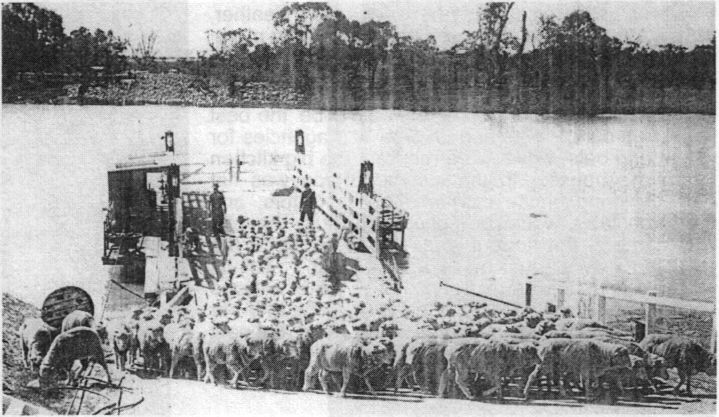
George Le Couteur’s last big sheep drive.
Taking sheep across the Murray on the punt at Waikerie in the 1960s. With the kind permission of Waikerie ‘River News’.
response was to say to his mate, “Okay, pack up the cyclone we’re going home for the weekend.” He then reminded the policeman that if he arrested the sheep they would be his responsibility and he would have to see they were yarded, fed and watered. He had no further trouble with the policeman.
David Mott tells another story about George Le Couteur. When passing through Adelaide Airport David got talking to a retired policeman who had written a book about his experiences with black trackers. The ex-policeman said that there had been only one white man he had worked with who was as good at tracking as the Aborigines. Having a copy of his book with him he pointed out a photo of this man to David. It was George Le Couteur. The policeman said George was the funniest man he had ever worked with, but very clever.
The stories I have been told suggest that life for Arvon was not easy with George’s drinking and her mother-in-law’s demanding ways. George worked hard and drank hard and outlived his wife by five years. They are both buried at Waikerie in South Australia.
Gertrude Agnes MOTT (1904-) - married name GRACE

Gertrude Mott - the music graduate
Eldest child of Agnes McCue and Henry John Mott, born at Warracknabeal, on 3 August 1904. Generally known as Gertie.
When the family moved to Gama East, Gertie’s father did not consider her old enough to drive the horse and cart to the Turriff School, so she missed out on a formal school until she was eleven. Her first schooling was with a Mrs Harrett who lived on a property some miles from the Mott farm and Gertie and her sister, Rheita, used to walk there for their lessons. Later they went to school in Turriff. After leaving school, Gertie worked on the farm. In 1922 at the age of eighteen Gertie took out her Diploma of Music from the London College of Music for pianoforte playing. In 1923 she became an Associate of the LCM and in 1926 a Licentiate. Gertie was able to attend lectures and do her music exams in Woomelang and Turriff. She taught music for six years before her marriage. Despite arthritis in her hands Gertie played the piano for me when I visited her in April 2000. I was able to observe that she has the large square hands that are common amongst Robertson descendants.
page 141
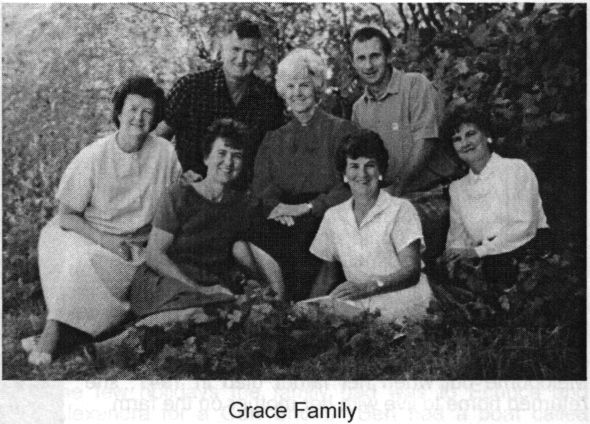
Left to right, back: Dot, Austin, Ruth, Ron; front: Bev, Verna, Margaret.
With the kind permission ofTonyRawson Photography.
In 1929 Gertie married John (Mac) McCarthy GRACE (1903-1994) at the Gama East Baptist church. Mac was born at Traralgon in Victoria. Gertie and Mac had seven children, five girls and two boys, Ruth (1930), Dorothy (1931), Margaret (1934), Verna (1936), Austin (1938), Beverley (1942) and Ron (1944).
Mac and Gertie were pioneer farmers at Turriff West, on land selected there in 1927. The property is called ‘Carinya’ and in 1977 won the Hanslow Cup for farm management, productivity, improvement and environmental management. An irony is that having cleared the trees to establish the farm, trees are now being replanted as part of the environmental management program. Austin took over the farm from his parents, and it is now run by grandson Michael and his wife Julie.
Gertie played the church organ for over seventy years, mostly at the Turriff Baptist church. The Church presented her with a plaque to commemorate this remarkable effort. In 1988 she received the local Australia Day award as 'Neighbour of the Neighbourhood’. Gertie is very modest about her achievements and most of the information I have about her has comes from her children and grandchildren, rather than from Gertie.
Gertie’s children are musical and some play instruments. Margaret and Dorothy told me that Gertie did her best to teach them the piano but they preferred to play the latest hit tunes rather than practice their set pieces.
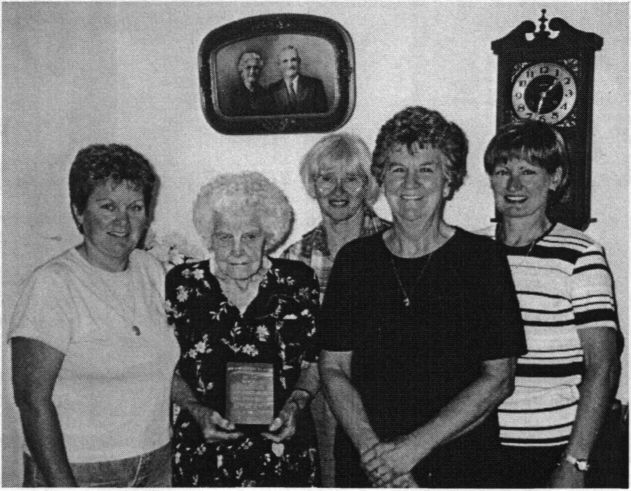
Gathering at Gertie’s house in Ouyen, April 2000 Left to right: Colleen Barnes, Gertie Grace, Margaret Worrall, Verna Monaghan, Marita Miller. Gertie is holding her citation as Neighbour of the Neighbourhood 1988’. Note the photo on the wall of Gertie’s parents Aggie & Henry Mott.
Mac died in 1994 at the age of ninety-two, and is buried at Speed. Gertie moved from the farm to a house in Ouyen in 1998. When I visited her in April 2000 she was ninety-six years old, living on her own and still doing the gardening and most of the other things needed around a house.
page 142
Rheita Mary MOTT (1906-1977) - married name MITCHELL
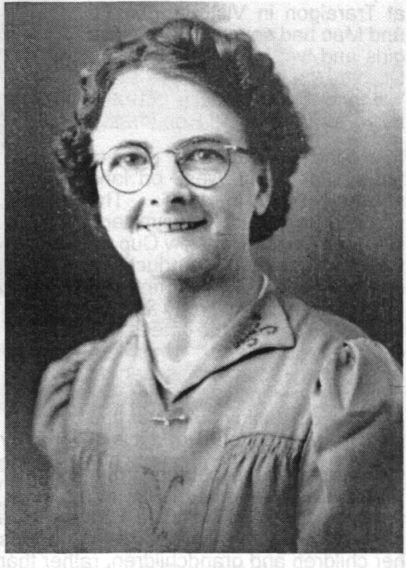
Rheita Mott
Second child and second daughter of Agnes McCue and Henry John Mott, born at Warracknabeal on 25 May 1906.
Rheita grew up on the family farm at Gama East. Her early schooling was under the direction of a neighbour, Mrs Harrett. Later she attended the school in Turriff. Aggie encouraged her children’s musical ability and Rheita was given an autoharp. This is now in the custody of Rheita’s niece, Margaret Powell (nee Grace).
Rheita suffered from a ‘weak heart’. She worked for a time as a domestic at the Baptist College in Melbourne but when her father died in 1947, she returned home to live with her mother on the farm.
On 27 August 1949, Rheita married Albert MITCHELL (1916- ) at the Bendigo Baptist Church. After honeymooning at Daylesford the couple made their home at ‘Westleigh’ in Speed, farming wheat and sheep. Land had to be cleared and dams made, and Bert also did outside work clearing local irrigation channels.

Rheita Mott’s Wedding to Bert Mitchell, 27 August 1949
The three bridesmaids are Ruth, Margaret & Beverly Grace. Gertie & Mac Grace are left and right in the back row.
Agnes McCue Mott is in front with the handbag
Rheita and Bert adopted three children. The three were siblings, with the same natural parents, Sue (1947), Ken (1949) and Paul (1954). Ken was killed in an automobile accident in 1968.
page 143
Rheita held strong Christian beliefs. She played the organ for church services at the Baptist church in Turriff and the Methodist Church in Speed, and participated in the Lady’s Guilds. Sue remembers Rheita and Grandma Aggie doing the week’s washing together with a wringer washing machine, ‘Mum on one side, Grandma on the other. Mum always cleaned the house on Saturday, washed the floors and kitchen louvre windows and Mum nearly always cooked a leg of mutton Saturday for a cold Sunday lunch - if cold in winter we might get soup and hot potatoes with it. Most Sundays a custard was made for dinner - no work was done on Sundays.
I remember Saturday nights in winter making toast in front of the stove for scrambled eggs and soup, while watching the footy replay. Mum made good powder puffs filled with cream.’ 25
Bert enjoyed tennis and clay shooting and one of the few holidays the family had was to Echuca and Alexandra for a Gun Shoot. Bert had a boat called ‘Whirl Wind’ and the family would go to the lakes for boat trips and water skiing.
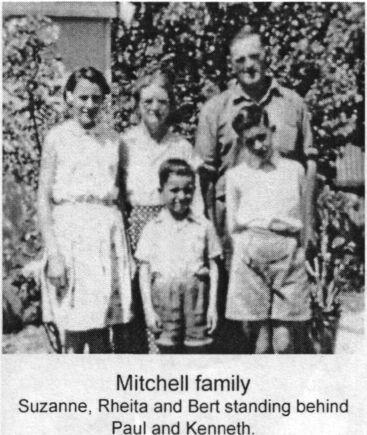
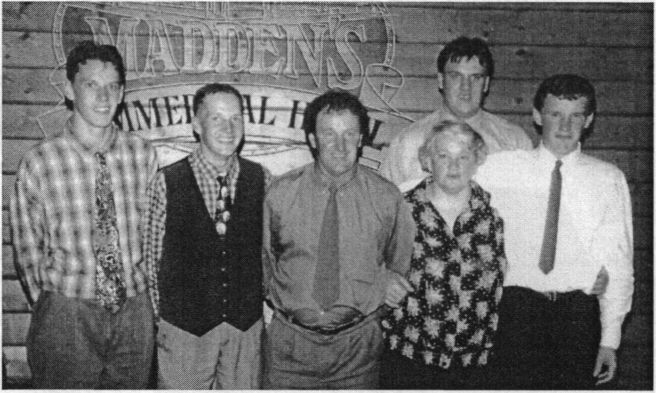
Sue Mitchell Boyd
With her husband Brian and sons Rodney, Mark, Stuart and Craig.
Aggie lived with the family in later life but eventually Rheita was unable to look after her because of her own ill-health, so Aggie went to live with Gertie. Rheita died at Hopetoun on 7 May 1977 and is buried at Speed.
Bert remarried in 1985. His second wife, Melva Nesvold (nee Vivian), was a widow whose husband had died six or seven years earlier. Melva died on 24 December, 1999. After Melva's death Bert moved to ‘Lovely Banks’ nursing home in Cobden.
Russell Edgar MOTT (1910-1999)
Fourth child and second son of Agnes McCue and Henry John Mott, born at Gama East, Victoria on 7 August 1911.
While on holidays at Lome on the south coast of Victoria, Russell met Vivienne HOWE (1911-2002) whose family ran a Post Office near Colac. The couple were married at Redcliffe in 1937 and had six children including two sets of twins, Graham (1938), Jeffrey and David (1939), Marie and Doreen (1941) and Bruce (1945).
Russell worked on the family farm. This comprised a number of blocks and when Henry Mott died in 1947 he left a block to Gertie, a block to Rheita and several blocks to Russell. Russell continued on the farm eventually buying his sister’s blocks and adding more land, which he purchased off surrounding farmers.
Russell was very fond of dogs. At one time he had twenty-two of them. Everyone in the district knew Russell and his dogs. They would see him coming and know it was Russell because he drove so slowly and the back of the Ute would be full of junk. His dog would be draped behind
page 144
George across the back of the seat, its head out the window. Russell’s last two dogs were Girlie and Sandy. Granddaughter Debbie Riley who lived with her grandparents after she left high school remembers Russell with great affection. Debbie fondly claims, “Sometimes Girlie and Sandy got more affection than Grandma, more than anyone else in the family.” 26 Russell insisted on a substantial cooked breakfast and had his own special cup and cutlery, making a fuss if they were not on the table for him. Debbie says Russell was “a real worry wart”, but he had a great sense of humour and told wonderful stories. His rare letters to Debbie were gems full of news about family and friends. One of his ‘party tricks’ was to light a match and burn the hairs out of his ears.
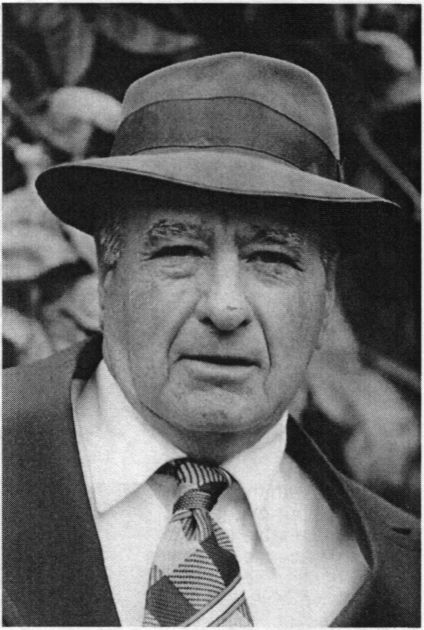
Russell Mott
Farming was Russell’s life and he was reluctant to retire. Eventually he and Vivienne moved to Sea Lake, but he was still driving out to the farm when he was in his eighties. Bruce and his son Ashley now farm the property. Graham and his sons have properties in the same area.
Russell died in 1999 and is buried at Sea Lake. Severely debilitated Vivienne spent her last years in a nursing home and died at Sea Lake in 2002.
Marjorie Constance McCUE (1915-) - married name MATHIESON
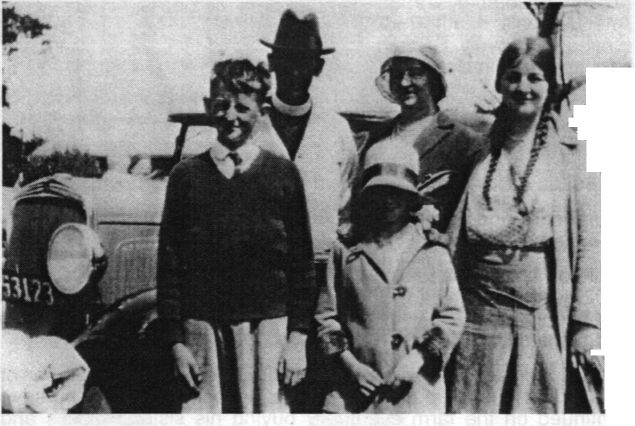
Jack McCue’s Family Left to right: John, Rev Jack, Marion, Tot and Majorie
First child and elder daughter of the Jack McCue and Edith Collins, born in Melbourne on 1 July 1915. 27
Marjorie left school at seventeen and trained as a nurse at the Eye and Ear Hospital in Melbourne. On completion of her training she worked for a Collins Street eye surgeon for four years. She studied chiropody at night but never practiced.
On 9 September 1938, Marjorie married Archibald George MATHIESON (1907-1960) at Canterbury, Victoria. Archie was the son of Archibald Mathieson and Annie Laura Le Couteur. 28 He was born on the family farm ‘Errawallun’
page 145
at Nullawarre. After their marriage Marjorie and Archie had a dairy farm ‘Moongana’ which was west of ‘Errawallun’. Although adjacent to other Mathieson properties, it was not part of the original farm. Archie and Marjorie claimed three local ‘firsts’ for their farm - the first post war car in the district (a 1948 Pontiac Silver Streak), the first refrigerated milk vat (about 1958), and the first to go with 100% artificial insemination (1960).
Marjorie and Archie have four children, Marie (1940), Evan (1943), Nola (1944)and Ross (1956), all born at Warrnambool. When Archie died from a heart attack at the age of fifty-three, Ross, the youngest child, was only four years old. Marie had already left home to study hairdressing. Marjorie and seventeen years old Evan continued running the farm for two years. Evan however wanted to do other things and at nineteen he went back to school to get his High School Certificate. Marjorie sold the farm in 1962.
Moving to Melbourne, Marjorie ran a boarding house at Armadale and then bought a house in Kew. These houses represent the first in a series of houses and businesses, which Marjorie bought, developed and later sold at a profit. She bought a hairdressing salon and this gave her income while she was renovating the houses. The three eldest children had a second salon between them, Marie drew a salary and the profits were shared. Marjorie tells us she “also knitted madly. Did twenty five jumpers one year and sold a pair of random coloured overalls to actress Phyllis Diller when she was in Australia.”
Marjorie bought a Rambler V8 and she and Ross travelled to Queensland where they lived for nine years. Here again Marjorie bought houses and land, developed them and then sold them. Renovating houses was something she enjoyed. Evan also moved to Queensland and Marjorie helped him set up in a furniture business. Nola returned to the Western District and married there in 1967.
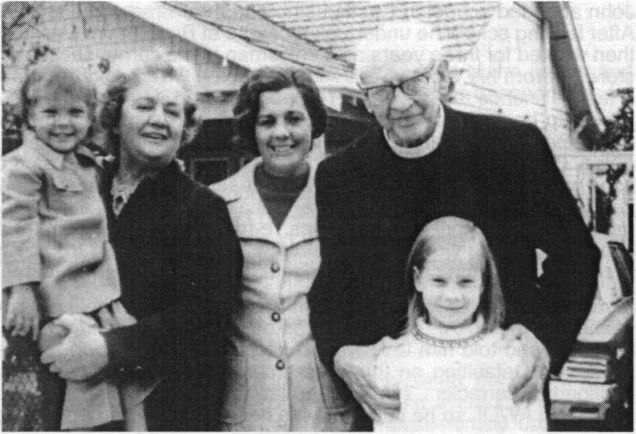
Four Generations of McCues Left to right: Sheridan Keys, Majorie Mathieson, Marie Keys, Jack McCue, Wendy Keys
Marjorie returned to Victoria because her mother was ill and moved in with her parents. After Tot died in 1971, Marjorie stayed on with Jack for two years.
Without consulting her, Jack sold the house ('because he was offered a good price’) and moved into a retirement home. Marjorie had continued the business of buying and renovating houses and she was able to move into a house she owned in Hawthorn. As a joint venture with a business partner, Marjorie bought an antique business in Warrigal Rd. A year later she bought her partner out and ran the business on her own for a further five years. She finally sold the business when the lawyer next door wanted her property so he could expand his own premises.
When daughter Nola separated from her first husband, Marjorie lived with Nola and her two children for three years, in a rented house on a sheep property at Lake Bolac. Her next venture was a Pancake Parlour in Melbourne that she ran with Ross. This lasted for seven years. The business folded when the property was repossessed by the government to build a freeway.
Marjorie inherited the family’s musical ability with a fine voice, and she used to play the piano at country dances. Her husband Archie was a trained singer and it was with his encouragement that Marjorie received training for six years. Her repertoire included ballads and Scottish and Irish folk songs. “My best achievement was Bloody Mary in ‘South Pacific’ for the Spotlight Theatrical Company.” Daughter Marie and her family were living with Marjorie for a time and granddaughter Wendy, who called her grandmother Gahn, liked to be sung to sleep. She would insist on ‘Speed Bonnie Boat Gahn’ so often that her father would say to Marie, ‘Doesn’t your
page 146
mother know any other song.’ Marjorie’s children continue the musical tradition as singers and players of piano, violin and guitar.
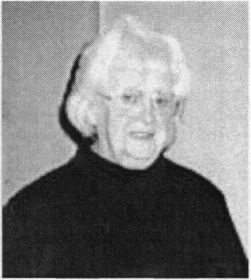
Marjorie McCue Mathieson
In 1960 Marjorie took up painting. It seems Marie was originally the one interested in painting and when she attended classes Marjorie just went along to keep her company. Marjorie has been painting ever since. She has also done leatherwork.
Marjorie tells us the best thing about her life has been her friendships, ‘taking people in and helping them along the way’.
The things she has been proudest of are her swimming ability, knitting and singing - her vocal range was three octaves plus. She is a great raconteur and many stories about the early days of the Robertson family come from her.
John Collins McCUE (1917-1999)
Second child and only son of the Jack McCue and Edith Collins, born at Castlemaine on 28 May 1917. Like his father, John was often called Jack but to save confusion I have stuck to John or John Collins McCue.
John attended school in Castlemaine and the Primary and High Schools in Coburg, Melbourne. After leaving school he undertook a course at Bradshaw’s Business College in South Melbourne, then worked for three years as a salesman in the carpet section of Foy and Gibson’s department store. 29 From his World War II Airforce record we discover that at the age of twenty-four he was 5 feet 11 inches tall, weighed 146 pounds, and had brown eyes and fair hair. 30 At the time he joined up he was working for George Croft at Nullawarre North and his occupation is recorded as ‘farmer - sheep and cattle’. 31 The records contain a ‘Certificate of Exemption from Service’ dated 31 July 1941, presumably because farming was seen as a protected occupation, however John went ahead and joined the RAAF reserve in December, applying to join air crew. His active service began in May 1942. He was initially assigned as a gunner (‘Air crew - Guard’) but eleven months later in April 1943, he was re-mustered as ‘equipment assistant’. His sister Marjorie explained that he was taken off aircrew because he had trouble with a dislocated thumb, which prevented him from pushing the trigger on a gun. Later the thumb was repaired in an operation.
It seems that as a young man John had a bit of a rebellious streak. In February 1943, while serving at the RAAF station at Parkes, John was confined to barracks after responding to a Corporal who told him to leave the kitchen, “I will as soon as I have finished making this piece of toast”. Defaulting on this punishment over the next two days he got a further seven days confined to barracks. Two months later when his fiance’s father was killed in a truck accident Jack went AWOL so he could be with her and was given 168 hours detention. 32
John served in New Guinea from July 1943 until October 1944. He told his son Jeff that while he was in charge of stores in Port Moresby, the Americans came and they had ‘everything’. So John and his mates would slip out at night and pinch their tucker, ‘so we lived pretty well’.
John met Janet STEVENS (1919- ) at a Christian Endeavour meeting in Port Campbell. The courtship involved John riding his bicycle back and forth the 15 miles (24 km) between where Janet lived, and his sister Marjorie’s house at Nullawarre. The couple were married on 28 May 1943, at the Port Campbell Baptist Church by Jack McCue, John’s father. This was shortly before John was sent to New Guinea. While in New Guinea John wrote poetry, which he sent to Janet. John and Janet have three children, Alden (1944), Jeff (1946) and Helen (1951).
page 147
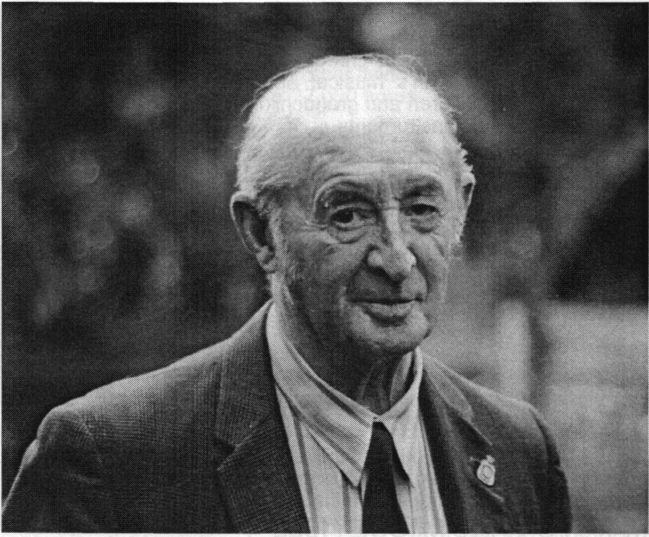
John Collins McCue
After being repatriated from the Airforce in 1945, John and Janet pioneered the cottage system for the Tally-Ho Boys Home at ‘Woodlands’ in Lilydale.
In his request for repatriation John states:
“The Home-Farm consists of a combined orchard and Poultry Farm, where youths from fourteen to sixteen years are trained, not only in farm work, but in the elements of good citizenship through a Christian home atmosphere for a foundation in character, that will make them realize their place in, and responsibility to the community.” 33
After leaving Woodlands, John and Janet bought a soldier settlement farm near Port Campbell and the couple lived there until their retirement. “They moved in with 15 pounds in the bank and food in the pantry and commenced clearing, fencing and dam building. There was no electricity, and transport was by horse and cart.” 34
The tribute presented at John’s funeral describes John as a caring person, a ‘greenie’, and someone with a special interest in ordinary people. Daughter Helen tells us he had a mischievous sense of humour. He was interested in sport - swimming, running and tennis. John was a Heytesbury Shire Councillor for twenty-six years (1964-1990), serving as President of the Shire in 1967-68. It was at his suggestion that new roads in the southern part of the shire were given aboriginal names. 35 This reflects his interest in local history, which was complimented by an abiding interest in family history. Information he collected about the family is included in this Robertson family story. John was a Justice of the Peace, a school counsellor and a teacher of religious instruction. In 1966 he stood as a Country Party candidate for the Polwarth electorate but was defeated.
None of what John did would have been possible without the support of Janet, his hard working wife. Son Jeff left school at fourteen and went to work on the farm and according to Jeff his father sometimes gave his wife and family a bit of a hard time. Occasionally John would disappear, leaving Jeff and his mother to milk anything up to eighty cows on their own. Jeff never knew where he went until years later he met a man who had known his father in Warmambool. It seems John used to go there to play the big pipe organ in the Presbyterian Church. He was noticeable because he was one of the few people who could play it. 36
John was a gifted musician. His ability to play almost anything by ear led some people to believe he could not read music. His mother told granddaughter Helen that when he was learning the piano as a child John would “put a comic book on the piano in front of his lesson books instead of practicing.” Helen writes, “when my brothers were old enough to drive, Dad would sit in the back seat of the car on a long trip and play his ukulele and we’d sing all the way to our destination and back”.37 John played for church services and social functions for over forty years. He had a natural ability to harmonize and he would sing duets with Arthur Ward at the Port Campbell
page 148
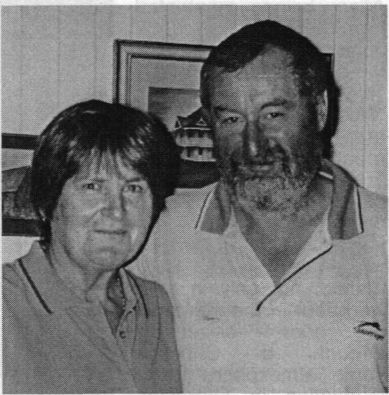
Di and Jeff McCue, 2003
and Waarre Baptist Churches. His ability to play by ear was apparently an asset during his time in the Airforce when he played at church parades and on other occasions. John’s musical ability has been passed on to his children and grandchildren who sing and play a variety of instruments.
John and Janet spent their later years living at their daughter’s property near Melbourne until ill health caused John’s admission to the Rosden Nursing Home in Burwood, Victoria. He died there on 4 December 1999. Janet resides at the Salford Park Retirement Village, Wantirna, Victoria.
Marion Corfield McCUE (1922) - married name PARKER
Youngest child and second daughter of Jack McCue and Edith Collins born at Castlemaine, Victoria on 1 January 1922. 38
When Marion was four months old, Jack was called to the Baptist Church at West Moreland in Melbourne and the family moved there. Marion’s primary education was obtained at several schools including West Coburg Primary and North West Brunswick. In 1932 the family shifted to West Preston and remained there for six years. Marion attended the West Preston Primary School for two years then moved on for four years at the Preston Girl’s Secondary School. When Jack returned to work with the Victorian Temperance Alliance, the family moved into a house in Balwyn Rd, Balwyn.
Marion undertook a course at Business College and at the age of sixteen commenced work with Maurice Blackburn and Co, Barristers and Solicitors in Bourke St Melbourne. Mr Blackburn was a member of the Victorian House of Assembly and Speaker of the House. Later he was elected to the Federal Parliament. He was a member of the Labor Party and the company’s clients included several Trade Unions. Marion writes: “This was a great learning time for me. I spent a good deal of my time out of the Office in my responsibilities as a Law Clerk, attending Courts, Inquests, Probate, Titles Office, Summon Serving etc. Melbourne was full of Service Personal of many Nations, some of them getting on the wrong side of the Law making a busy time for our Office.” 39 One of Marion’s tasks while working as a Law Clerk involved the preparation of probate and the transfer of her Uncle Arthur McCue’s property after his death in 1938. Marion worked for Blackburn and Co until 1945. Between 1945 and 1951 she worked with her father at the Temperance Alliance.
Marion met William Brian PARKER (1922-2001) through mutual friends and in March 1950 she and Bill were married at the Canterbury Baptist Church. Marion’s father officiated at the service. Bill was the son of Frank and Hilda Parker and was born at Shenstone in England. Frank was a farmer and after the family migrated to Australia in 1923, he took up a Soldier Settlement block in the Mallee. The farm was not a success because of poor soil and the family moved to another farm at Drouin where they grew potatoes. When the Depression came the family “had to walk off their land and leave it behind lock, stock and barrel.” 40 Moving to Melbourne, Frank found employment with a transport company and stayed with this firm for the rest of his working life.
page 149
During World War II, Bill Parker served for five years as a pilot with RAAF in Africa, Europe and Asia. Returning to civilian life he tried his hand at truck driving, photography and orchard work until he was accepted by Australian National Airways (later Ansett) as a pilot in 1948. He remained with Ansett for thirty-one years. In addition to his other flying experience Bill amassed 21,500 flying hours with Ansett, making a total of well over 22,000 hours.
After their marriage Marion and Bill lived for a time with her parents while, with the help of family and friends, they built their first home at Eltham Rd, Lower Plenty. It was while they were living here that their three children were born, Michael (1955), and twins Marcia and John (1959). In 1971 the family moved to a new house in McLaughlin’s Lane, Plenty. This time they employed a builder.
In his father's eulogy John Parker describes the family’s life: “Our grandparents were regularly visitors and we played with our aunts and cousins. Summer was always fun and dad had built a wooden rowboat, which had an outboard motor and my family, grandparents and cousins used to play and fish in this boat in the 60’s and 70’s at Frankston and Dromana. He also built model planes and made billy carts and toys for us as children.”
After Bill retired from Ansett, Marion and Bill travelled in Australia and overseas, and served for short terms with the Missionary Aviation Fellowship in Arnhem Land, the Northern Territory and Papua New Guinea.
Both Marion and Bill have been active in their church and local communities. Marion served for twenty-five years as a volunteer with the Greensborough Citizen’s Advice Bureau and the Mornington Information Centre. Bill delivered Meals on Wheels and taught Religious Education in Primary Schools. In 1988 Marion and Bill moved to Somerville on the Mornington Peninsula. Here they attended the Mornington Baptist Church and were again involved in local activities.
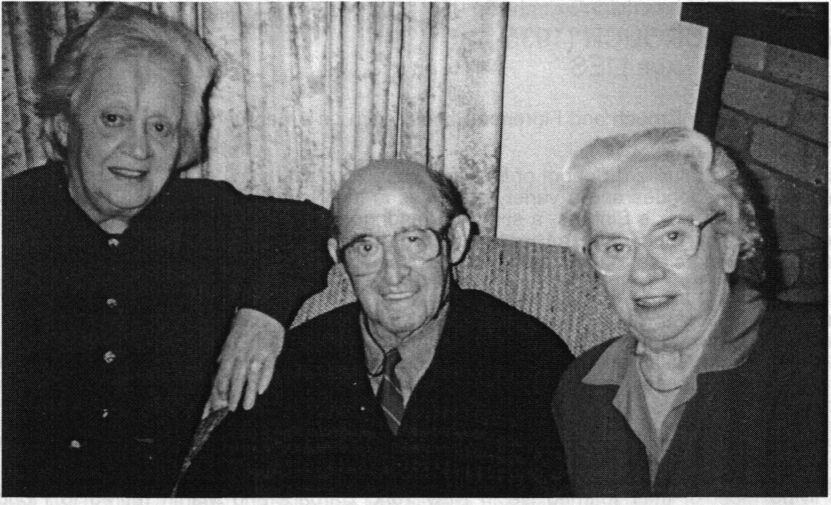
Three McCues
Left to right: Marjorie Mathieson, John McCue, Marion Parker, May 1997.
Bill died in January 2001 and his ashes are interred in the McCue grave at Port Campbell. Marion now lives in Baronia.
page 150
Generation E
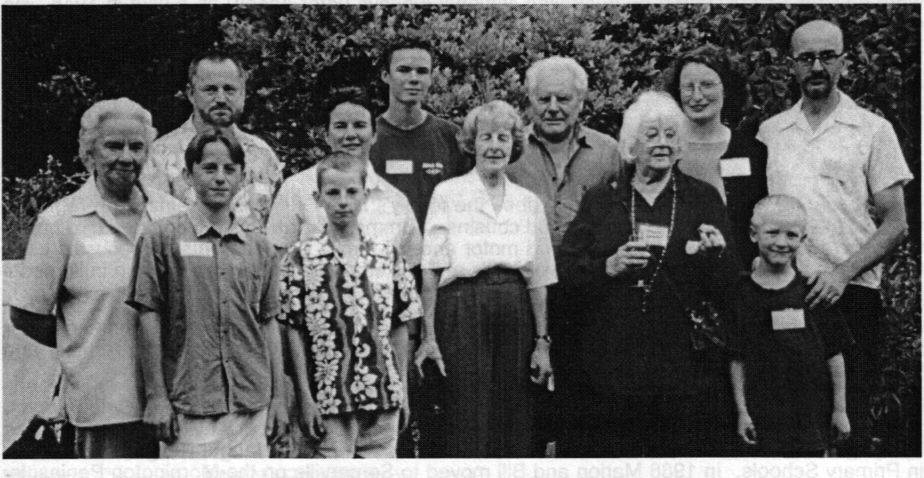
Descendants of Agnes Robertson, Melbourne 2000
Left to right: Marion Parker, Adam & Peter Booth, Justin, Marcia and Christopher Booth, lone Jones, Stuart Le Couteur, Marjorie Mathieson, Zaita Oldfield, Oscar Oldfield-Mathieson, Ross Mathieson.
Barbara Ruth CROUCH (1935-) - married name LIES
Only child of Arthur Crouch and Florence Schulz, born on 4 February 1935, at Eldon, Missouri, USA. 41
Barbara trained at Juilliard School of Music in New York and worked as a professional singer, in churches, synagogues and a variety of places in the New York area. She toured for some years with the Riverside Singers, a six voice madrigal group, and had several seasons at the Milwaukee Melody Top Summer Theatre. After her marriage she started on a twenty-six year career in Real Estate but also continued with her singing.
Barbara married Martin LIES (1934-) in June 1970. 42 The couple met while working with the Riverside Singers. As well a being a singer himself, Martin was a singing teacher, working with opera and Broadway singers and at the Mannes School of Music, the Manhattan School of Music and Vassar College. Barbara and Martin had no children together but Barbara took on the role of stepmother to Martin’s two children from a previous union - Karl Timothy Lies and Deborah Elizabeth Lies Pierson - and they are now proud grandparents.
Barbara has visited relations in Australia on several occasions and during one of these visits she gave a concert at Sea Lake for her grandmother.
After living most of their married life in New York, Barbara and Martin retired to Florida in 1996. Martin sings in the Westminster Presbyterian Church at Daytona Beach and still has a small number of students. Barbara is active in the church and writes a column for the local newspaper.
page 151
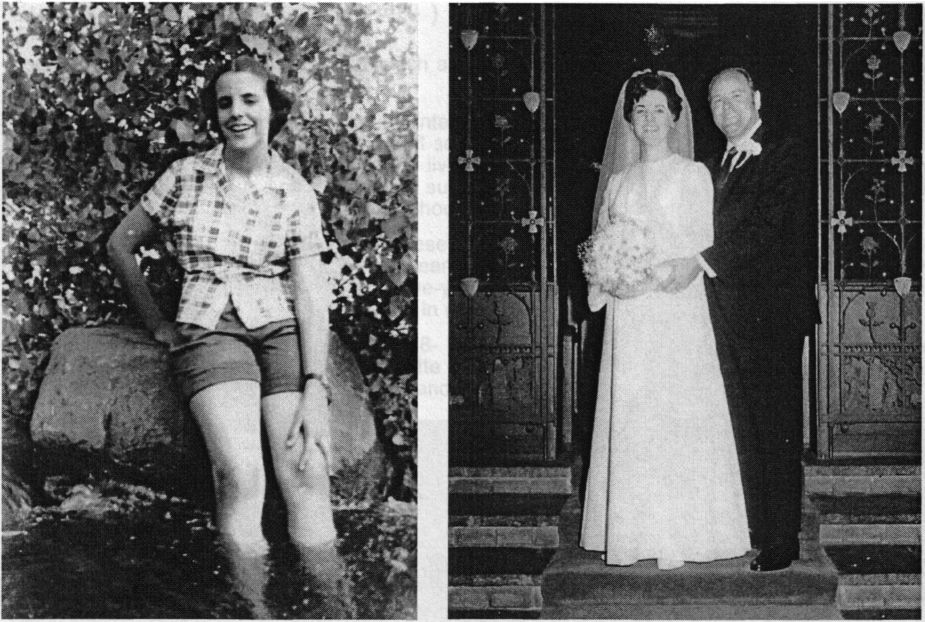
Barbara Ruth Crouch ... Barbara Crouch and Martin Lies, on their wedding day, 3 June 1970.
Alan John RIBBONS (1927-)
Youngest child and only son of Ellie Crouch and Jack Ribbons, born at Merrinee, southwest of Mildura, on 26 November 1927.
Alan was great friends with his cousin Donald Crouch who was a few years younger than Alan. They were both fond of horses and it seems the pair used to get into mischief together. Barbara Rogers tells us of an occasion when they were teenagers. They dressed up with sheets, over their heads and went out onto the road and did their best to frighten passing motorists. 43
After leaving school Alan worked in Robinson’s general store at Turriff for eleven years. His family was living in Turriff at the time. The store sold everything - petrol, oil, kerosene, groceries, ladies wear, shoes, slippers, stockings, dresses, lollies, ice creams, drinks, and anything you might want. Fuel and other goods were delivered to the farms in a big truck. Alan had Wednesday off, but worked on Saturday till 9pm. His cousin Ruth Grace also worked at the Turriff store.
Alan tells the following story about working at the store. When he came home after being away, the boss liked to have a ‘nip’. “These two blokes who had been working at the wheat silo came in for a drink. We had lemonade and raspberry and all the drinks lined in rows in the fridge, so if you went there and you knew what people wanted you could just grab it. These two decided they would have 6 o’clock [a type of soft drink] so I grabbed the 6 o’clock and poured them out their drinks, and they had a glass each. One says ‘I’m feeling thirsty, could you go another one, my shout’. And the other one says ‘yes I’ll go another one’. These two had gone, and paid of course, when the boss arrived home. He says, ‘Has anyone seen my bottle of beer? It was in the row with the 6 o’clock but I took the label off. Who drank it?’ ‘Oh no’ I said, ‘the Methodist minister and the local preacher!’ ‘Oh no!’ says the boss ‘don’t you dare tell anybody’.” 44
page 152
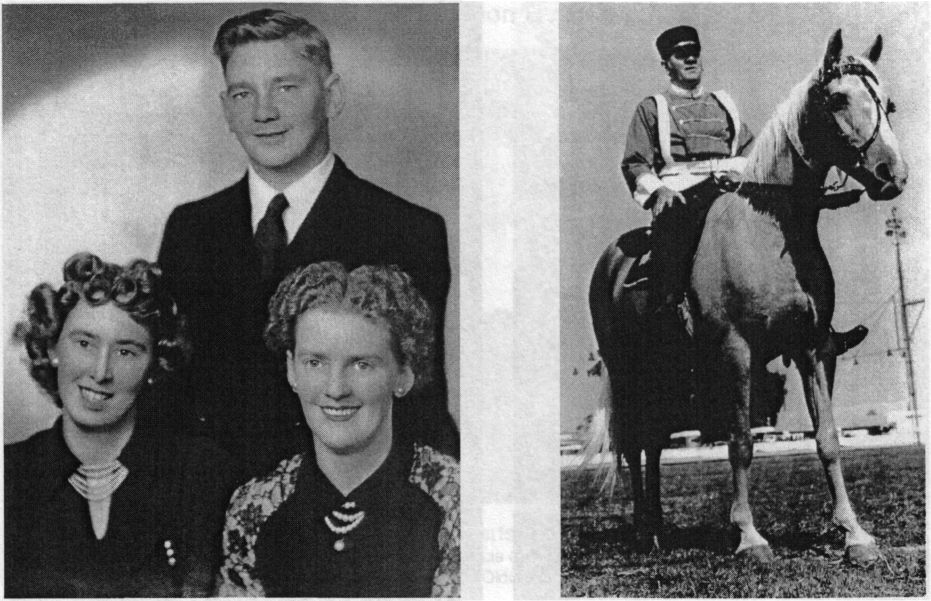
Ribbons Family Left to right: Betty, Alan, Nancy. ... Alan Ribbons on one of his Palomino horses at the Shepparton Show.
Leaving Turriff, Alan worked in a grocery shop in Sea Lake. He then went to Melbourne where he worked for the retail stores Buckley and Nunn as well as Foy and Gibson’s. In the 1950s Alan worked in the S E Dickins store in Glenferrie Rd. Hawthorn and would speak to Mrs Dickins (Lottie Robertson) on the phone when she rang through her grocery order, and arrange for it to be delivered. Alan did not realize at the time that Lottie was one of his relations.
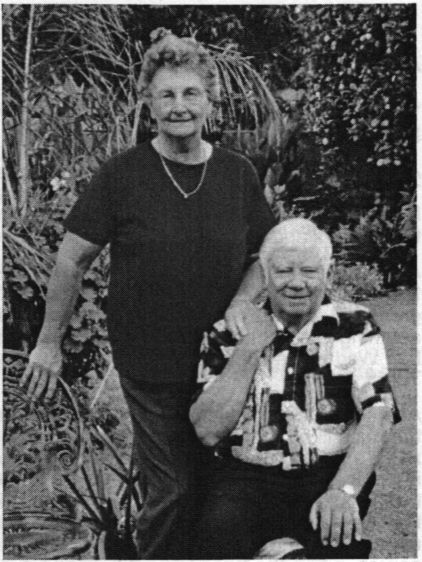
Alan and Betsy Ribbons
Shepparton, April 2000.
While working for Dalgety, Alan was sent to Nathalia. There, through the tennis club, he met Betsy May BURGESS (1926- ). They were married at Shepparton, Victoria on 7 June 1969.
Betsy was the daughter of a farming family at Bunbartha and prior to her marriage she worked in a women’s frock shop. Together Alan and Betsy set up a menswear store in Shepparton and ran this for some years. After selling the shop, they bought a small farm near Shepparton and Alan bred Palomino horses. Alan continues to breed and train horses, specializing in those used in horse drawn vehicles. He sometimes drives these vehicles for weddings and other events. Alan’s has numerous show trophies for his horses and Betsy has trophies as a tennis player.
Another sideline for Alan is training dogs and he and Jolly the dog often performed at charity functions. Both Alan and Betsy enjoy performing and are involved in local concerts and festivities. Alan plays the organ at his church. Beside the front door of their house in Shepparton is a sign announcing This is an alcohol free zone’, the result of Alan’s childhood experiences with a drunken paternal grandfather.
page 153
Clive Robertson CROUCH (1940-)
Second child and only son of Willie Crouch and Bessie Le Couteur, born at Hopetoun, Victoria on 22 November 1940.
From an early age Clive had an abiding interest in natural history and dreamed of becoming a biologist. However at fourteen, Clive left school and began an apprenticeship in joinery and cabinet making, at Kaniva where his family lived. He had been working at this trade for thirteen years when the local high school principal suggested he apply for a teaching position. He did this and was appointed to the Nhill High School to teach woodwork and graphic communication.
In 1964 Clive started studying the Silky Desert Mouse, a small native rodent found in the Little Desert near Kaniva. Hearing about his research, the Professor of Zoology at Monash University contacted Clive. This resulted in a twelve-year association with the Zoology Department at Monash, which allowed Clive to participate in various research projects.
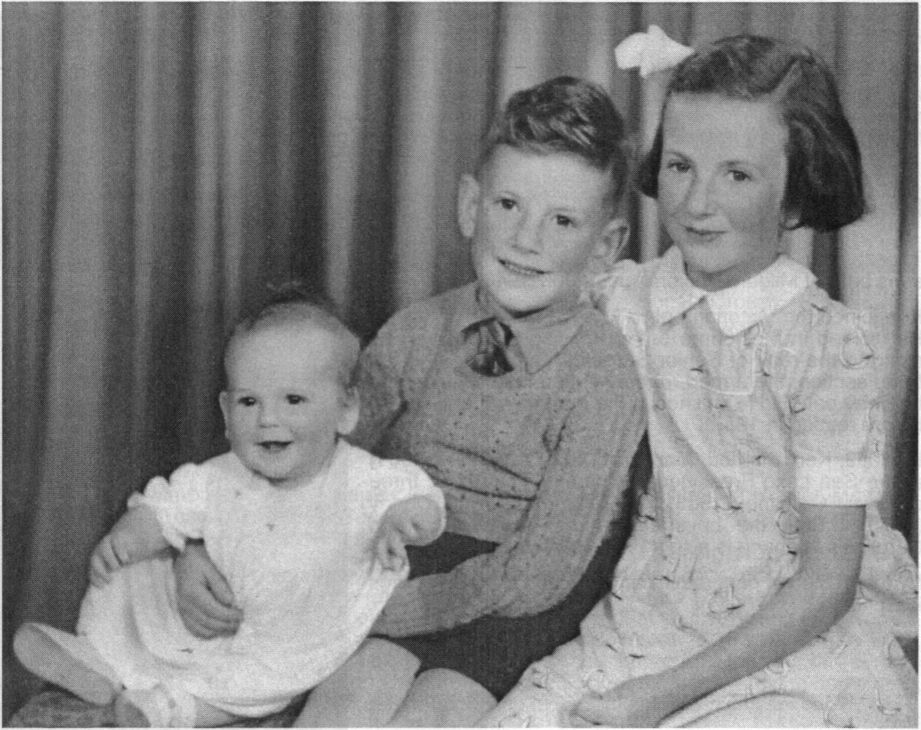
Lorraine, Clive and Beth Crouch, circa 1946
In Nhill, Clive met Janette ARNOLD (1948- ) who was the manager of the fashion section in a local department store. Clive and Janette were married in January 1972. They have three children, Damien (1973), Benjamin (1976) and Meagan (1977).
In 1976 the family moved to Melbourne so Clive could attend the Hawthorn Institute of Education, and after two years study he graduated with a Trained Trade Instructor’s Certificate, a dual qualification which entitled him to teach in both Technical and High Schools. At the graduation ceremony Clive had the job of responding on behalf of the students. Returning to Nhill, Clive again taught at the High School. He served on the Lowan Shire Council for three years (now part of the Hindmarsh Shire).
Clive realized that if he wanted to gain promotion he needed a university degree. He enrolled at the University of New England as an external student and as he had always wanted to study biology he majored in Biology and Geography, with sub-majors in Environmental Studies and
page 154
Prehistoric Archaeology (Aboriginal pre-history). After graduating he was promoted to a Senior Teacher position and two years later to Deputy Principal, before opting for ‘promotion in the classroom’. Clive writes, “I got sick of working 70-80 hours a week and having no time for my family, or to pursue my hobbies and interests, but it was a great experience and I gained a lot from having filled that position. Having such a diverse background and such diverse training I am now able to teach Science, Biology, Geography, Environmental Studies, Woodwork, Metalwork Graphic Communication and Technology. It really suits me to teach a variety of subjects and to teach at all levels in the school. After 34 years I still enjoy teaching, but I suppose one day I will have to think about retiring.” 45
For some years Jan worked as a hatchery attendant at Luv-a-Duck [Clive tells me it is the biggest duck processing business in the southern hemisphere]. She resigned from this job when she was diagnosed with breast cancer needing radical surgery and chemotherapy treatment. Fortunately the treatment was successful and Janette is working again on a part time basis at a local motel.
Clive did retire from teaching and this gives him more time to indulge his interest in natural history, native fauna and the environment. He has served on various committees including the National Parks Advisory Committee, the Board of Greening Australia, as secretary of the local committee of Management of Trust for Nature, and as secretary of the West Wimmera Tree Group Inc. He has been responsible for obtaining grants of over $300,000 for projects sponsored by the groups he has worked with.
Clive writes, “Although my father often lamented the fact that he was not able to do much for me, because of his injuries and poor health (and lack of money being an invalid pensioner), he nevertheless instilled in me a lot of important qualities, such as giving back to the community, having concern for others and to make the most of every opportunity.” 46
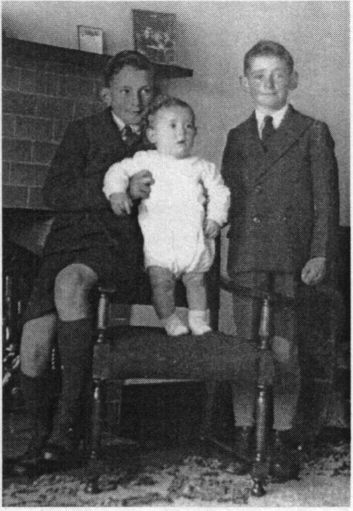
Lindley, Richard and Kenneth Crouch, circa 1948
Kenneth Frederick CROUCH (1940-)
The second of Eddie Crouch and Adah Finger’s three sons born at Mildura, Victoria on 19 July 1940.
Ken joined the Victorian police force at the age of twenty. He worked in Melbourne before moving to Bendigo and rising to the rank of Senior Sergeant. He worked in the fraud section, the armed robbery squad, surveillance and highway patrol. He finished in the drug squad at Bendigo before retiring in 1997.
In 1962 Ken married Margaret McLEAN (1942-2001) at the Sea Lake Presbyterian Church. They have three children, Caroline (1963), Andrew (1965) and Danny (1970). Both the boys are in the police force and Caroline’s husband is also a police officer.
Margaret died of pancreatic cancer in 2001. Ken still lives in Bendigo.
page 155
Donald Morris CROUCH (1932-1977)
Only child of Norman Crouch and Myrtle Selby, born at Werrimull on 2 December 1932. 47
Don shared a love of horses with his cousin Alan Ribbons and the two were friends. There is a photo of them both on horses taken in the 1930s. The pony Donald is riding was breed by Arthur McCue at Port Campbell.
Don worked as a dam sinker, still using a team of horses in the 1950s. Later he was a baker at Speed. Moving with his mother to Irymple after his father’s death in 1968, Don trained and raced trotters and was successful with a horse called Yankee Look.
Believing he had a brain tumour, Don shot himself in 1977. He was unmarried and had no issue.
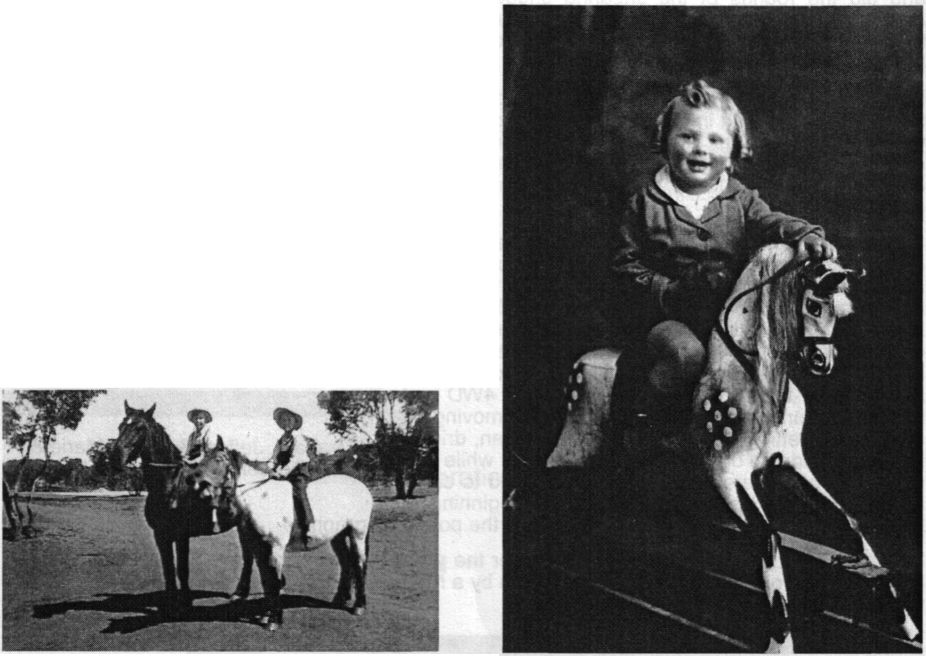
Alan Ribbons and Donald Crouch on horses bred by Arthur McCue at Port Campbell. ... Donald Crouch
David John MOTT (1939-)
David and his twin brother Jeffrey James were the second eldest children of Russell Mott and Vivienne Howe. They were born at Sea Lake on 4 November 1939.
As young as six and seven Russell and Vivienne’s boys started helping on the family farm at Gama East. The three eldest boys drove the bulldog tractor as a joint effort, one of them steering, another working the pedals, and the third changing the gears. By the time they were eight and nine they were taking truckloads of wheat into the depot at Gama, driving in unison as they did with the tractor. It took all three of them to lift a bag of wheat. One time as they were driving along the door of the truck fell off. The boys deposited the door at the side of the road and on the way home they picked it up and threw it in the back of the truck. Arriving home their father’s comment was ‘I’d better put the door back, one of you little blokes might fall out.’ 48
David was always in trouble at school and often played truant. At first he and his brothers drove the three miles to school in the family gig, but one day the horse bolted and the gig was overturned and smashed. After that the children walked to school. On the way they would do the rounds of the rabbit traps and as a result they were nearly always late for school. David did not get on with the minister who conducted the religious instruction classes. The minister had a wobbly eye and one day he caught David mimicking him. David was stood in the corner. David left school the day he turned fourteen.
page 156
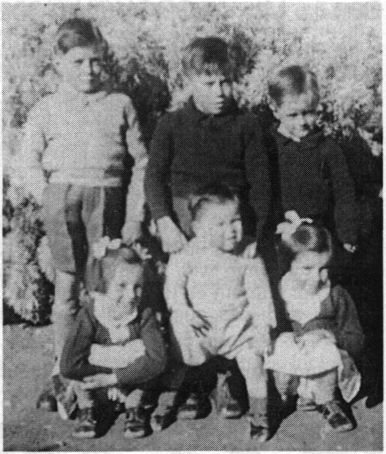
Graham, Jeffrey & David, Marie and Doreen and Bruce Mott
After leaving school David worked on the family farm and did the rounds of the shearing sheds. David, Jeffrey and Graham formed a partnership and bought their own farm, which they ran for twenty-one years as Mott Brothers.
David met Alice Joy LEECH (1946-) at a dance and the two were married in December 1963. Joy’s father was a scrap merchant, which David’s dad thought was a very useful occupation. David and Joy have three daughters, Debbie (1965), Kerrie (1966) and Narelle (1971).
In 1978 the Mott Brothers broke up their partnership, each taking three blocks of their joint property. In about 1980 David invented and patented a ‘knock on blade’ for a blade plough. Ten years later David sold his farm and went to Queensland where he bought a grazing property and leased a service station at Yuleba near Roma. After two years David and Joy decided to move on, so they bought a caravan and a 4WD and travelled around Australia. David has been moving on ever since, getting work as and where he can driving heavy equipment or caretaking properties while the managers or owners take leave. I managed to catch up with him in Western Australia at the beginning of 2003, just in time to get his story included in the potted biographies.
David admits to being accident-prone. Over the years he has had snake bite, road accidents, lost the top off one of his fingers, been bitten by a red back spider and most recently an accident with a horse which damaged his shoulder.
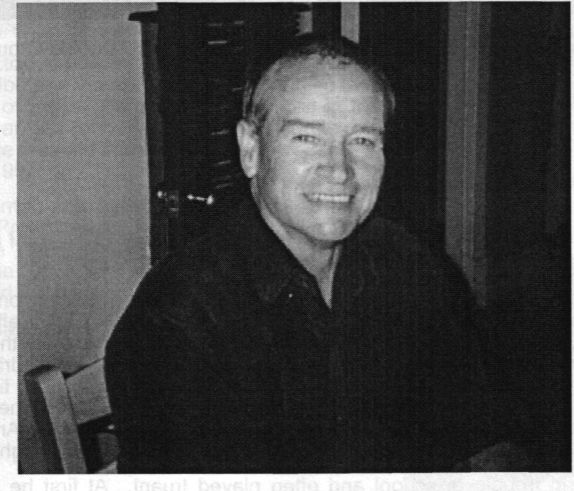
David Mott, Perth January 2003
1 Taped interview with Alan Ribbons, April 2000
2 Letter from Alan Ribbons, March 2001
3 I taped Alan reciting this poem during the April 2000 visit
4 Bessie Crouch wrote about her life and this material was supplied to me by her son Clive
5 Information about Arthur and Florence provided by their daughter, Barbara Lies
6 The equivalent of the Church of Christ in Australia is known as the Christian Church in the USA. Barbara Lies suggested I use Church of Christ in the text, to save confusion for Australian readers.
7 Email from Barbara Lies, 16.11.2000
8 Letter from Alan Ribbons, August 2000
9 Interview with Alan Ribbons, April 2000
10 Letter from Betty Powell, March 2001
11 Ibid
12 Bessie Crouch writing about her life
13 Taped interview with A Ribbons, April 2000
14 See Appendix 3
15 Bessie Crouch
16 Interview with Clive Crouch, April 2000
17 Information about Eddie and his family was provided by Ken Crouch in an interview April 2000 and letters. The quotes are taken from Ken’s letters.
18 Ada spelt her name Adah, until she discovered it had no h' on her birth certificate.
19 Bessie’s notes supplied by Clive Crouch
20 Interview Barbara Rogers, Portland, April 2000
21 Interview with A. Ribbons, April 2000
22 Interview with K. Crouch, April 2000
23 These stories come from a joint interview with Heather Richards, Dot Geary and Margaret Powell, April 2000
24 Interview with David Mott, 13.1 2003
25 Letter from Sue Boyd, 16.7.2000
26 Information about Russell obtained during an interview with Debbie Riley, 3.1.2003
27 Information about Marjorie’s life comes from letters, telephone conversations and an interview in March 2000
28 See Appendix 2 for notes on the relationship between McCue and Le Couteur families
29 Information about John and Janet McCue comes from his children Jeff McCue and Helen Krigsman, John's two sisters, his RAAF service record and the tribute presented by the Rev Frank Wakeling at John’s funeral.
30 John McCue’s Service record, a copy of which is in my possession
31 The Crofts are related to the Robertsons through both the Mathieson family and through the marriage of Margaret Robertson Chiselett’s daughters.
32 RAAF records
33 RAAF records
34 Funeral tribute
35 J. Fletcher, And We Who Followed - a History of the Fleytesbury Shire 1921- 1987’, p.271. There are a number of references to John McCue’s Council work in Fletcher's book.
36 Interview with Jeff McCue, April 2000
37 Letter from Helen Krigsman, 9.2.2001
38 The following information compiled from correspondence and telephone conversations with Marion Parker and the Eulogy presented at Bill Parker’s funeral in January 2001.
39 Marion Parker, 18.6. 2001
40 Bill Parker’s Eulogy, written by John Parker
41 Information about Barbara and Martin Lies provided by Barbara in letters, September-November 2000
42 The name Lies is of German origin and is pronounced Lease’
43 Interview with Barbara Rogers, April 2000
44 Interview with Alan Ribbons, April 2000
45 Letter from Clive Crouch, 26.3.2001
46 Ibid
47 Information about Donald comes from Alan Ribbons
48 Interview with David Mott, 13.1 2003
page 157
This is the most widely dispersed section of the family with individuals moving interstate from Victoria to other States at an early stage. Contact with some family members was lost and I had quite a job tracing some of them. Unless one of the unlocated children of Abbott Robertson is still alive, Margaret Haine is the only surviving great grandchild of Arthur Robertson and Margaret Henderson in this section of the family.
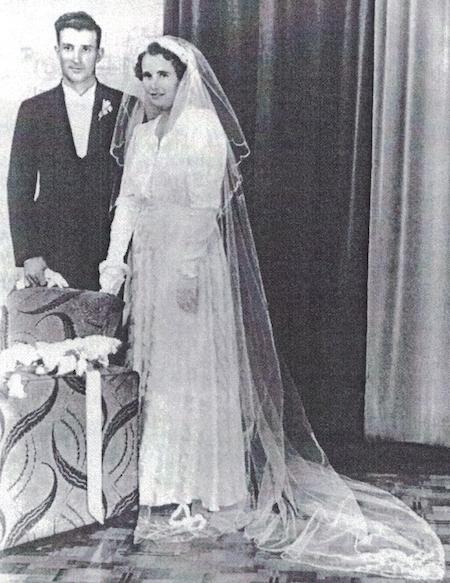
Generation D
OLlVE IVY ROBERTSON (1916-1984) - married name STRICKLAND
Eldest child and only daughter of Frederick Robertson and Edith Taylor born at Mt Magnet, WA on 18 March 1916. Known by her second name, Ivy married Harry STRICKLAND in 1940 at Geraldton. Harry worked with Ivy’s father at Mt Magnet and this is presumably how the couple met. They have five sons, Peter (1942), Bob (1944), John (1948), lan (1954) and Keith (1957).
Ivy died in 1984 and Harry in 1989, both from cancer.
Harry Strickland and lvy Robertson on their wedding day, 28 December 1940
Strickland boys, 1958. Back: Robert, Peter, front: Henry, Keith and Ian.
HENRY MACNEIL SAUNDERS (1904-1978)
Eldest child of Frances Robertson and Henry Saunders, born at Boort on 23 April 1904. Known as Neil.
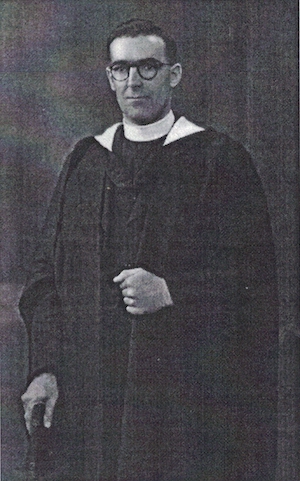 Henry McNeil Saunders
Henry McNeil Saunders
Neil’s primary education was obtained at state schools in Brisbane. He went on to Brisbane Boy’s College where he studied Greek. The family moved to Bendigo in the late 1920s and Neil attended the Teachers Training College there. He resigned before being given a teaching appointment. He felt called to the ministry and trained as a Presbyterian minister, studying Hebrew and obtaining an MA from the University of Queensland.
During the Second World War he served as an army chaplain, and while he was in Townsville he saw the Japanese observation planes flying over the town. In 1944 Neil married Nan DEMPSTER (1912-1996) in Brisbane. They have four children, Elaine (1944), Kirstin (1947), John (1949) and (Gillian (1952). The three youngest children were born at Armidale, NSW, where Neil served as minister at St Paul's Presbyterian church.
After leaving Armidale, Neil was called to the Northbridge Presbyterian Church in Sydney. He was President of the Council of Churches for one term. His last pastorate was at The Entrance on the NSW central coast. For their retirement he and Nan bought a house at Charmhaven. Neil died at the Gosford hospital in May 1978.
FRANCES RUTH ROBERTSON SAUNDERS (1906-1974)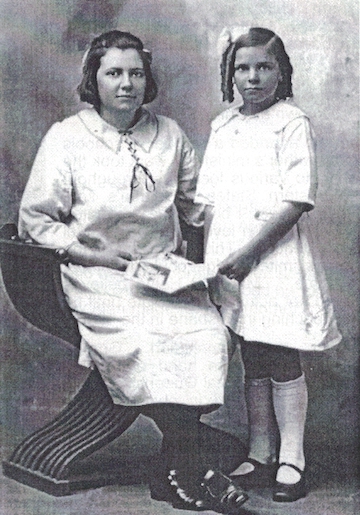
Second child and eldest daughter of Frances Robertson and Henry Saunders, born at Alexandra, Victoria on 14 December 1906. As a teenager Francis liked to be called by her given name but later her brother-in-law, David Lawson, gave her the name Fassie.
Frances Ruth Robertson Saunders with her sister Margaret
Frances trained as a teacher at the Teachers Training College in Bendigo and on completion of her training was appointed to the relieving staff of the Victorian Education Department. She taught at schools in Gippsland, the Mallee and the Western District, and at Maffra and Bendigo (Golden Square).
When the family moved to Brisbane in February 1930, Frances gave up teaching and trained as a nursing sister. She continued in this profession until she went to New Guinea as a missionary. There she worked at an American mission near Mt Hagen. Her health failed and she returned to Brisbane after eighteen months or two years and resumed nursing until her retirement.
Frances was unmarried. She died in Brisbane from leukaemia, at the age of sixty-eight.
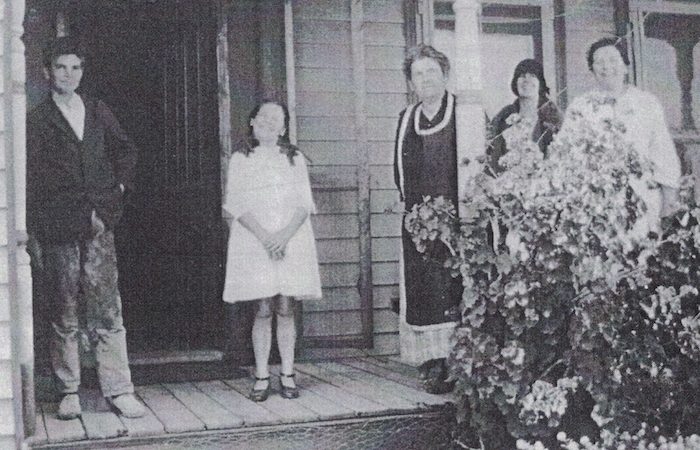
Saunders family at the Rainbow Baptist Manse, circa 1925. Left to right: Gordon, Margaret, Frances Snr, Margaret Robertson (William Adie’s daughter), Frances Jnr.
JAMES GORDON SAUNDERS (1912-1992)
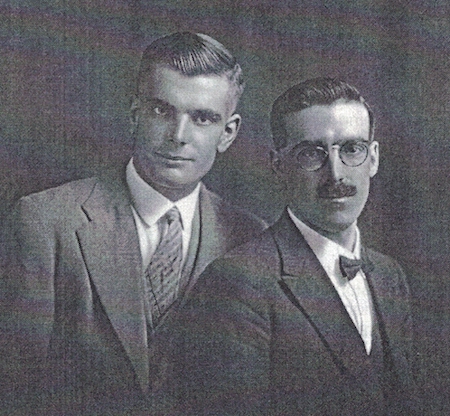 Fourth child and second son of Frances Robertson and Henry Saunders, born at Latrobe, Tasmania on 31 March 1912. He was known as Gordon. He was named after Charles George Gordon of Khartoum who was also known as Chinese Gordon. [Margaret Haine is the source of information about the names of her brothers Gordon, Alan and Douglas. Information about Gordon’s life comes from Margaret Haine and Gordon’s son Bruce Saunders.]
Fourth child and second son of Frances Robertson and Henry Saunders, born at Latrobe, Tasmania on 31 March 1912. He was known as Gordon. He was named after Charles George Gordon of Khartoum who was also known as Chinese Gordon. [Margaret Haine is the source of information about the names of her brothers Gordon, Alan and Douglas. Information about Gordon’s life comes from Margaret Haine and Gordon’s son Bruce Saunders.]
Gordon Saunders with his older brother Neil
Gordon attended a number of schools as his father’s ministerial work took the family to various locations throughout the eastern States. Gordon’s son, Bruce, writes: “l believe he graduated at matriculation level at a high school in the Bendigo. This was as far as the family’s limited budget could get him at this time.” [Email from Bruce Saunders, 24.6.1999] Margaret Haine believes he did not actually matriculate until he was teaching in Brisbane in the 1930s.
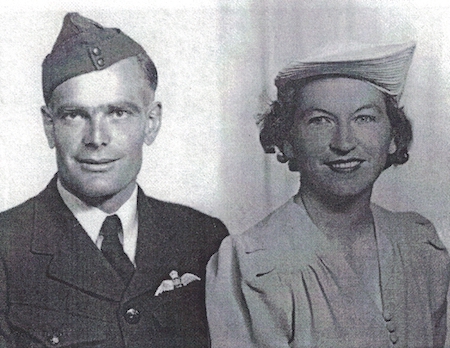 During the Depression, Gordon worked as a farm hand on station properties in Central Queensland. He was also involved in share farming with his brother, Alan, at Tamrookum in the 1930s. At some of the properties he worked as a tutor with the children living there and this is presumably what led him into a teaching career. He obtained a teaching position at the Church of England Boys Grammar School (‘Churchie’) in Brisbane.
During the Depression, Gordon worked as a farm hand on station properties in Central Queensland. He was also involved in share farming with his brother, Alan, at Tamrookum in the 1930s. At some of the properties he worked as a tutor with the children living there and this is presumably what led him into a teaching career. He obtained a teaching position at the Church of England Boys Grammar School (‘Churchie’) in Brisbane.
Gordon Saunders and Sue Gelfius, 1943
When war came Gordon joined the RAAF and served as a Pilot instructor. Gordon writes, “I do not know when he joined up exactly but l do know that he did not serve overseas due to his instructor’s role. Apparently most of the pilot training bases were scattered through central and southern NSW and northern Victoria and it was during this time that he met and married my mother.“ [Email from Bruce Saunders, 24.6.1999]
Bruce continues, “After the war he resumed working at ‘Churchie’ and was instrumental in helping to set up their Army Cadet Corps. He attained the rank of Major while serving the Corps. He was extremely proud of his role here and often used to talk about it. Some time later he rejoined the RAAF and served as an Education Officer holding the rank of Flight Lieutenant, for many years working at air bases in NSW (Rathmines on Lake Macquarie) and then in Melbourne and surrounding suburbs. He left the RAAF I think somewhere between the age 45 and 50 years (due to his age) holding the rank of Squadron Leader. He then became a student counsellor at the Royal Melbourne Institute of Technology, a post he held until he retired.”
Gordon married Sue GELFIUS (1913- ) in 1943 at Narromine in NSW. Sue came from a farming family and was the youngest of seven children. She used to raise turkeys on her family’s farm ‘Hopevale’ at Narromine. Gordon and Sue have three children, Bruce (1944), Reg (1948) and Jenny (1949).
Gordon died in the Repatriation Hospital at Heidelberg in Victoria in 1992. Sue lives in Melbourne.
ALAN THOMAS SAUNDERS (1914-1991)
Third son and fifth child of Frances Robertson and Henry Saunders, born at Sheffield, Tasmania on 28 March 1914. Like two of his brothers, Alan was named after a British Army officer, this time it was Field Marshal Edmund Henry Allenby.
His sister Margaret tells us Alan ‘was very good looking and had keen brain power, helped by a good memory’. He attended the Technical College in Bendigo where he developed his skill as a wood worker. Margaret has a delicate oval wooden pin tray Alan made for their mother.
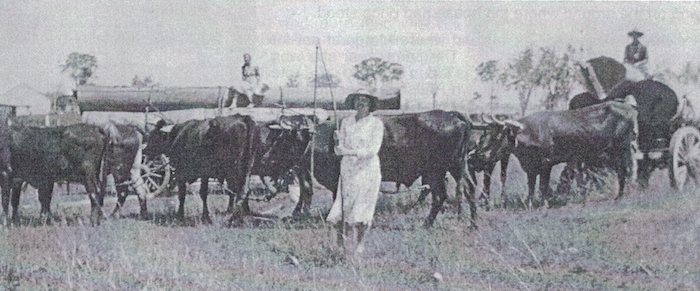
Margaret Florence Saunders with bullock team hauling timber Margaret was on holiday near Beaudesert, Qld, where her brother Alan was share farming in the 1930s
When the family moved back to Brisbane at the beginning of 1930, Alan was unable to get work because of the Depression. Much to his mother’s distress he had to leave home at the age of sixteen to look for work. Eventually he found work on cattle stations in Central Queensland and became an overseer on at least two of these properties. At one stage he was involved in share farming with his brother Gordon at Tamrookum.
During World War ll, Alan served in the RAAF as ground crew (aircraft engine fitter) with the rank of Corporal. He was posted to Bougainville in New Guinea.
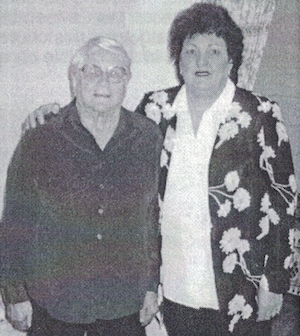
Margaret Colledge Saunders and her daughter Ruth Wroe, May 2000
On 9 November 1943 Alan married Margaret Alison COLLEDGE (1913- ) at Rockhampton. Margaret was a nursing sister. They have three children, Alan Jnr (1946), Helen and Ruth (1952). Alan and Margaret bought a house in Comet where their children were able to attend school for the first time. Previously their schooling had been by correspondence, with their mother as supervisor.
Alan experienced a number of bad accidents in connection with his work and spent periods in hospital recovering. After the children had grown up and left home, Alan and Margaret moved to Rockhampton. Alan died there in 1991 and was given a returned serviceman’s funeral. Margaret still lives at Rockhampton.
MARGARET FLORENCE ELLERSLIE SAUNDERS (1915- ) - married name HAINE
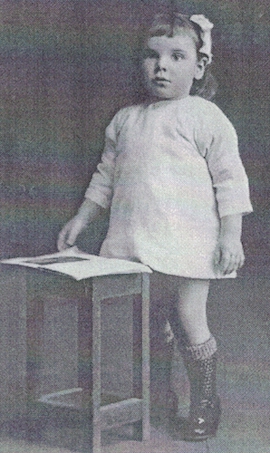 Sixth child and youngest daughter of Frances Robertson and Henry Saunders, born at the Albion Baptist manse on 21 December 1915.
Sixth child and youngest daughter of Frances Robertson and Henry Saunders, born at the Albion Baptist manse on 21 December 1915.
Margaret Saunders at about 2 years of age
ln October 1925 while in 4th grade at Rainbow, Margaret won first prize in an essay competition at the local show, for a story about Dobbin the horse. Margaret modestly says her father coached her. While living at Rainbow, Margaret visited her Mott relations. She also remembers going to school at Port Campbell when the family stayed there in 1926. She would walk to school past the site of ‘the old stone house’ and there were still piles of stones lying on the ground where the house had once stood.
Margaret Saunders at 17 years of age

The family moved to Queensland where Margaret sat for her scholarship exam in 1930. The same year she won two essay competitions. One was for an essay to celebrate the opening of the Brisbane Town Hall, the other from the Dickens Fellowship. She also won a Shell bursary for an essay describing the Shell Company works in Brisbane. With the benefit of the bursary, a State scholarship and a reduction in fees because of her father’s occupation, Margaret was able to attend Sommerville House for her secondary education. The school supplied textbooks and stationary for a cost of £1/10/- per term and the reduced fee amounted to £1/15/- per term. Margaret was dux of the school in 1934. She went on to train as a teacher of the deaf, working at the School for the Deaf in Brisbane.
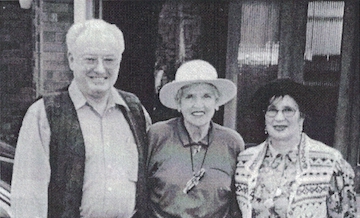 In 1949 Margaret married Hector HAINE (1911-1992) at the Baptist Tabernacle in Brisbane. They had no children. Hector was a schoolteacher, a lecturer at the Teachers College and finally head of the education section. He wrote “Classroom Psychology" and several other textbooks. Hector’s parents came to Australia from Sweden and Hector was a member of the Swedenborgian Church. Margaret joined this church. Margaret and Hector visited Shetland in 1978 while on a visit to Europe.
In 1949 Margaret married Hector HAINE (1911-1992) at the Baptist Tabernacle in Brisbane. They had no children. Hector was a schoolteacher, a lecturer at the Teachers College and finally head of the education section. He wrote “Classroom Psychology" and several other textbooks. Hector’s parents came to Australia from Sweden and Hector was a member of the Swedenborgian Church. Margaret joined this church. Margaret and Hector visited Shetland in 1978 while on a visit to Europe.
Margaret Saunders Haine, 2000, with her niece Kirstin Gillam and Kirstin’s husband John
Like so many of her relations Margaret plays the piano. One of her hobbies is making hats, which she does with great skill and fine stitch work. She also makes artificial flowers, and her other hobbies include cake icing and cane basketwork. She disliked moving about as a child and has lived in the same house in Annerley since 1951.
DOUGLAS DAVIS SAUNDERS (1918-1964)
Youngest child of Frances Robertson and Henry Saunders born at Enoggera, Queensland on 28 April 1918. Douglas was given the name of World War I British Army officer Field Marshal Douglas Haig. [Interview with Margaret Haine]
Douglas had Down syndrome and as an adult received an invalid pension. He died at the age of forty-six, a resident at ‘Walston Park’ in Brisbane. He was unmarried.
ADIE CHRISTINA ROBERTSON (1907-1999) - married name REUDAVEY
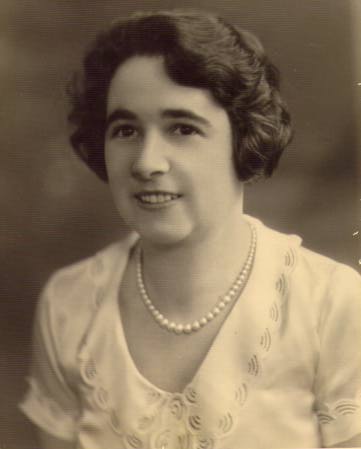 The eldest child of James Need Robertson and Christina Bennett, born at Ballarat, Victoria on 9 September 1907.
The eldest child of James Need Robertson and Christina Bennett, born at Ballarat, Victoria on 9 September 1907.
Adie Robertson Reudavey
At the age of fourteen, Adie started work as a machinist in the soft furnishing department of Ahern’s Emporium in Perth and one of her tasks involved making curtains for the Capitol Theatre. “During the Depression Adie was the only one of the household to have a job, so her pay kept the family afloat.” [From the eulogy presented at Adie’s funeral service in 1999.]
In 1934 Adie married Frances (Frank) REUDAVEY (1904-1995) at the Trinity Congregational Church in Perth. They have three children, Phillis (1935), Rod (1938) and Thia (1944). After their marriage Adie and Frank lived on a farm at Jibberding in WA. There, Adie was a foundation member of the local branch of the Country Women’s Association, an organization she belonged to for over sixty years. She was involved in Congregational and Uniting Church activities, the Dalwallinu Hospital Auxiliary, and served as President of the Senior Citizens Association. She was made a life member of the last two organizations. Adie was actively interested in handicrafts, demonstrating as well as being a judge on the show circuit, including the Royal Perth Show. Phillis remembers, “Mum made stools out of Sunshine milk tins. Covered the tins with material, sewed them together and covered all - very strong and a good height. Mum and Gran both only 5ft so that's why there were always stools at 98 [Eighth Ave] and on the farm. I have some of them!" [Adie‘s story is compiled from correspondence with Phillis Dolling. Unless otherwise stated the quotes are taken from Phillis’ letters.] Adie neither drank nor smoked and lived into her ninety-second year. Two of her sayings quoted in her eulogy were: “Don’t worry about things you can’t change” and “Being short never stopped me doing anything.”
The Reudavey family name was originally Davey. When Frank's father, Henry Richard Davey worked as a gardener at the Queen’s Gardens in Perth (before becoming a farmer), there were others with the name Davey and this caused confusion when mail arrived from England. So Henry called himself Rewell-Davey, Rewell being his mother‘s maiden name. Somehow the name was contracted to Reudavey and that's the way it has stayed.
The Reudavey family were pioneers in the Jibberding district, which is twelve miles east of Wubin in the Shire of Dalwallinu. Phillis tells us “the Jibberding district was named after the Jibberding sheep station - east of the rabbit proof fence - and Dad’s block (Limberlost) adjoined the station. Now it is cropped, but in those days was a pastoral property, and everyone took their sheep to the shearing shed to be shorn. I can remember helping Dad move the sheep from Limberlost (around the edge of the lake) to Jibberding Station."

Robertson family group, Perth circa 1948. Left to right, back row: Dave and Mollie Gillard, Gert and Norman Robertson. Centre row: Adie Reudavey, James Need and Christina Roberston, Frank Reudavey. Front row: Graeme Robertson, Thia Reudavey, Garry Gillard, Rod and Phillis Reudavey.
Frank Reudavey was the eldest of nine children. At the time of writing the original farm is still being run by Frank’s youngest brother, Jack Reudavey, and Jack’s son, Trevor. Frank and Adie’s son, Rod Reudavey and his wife Judith, now run ‘Limberlost’ and with the help of their son Peter.
Adie and Frank’s first house at Jibberding was made from wheat and super bags and they lived in this while their mud brick house was built. This second house was called "Limberlost” because Adie associated it with the mud brick house in the novel ‘The Girl of the Limberlost’. Later on Limberlost incorporated an adjourning property called ‘Golden Valley’ because of the golden wattle trees that bloomed near the weatherboard house. The family moved into the house of four bedrooms, front verandah and bathroom, in 1944 or 1945. This house was on the main road (the Great Northern Highway) and Phillis and Rod could ride their bikes to school in Jibberding. The mail run to Payne’s Find passed the gate, so mail and groceries were delivered each week. However to use a phone meant going to Nanna Reudavey’s about 4 miles away. Nanna Reudavey was the Post Mistress and ran the exchange for thirty-three years. She was awarded a British Empire Medal (BEM).
The Golden Valley house was also closer to Wubin where Thia attended school, the Jibberding School having closed by that time because of fluctuation in the number of children attending. lt was not until 1963 that Adie and Frank moved into a house that had a telephone, running water, a sink in the kitchen, hot water from the Metters No 2 stove and a septic toilet. This house was built just inside the boundary between Golden Valley and Limberlost but at the opposite end of the farm to the original house. Phillis writes, “lt was too stony for much of a garden but lots of pot plants - indoors and outside. A flower box around the front wall of the patio, that Rod still puts in petunias etc, for a splash of colour."
ln 1993 Adie developed shingles and after her stay in Dalwallinu hospital she and Frank moved into ‘Pioneer House’ in Dalwallinu. This made it very easy for family and friends to visit them and they received good care from the devoted staff. Phillis tells us, “it was a happy time for them both". Frank died in 1995, Adie in 1999.
Thia Reudavey Wright with Rod and Judith Reudavey, Perth 2000
JAMES NORMAN ROBERTSON (1909-1983)
Second child and only son of James Need Robertson and Christina Bennett born at Claremont, WA on 8 August 1909. Known as Norm.
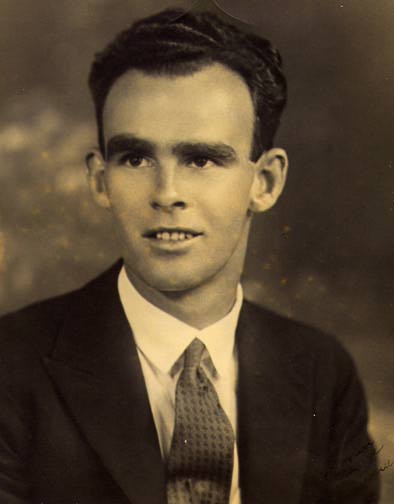
James Norman Robertson
His son, Graeme, writes about Norman, “Dad was a very heavy smoker and I recall when I was a child marvelling at the nicotine stained fingers and moustache, remembering every morning as soon as he got out of bed almost coughing himself to death. But he would settle down with the rollin’s before breakfast. He certainly paid the price.” [Letter from Graeme Robertson, 10.12.1998] Norm died a lingering death from emphysema, at the Hollywood Repatriation Hospital, Perth. Norm also drank heavily after he came back from World War II, putting a considerable strain on his family. He was charged several times for drink driving, and his driving licence was eventually taken away for life.
Norm married Gertrude MURDOCH (1913-1974). Gertrude was the youngest child of James Harding Murdoch and Gertrude Hoare of Portsmouth England. There were three children in the family, Kenneth, Constance and Gertrude Jnr. After the First World War, James Murdoc left his family in England and went to America. In 1919 Gertrude Snr brought her three children to Western Australia at the suggestion of her sister Constance. Constance and her husband Harry lived on a struggling farm near Babbicon on the edge of the WA wheat belt. Gertrude and the two older children worked on the farm as labourers, finding it a hard life. Gertrude Jnr however was less aware of the hardships, being too young to work in the paddocks. She had happy memories of horse riding into Babbicon to pick up the mail, etc.
The farm did not prosper and Uncle Harry committed suicide. The two women brought the children to Perth where they ran a boarding house. Constance returned to England to look after her brother Horace, and the third sister, Winifred, who was unmarried, came out to Australia to help Gertrude run the boarding house. Gertrude Jnr became an expert seamstress and dressmaker.
When World War II started Norm, who was just turning thirty, put his age down to ensure he would be accepted into the army. He served in the Middle East, New Guinea and Borneo. After the war Norm worked for H J Ingle in Perth, turning old army tanks and Bren gun carriers into bulldozers. These were in urgent demand for clearing virgin scrub to extend the West Australian wheat belt. Graeme tells us his father was a first rate metalworker and ‘a nice bloke when he wasn’t drinking’. [Interview with Graeme Robertson in lnnisfail, February 2001]
Both Norm and Gertrude smoked heavily and both died of smoking related diseases. “My mother died when she was only sixty three of a heart attack. She had a pain in the chest one day and told no one, and sat up all that night smoking and worrying about it." She died at the wheel of her car the next day, 2 August 1974, which was the day her husband was retiring from work. Norm lived for another nine years.
MARY LINDA ROBERTSON (1915-1988) - married name GILLARD
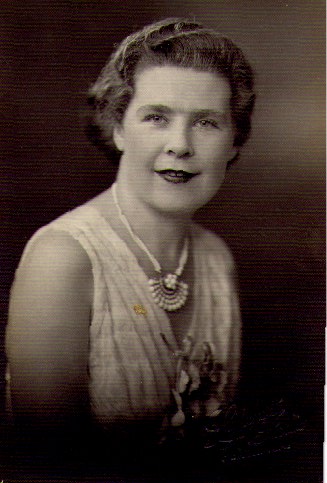 The youngest of James Need Robertson and Christina Bennett’s three children, born at Geelong, Victoria on 24 November 1915. Known as Linda as a girl and Mollie as an adult.
The youngest of James Need Robertson and Christina Bennett’s three children, born at Geelong, Victoria on 24 November 1915. Known as Linda as a girl and Mollie as an adult.
Mary Linda Robertson
Graeme Robertson describes his Aunt Mollie as ‘the lynch pin of the social fabric of that era of the family.“ [Letter from Graeme Robertson, 10.12.1998] After her marriage in 1938 to David GILLARD (1905-1982), Mollie refused to leave her mother and she and David lived with Christina in the house at Maylands. This household was a meeting place for all the family. Mollie and David’s only child Garry was born in 1943. The country cousins from Jibberding stayed with the Maylands family so they could attend school and work in Perth. Thia and Rod would marry Don Wright and Judith Coultas who went to school with Garry Gillard.
Mollie was a designer/dressmaker, working at different times for Rene Elser Modes in Ahern’s Arcade, and American Styles, Dressmakers of Distinction, McDonald Buildings at 146 Murray St, both in Perth. Later she worked for herself, her business card stating: “Mrs M. Gillard, Exclusive Dressmaker. Fittings in your home." [Quotes from G. Gillard are taken from a letter, 4.10.1999] Mollie had a little Morris Minor car, which was ‘her pride and joy’ and this was what enabled her to make home visits. Garry gives us a picture of his mother sitting at her industrial sewing machine (fast but no fancy attachments) in her ‘workroom’ which was the enclosed side verandah of his grandmother's house in Maylands. Other furniture in this long narrow room included a cutting table made from an old dining table raised on 15cm jarrah blocks; a flat ironing table, with two drawers, on which stood a sleeve board; a couch and a chair opposite Mollie for visitors.
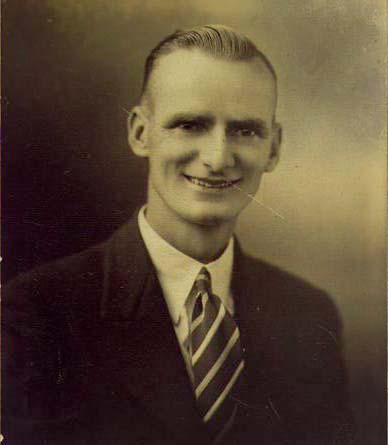 Garry still has the chair plus a second one from the house, made from woven cane by the ‘blind’. “lf a client wanted a dress like one in a magazine, Mum was able to draw the dress on paper, take her measurements, cut it and sew it.” She specialized in wedding outfits with dresses for the bride, the bridesmaids and their mothers. Phillis tells us that Grandma Christina did most of the hand sewing on dresses, gowns, coats etc. Her rouleau work and hemstitching were much sought after.
Garry still has the chair plus a second one from the house, made from woven cane by the ‘blind’. “lf a client wanted a dress like one in a magazine, Mum was able to draw the dress on paper, take her measurements, cut it and sew it.” She specialized in wedding outfits with dresses for the bride, the bridesmaids and their mothers. Phillis tells us that Grandma Christina did most of the hand sewing on dresses, gowns, coats etc. Her rouleau work and hemstitching were much sought after.
David Gillard
David Gillard had a variety of jobs over the years. Before he was married, Dave drove parlour cars between Perth and Fremantle. He was a munitions worker during the Second World War and later a lathe operator at Altona engineering works at Scarborough. While he was there he made a ring for his niece Phillis out of shilling. After leaving the engineering works Dave drove a taxi. Basically however he was a musician, playing double bass in the Symphony Orchestra and a Hawaiian ensemble on ABC radio, as well as in other groups. He also played the piano - not too proficiently according to his son. On the other hand Phillis tells us how much she enjoyed his piano playing. Dave worked as a piano tuner, and repaired old pianos for resale.
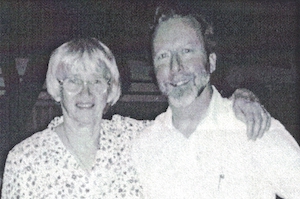 Phillis’ grandchildren are now playing on the piano Dave found and restored for her. Dave had a Holden van for carrying his tools and his double bass.
Phillis’ grandchildren are now playing on the piano Dave found and restored for her. Dave had a Holden van for carrying his tools and his double bass.
Garry Gillard with Margaret Worrall, Perth 2000
Dave gave up drinking in his forties because he was diagnosed with cirrhosis of the liver, but took it up again in his later years. Mollie and Dave were heavy smokers and both died of cancer, Dave in 1982 and Mollie six years later.
MIRIAM WlNlFRED LAWSON (1912-1998)
RUTH GWENDOLINE LAWSON (1915-1930)
GLADYS IRENE LAWSON (1919-1991) - married name MUNRO
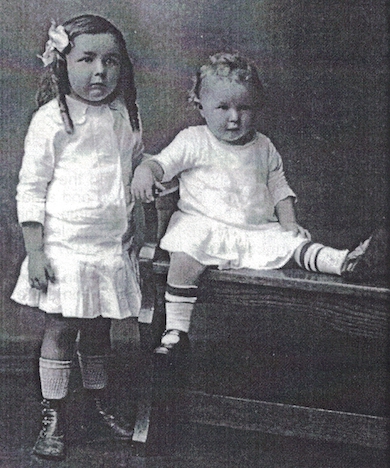
I have very little information about these three sisters who were the daughters of Miriam Robertson and David Lawson. They were all born, lived and died in Brisbane, Queensland.
Winnie and Gwen Lawson
Gwen, the middle child, was born on 16 February 1915. She died from rheumatic fever at the age of fifteen. This was the second bout of an illness she had had as a child. She is said to have been a gifted performer and had learnt elocution. Her rendition of ‘I’d never get a hidin’ with the Minister to tea’ was a family favourite.
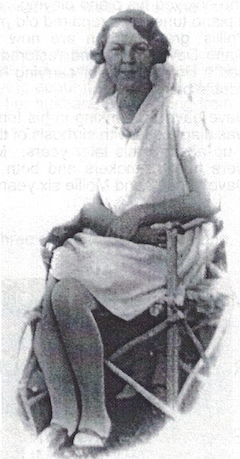
Gwen Lawson
Win and Irene were pianists. Win the eldest girl was born on 16 March 1912. She did not marry and worked for a time as a kindergarten teacher. Later she became a typist in a department store in Brisbane. She seems to have had an interest in keeping in touch with her relations and I have some Christmas cards she sent to her cousin Adie Robertson Reudavey in WA, and letters to other family members, which provided a starting point for some of the information contained in this family history. It therefore seems sad that I know so little about Win herself.
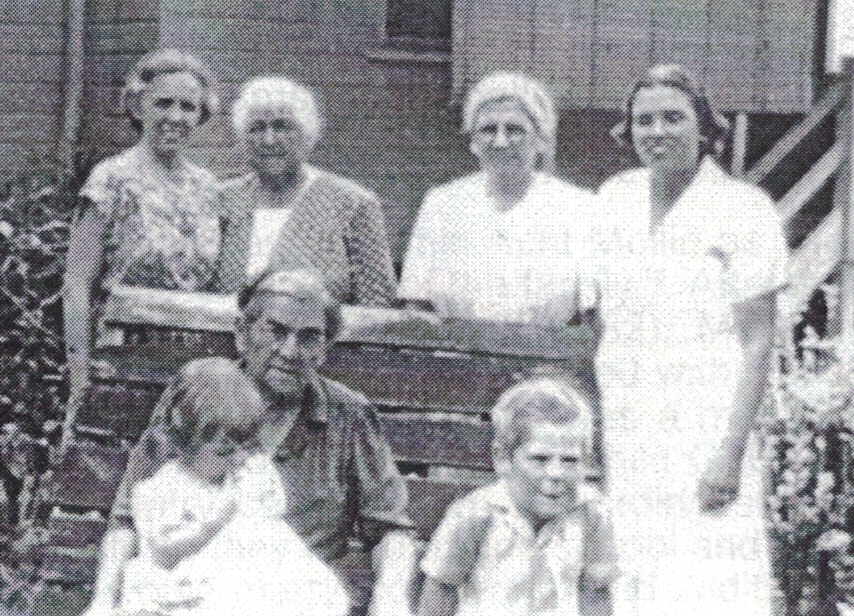
Lawson-Saunders Family Left to right, back row: Sue Saunders(?), Win Lawson, Frances Saunders Jnr, Margaret Haine. Seated: Grace Saunders Snr with Sue's children Jeanette and Reg.
Irene was born on 28 February 1919. She worked as a ladies hairdresser. ln 1947 she married John MUNRO at the Scots Presbyterian Church in Brisbane. John Munro was a garage proprietor. Their only child, born in 1950, is called David after his grandfather. David has kindly allowed me to copy some wonderful photos from his mother’s photo album. John Munro died in 1953, Irene in August 1991.
Generation E
GORDON BRUCE SAUNDERS (1944- )
Eldest son of James Gordon Saunders and Susan Gelfius, born at Temora, NSW on 10 November 1944. Known as Bruce.
Bruce left school at sixteen and joined the Victorian Country Roads Board in 1961 as a junior chainman, staying with them for three and a half years. The CRB job involved a lot travel and being away from home for weeks at a time. This did not suit Bruce after he met his future wife, Lorraine ANDERSON (1945-). The couple married 1964 and have four children, Kerri (1965), Julie (1967), Amber (1969) and Robert (1971).
Lorraine’s father worked at the Australian Paper Manufacturers’ Mill at Fairfield in Melbourne and he suggested Bruce try for a position there. The result was a thirty-five year career as a papermaker at Fairfield, starting on 28 July 1964 and finishing when Bruce accepted an early retirement package on 31 April 1999. He started as a packer on No. 5 Machine, and then moved to the No. 6 Machine in August 1967 as a winder assistant. For the next fifteen years he worked in various production roles on this machine, “In fact I don’t think there was any position I did not work in for a period of time.” [Information and quotes taken from a letter from B Saunders, 7.7.1999]
ln 1982 Bruce was appointed to staff and held various positions over the next thirteen years including Production Foreman, Shift Foreman, Waste Paper Plant Foreman, Assistant Production Superintendent and Production Superintendent. ln 1995 Bruce was asked to work as Production Manager on a new de-inking plant, which was to be built in the No. 5 Machine building - now empty as the old machine had been sold to a company in China. This new plant was to produce high quality bright white pulp from recycling and de-inking mixed office waste. “I worked in this role for four years helping to design the plant, choosing and buying the equipment, installing it, recruiting a crew for it, training them, starting the plant up and then ensuring that it ran efficiently, delivering high quality bright pulp suitable for use in all fine printing and writing grade papers as well as some for use in the tissue producing industry."
“In my time at Fairfield I was fortunate enough to be sent on two industry tours. The first in 1988 when I visited Paper Mills in Finland, Sweden, England, Scotland, Netherlands, France, Germany, Canada and America. The second in 1995 for training in the de-inking process and looking at various similar plants in Germany, England and America.”
PHILLIS CHRlSTINA REUDAVEY (1935- ) - married name DOLLING
Born 17 November 1935 at Dalwallinu in the north-eastern wheat belt of Western Australia, the eldest child of Adie Robertson and Frank Reudavey. [Interview with Phillis Dolling, 1998 and letters from Phillis Dolling. Quotes are sourced from letters.]
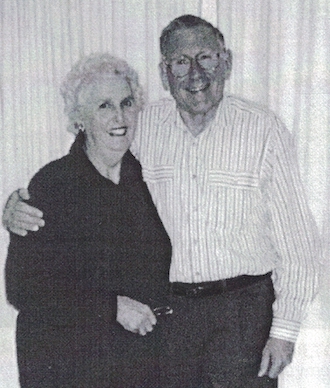
Phillis spent her early years on the family farm at Jibberding where the Congregational Church Hall was used for the school and all social occasions Phillis started school there in 1941. Dorothy Day, the daughter of one of the teachers, lived with the Reudaveys during the week and drove a horse and cart the five miles to the school. When the school closed because of fluctuating numbers, Phillis and her brother Rod were taught by their mother through correspondence
Phillis and John Dolling, Perth 2000
When she was ten, Phillis was sent to live with her maternal grandmother in Maylands, Perth to finish her primary schooling. She then went on to Perth Modern School for five years secondaiy school before training as a Junior Primary schoolteacher. She graduated in 1954. Rod was also sent to school in Perth, living with Norm and Gertrude Robertson but by 1954 he had returned home to work on the farm. Returning home for school holidays Phillis would sew her own ‘ballerina’ dresses and she and Rod would go off with friends to the local dances.
In 1957 Phillis married John Ainsley DOLLING (1935- ) at the North Perth Congregational Church. Phillis had attended this church in the years she lived at Maylands; it was a four-mile bike ride from her grandmother’s house. John was an ANZ bank officer. The couple lived at Derby, WA for two years, where they worshiped at the AIM Aboriginal Mowanjum Mission. On returning to Perth they lived at Floreat Park for twenty-one years, rearing and educating their four children, Christine (1958), Murray (1959), Neil (1962) and Linda (1964).
Phillis and John were both active in the Congregational Church and Youth Fellowship. Phillis was a Parish Councillor for ten years and involved in the Ladies Guild/Fellowship, Bible study groups and family camps. “We enjoyed the fellowship of young Christians so in Floreat Park we continued our Christian journey attending the Methodist Church which in 1977 became the Forum Uniting Church.”
Moving to Albany for three years, Phillis was an Elder at Scots Church, a Guild member and President of the Bible Society Women’s Auxiliary. "In 1982 I was a foundation member for the WA Synod Uniting Church Fellowship Committee and remained on that committee for ten years, then became the Corresponding Member for North West Presbytery as my husband was Pastor of the Port Hedland Uniting Church and Patrol Padre of the East Pilbara Patrol. (1991-1996, Frontier Services)”
In January 1997 the Dollings moved to the Wagin Parish. "Wagin is in the centre of the Great Southern sheep and wheat growing area with many sheep studs in the district and lots of canola. Wagin parish has five preaching places - Dumbleyung, Collanilling, Wagin, Darkan, Duranillin.” Phillis attended two Consultations as a WA delegate. She is the Ecumenical/International Liaison, keeping in touch with Asia/Pacific women's organizations, and was a representative at a Conference in Fiji in 1999. She writes, “I am looking forward to serving God in a new sphere on the Adult Fellowship National committee."
Phillis and John now live in Mandurah south of Perth.
GRAEME JAMES ROBERTSON (1937- )

Only child of James Norman Robertson and Gertrude Murdoch, born on 19 August 1937, at South Perth, WA.
Graeme and Heide Robertson, lnnisfail 2001
Graeme finished school at the age of fourteen and served a five-year apprenticeship as a carpenter and joiner. Three years later he completed his Master Builder Ticket. "I went from there into property development as a natural progression of events." [Letter from Graeme Robertson, 10.12.1998 ] In 1964 he was running tours through the north west of Western Australia and up to Darwin. This venture was successful and in 1967 he formed his own company ‘Walkabout Hotels’, building a hotel at Port Hedland, followed by hotels at Mt Newman, Karratha, Geraldton and Gove in the Northern Territory. He has also been involved in establishing the ‘Monkey Mia Dolphin Resort’ and more recently in the development of the area around Denmark.
Graeme married Heide Elisabeth LENZ (1940- ), at St Aidan’s Church, Claremont, WA on 10 May 1964. Their two sons, Sven (1970) and Peter (1971), are involved in the family business. Graeme’s offices in Claremont are in the old Congregational Church Hall. It was at this church the Robertson family worshipped in earlier times. Graeme bought the property when it was sold after the amalgamation of the Congregational Church into the Uniting Church in 1977.
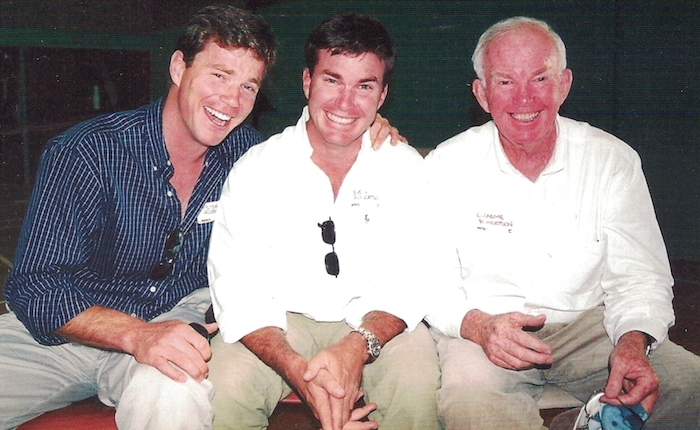
Peter and Sven Robertson with their father Graeme Robertson
page 171
While his brothers and sisters moved away from Port Campbell, Arthur continued living there until his death in 1925. His daughter Mime lived at Port Campbell all her life and many of Arthur’s’ descendants still live in southwestern Victoria. Mime’s son, Arthur Ward, had nine children and her adopted daughter, Isla Ward Magilton, had six children, so there are many descendants in this line.1
Isla WARD (1904-1990) - married name MAGILTON
The adopted daughter of Willimina Robertson and Christopher Ward, born at Camperdown in 1904. Whether her adoption was a formal or informal arrangement is not known. Up to the time of her marriage she certainly used the name Ward rather than Michel.

Isla Ward and Eddie Magilton on their wedding day, 15 June 1926.
Isla’s natural parents were Chris Ward’s sister, Minnie Ward, and William Michel.2 We know little about William Michel except that he was probably born in Melbourne about 1880 and may have died in Queensland. Minnie and William were married in 1902 and had four children, George, Gilbert, Isla and Dorothy. It seems the marriage was an unhappy one and sometime around 1909, Minnie left Victoria for Western Australia, taking her two sons with her. Isla was already living with her uncle and aunt. Dorothy, who was born at the Women’s Hospital in Melbourne, was given up for adoption soon after birth. In Western Australia Minnie supported her children by working as a maid and cook. In 1914 Minnie married Walter Bracegirdle and the marriage certificate records Minnie as a widow. Minnie had six more children with Walter.
It seems unlikely that Minnie had much contact with her own family after going to WA as her father’s will written in 1917 “includes the information that if Minnie Michel does not claim her share of the will within seven years, then her share will be paid to Isla Michel.”3 The use of the surname Michel for Isla in her grandfather’s will suggests this was still legally her name and her adoption by Mime and Chris was an informal arrangement.
From an early age Isla demonstrated an accurate ear for music and by the age of four she was able to tell if someone was singing off key. As she grew older she developed into a fine mezzo-soprano and she was praised for her clear diction. She sang duets with her brother Arthur.4
Isla married twice. Her first husband was Eddie MAGILTON (19057-1944). They had six children, Merle (1927), Raymond
page 172
(1928), Noel (1929), Audrey (1931), Leonard (1934) and Marion (1940). After Eddie’s death, Isla married Francis NICHOLSON (1901-1974).
A group picture taken at the Port Campbell School break-up party in 1948 includes both Isla and Willimina.5 Isla died on 19 August 1990 and is buried at Port Campbell.
Arthur Christopher WARD (1905-1996)
Only son of Willimina Robertson and Christopher Ward, born at Port Campbell on 12 December 1905.
Arthur’s names came from his maternal grandfather and his father. It seems his two grandfathers, Arthur Robertson and Peter Ward, did not get on with each other. Peter Ward refused to call his grandson Arthur, and “being an old Navy man - called him ‘Nelson’.”6
With his father’s death in 1918, Arthur had to take on much of the responsibility for running the family farm. Despite this, his teenage years, when his cousin Frances Ward lived with the family, were happy ones.7 In the biography of Rutherford Robertson in Chapter 25, I relate a tale he told to me about Arthur and a bull.

Arthur Ward and his wife Jessie Port
Arthur took singing lessons and after the milking was done he would ride his pony some twenty-one miles to attend these lessons, then back home again in the dark. He won the bass solo award at Ballarat. Arthur is mentioned in Fletcher’s book as providing an ‘item’ during the 1939 celebrations for the second anniversary of the Baptist Church at Waarre.8 Arthur told his son Chris about trying to harmonize with grandfather Arthur and about the sermons Arthur Robertson Jnr used to preach.
In 1927, Arthur married Jessie PORT (1897-1977) at Geelong. Jessie was the daughter of John Port and Sarah Cole. They had nine children, Chris (1928), Charlie (1929), Eric (1930), Mima (1932), Gus (1933), Gladys (1934), Gwen (1936), Merna (1937) and Joy (1941). Chris recalls a woman who worked for the family saying, ‘Spare me from singing husbands and crying children’.9
Arthur ran the family farm with his mother. Son Gus eventually bought the farm from his father. A second block of 19 acres was considered useless until the lack of trace elements in the soil was recognized. In 1948 Gus helped Arthur clear this block and plant pasture for dairying.10
Arthur died at the age of ninety in 1996.
page 173

Ward Family, mid 1940s
Left to right: Merna, Charlie, Gladys, Gus, Arthur, Joy, Chris, Jessie, Mima, Gwen, Eric.
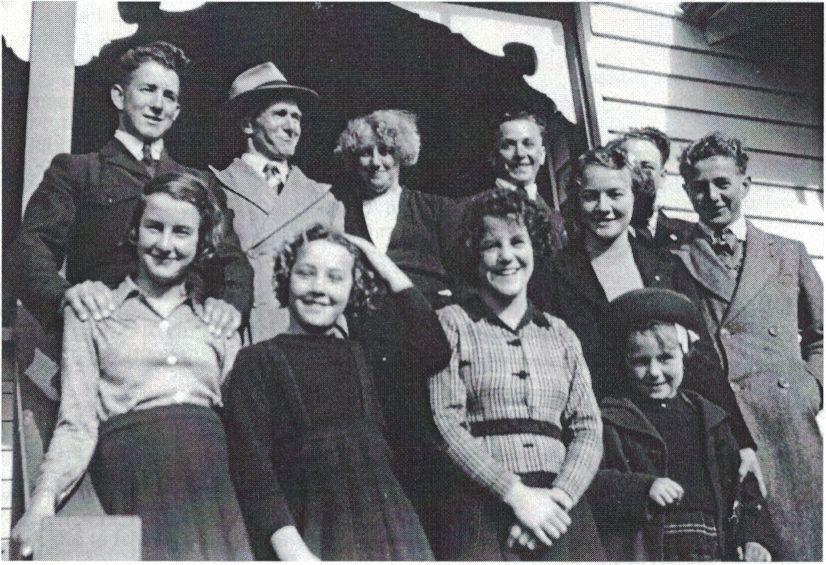
Ward Family, mid 1940s
Left to right, back row: Eric, Arthur, Jessie, Charlie, Mima, Chris, Gus.
Front row: Gwen, Merna, Gladys, Joy.
page 174
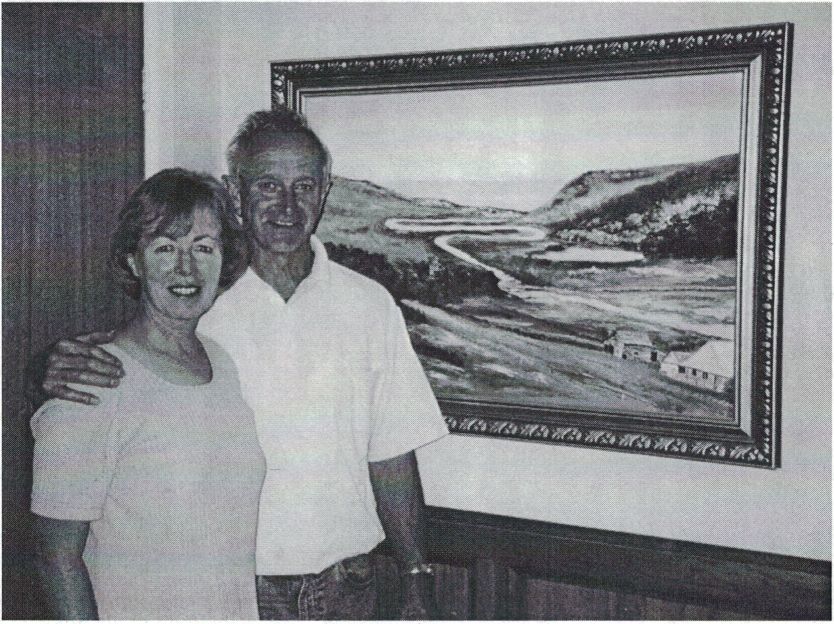
Gus and Judith Ward, Port Campbell 2001 in front of the picture of the Stone house painted by Gus’ first wife, Valerie Bailey.
1 Matthew Magilton has been researching the Ward/Magilton side of the family and I would be happy to put anyone interested in those families in touch with him.
2 Correspondence and shared information from M. Magilton, 1999 to 2002
3 Letter from M. Magilton, March 2001
4 Telephone conversation with Raymond Magilton, 30 October 2002
5 J. Fletcher, ‘And We Who Followed’, p.523
6 Letter from Chris Ward, February 2000
8 J. Fletcher,‘And We Who Followed', p 470
9 Letter from Chris Ward, February 2000
10 Interview with Gus Ward, April 2000
page 175
Norman Ashton CHISLETT (1922-)
Youngest child and eighth son of Arthur Chislett and Emma Straub, bom at 12 July 1922. Spells his surname without the middle ‘e’.
Like his brothers, Norm started his working life on his parent’s vine farm at Merbein. “It was the middle of a drought and every second day was a sand storm at Merbein”.1 After a windy night they would have to dig the sand away before they could open the shed doors and when they were laying pipes, if they didn’t get the pipes in the day they dug the hole they would have to dig it again the next day. The farm was sold in 1943. Norm’s older brothers, George and Gordon, persuaded him to join them at Boundary Bend where George had bought land.
The new project involved starting a farm from scratch and planting 100 acres with oranges along the Murray River at the end of what is now called Chislett Rd. Their intention was to make a living from growing vegetables but this proved impractical because of the distance from the market and poor roads and transport. “The roads were gravel and rough and the trucks that were running were ex-army trucks and they broke down.”
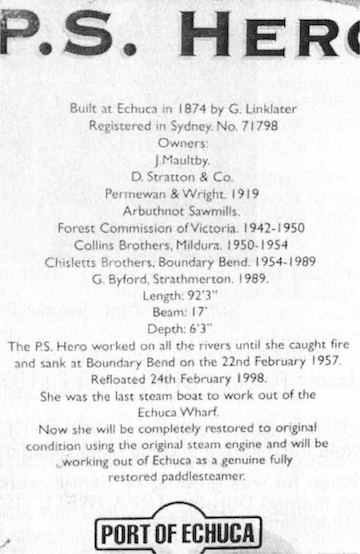 The brothers gave away vegetable growing and went into the timber industry, cutting red gums along the river and running a saw mill at Boundary Bend. ‘Chislett Brothers’ owned the paddle steamer ‘Hero’, which was used for towing barges loaded with timber. A second paddle steamer, the ‘Kenally’, was stripped to use as a barge and there was a punt onto which timber jinkers could be driven for getting logs across the river. The ‘Hero’, built 1874, was the last steamboat to work out of the Echuca wharf. In 1957 she caught fire and sank. Forty years later the ‘Hero’ was refloated and is being restored at the old saw mill site at Echuca, by G Byford. The ‘Kenally’ has also been refloated and is being restored at Mildura.
The brothers gave away vegetable growing and went into the timber industry, cutting red gums along the river and running a saw mill at Boundary Bend. ‘Chislett Brothers’ owned the paddle steamer ‘Hero’, which was used for towing barges loaded with timber. A second paddle steamer, the ‘Kenally’, was stripped to use as a barge and there was a punt onto which timber jinkers could be driven for getting logs across the river. The ‘Hero’, built 1874, was the last steamboat to work out of the Echuca wharf. In 1957 she caught fire and sank. Forty years later the ‘Hero’ was refloated and is being restored at the old saw mill site at Echuca, by G Byford. The ‘Kenally’ has also been refloated and is being restored at Mildura.
Gordon Chislett’s wife, Claire, says that when she first started doing the washing (at Boundary Bend) the clothes had little red spots that wouldn’t come out. It was the red gum.2 Norm commented in 2000: “Since the last flood, red gums have come up like hairs on a dog’s back.”
In 1949 Norman married Addie ATKINSON (1915-1997) and they have three children, Greg (1951), Susanne (1953) and Pamela (1955). Addie died in 1997. In 1999 Norm married Marjorie CUNNING, a widow. The Chislett and Cunning families had been long-term friends. Norm is now retired and his son Greg runs the family citrus farm at Kenley.
page 176

‘Hero’ undergoing restoration at Echuca, April 2000.

Norman Chislett with his son, Greg, grandson Brenton and Greg’s wife, Susan, in Kenley, April 2000.
James Robert CHISELETT (1921-1974)
Eldest child and only son of William Chiselett and Doris Tylor born at Merbein on 25 July 1921. Note the different spelling of Chiselett in this section of the family.
When he was growing up James worked in the family cordial business at Merbein. In 1942 he married Dorothy TREADWELL (1921- ) and they have three children, Neville (1943), Ivan (1946) and Narelle (1962).
After his father’s death in 1948, James took over running the family business. In 1949 a violent storm caused considerable damage to the factory building and its contents. The roof was torn off by the wind and deposited on a fruit block on the edge of town, bottles and crates were broken and the sugar soaked through. “No insurance was forthcoming as it was called an ‘act of God'.”5 The building had to be re-roofed and re-wired.
page 177
Because of James’ failing health the business was sold as a going concern in 1970. It continued as ‘Chiselett Drinks’ until 2001. The soft drink factory is now run as a Schweppes franchise.
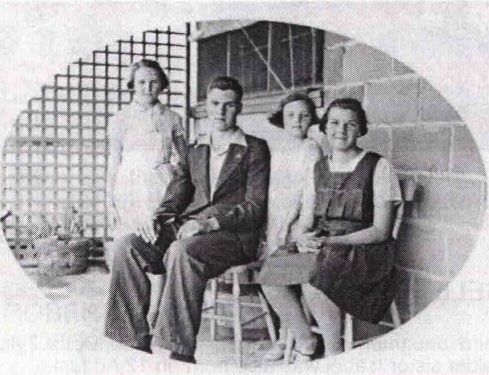
Chiselett family. Left to right: Despina, James, Edna, Isabel.
James suffered from rheumatoid arthritis and it seems probable that the anti-inflammatory drugs he took damaged his kidneys. He developed diabetes and died from renal failure in 1974. He is buried in the Merbein cemetery.
Isabel Eva CHISELETT (1924- )
Eldest daughter and second child of William Chiselett and Doris Tylor, born at Merbein on 12 August 1924.
Isabel left school at fourteen and took on the job of running the domestic side of the family life while her mother worked in the family’s soft drink business. She tells us there were always lots of visitors to the family home in Merbein - Doris’ relatives from Adelaide and Croft relations from the Chiselett side of the family.
In 1947 Isabel married Erik NORDIN (1924- ). Erik was serving in the army in New Guinea during the Second World War when a friend, who had been a neighbour of the Chiselett family, gave Erik Isabel’s name and address as a pen friend. The couple did not meet until Erik came home from New Guinea.
Erik’s family had migrated to Australia from Sweden in 1925. There was illness on the ship on which they sailed from Southampton and two of Erik’s three brothers died within a fortnight of landing in Melbourne. The family settled at Swan Hill where Erik’s maternal uncle, August Engstrom, was already living. August had come to Australia prior to World War I and served in the AIF during that war. As a result he was eligible for a soldier settlement farm in the Mallee.
Isabel and Erik have two children, Ralph (1948) and Glenys (1951).
The couple lived in Bendigo for a time but returned to Merbein in 1951 to help Isabel’s brother, James, run the family soft drink factory. After the factory was sold in 1970, Isabel and Erik moved to Belmont in Geelong, where Erik worked for a local soft drink company as Production Manager until his retirement in 1985.
In 1980 Isabel and Erik made a trip to Sweden where they met with Erik’s many relations. His father came from a family of seventeen and Erik has forty-five first cousins on his father’s side of the family.
Isabel and Erik still live in Belmont but their activities are limited because of Isabel’s severe osteoarthritis.
page 178
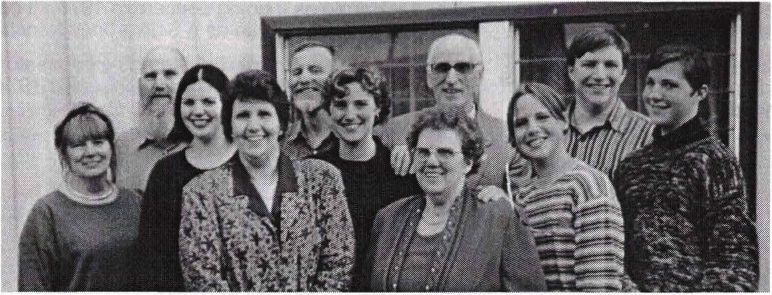
Nordin family. Isabel and Erik’s golden wedding anniversary 1997. Left to right: Kathleen and Ralph Nordin, Monica, Glenys, Chris and Ngaire Long, Erik and Isabel Nordin, Paul, Simon and Daniel Long.
Edna Muriel CHISELETT (1930-1962)
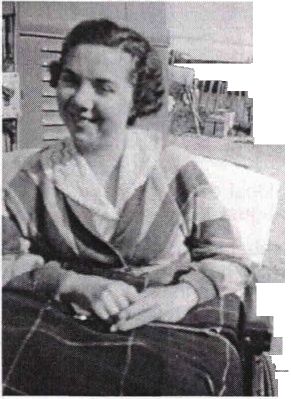
Edna Chiselett
Youngest child and third daughter of William Chiselett and Doris Tylor born at Merbein 12 August 1930. Her older sister Isabel was also born on 12 August.
In 1949 Edna was studying to be a dressmaker when she started experiencing pain in her hips. This was diagnosed as rheumatoid arthritis. After treatment at the Royal Melbourne Hospital, which included having her legs put into traction, she was transferred to the Mildura Hospital. “She was in such pain when [she] went to lie down at nights, they finally left her sitting up night and day. This was a mistake as her hips fused and she never laid down to sleep again.”6 Edna became completely crippled and suffered with pain for the rest of her life.
After two years in hospital her mother brought Edna home. However, the continuous nursing became too much for the family after four or five years and Edna was moved back into Hospital. Edna died in the Mildura Hospital in 1962. She is buried in the Merbein cemetery.
1 Interview with Norm Chislett, April 2000. Quotes in this section are from Norm unless otherwise noted.
2 Interview with Claire Chislett, April 2000
3 Interview with Norm Chislett, April 2000. Quotes in this section are from Norm unless otherwise noted.
4 Interview with Claire Chislett, April 2000
5 Isabel and Erik Nordin, 8.3.2001
6 Isabel and Erik Nordin, 15.5.2001
page 179
Robert and Molly Robertson took their family from Port Campbell to Geelong in the 1880s so their children could avail themselves of better educational opportunities. As a result most members of this section of the family moved away from rural occupations and rural living to pursue academic professions and careers in towns and cities.

Mary and Stuart Robertson, circa 1913
Mary Rutherford ROBERTSON (1908-1990) - married name DICKINS
Eldest child and only daughter of Robert (Rab) Robertson and Fanny Daniell, born at Sandgate, Queensland on 25 March 1908.
Mary was a schoolteacher. In 1938 she was teaching at Woodside in Gippsland. This was followed by her appointment as Infant Mistress at Pakenham near Melbourne and this meant she could live at home with her parents at Ormond.
In 1945 Mary married Sidney Edmond DICKINS (1892-1964) in Mt Gambier, SA. One of the witnesses was Sid’s niece and long time business secretary Win Dickins. Sid had previously been married to Mary’s aunt, Lottie Robertson Dickins.1
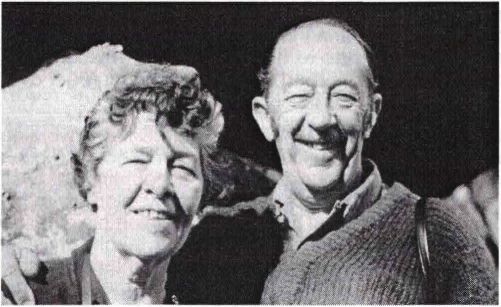
Mary and Stuart Robertson, early 1970s
Mary and Sid had one child, Richard (1950), and the family lived on a property at Vermont. Sid died in 1964. Mary died of cancer of the pancreas in 1990.
page 180
Robert Stuart Daniell ROBERTSON (1911-)
Second child and only son of Robert (Rab) Robertson and Fanny Daniell, born at Sandgate, Queensland on 21 February 1911.
Stuart’s earliest memories include the house on stilts at Sandgate, sand flats with the tide going out, and a pond with beautiful water lilies. The family left Sandgate just before the First World War and moved to Geelong to live with Rab’s parents. Stuart remembers the train trip south with his mother and sister Mary. Between Brisbane and Sydney the train stopped several times because of the amount of traffic and sailors would jump off the train and walk along looking into other carriages. Stuart would scream and make a fuss because he was frightened the sailors would be left behind when the train started again. This became a family joke.
The family stayed with Stuart’s grandparents at Barwon House until his father was called to the Elsternwick Baptist Church in about 1916. One night, while they were living in Geelong, the wool store on Corio Bay burnt down and his Uncle George took Stuart to see the remains. George drove the two-wheel jinker over one of the fire hoses and was 'told off by one of the fireman because the hose was full of water at the time and the weight of the jinker could have burst it.
After his family moved to Melbourne, Stuart started school at Caulfield Primary School and he was there for three years while the family lived at the ‘Helen’s Lea’ house. He then attended school in Sale and finished his secondary education at Melbourne High School. In 1931 Stuart became a student teacher at a school in South Caulfield, but because it was the middle of the Depression he could not get into the Teachers Training College. This left him very frustrated so in 1935 he took leave without pay from the Education Department and worked in an S E Dickins grocery store at Collingwood. After twelve months he decided the grocery business was not for him. He went back to the Education Department as a junior teacher at North Richmond and was accepted into the Teachers College in 1938. At that time students received no wages during their twelve-month course, and his sister Mary supported Stuart. When he finished he owed Mary £91 and it took him eighteen months to pay this off. As a junior teacher he received 1 pound 9 shillings and a halfpenny per week. As a trained teacher his wages went up to 9 pounds 4 shillings and 6 pence per fortnight.
As soon as Stuart had finished re-paying Mary, he and Kathleen Alison HUGHES (1912-1971) became engaged. Kay worked in the uniform section at Payne Bon Marche, a Melbourne department store, taking orders and dispatching school uniforms. The two had known each other since 1937. They were married in 1941 at St George’s Presbyterian Church, East St Kilda by Stuart's father Rab Robertson. The best man was Henry Volk.2
Stuart and Kay have four children, Craig (1944), Lee (1947), Peter (1949), and Sue (1951).
Stuart spent the years 1939-41 as a physical education teacher. In 1941 he joined the AIF and spent two and a half years as an anti-aircraft gunner, attaining the rank of Lieutenant. He then transferred to the RAAF and spent a further two and a half years in Airfield Defence. He saw active service in the Pacific rising to the rank of Flying Officer. RAAF service men like Stuart, who did not fly, were known as ‘Penguins’. Stuart’s discharge from the RAAF at the end of hostilities was delayed because it was discovered he had a severe hearing loss and the authorities wanted to decide, before they discharged him, whether this was due to his war service. Repatriation eventually accepted that the hearing loss was war caused. Stuart has worn a hearing aid ever since leaving the Airforce.
Stuart continued his career as a physical education teacher at Melbourne High School, working half time while he upgraded his qualifications through the Commonwealth Reconstruction Training Scheme. He studied commercial law, economic geography and accounting, as well as undertaking a physical education course at Melbourne University. This study, along with his war service, qualified him for his teaching Honours Certificate. The cost of obtaining his diploma was 10 guineas but as he didn’t have the money he never collected it. Stuart taught physical education at Melbourne High School for eighteen years. In 1967 he was appointed Principal of Boorondara North, a new primary school in the Box Hill district. He remained there until his retirement in 1976.
Sadly Kay died of a massive heart attack in 1971. The couple was out shopping in a self-service store in Chapel St and Kay went off to check out some item or other. She did not come back and when Stuart went to search for her, he found her on the floor in one of the aisles with a member of the staff trying to give her resuscitation. She was taken to the Alfred Hospital but pronounced
page 181
dead on arrival. Stuart gives us a picture of her as a beautiful and fun loving person, “I thought the sun shone out of her.”4
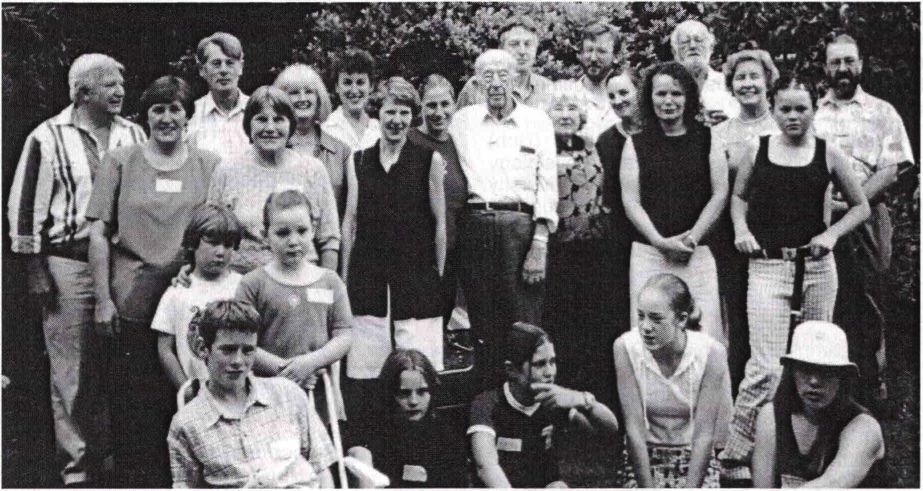
Descendants of Robert Robertson, Melbourne 2000 Left to right standing: Max Chapman, Sue , Peter and Lucy Robertson, Bobbie Chapman, Jane Robertson, Lee and Jane O'Keefe, Stuart, Craig, Pixie and Tim Robertson, Sally Wadham, Jennifer Williams, Rod Robertson, Ailsa McLennan, Belinda Williams, Richard Dickins. Left to right in front: Felix Watson, Arthur, Harriet, Laura, Katie, Danielle and Stephanie Robertson.
Throughout his life Stuart has had a love of boats and motorcars but he has rarely had the money to indulge his passion. As a child he made his first boat out of a sheet of tin used for the family’s chook house. His grandfather gave him £1 to buy the piece of corrugated iron, which had to be flattened out before it could be used for a boat. Several people have told me about his adventures with cars including a lucky escape when a truck hit him. Stuart was all right but the Mazda RX7 he was driving was demolished. At the age of eighty-nine, Stuart was driving a Mazda MX6.
Rutherford Ness (Bob) ROBERTSON (1913-2001)
Only child of Joshua Robertson and Josie Hogan, born in Melbourne on 29 September 1913. His names come from the maiden names of his paternal grandmother’s mother (Margaret Rutherford) and his maternal grandmother (Anna Maria Ness). Within the family he was called Routh, outside the family he is known as Bob.
At the age of five Routh developed poliomyelitis. He attributed his good recovery to the therapy and exercise administered by his mother and her determination to get him mobile.
Routh remembers visiting his Great Uncle Arthur Robertson and his second wife, at Port Campbell, on a number of occasions between the ages of six and twelve. Here he was taken under the wing of Arthur’s grandson, Arthur Ward, who was eight years older than Routh. He would accompany young Arthur in the spring cart when Arthur took the milk cans to the butter factory. On one occasion Arthur stopped to talk to a farming friend. Routh, whose knowledge about sex was limited at the time, was mystified by their conversation which included the comment ‘we had better get to that bull and cut it because it’s starting to be troublesome’. Plans were made for doing this. Routh asked Arthur what ‘cutting the bull’ meant. Arthur became embarrassed and told Routh he had better ask his father. Routh did ask Josh but got little extra information, simply being told that they cut the bulls private parts so he would not interfere with the cows. “Such was typical of what they thought was allowable for children to know then!’’5
page 182

Rutherford Robertson with his father Josh in 1914
On another occasion at Port Campbell, where the coast was notorious for shipwrecks, a sheep fell over a steep cliff. Arthur Robertson asked Josh to help him rescue the sheep. Rutherford was terrified his father would fall over the cliff and never come back.
Rutherford commenced school at Carey Grammar School in Melbourne in the first year of that school’s operation. He completed his schooling at St Andrew’s College in Christchurch, New Zealand after his father was transferred to NZ in 1926. The following piece from the University of Sydney, Faculty of Science, Hall of Fame outlines his professional career: 5
“Professor Sir Rutherford (Bob) Robertson’s interest in plant physiology began in his honours year at the University of Sydney (1933) and continued throughout a distinguished career which saw him receive scholarships, degrees (PhD, DSc), medals, appointments (Australia and overseas), and awards (including AC, CMG, and 4 doctorates honoris causa).
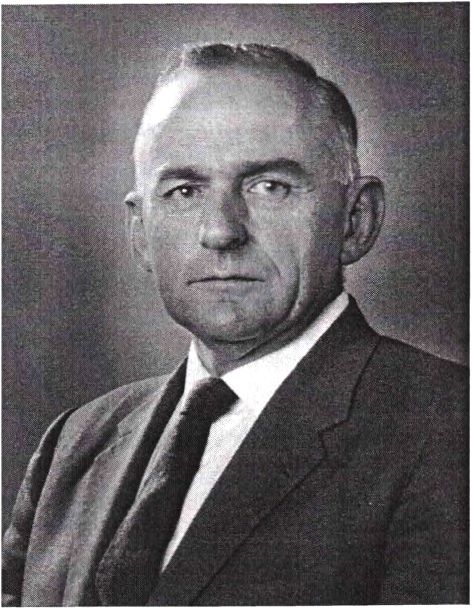
Rutherford Robertson in his 50s
Reproduced with the kind permission of the Faculty of Science“On completion of his PhD at Cambridge (1939) Bob returned to Australia to the University of Sydney as Assistant Lecturer in Botany. When war broke out with Australia unable to export its wheat and fruit crops, research turned to food storage. Bob worked on the physiology of stacks of wheat and, with scientists at CSIR (now CSIRO), on the physiology of apple fruits in storage.
“After the war Bob joined the CSIR in charge of the Plant Physiology and Storage Section and subsequently combined this section with the plant physiologists in the Botany Department to form the Plant Physiology Unit at this University. Being among the first to establish the connections between respiration, the flow of protons, the absorption of ions and the phosphorylations which distribute energy, he achieved international recognition and published a definitive book. He was elected Fellow of the Australian Academy of Science (1954), of the Royal Society of London (1961) and Foreign Associate of the US Academy of Science (1962).
“Although his major loves were in research and teaching, he agreed to become an administrative member of the CSIRO Executive for a limited term. He returned to his main interests by accepting the Chair of Botany at the University of Adelaide. After 7 years he was appointed Master of University House, ANU, with time for
page 183
research, but finished his formal working life as Director of the ANU Research School of Biological Sciences in 1978.
“Bob served on many committees. When the Government decided to allocate money for research in universities, he was asked to establish what became the ARGC (now ARC). He chaired the committee for 4 years and instituted a process for the competitive distribution of the funds.
“He served as President of the Australian Academy of Science (1970-74). At that time science and technology had not achieved the recognition they now receive, and the Academy spent time in bringing their vital significance to the notice of decision makers in government, bureaucracies, industry and not least, the ABC.
“After retirement, Bob continued both research and committee work, including terms as Pro-Chancellor of ANU and as first Deputy Chairman of ASTEC.
“His lasting contributions to science are his own research, his influence over several generations of students and research workers, and his public roles as an advocate for and communicator of science.”
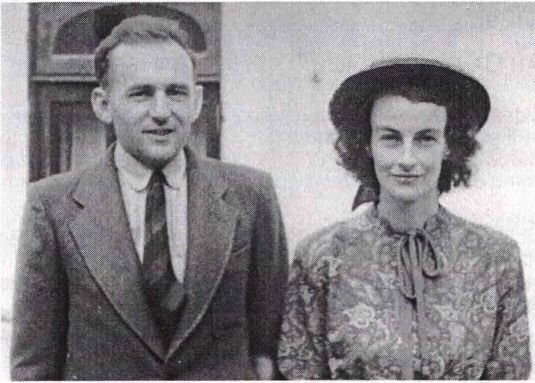
Rutherford Robertson and Mary Rogerson Robertson
In recognition of his work Rutherford was granted a knighthood in 1972 and in 1980 he was made a Companion of the Order of Australia (AC). For his work in connection with the Australian Research Grants Committee he was made a Companion of the Order of St Michael and St George (CMG).
Bob married Mary ROGERSON (1915-2001), the daughter of George Thomas Rogerson, who was born in Wamphray, Scotland and came to Australia in 1910. George initially worked as a jackeroo. Mary’s mother, Jean Morrison McTavish, was born in Lockerbie, Scotland. She came to Australia in 1912 and married George Rogerson in Melbourne. The couple took up land in Gundaroo NSW, where Mary was born. In 1921 George bought better land at Binalong, NSW. The property there is still owned by the family and provides a great place for family holidays and get-togethers.
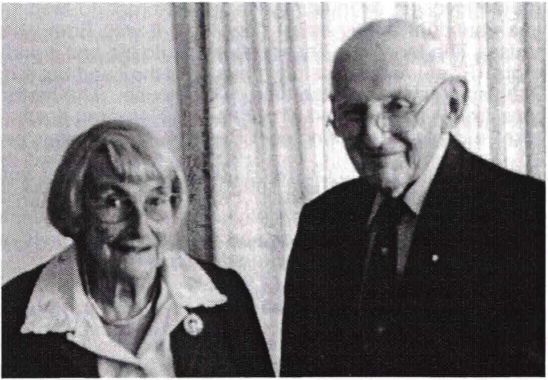
Mary and Rutherford Robertson, 1997
Mary graduated with a BSc in Botany and Geology, and she and Bob became engaged in 1936, before Bob left to study at Cambridge, UK. Mary joined him in 1937 and they were married at All Saints’ Church, Cambridge on 9 September 1937. They have one son, Rob (1944), born after the couple returned to Australia. Mary did not study at Cambridge but helped Bob with his PhD. When they came back to Australia Mary was involved in part-time demonstrating in Botany at Sydney University and school science teaching.
When they were courting Bob and Mary were getting ready to attend the wedding of an Anglican friend, “Hope they don’t forget the champagne” said Mary. This had Bob’s Baptist parents wondering ‘what sort of girl he was going out with’.6
page 184
The marriage worked out well and in 1997 Mary and Bob celebrated their diamond wedding anniversary. An article celebrating this event was published in the Yass Tribune on 24 September 1997. Technically retired, the couple lived their final years in the Linton Retirement Village in Yass. However Bob involvement in scientific projects continued right up till a few weeks before his death on 5 March 2001. Six weeks later, Mary was involved in a car accident and although her injuries were not serious she suffered a cardiac arrest and died on 21 April 2001.
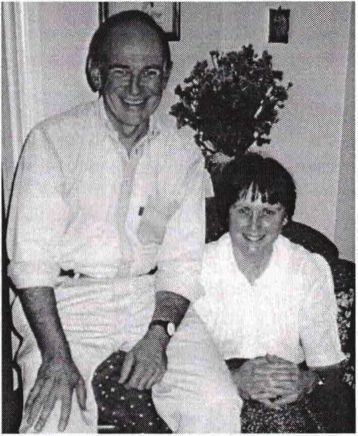
Rob and Jan Robertson, 2000. Rob is Mary and Rutherford’s son.
Rutherford recorded two tapes for the Academy of Science about his professional work. There are several newspaper articles and obituaries and with an entry in ‘Who’s Who in the World’ on Rutherford. 7 Appendix 5 contains a poem Robert Robertson Snr wrote for Rutherford in 1935, to celebrate Routh’s work on leaf structure.
Ian Campbell ROBERTSON (1915-1995)
Eldest child of Arthur Robertson and Clare Campbell born at Geelong on 16 September 1915. 8 At first Ian’s parents called him Cam, but when his mother was confined with her second child, fifteen-year-old Nancy Cutlack looked after Ian and she preferred to call him Ian. When he came home and his parents called him Cam he said ‘I not Cam - I Ian’. So Ian he remained. 9
Ian started his schooling at Renmark in South Australia, continuing at Ballidu WA when the family moved there to live on a farm called ‘Wenscote Barton’. Returning home one evening on his horse Ginger, Ian took a short cut and ran straight into a single line of barbed wire, which a neighbour had stretched across the track to stop cattle straying. The horse was badly torn and Ian came a cropper and sustained a broken collarbone.
Ian’s education continued at the Perth Boys School where he matriculated in 1933. During this period the family lived at Bayswater near the Swan River. Ian, his good mate Harry Evans and another schoolmate Brendon, had equal shares in an old decrepit Douglas motor cycle (flat twin and belt driven). A noisy contraption that took up all their spare time. Petrol was precious and they had to save to buy it a bottleful at a time. The motorbike had no brakes and getting it started involved strenuous pushing, “whereas to stop it meant running it into the soft sand that was abundant in the area. [One day] it was Brendon’s turn to be pushed down towards the house. The fearsome beast bellowed into life and it and Brendon disappeared at a great rate of knots. Brendon desperately turned into the sand but forgot to close the throttle, both he and the Douglas crashing into the side of the house. The motor stopped [and] Brendon fell back semiconscious on the ground while Ian and Harry ran down shouting ‘the juice, the juice, turn off the juice!’ completely ignoring poor Brendon, the precious petrol had to be saved!”10
The family had an old Overland utility. Ian and Harry would sit in it, Ian playing the mouth organ, the two of them bragging about the girls they met at dances at the Perth Town Hall and how they were going to offer to drive them home. This never eventuated, for apart from the boy’s shyness, the utility had no mudguards and no lights and always had to be home before dark. Eventually the Ute was sold to the wreckers for £5.
page 185
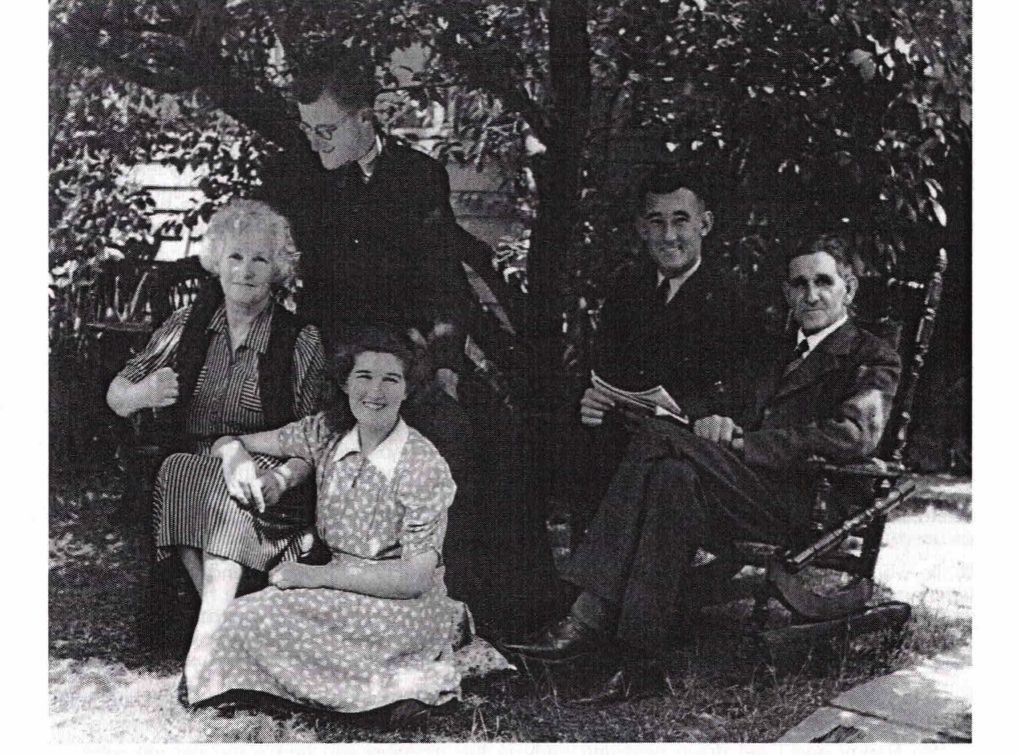
Arthur Robertson Family, 1944. Left to right: Clare, Rod, Pixie, Ian and Arthur Robertson.
Leaving school Ian went to ‘Minnie Creek Station’ near Carnarvon as a jackeroo. The country was in the grip of both the Depression and a four-year drought, so it was not a good time for anyone. While he was away Ian and his sister Pixie corresponded in French.
When the rest of the family moved to Melbourne Ian joined them and had short-term jobs with Dickins grocery and the Austin car distributors before joining the RAAF in January 1938. His Airforce record tell us that at the age of twenty-two Ian was just under 6 feet tall, weighed 150 pounds, and had brown hair and eyes. His interest was in mechanical engineering and he undertook a number of training courses while serving with the RAAF. When the war came Ian saw service in Australia and the Pacific (Morotai). He continued in the RAAF for three years after the end of hostilities and a comment by a senior officer in 1947, when Ian was stationed at Point Cook, states: “F/O Robertson has a sound knowledge of Service Transport and his ability and enthusiasm leaves nothing to be desired. He is keen and keeps abreast of all matters in connection with his work. He is popular with his fellow officers and takes an interest in station affairs.”11 Ian rose to the rank of Flight Lieutenant before leaving the Airforce in March 1948.
After his discharge, Ian established his own engineering business at Arthur's seat on the Mornington Peninsula. He drove in two Redex Round Australia Trials, finishing well in both. Joining the staff of the RACV he established the RACV Driving School. He also started the miniature road course at Kew, designed to teach children road sense. Ian was an enthusiastic yachtsman, enjoyed sailing on Port Phillip Bay, and was a member of the Coast Guard Patrol.
In 1954 Ian married Tamara RIMSHA (1921- ). The best man was Harry Evans and Pixie Robertson was the bridesmaid. Ian and Tamara’s only child, Sabina, was born the following year. Ian died in 1995 after a long illness. His lifelong friend Harry Evans presented the eulogy at his funeral.
page 186
Louise Coralie Campbell (Pixie) ROBERTSON (1917-)
Middle child and only daughter of Arthur Robertson and Clare Campbell, born at Renmark, South Australia on 31 October 1917. Known as Pixie.
When the family lived in Perth in the 1930s, Pixie learnt music from Sister Terese at a convent in West Perth. Pixie’s father had obtained a copy of the music from ‘Choo Chin Chow’ and when the film version came to Perth, Pixie and a friend asked Sister Terese if they could miss their weekly lesson so they could go to see the musical. Permission was granted. Next week however they found Sister Terese very distressed because one of the other nuns had told her the girls would be sitting in the dark. Seems Sister Terese had never been to the cinema and who knows what might have happened in the darkness! 12
Pixie qualified for her matriculation in WA in 1936. She studied science at the Royal Melbourne Institute of Technology, followed by specialized nursing and hospital technology work. At the final exam for Psychiatric Nursing in 1942, Pixie topped the State. From 1943 to 1945, Pixie was Matron at the Travancore Centre for Disturbed Children. She then spent two years in charge of the Intravenous Solutions Laboratory at the Alfred Hospital in Melbourne, followed by two years in a similar position at the Brisbane General Hospital.
In 1951 Pixie commenced training in Biochemistry at the Repatriation Hospital in Melbourne, followed by further training in Haematology, Bacteriology and Biochemistry. She was a foundation member of the education committee to draw up syllabus for the formal education of medical technologists. For five years from 1955, she was in charge of the Solutions and Bacteriology Laboratories for the Red Cross Transfusion Service. This was followed by a year as assistant in the London University Medical School’s Biochemistry Laboratory.
While working at the London Medical School in 1961, Pixie visited Shetland in her summer holidays, accompanied by Nancy Basey, her brother Rod’s mother-in-law. They spent two weeks there. She tells us that Nan was well received but a comment was made to her that ‘Shetlanders who go away and come back are frowned upon’. Apparently her appearance led people to believe she was Shetland born. She had to explain she was born in Australia.
Pixie and Nanny Basey decided to hire a car. The man they hired it from said he would leave the car in the square with the keys in it, and they could pick it up whenever they liked.
“So Nanny and I get down nice and early in the morning and here’s the car we were looking for sitting in the square with the key in the ignition. We had a lovely day. [At one place a man said,]
‘I see you’ve got the Major’s car'.
‘We didn’t know it was the Major’s, we hired it’.
‘I don’t think the Major would put his car out for hire’.”
What they had done was take the wrong car, but in the end no one seemed to mind and everyone had a good laugh. 13
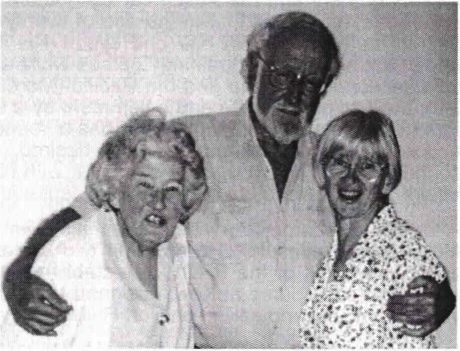
Pixie and Rod Robertson With Margaret Worrall, Melbourne, 2000
From 1963 to 1982, Pixie was supervisor of the Sterilizing Department at the Royal Children’s Hospital, Melbourne, and in 1971 she became a member of a team that made annual visits to country hospitals throughout Victoria to inspect facilities and advise on sterilization. She has served as Treasurer of the Australian Medical Technologists Association, Secretary of the Sterilization and Disinfection Society of Victoria and in 1982 she was made a life member of that society.
She has lectured and been an examiner for ‘Methods and Management of Sterilization in Hospitals’. In 1971 Pixie was made a life Governor of the Royal Children's Hospital
page 187
From October 1973 to March 1974, Pixie worked for the World Health Organization advising on sterilization and disinfection at the Medical Teaching University in Baghdad. And somewhere in between all of this Pixie has found time to be a member of Soroptimist International.
Pixie is an inveterate traveller to out of the way places. She has been up the Amazon in an open wooden boat, when going to the toilet meant hanging out over the rear of the boat. She has sailed up the Nile and made three visits to Antarctica - once on the icebreaker ‘Lindblad Explorer’ and twice by plane. During a flight in a ropey old plane to Lake Titicaca in Peru, a piece of her seat fell off into the aisle, but this caused little interest as it was not seen as anything unusual. She has an immense collection of photographs she has taken on her travels.
Pixie has not married and in retirement she lives in a nice little flat in South Yarra, Victoria.
Roderick Campbell ROBERTSON (1926-)
Youngest child and second son of Arthur Robertson and Clare Campbell, born at Renmark, South Australia on 1 May 1926.
The family was living on the farm at Ballidu in Western Australia when Rod was about three years old. One day at harvest time, Rod wandered off “with the dog I regarded as my own - a huge kangaroo dog, which towered over me, and I called Pup”. He wheeled along his only toy, a device his brother Ian had made for him from a length of twisted fencing wire attached to an old tyreless pram wheel. When it was realized the toddler was missing all work stopped and everyone, set out to look for Rod. Among the workers was a black tracker who traced Rod through the wheat field, onto hard ground and to a dam where Rod stood contemplating the water. When told that he had been lost Rod was perplexed, “I wasn’t lost, I was with Pup”.14
Rod did not start school till he was seven. He was however having piano lessons from Sister Terese at the convent in West Perth where Pixie also learnt music. Sister Terese suggested to Clare that as Rod was already coming to the convent for music it would be sensible for him to also attend the convent school. Now Clare was strict Church of England but she went along with the practicality of this idea, so Rod started at the convent. When he came home after his first day Clare asked Rod how he had got on. He replied it had been good but that he needed three pence. Clare wanted to know why he needed three pence and Rod replied it was to buy 'Rosemary beads’. Rod did not go back to the convent school!
One of the interesting things about Rod is his ability to remember events in association with the cars people had at the time. He says, “I have a fantastic memory for cars ... the year, the model, the make, two-door, four-door, or anything else”.15 He tells a story about one of his early car experiences. Every Saturday morning when the family lived at Camberwell, Rod rode over to Normanby Rd, Kew on his Malvern Star bicycle, to have a violin lesson with Mr W A Bennett.16 He did not take his violin for lessons as he used one of the many instruments Mr Bennett’s owned, however, he carried his music books in a big leather bag slung across his body by a long strap. On this particular day as he was turning right into Normanby Rd from Cotham Rd, he was hit from behind by a car and sent flying. “I went right over the car and as it passed beneath me I couldn’t help noticing it was a dark green Morris 8/40 with a sunroof, 1938 model.” Rod ended up winded, lying in the middle of the tram track. Fortunately an approaching tram stopped but the driver wanted to get on with his journey so Rod was rolled into the gutter. “I was gasping for breath. This bloke ... stopped the Morris 8/40 and walked back and said, 'How are you feeling. ‘I said ‘Great!’ He said ‘I’m going up to the shops in Glenferrie Rd and if you’re still here when I come back I’ll run you home’.” Someone got in touch with Rod’s Dad and he came down looking for the driver who had knocked his son down and then driven off - ‘Where is he, where is the bugger, I’ll kill him.’ Rod still has the Malvern Star!17
In 1942 Ian was with the RAAF in Darwin and showing extraordinary confidence in his sixteen year old brother, he asked Rod to buy him an MG motorcar. Off went Rod on his Malvern Star to inspect MGs that were advertised. He “located a beauty - 6 cylinder MG Magnette at a lovely home in Kooyong Rd [Caulfield], A test drive and negotiation on the asking price with the vendor ... resulted in an agreed purchase price of some hundreds of pounds and a deposit paid.” 18 Rod
page 188
then got on his bike and rode home. Ian sent the money down from Darwin and Rod did some more negotiating, getting a £10 reduction on the price because the spare wheel was missing.
Rod completed his schooling at Camberwell Grammar School. When he turned eighteen in 1944 he enlisted in the Airforce, anxious to join his brother. He had barely completed his training and been posted to an Operational Training unit when peace was declared - somewhat to Rod’s relief he tells me!
At Melbourne University Rod studied piano and violin. He then went to Europe to undertake post-graduate studies. Apparently not much studying was done, but he did propose to Lucy Basey under the Peter Pan statue in Kensington Gardens. Lucy accepted and the pair set about raising money to pay for the journey home. They had grand plans of buying a used car and driving back to Australia but this came to nothing. Finally they scraped up enough for their fares by ship and during the voyage Rod held an auction in his cabin of his last meagre possessions. With the money raised he was able to buy Lucy a white sapphire engagement ring “of very questionable quality” when they reached Ceylon.
Rod and Lucy BASEY (1928-) were married at St John's Church, Toorak in 1956. As explained in an earlier section, Lucy and Rod’s families had been friendly for many years. When Lucy was born Rod’s mother lent Mrs Basey Rod’s crib for her new baby. Rod and Lucy had a house built “high on a hill in leafy Eltham”. It was finished just in time for the arrival of twins, Jane and Tim, in 1958. Benjamin followed six years later.
Rod has two passions in life, music and motorcars. He still has the MG that he raced for many years with some degree of success, being an ex-Road Racing Champion of the MG Club and holding records in Historic Racing events.19 His three children were his pit crew during the early days of Historic Racing. Having driven with Rod I can attest to his propensity for going through yellow lights and his ability to get you from here to there in a hurry!
With his double love of cars and music it is hardly surprising that Rod lists his occupation as automotive buyer and musician. These loves have carried over to Rod and Lucy’s three children. All three are gifted musicians with Jane (classical clarinet) and Ben (jazz double bass and composer) working as professional musicians. Tim is an arranger, plays guitar and piano and sings in acappella groups.
William Harlock Gladstone ROBERTSON (1915-1978)
The younger of Glady Robertson and Alice Harlock’s two sons, born at Geelong on 9 September 1915. Known as Lock or Locky.20
During World War II, Locky served in the RAAF, his son describes him as “an Errol Flynn look alike ... with a rather rakish air”. Locky met Marie Jean VINCENT (1920-1999) in 1941 and the two were married in October of that year at St Andrew’s, Cronulla. Bill refers to his mother as Ethel, so I assume this was the name she was known by. She was the youngest child of Ethel and Ernest Vincent who lived at Cronulla in NSW and she started her working life in 1938 as a clerk with Qantas.
The couple’s first child William (known as Bill) was born in 1943. After Locky was demobbed from the Airforce in September 1945, he and Ethel lived in both Melbourne and Geelong. They then moved to Mildura to “pursue my father’s obsession for owning a fruit block". They lived in rented rooms before moving into their first ‘home’, a small weatherboard and corrugated iron cottage in Pine Ave, Mildura, with internal walls of whitewashed hessian and paper. It was while they were living here that their second child, Shan Marie, was born in 1946.
Round about 1948, the family moved to a more substantial home in Walnut Ave near the railway line. Bill mentions cattle being driven through the streets by drovers and their dogs on their way to the cattle yards, and “Hindu tinkers and knife sharpeners [who] cadged billies of water from the rainwater tanks in the back yard. ... Ration cards were still in use and the milk, the ice and the vegetables were all purchased at home from men [with] horses and carts.” The Robertson house was known as The Cattle Yard Inn’ or ‘Robbie’s Rubbidy’. Each day Locky rode his
page 189
bike out to the Merbein Winery [where he presumably worked]. As well as work, life included ‘entertaining, clubbing, golf, fishing, picnics, reading and child raising’
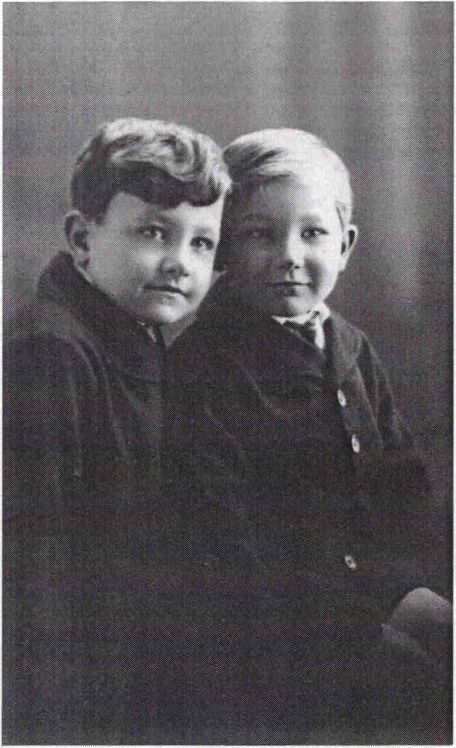
Rad and Locky Robertson. Locky is on the right.
In 1950 Locky was able to realize his dream and purchased a block of land at Red Cliffs, just south of Mildura. The period between 1950 and 1969 was one of “hard work, sand and dust, storms and frost ... complicated by fluctuating world dried fruit markets, changing bank policies and the politics of dried fruit production and processing. Life seemed little more than an endless stream of scratching out a living. The heat and flies, with initially no electricity, no car and a one and a half mile walk to town.” However the family found time to join in and enjoy local activities and the social life associated with the school etc.
Bill suggests it was during this period that his parents got pretty serious about “knocking back unending quantities of Muscat and water and ice while incessantly smoking and chewing Veginen.” This would eventually have a serious effect on their health and in later life Ethel suffered from emphysema.
Bill pays a compliment to his mother’s cooking and her hard work on the farm. Morning and afternoon every day of the three or four weeks as the crop was lifted she provided “for pickers down the block, hot and sticky from their toils, a four gallon drum of fresh water, a towel and a huge pile of freshly cut sandwiches, or newly baked scones or fruit loaf accompanied by a gallon of hot tea. Although none of this was mandatory, this was the standard Eth and the Old Man developed for themselves and to which they adhered religiously for nearly thirty years.”
Locky suffered from spondylitis and gradually his back deteriorated so that he could no longer do work on the farm. He and Ethel moved back to Mildura. “By previous standards their lives became sedentary: television, gardening, shopping, driving holidays, reading, a little fishing, and by then, grandchildren.”
Locky died in 1978 at the age of sixty-three. Ethel moved to Cronulla where she had grown up. Here she made new friends and joined in various activities. In 1988 daughter Shan Marie died unexpectedly and this was a difficult time for Ethel. Her health deteriorated over the next few years and in 1998 she moved to a nursing home, “though she was physically incapacitated, her mind was a sharp and cutting as ever”. Ethel died in 1999.
Apparently Ethel was prone to getting her words back to front and Bill finishes his loving celebration of his mother’s life by giving us some examples. “Sounds like a head with its chook cut off.” “Stoking their pinking noses in.” “Clawing at nothing that’s there.” “There must be someone looking at the window through me.”
page 190
James MacGregor DICKINS (1923-)
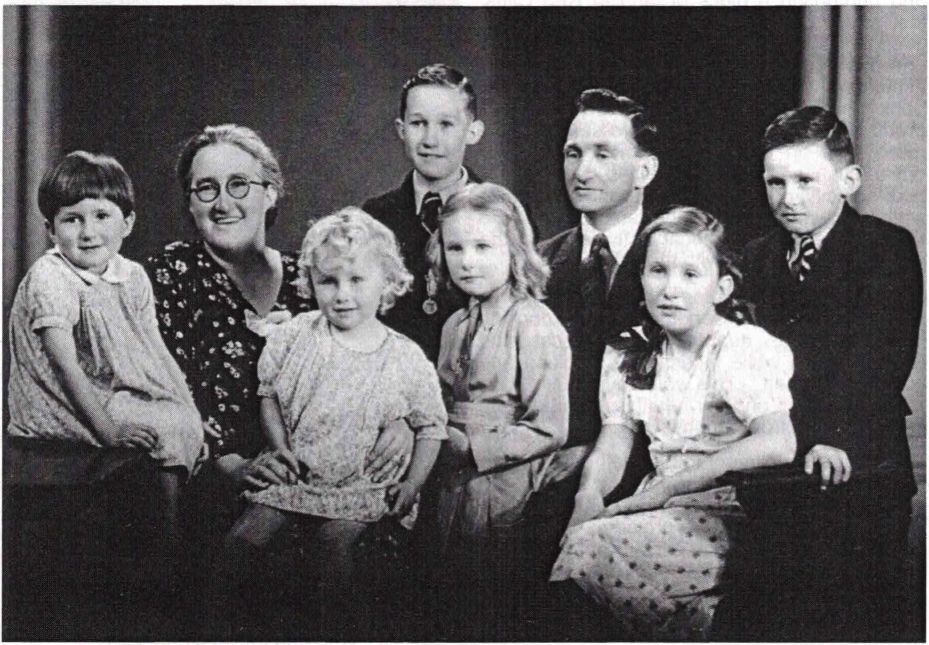
Dickins family, 1937 Left to right: Barbara, Lottie, Margaret, Mac, Marie, Sid, Joy, Neil.
Eldest child of Charlotte Robertson and Sid Dickins, born at Geelong on 7 September 1923. He was named after a friend of his father’s who was killed during the First World War. Always known as Mac.
Mac started school at Geelong College and was there until 1933 when financial difficulties during the Depression, forced his parents to take their children away from private schools and send them to the North Shore State School. After the family moved to Melbourne in 1937, Mac attended Melbourne High School. Out of school hours he worked in the Glenferrie Dickins shop, weighing and packing goods. At school he concentrated on economics, but deciding to pursue his interest in geology he did an extra year, so he could matriculate in science.
The war was in progress and as soon as he turned eighteen, Mac received his call up for the Army. He served in the CMF until the beginning of 1944, and then transferred to an AIF tank attack regiment as a gunner. He served in New Guinea. When Mac come home on leave from New Guinea, his younger sisters Barbara and Margaret, returning from school, would know he was in the house because the smell of his jungle greens was so pervasive. He would try to trick them by hiding, but they soon tracked him down following that smell.
Returning to civilian life in 1946, Mac was able to study science at Melbourne University with the assistance of the ex-servicemen’s repatriation scheme. In 1948 he joined the Australian Bureau of Mineral Resources as a Cadet Geologist, his area of expertise being palaeontology. At first he worked in the Department’s Melbourne branch, but was later transferred to Canberra.
Mac married Gwenneth EDWARDS (1925-) in June 1947. Gwen, who is the daughter of Percy Edwards and Bessie Young, lived not far away from the Dickins family in Kew, and had attended Swinburne Technical College with Mac’s sister Joy. Mac and Gwen have three children, Greg (1949, also known as Charlie), Lyn (1951) and Clive (1954).
In 1951 the family moved to Canberra. Except for a year in Brisbane in 1958, when Mac completed his, PhD at the University of Queensland, Mac and Gwen have lived in the same house in Bent St, Turner, since 1951. Two years after moving to Canberra, Mac lost most of his research material in a fire which destroyed the Bureau’s offices in Civic. The story goes that
page 191
when Mac eventually submitted his thesis for assessment, the university wrote to an English university inquiring about the best person to assess the topic Mac had chosen. The answer came back that the world authority on that particular topic was J Mac G Dickins!
After he returned from the war, Mac joined the Australian Communist Party. His involvement drew the whole family into the area of left-wing politics although none of his siblings joined the party. The family experienced an anxious time when the Menzies Government tried to outlaw the Communist party in 1951 and for a time it seemed Mac might be sacked from BMR because of his party membership.
Throughout his life Mac has continued his interest in social issues and the betterment of society - serving on local committees, coaching a junior football team, and membership of the Humanist Society. He served for sixteen years as Chairman of the ACT division of the Professional Officers Association and is a life member of the Commonwealth Public Service Union. He has also served as Secretary of Geological Society of Australia and was on the committee of the Association of Australasian Palaeontologists. His work has taken him to every continent except Antarctica. He has had a number of fossils named after him including a whole genus of Russian Gastropods (sea snails) of the Permian period (Dickinsella). These fossils are 250-290 million years old - Mac says they are old codgers like he is! Mac has made two tapes giving an account of his life in Canberra and work with the BMR (now known as the Geoscience Australia). These are held by the oral history section of the Australian National Library.
Mac must be one of the most prolific postcard senders of all time, for wherever he goes, family members can be sure of receiving a card. Whether they can read Mac’s writing on the back of the card is another matter!
Gwen worked for many years at the Australian National Library in Canberra. Her Sunday night family dinners are wonderful events where you will meet up with whichever relations happen to be in town.
Although he is technically retired, Mac just keeps working away at his science and continues his involvement in community activities, acting as Convener of a Coordinating Group for some forty organizations concerned with environmental and planning issues in the ACT.
Mac has always been a keen gardener and I have been fascinated to find beans, tomatoes or other vegetables growing amongst the flowers and shrubs in his garden. One time I asked Mac what he wanted to be remembered for and his response after much thought was, “For growing good broad beans.”
Sydney Joy DICKINS (1925-) - married name STEWART
Second child and eldest daughter of Charlotte Robertson and Sid Dickins, born at Geelong on 14 March 1925. Her name was given to her because she was her father’s joy and Joy is the name she is known by.21
Joy started school at Morongo Presbyterian Ladies College in Geelong, but like Mac, she was moved to the State School during the Depression. She showed an early interest in art and her mother encouraged this. After the family moved to Melbourne, Joy attended Swinburne Technical College where she studied art. This was followed by three years at the National Gallery Art School where she was trained by, and mixed with, many well-known artists. To help support herself, Joy worked as assistant to the pottery teacher at Swinburne and did baby sitting while she was at the National Gallery.
The Australian Book Society was formed in the 1950s, with the aim of encouraging the publication of Australian writers. Joy was a member of the Board of Management. Apart from attending board meetings, her role involved door knocking and enrolling new members, and she arranged social functions with writers such as Frank Hardy, Judah Waten, Alan Marshall and Alan Morrison, as the guest speakers. These functions were often held in the Dickins’ family home.
Leaving art school, Joy’s first job was as a doctor’s receptionist. This was followed in 1949, by a position as display artist at the Museum of Applied Science in Melbourne. “The work expected
page 192
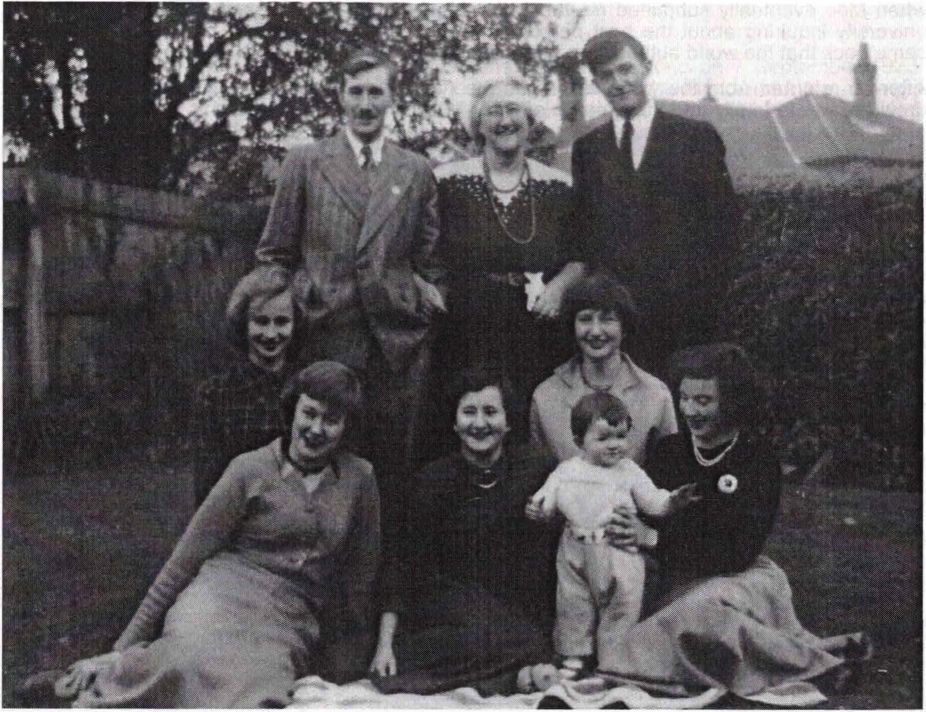
Dickins family, 1950. Left to right, standing: Mac, Lottie, Neil. Kneeling, Margaret, Joy. Sitting: Marie, Barbara, Greg, Gwen (Mac’s wife and child).
of me included the modelling and casting in wax, of exhibits such as fruit, plants and vegetables. Then I coloured them to a natural appearance. I also arranged displays in showcases and painted background scenery and props, did designs and lettering on showcases.” 22
Also working at the Museum was Bill STEWART (1922- ) whom Joy married in 1952. The marriage was dissolved in 1959. Under the Public Service regulations of the time, women were forced to resign when they married. Joy was allowed to continue until a replacement could be found, but as a matter of principle she refused to train someone to take her place. Joy left the Museum in December and Bill resigned soon after.
For a while Joy toyed with the idea of setting up a commercial pottery, but had neither the money nor the site for doing so. The couple decided to head north. They stopped in Newcastle for six months and Bill obtained work in an electric light globe factory. Joy made artefacts, which she hoped would sell, and painted churches, historic cottages and buildings. Architecture and old buildings became an abiding interest and many of the building’s Joy has painted over the years are now demolished.
Returning to Melbourne Joy worked for Guy Boyd Pottery where she created designs which she then painted or incised onto articles before they were fired. She was paid ‘piece work’. Joy specialized in Aboriginal designs and these sold well. It was during this period that Joy and Bill’s marriage broke up and Joy moved back to the Dickins house in Barker’s Rd.
In 1954 Joy applied for and obtained the position of Table-setting Consultant at the Myer Store in the city of Melbourne. She held this position until 1967. Attached to the Display Department, her job involved setting up table displays of china, cutlery and glassware, along with the flowers and decorations to go with them. Later her responsibilities extended to the manchester and furniture departments. Special displays would be arranged for Christmas, Mother’s Day, Easter and so
page 193
on, and there were promotional displays for particular manufacturers. The workload gradually expanded and an assistant was appointed to help her.
By 1967 Lottie’s health was deteriorating and she needed someone to be at home to watch over her. Sid had died in 1964 and left each of his children some money, so Joy decided it was time to resign from Myers and devote her time to her painting. In 1968 she held her first exhibition with the support of the Myer Women’s Association. Further exhibitions followed.
At different times she supplemented her income from painting by work as an assistant in Tom Roberts Gallery and Antique shop; painting signs for Smorgan’s Meatworks; working as a typist for Kew Cottages and St Nicholas Parents Association; drawing pen sketches of houses for Real Estate agents’ advertisements; and conducting art classes.
In 1981 Joy moved to North Queensland where her sisters Marie and Margaret live. Settling in Cairns Joy developed a different style of painting to suit the new environment, and a new group of friends and supporters. In 1999 a very successful Retrospective Exhibition of Joy’s work was held at the Regional Gallery in Cairns.
Her interest in old buildings has continued through her membership of the National Trust, and she has also been a member of the Cairns Historical Society, the Art Society, the Regional Gallery and the Euthanasia Society. In 1999 Joy received a Commonwealth Year of Older Persons award and in 2001 a Year of the Volunteer award for her cultural and heritage contributions to the community. She has made overseas trips to Western Samoa, South America and Mexico, India and more recently to Singapore and Thailand. Joy now lives in a Retirement Village in Cairns.
Charles McNeil DICKINS (1927-)
Second son and third child of Charlotte Robertson and Sid Dickins, born at Geelong on 23 February 1927. Named after a friend of his father’s who was killed in World War I. He has always been known as Neil.
Neil spent a short time at Geelong College before being moved to the North Shore State School. In Melbourne he attended Auburn Central, followed by Melbourne High School. After leaving school he was an active member of the Melbourne High School Old Boys Lacrosse Club and the club made good use of the Dickins house for socials and off-season tennis parties.
Neil’s first job was with the Victorian Forestry Commission working near Mt Buller as a chainman/labourer. Deciding to train as a surveyor, he returned to Melbourne and obtained an apprenticeship with the firm of Garlick and Stewart completing his articles in 1952. In 1954 he moved to Adelaide to work for Alexander and Symonds and for a time he shared a house with his sister Barbara who was also working in Adelaide.
Through work Neil met Bernice SOLOMON (1936-) and the couple married in Adelaide in 1958. They initially settled in Hyde Park, Adelaide and their first two children, Yvonne (1958) and Kerry (1960), were born while they were living here. In 1960 the family moved to Mt Gambier for Neil’s work and two more children, Morris (1961) and Brenton (1963), were born at Mt Gambier.
Neil and Bernice expected to stay in Mt Gambier for five years, but they are still there more than forty years later. Neil’s work has not always been close to home. He has been involved in investigating water flow in the channel country of Queensland; surveying the Mt Tom Price to Paraburdoo railway line in WA; the original layout for the town of Elizabeth in SA; and supervision of Alcoa Aluminum Smelter land acquisition and base line establishment at Portland, Victoria. In 1973 Neil became a Director of Alexander and Symonds and in 1986 he attended the American Survey Conference in Alaska, following the firm’s decision to become involved in the Global Positioning System mapping control for South Australia. In July 1989, after spending nine months supervising staff in the firm’s Adelaide office, Neil retired from Alexander and Symonds.
Both Neil and Bernice have been very involved in community activities, with Neil serving on the Mt Gambier City Council 1975-77. Neil has belonged to the Mt Gambier Rotary Club since 1963 and was President in 1984/85. He was Rotaract father of the Year in 1980/81 and again in 1981/82. He and Bernice have been involved in the Student Exchange program and in 1996 Neil was awarded a Paul Harris Fellowship.
Their other activities include school and kindergarten committees, the National Trust, Rostrum, the Mt Gambier Lakes Beautification Committee and Lifeline. They are enthusiastic long-term members of the Port MacDonald Sailing Club with Bernice serving as Secretary and Neil as Commodore and Handicapper. Bernice is a voluntary guide for the Engelbrecht Cave. In
page 194
1986 Neil chaired the steering committee set up to establish an Abbeyfield Retirement House in Mt Gambier. He has continued as Chairman of the Management Committee and served on the State Executive of Abbeyfield, SA. In 2000 Neil was presented with the Mt Gambier Australia Day Citizen of the Year Award.

Neil Dickins family, 1978. Left to right, back: Neil, Bernice, Morris. Front: Brenton, Kerry, Yvonne. Courtesy of The Arthur Studio Mt Gambier.
Neil and Bernice are keen nature lovers and bird watchers and their membership of the Field Naturalists Group and the Friends of Canunda and Beachport Parks has taken them on field trips throughout the drier parts of Australia. In 1976 the couple purchased a block of native remnant scrub at Carpenter Rocks and embarked on a project to preserve this natural area. They have travelled extensively throughout Australia, and on overseas trips they have visited England, Shetland, Europe and North America.
Neil attributes much of his community spirit to his mother’s influence. A newspaper article quotes him as saying: “When I was a kid [Mum] was on the Kew Kindergarten committee and realized many of the young mothers did not realize how they conceived their children. That was sixty years ago and she organized sex education and dragged me along. I was about fourteen and the only bloke there.” 23
Marie-Claire DICKINS (1928-) - married name NEMEC
Second daughter and fourth child of Charlotte Robertson and Sid Dickins, born at Geelong on 29 September 1928. Her name came from a character in a book her mother had been reading.
Marie-Claire started school with her brothers and sister at North Shore State School but after about six months she moved to the Hermitage Church of England Girl’s Grammar School. The reason her mother gave for this was that Marie had started swearing! At the Hermitage during the winter, Marie always sat at a desk near the fire, “As I always had a cold on my chest when my feet got wet, I can only presume, at this distance in time, I continually got my shoes wet walking across the paddock with the other children, as they all walked to school, and had chest problems.” 24
In Melbourne Marie attended Auburn State School. When Neil moved on to high school Marie was moved to Ruyton, a private girls’ grammar school in Kew, which her younger sisters were already attending. She continued here for the rest of her schooling and was captain of the hockey team.
page 195
Leaving school in 1946, Marie obtained work in the library of the Munitions Supply Laboratory at Maribyrnong and studied for the Australian Institute of Librarians preliminary examinations, which she passed in 1949. She moved to the Kew Public Library but found working amongst dusty books exacerbated her asthma - an affliction she has suffered with on and off, all her life.
Her next job was as a title searcher at Garlick and Stewart, where brother Neil worked. In 1951 she started three years of training as a kindergarten teacher and after graduating she worked at the Camberwell Kindergarten. A serious bout of bronchitis in 1956 made her decide she should move to a warmer climate and she was able to obtain a position at the Maranga pre-school in Darwin, commencing there in 1957. Later she taught at the Stuart Park pre-school and helped to set up the NT Pre-school Parents’ Association. She also helped to establish a youth group for older children. Marie gave up pre-school teaching in 1961 but remains a life member of the Graduate Association of the Institute of Early Childhood Development.
In Darwin Marie met George Jiri NEMEC (1925-1979) who had come to Australia from Czechoslovakia in 1950. He had been an engineering student in Prague at the time of the uprising against the communist regime. One time when I teased George about his migrant status he responded, ‘I am a better Australian than you, because I chose to be an Australian, you just happened to be born as one.’
Marie-Claire and George were married in Melbourne in 1959 and the couple settled in Darwin. George’s job as a surveyor for the Department of Works, meant periods working away from home living in remote bush camps. Sometimes Marie was able to accompany him. George was a keen photographer and a collection of his photographs is now housed in the Darwin library.
In 1973 Marie started training as an accountant, working for several employers in Darwin. She and George were in Darwin during Cyclone Tracy (Christmas 1974). Their third floor flat was almost completely destroyed and they lost many of their possessions. Immediately after the cyclone Marie was in financial control of cash payments made by the Department of Social Security to victims of the disaster. George’s department was temporarily moved to Brisbane and the couple lived there for twenty months, before moving back to Darwin at the end of 1976.
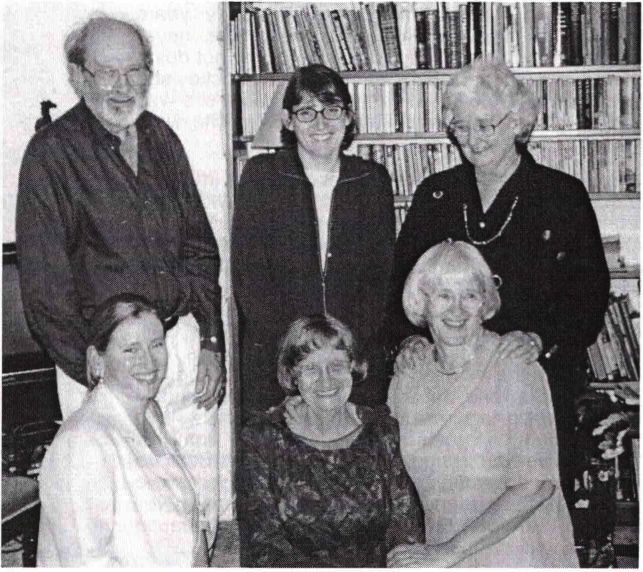
Some of the Dickins Family, 1999. Left to right, back: Neil Dickins, Lisa Worrall, Marie Nemec. Front: Jessica Worrall, Joy Stewart, Margaret Worrall. On the occasion of Joy's Retrospective Exhibition.
While living in Brisbane, Marie again had trouble with asthma and she and George decided that when George retired they should remain in the tropics as this seemed to suit Marie better. They made plans for retiring to Cairns. Unfortunately, before they could do so, George was diagnosed with cancer of the pancreas and died in July 1979. Marie decided to proceed as they had planned and she moved to Cairns in 1980.
Marie completed her accountancy exams in 1976 and after the move to Cairns she obtained work in this profession. Wanting permanent part-time work, as she had had in Darwin and which she found hard to obtain in Cairns, Marie decided to set up her own practice in 1981, working from home with seven clients. She found she had to overcome a certain amount of prejudice because she was a woman. The practice flourished and two years later she opened an office away from the house. In 1990 she went ‘electronic’ for lodgements with the Taxation Office. Marie was registered as a Local Government Auditor and did audits for a number of
page 196
shires in North Queensland between 1983 and 1994. This gave her an opportunity to visit some of the remoter parts of the State.
As a member of the Australian Society of Certified Practicing Accountants, Marie took an active part in that organization’s activities, serving as branch Treasurer, Secretary and President. She also taught accountancy students at the Cairns Business College. Marie sold her practice in 1994 with the intention of retiring. However, other accountants kept offering her work, so she continued working on a part time basis until 1998.
Marie had been an active member of the National Trust for many years, undertaking research and conducting tours of the McLeod St Pioneers’ Cemetery in Cairns. She has been involved in the preparation of several publications dealing with the history of the Cairns region and she has written a book about those buried in the Pioneers’ Cemetery.25 In 2001 she received a Commonwealth Year of the Volunteer award for her cultural and heritage work. Marie is a keen gardener with a preference for orchids and bromeliads. She belongs to the Gardening Club, Cairns Historical Society, Friends of the Cairns Regional Gallery and participates in the University of the Third Age. One of the projects for her busy retirement is taking piano lessons.
Barbara Joan DICKINS (1931-1974) - married name WILLIAMS
Third daughter and fifth child of Charlotte Robertson and Sid Dickins, born at Geelong on 6 March 1931. Named after Barbara Crouch whom Lottie had lived with for a time when she was a child.

Barbara Dickins. Passport photo taken in 1957.
The doctor told Lottie not to get too fond of Barbara, which suggests the doctor did not expect her to survive. She did survive, though she experienced frequent illness during childhood and was to die at the age of forty-three. She was small (just under five feet), pale skinned and dark haired, taking after the Cairns side of the family rather than the Robertson side. She was born with brown eyes. She had a fiery temper but this cooled down as fast as it heated up and she never held a grudge.
Because of illness Barbara started school a year late. She attended Ruyton Girls Grammar School and missed further time during the early years because of illness. However, illness was never allowed to be an excuse for missing out or not doing things, and when Barbara wanted to play hockey she was allowed to do so, even though it meant she was sometimes so tired when she got home, she went straight off to bed.
Moving to the Methodist Ladies College in 1947, Barbara obtained her Leaving Certificate two years later. Her first job after leaving school was selling encyclopaedia. At the Alfred Hospital in Melbourne she trained as a nursing sister (1951-53) and then went on to work at the Mornington District Hospital. In 1956 she was working in Adelaide for a doctors’ clinic and sharing a house with her brother Neil. Barbara was very much a night owl and always hard to get up in the morning. Neil tells of her having two alarm clocks, one put in a drawer, so she actually had to get up to turn it off. She would often sleep through both of the alarms. Another story from this time involved a missing dinner plate, which Barbara was worried about because she and Neil were housesitting for friends who were overseas. Neil had put the plate on top of the fridge but because Barbara was so short she could not see it.
The next year saw Barbara off to Europe, where she and some of her nursing friends worked and travelled. Their adventures in Spain were
page 197
documented by Mary Farrow who was little and fiery like Barbara. 26 Much to the consternation of the third member of the party (a Canadian girl), Barbara and Mary were always arguing. But this was just their way and never interfered with their friendship. Barbara’s dark looks led many Spaniards to believe she was a local, and along with her insistence that she could understand the language (which she couldn’t), resulted in some amusing incidents - including the ardour of a young Spanish swain, which Barbara did not appreciate. Her most memorable job in England was specialling ‘the General’, an aged retired army general of the traditional mould. Another job, shared with Mary, was looking after a Guest House in London. Barbara returned to Australia from Europe in July 1960.
Barbara used to get frustrated that because of her small stature, whenever she went to a party or social function, short men would make a beeline for her. She swore she would never marry anyone under six feet. However love makes other decisions and in 1961, Barbara met and married Graham WILLIAMS (1930- ) who is well under six feet. Graham was a widower with a two year old son. Barbara legally adopted Bruce, and the couple had two children together, Jennifer (1963) and Ian (1966), both by caesarean section.
Barbara and Graham moved from Melbourne to Mt Evelyn and as the children got bigger, Barbara did casual work for the local Home Help Service. She developed thyroid trouble and the doctors had difficulty adjusting her medication so that she swung back and forth between thin hyperactivity and plump depressed lethargy. On 28 October 1974 Barbara suffered a massive heart attack and Graham found her dead on the lounge room couch.
Barbara was a vivacious and gregarious person. She made friends wherever she went and though she often drove her family to frustration because of her lateness, quick temper and independent ways, her generosity of heart made up for her defects. A favourite story is about Barbara and Neil having an argument as children. Barbara threw a pair of scissors at Neil, he ducked, and the scissors went through a window. For years the blame for the broken window would be passed back and forth between them - Neil said it was Barbara’s fault for throwing the scissors and Barbara said it was Neil’s fault for ducking. The incident eventually turned into one of those family jokes, raised whenever families get together.
Graham remarried in 1977 to Mary Louise Jones (nee Smart - born 1935), a widow with two children, making a successful blended family for Barbara’s children. 27
Margaret Dawne DICKINS (1934- ) - married name WORRALL
Sixth child and fourth daughter of Charlotte Robertson and Sid Dickins, born at Geelong on 27 February 1934. Margaret is a common family name and Dawne came from the fact that she was born at dawn.
Margaret’s birth took place a matter of days after the family moved from Geelong to an old house on the Esplanade at North Shore. Unlike most of Lottie’s other children, who had been born at home, Margaret was born in hospital because she was a breech birth. Despite being only three years old when the family left the house at North Shore, Margaret has a clear memory of the house, the beach across the road and the gate to the cow paddock at the back, and had no difficulty identifying the house years later when she went looking for it.
Margaret’s primary education was undertaken at Ruyton Girls Grammar School. Two senior students who lived near by were charged with escorting Barbara and Margaret to school and home again. Margaret has a pair of beautifully illustrated fairy stories one of these girls created for her.
For her secondary schooling Margaret moved to the Methodist Ladies College in Kew, which like Ruyton, was in easy walking distance of home. School was not a happy experience and secondary school was a real struggle. Several years had to be repeated and Margaret finally matriculated only because of the faith and persistence of her mother. Lottie was always willing to do battle for her children and at different times on behalf of different children, there were disagreements with school authorities about her children’s intelligence and ability.
page 198
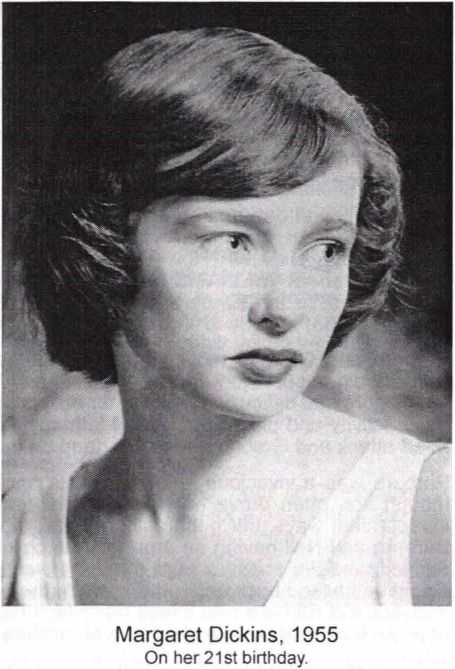
Moving on to Melbourne University, Margaret studied for the Diploma of Social Studies and a new and exciting world opened up. Study suddenly became less difficult and in her second year she was granted a Commonwealth Scholarship. This included a living allowance of £3 a week: “£1 went to Mum for board, £1 went on fares, and that left £1 for everything else! I used to do a lot of walking to save on fares and I only bought two text books the whole time I was at Uni, the rest of the time I used the Library.” Extra curricular and social activities, along with work experience and holiday jobs, broadened her horizons and went some way to giving her a confidence she had previously lacked. Margaret’s first employment as a social worker was with the Brotherhood of St Laurence in Fitzroy, where she worked for two years with a small number of families who had been rejected for re-housing by the Victorian Housing Commission.
In February 1957 Margaret married John WORRALL (1933- ) at the Barker’s Rd Methodist Church, Kew, Victoria straight across the road from the Dickins’ house. John is the older child and only son of Erlwell Worrall and Maisie Abbott. The couple met through the social activities of the MHSOB’s lacrosse club (see biography on Neil) and their friendship continued during their time at university. At the time of their marriage Margaret was working but John was still studying for his Electrical Engineering degree, and when Margaret became pregnant with their first child she kept right on working until she was seven months pregnant. John completed his course and started full time work only a few weeks before the birth of Lisa in 1958. Two other daughters followed, Tracy, born in Nauru (1959) and Jessica, born in Cairns (1963).
Margaret and John were keen to travel overseas. John obtained a position with the British Phosphate Company in Nauru, just south of the equator, and the family lived there for nearly two years. Returning to Australia, they decided there was no way they could live in crowded cold Melbourne, so John applied for and obtained a position with the Electricity Board in Cairns, North Queensland. After three years in Cairns the next move was to Western Samoa and this proved an exceptionally happy and rewarding experience. However it seemed advisable to return to Australia for the children’s education, so it was back to Cairns in 1967 and then a move to Innisfail six months later. In the first grade in Samoa when daughter Tracy was learning to read, the children used second-hand books donated by countries such as Australia and New Zealand. Half the class had ‘Dick and Dora’ and the other half had ‘Jack and Jill’. Ironically it turned out that Lisa and Tracy were well ahead of their contemporaries when they came back to an Australian school.
Like the rest of her family, Margaret became involved in community activities wherever she lived - School P&C associations, youth groups, welfare and cultural organizations, (too many to list). Her experience during an extended stay in the Innisfail hospital in 1973 convinced her that she must get back into professional social work. Added to this was sister Barbara’s death the following year. “Barbara was my dearest friend and her death was the biggest trauma I had experienced in life. I felt a need to live two lives - one for myself and one for Barbara.”
Margaret became involved in setting up a Community Advice and Information Centre in Innisfail, where welfare facilities were extremely limited. She acted as honorary co-ordinator and counsellor, and trained voluntary workers. In addition she undertook fee-for-service work for the Department of Social Security and other welfare organizations without a representative in Innisfail. For many years she was the only practicing professional social worker between Cairns and Townsville and her caseload included anything and everything that turned up on her doorstep. In Dec/Jan 1978/79 Margaret made a trip to China with a group of welfare workers.
Following Margaret and John’s separation in 1979 Margaret spent an unsettled period, travelling around Australia with her possessions in her car and getting work as and where she could. This
page 199
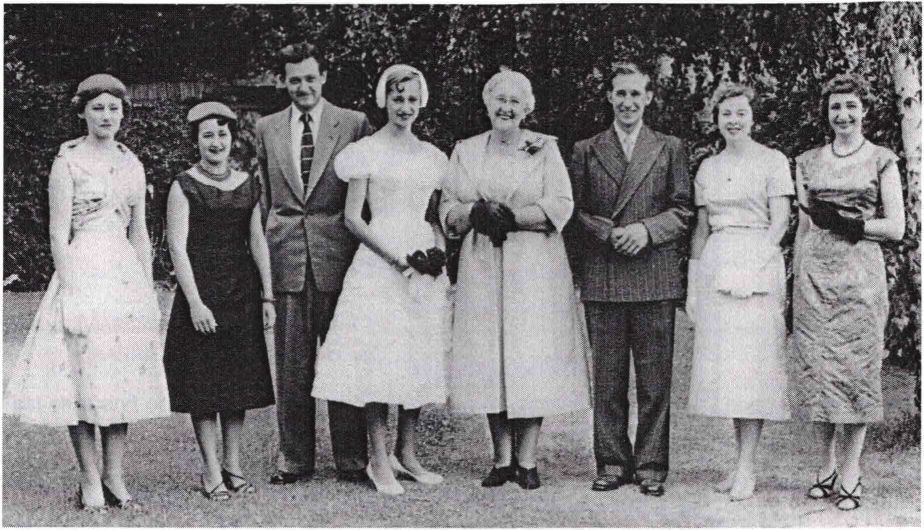
Dickins Family, 1957. At Margaret's wedding from left to right Marie, Barbara, Neil, Margaret, Lottie, Mac and his wife Gwen, Joy.
included work as a housekeeper and cook as well as personal and financial counselling jobs with the Smith Family and the Catholic Family Welfare Bureau in Canberra. Needing to settle down again Margaret returned to Innisfail in 1983 and was employed by the CAIC as a Grant-in-Aid worker with newly arrived and long term migrants living in the Mulgrave, Johnstone and Cardwell Shires. Her employment as a social worker in various capacities continued until her retirement in 1994 when she was made a life member of the CAIC (now called the Community Support Centre). As a member of the Australian Association of Social Workers, Margaret was the field practitioners’ representative and vice-chairperson on the Board of Studies in Social Work at James Cook University from 1985 to 1988.
Retirement did not mean the end of Margaret’s involvement in welfare and community affairs. Training and mentoring professional and voluntary welfare workers have been a continuing activity. For three years Margaret served on the Qld Older Australians’ Advisory Council, an advisory body to the Commonwealth Minister responsible for Aged Care Programs. In 1998 Margaret received a Commonwealth Year of Older Person’s award for work in establishing local services for the victims of domestic violence. She is currently a member of the State committee responsible for allocating the Queensland Premier’s Awards for Seniors.
Margaret has inherited the family skill with sewing, knitting and handicrafts. She writes poetry and stories for family and friends and is a keen if somewhat erratic gardener. However her main interest throughout her life has always been people, people, people - with all their mysterious ways and guises. Margaret still lives in Innisfail and is responsible for chasing up family connections and stories about her Robertson relations. “Life is full of ups and downs, but on the whole it is pretty fantastic”.
1 Sid divorced Lottie in 1943. His marriage to Lottie's niece caused a long lasting split in the Robert Robertson family. See Lottie's biography in Chapter 18.
2 Henry Volk was the lacrosse coach at Melbourne University in the 1950s when my husband, John Worrall was captain of the University lacrosse team. So I also knew Henry Volk.
3 Henry Volk was the lacrosse coach at Melbourne University in the 1950s when the my husband, John Worrall was captain of the University lacrosse team. So I also knew Henry Volk.
4 Interview with Stuart Robertson, March 2000
5 Interview with Bob and Mary Robertson at Yass, March, 2000
6 Interview with Bob and Mary Robertson, March 2000
7 The two tapes are available to the public on-line - http//203.20.62.215/education/rr.htm. I hold copies of the Yass Tribune article mentioned above, Rutherford's entry for the 17th edition of ‘Who’s Who in the World', an article about him printed in the 1996 Annual Report of the Cambridge Australia Trust, and copies of obituaries published in several newspapers.
8 Information about Ian's life comes from his brother Rod and the records of his RAAF service.
9 Letter from Rod Robertson, 25 10.2002
12 Interview with Pixie Robertson, March 2000
13 Interview with Pixie Robertson, March 2000
14 Telephone conversation with Rod Robertson followed up by a letter, September 2002
15 Taped interview with Rod, Lucy and Pixie Robertson, March 2000
16 Mr Bennett was a long-term associate of the Robertsons and had known them in Geelong,
17 Interview with Rod and Lucy Robertson, March 2000
18 Letter from Rod Robertson, 25.10.2002
19 Matthew Magilton is also a member of the MG Club
20 The following account of Locky’s life has been pieced together from his wife’s eulogy, written by son Bill, which was provided by Bill Robertson in July 1999. Quotations are taken from the Eulogy. Unfortunately I have lost contact with Bill and have not been able to have him check what I have written.
21 A fuller description of Joy’s life and work is contained in M. Muecke, ‘Done By Me - The Art and Memoirs of Joy Stewart’, published in Cairns for her retrospective exhibition at the Cairns Regional Gallery in 1999
22 M. Muecke, 'Done By Me - The Art and Memoirs of Joy Stewart', p.29
23 ‘The Border Watch’, 11 January 2000, p.9
24 M Nemec, November 2000
25 M. Nemec, ‘A Walk Through the McLeod St Cemetery', Self published, Cairns, 2002
26 M. Farrow, ‘Spanish Interlude'
27 Mary’s first husband was Ron Jones and they had two adopted children, Anthony Peter -b. 31.12.1962, and Julie Marianne - b. 8.8.1964. After Mary’s marriage to Graeme both Tony and Marianne took the name Williams.
page 201
Beryl Margaret HORMAN (1928-) - married name OAKES
First child and only daughter of Margaret Robertson and William Horman, born at Camberwell, Victoria on 25 July 1928.1
Beryl tells a story of her teenage years when she and Marie Dickins (daughter of Lottie Robertson Dickins) went to the pictures together. When they got home they were asked what they thought of the film. Together they replied, 'It was lovely, we cried all the way through’. Frustratingly neither Beryl nor Marie can remember the name of the film!

Beryl Horman and Jim Oakes On their wedding day 27 February 1954.
Beryl trained as a teacher at the Kindergarten Training College in Kew, and worked as a teacher and kindergarten director for five years before her marriage. Beryl was in her first year out of College, working at a kindergarten in Collingwood, when her mother unexpectedly died in 1949. The two had been very close and Beryl felt the loss deeply.
Beryl met James Stanley OAKES (1916- ) through relations of Jim who lived next door to Beryl’s family in Camberwell. The couple married in 1954 in a service at which the Rev Robertson McCue, a cousin of the bride’s mother, was one of the officiating ministers. Jim was a farmer, the youngest of four boys born to James Oakes and Eliza Florence Carnell of Nathalia in central northern Victoria.
After their marriage Beryl and Jim lived on the family farm, which has been in the Oakes family since 1874 when Jim’s grandfather, William, selected the property. Although the property was divided so that Jim and Beryl had their own farm, life was not always easy for the young couple, particularly as Jim’s mother was used to running things. Beryl became very involved in country life. She has been a member of the Country Women’s Association for over forty-six years, a community representative on the Australian Assistance Plan committee in the
page 202
1970s, and community representative on the Country Education Program for twelve years up to 1987. She served as district commissioner for Girl Guides, followed by a term as divisional commissioner. In 1963 she began working for the establishment of a kindergarten in Nathalia and served on the management committee for thirteen years. In 1977 she took on the job as director of the kindergarten and held this position for seventeen years. Beryl, Jim and their son William have all been made life members of the Kindergarten Association.
Jim and Beryl have also been involved with the Agricultural Society and Jim is a Past President of the Victorian Farmers Union. He is a life member of the Rural Fire Brigade and received the Queen’s Medal in 1988 for fifty years service to the RFB. He has been a Mason for over sixty years. Both are active in the Uniting Church (and previously the Methodist Church), where Beryl has worked as a Sunday school teacher.
Sadly, Beryl and Jim lost two children, William James who lived for a month and Peter John who was stillborn. Their third son, also called William, but generally known as Bill, was born in 1961. Bill lives in Nathalia township, is married and has two children. Since 1978, when Bill left school, the farm has operated as J S and B M Oakes and Son, with everyone working well together. Part of the farm is irrigated and used for dairying, and the dry country is used for crops - wheat, oats, barley and hay. In 1998 Beryl and Jim retired and the farm was transferred to William. Beryl and Jim continue to live in the homestead and Jim still helps Bill on the farm. Jim is very proud that their farming methods have moved with the times and takes pleasure in showing people around the farm.
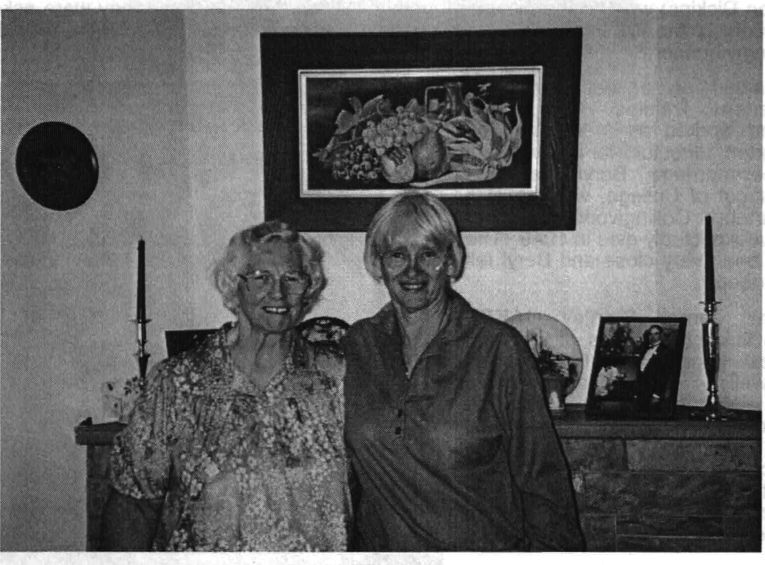
Beryl Oakes with Margaret Worrall, Nathalia 2000. The still life above the mantle piece was painted by Beryl’s mother.
William Robertson HORMAN (1932-)
Younger child and only son of Margaret Robertson and William Horman, born at Dimboola on 11 November 1932. He is known as Jock among family members, a nickname given to him as a child by his mother to save confusion with his father. Also know as Bill and Will.2
William’s primary education was undertaken at a State School and his secondary education at Carey Grammar School in Melbourne. After leaving school he joined the Victorian Railways as an apprentice electrical fitter. Two years later he was awarded a scholarship by the Railways to study electrical engineering at the Royal Institute of Technology. The rest of his working life
203
was spent with the railways, undertaking different aspects of rail engineering. He represented the Railways of Australia Committee at the Australian Standards Committee meetings for twenty years and in 1980 he was selected as the Australian delegate to the general meeting of the International Electrotechnical Commission in Stockholm, Sweden. After almost forty-seven years with the Victorian Railways William retired in December 1996.
A keen sportsman, William represented his school in football, cricket and athletics. Concentrating on hockey after he left school, he represented Victoria at the Australian Hockey Championships from 1954 to 1965. When veteran hockey was started he represented Victoria for another sixteen years, moving up through the age groups. In 1987 he was selected to play for Australia in the over-fifty team to tour Malaysia and Singapore. He was made a life member of the Camberwell Hockey club in 1994 and although he retired as a player in 1997 he still maintains an active interest in the sport.
In 1959 William married Janice MUNRO (1935-) at the East Camberwell Baptist Church, where the couple had first met in 1952. Janice and William have three children, Colin (1960), Malcolm (1963) and Catherine (1969).
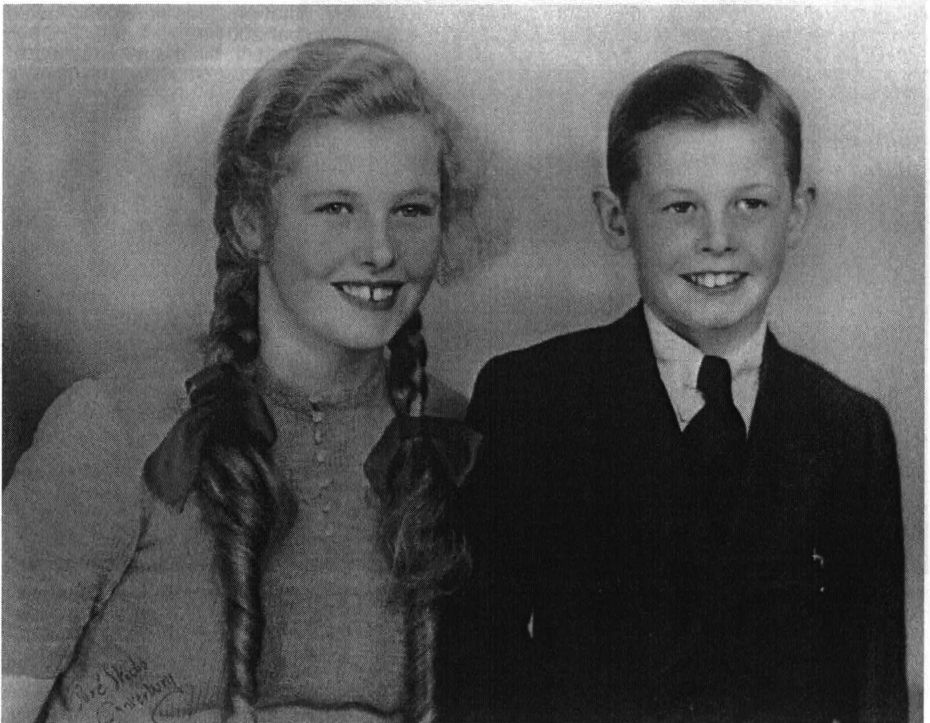
William Horman with his sister Beryl, circa 1943
Janice was a secretary before her marriage and after the children left school she returned to the workforce and was employed in an educational bookshop. After retiring in 1994, Janice devoted her time to her grandchildren, gardening and learning Italian.
page 204
Maurine Estella TUNKS (1928-) - married name PORT
Eldest child of Adie Robertson and Roy Tunks, born at Kew, Victoria on 12 December 1928.
Maurine gives us a glimpse of life as a child during World War II, as well as the musical tradition that runs through Robertson descendants. In December 1941 Maurine’s youngest sister Jocelyn was born, “just three weeks after the Japanese attack on Pearl Harbour - anxious days with rumours that hospitals would be a target if Melbourne were attacked - everyone relied on newspaper reports at the time.”3
In an earlier section we are told that Maurine’s mother Adie sang the ‘Messiah’ at Christmas time with the Royal Melbourne Philharmonic Choir. “Some 30 years later in the 1950s, I [Maurine] too sang with the same choir when performing Handel’s ‘Messiah’ conducted by Sir Malcolm Sargent. Yet another 30 years later our son Graeme and I were singing the Messiah’ with the Caulfield City Choir!! The inherited love of music and singing lives on.”4
Maurine worked as secretary to the Manager of Prince Henry’s Hospital in Melbourne for twelve years.
In April 1961 Maurine married Stanley PORT (1921-2001) in a service held at the Moorabbin Church of England with her father presiding. Stan was an accountant. The couple have two children, Graeme (1962), and Jennifer (1964).
In retirement Maurine and Stan undertook voluntary work with Meals on Wheels and Maurine still does voluntary work with the Moorabbin Benevolent Society that provides emergency relief and other welfare services for those in need. Stan died in December 2001.

Descendants of William Adie Robertson, Melbourne 2000 Left to right: William and Jan Horman, Maurine and Stan Port, Jenny Munro, Kieran and Graeme Port.
1 Details of Beryl’s life compiled from an interview with Beryl and Jim in April 2000 and follow up correspondence
2 Details about Jock's life were provided in letters
3 Letter from M. Port, 21.7.2001
4 Ibid.
page 205
Living in a subsistence economy, Shetland crofters not only had to supply themselves with food, through agriculture and fishing, they also had to provide their own shelter and clothing. Shetlanders were practical people. They had to be to survive in their harsh environment where raw materials were limited.
 sAnyone visiting Shetland is immediately struck by the stone fences stretching for kilometres across the landscape, and the beautiful use of stone in buildings.
sAnyone visiting Shetland is immediately struck by the stone fences stretching for kilometres across the landscape, and the beautiful use of stone in buildings.
Arriving in Australia the Robertson men used their skills as stone masons to earn a living, participating in the erection of dry stone walls and buildings. Many of these are still standing in the Western District of Victoria.1 Womenfolk went along as cooks, and children were expected to help. Childhood as we know it today had not yet been invented.
Like other settlers, the Robertsons built their own homes from whatever materials were available to them and after taking up ‘selections’, land had to be cleared and crops planted as quickly as possible. Until the farms became established or during times of hardship, such as the depression years of the 1890s, men frequently worked away from home, leaving the women to tend the children and look after the farms, just as women in Shetland had done.
When gathering information for the chart of Robertson descendants I asked people to include occupations. It is interesting to see how many have made, and still make, their living from hands-on occupations such as farming, mechanics, carpentry, dressmaking and handicraft activities. The alternative lines of occupation are more academic and/or service related - church ministry, teaching, nursing and science. Very few of our relations have gone into commerce.
In the early days, employment outside the home for women was limited to domestic work, but taking in boarders was another way of supplementing their income. Quite early on some of the Robertson women became teachers, either in schools or as teachers of music.
My personal interest in handicrafts has prompted me to take note of the handicraft skills that have come down through the women in the family. Both Agnes and Margaret Robertson are listed as 'knitters’ on the manifest of the ship, which brought them to Australia in 1867. Shetland wool and Shetland knitting is famous, and there was an export trade in knitted goods as early as the sixteenth century. In the seventeenth century “there developed a considerable trade with Dutch herring fishermen, and before their arrival at Lerwick each summer large quantities of stockings, gloves and nightcaps were made ready.”2
Although the women did most of the knitting, men also knitted, and knitting became an important source of additional income for the crofters, with the articles they produced being sold or used for barter. Everything that would cover a person from top to toe was knitted, including warm undergarments. Knitters on the island of Unst produced shawls of “gauze like delicacy - so light that a full-size article weighed two ounces [approx. 57 grams]”.3 Another book describes shawls made from hand spun woollen thread as fine as a hair. These shawls took anything up to a year to make. “The fineness of this work enables even large shawls to be pulled through a wedding ring.”4
Somewhere I have read that when drowned seamen were washed up on the shore, the place they came from could be identified by the pattern of the knitted garments they were wearing. These days the traditional patterns from Fair Isle, Fetlar, Yell and other parts of Shetland are copied, imitated and mass produced all over the world. However knitting is still an important industry in Shetland, although much of the work is now done by machine. When I was in Lerwick in May 1997, I went into a shop, which was stacked from floor to ceiling with knitted articles. 'My goodness,’ I asked, ‘will you sell all these?’ ‘They will all be gone by the end of the summer.’ replied the salesperson, ‘We knit all winter and sell it in the summer.’
There are wonderful old photos of Shetland women knitting as they carry kishies (baskets) of peat on their back. Bent against the weight of the load they hold their needles at waist level and they appear to be using the ’European’ technique with both needles (wires in Shetland terminology) held below the wrist. I have read about a leather knitting pouch, which was strapped around the waist and used to hold the needles in position, but so far I have not been able to find a description of just how this functioned.
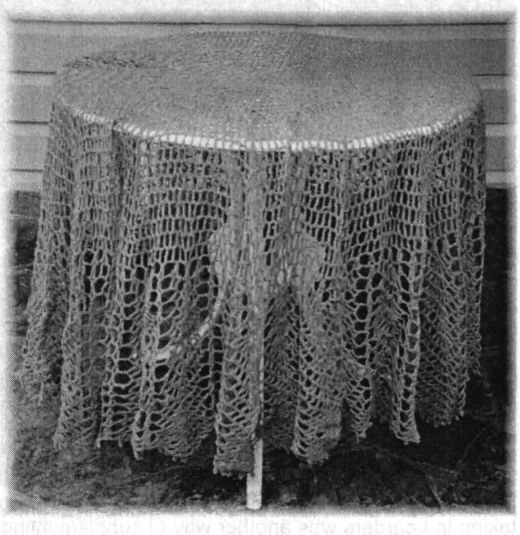
Shawl made by Nan Robertson circa 1950. >
This same underhand knitting method may have been used by Molly Cairns Robertson, for her granddaughter Mary wondered how she could ‘see’ what she was doing as she knitted patterned socks, the wool tucked into her belt and the needles held beneath her ample bosom.5 Several people have spoken of Margaret Henderson knitting a pair of socks in a day - one before lunch and the second sock during the afternoon. My mother Lottie was a great knitter and did beautiful crochet work, and her sister Nan supplemented her income by selling her handiwork. If Mum found my sisters or me sitting about ‘gazing into space’, we would be handed some knitting and instructed, ‘Here, do a few lines of this while you are sitting there.’
Time must not be wasted!
Like music the theme of handicrafts comes through in the stories I am told about Robertson female descendants and in the potted biographies you will find reference to the handcraft skills of individuals. Adie Robertson Reudavey was a judge of handicrafts for the Royal Perth Show and the rural show circuit in Western Australia. Her sister Mollie (Mary Linda Gillard) was a professional dressmaker, designer and tailor. Other members of the family have turned their skills to woodworking or the fine arts, becoming painters and artists.
1 J. Black, 'If These Walls Could Talk', provides detailed information about the construction and location of dry stone walls in the Corangamite areas of Victoria's Western District.
2 J.R. Nicolson, 'Traditional Life in Shetland', p.99
3 J.R. Nicolson, 'Traditional Life in Shetland', p.99
4 M. Smith and C. Bunyan, 'A Shetland Knitter’s Notebook’
5 Interview with Mary's son, Richard Dickins, April 2000
page 207
One of my mother's many sayings was - “The way to hell is paved with good intentions”. I have to admit that throughout my life there have been more than a few good intentions that have got lost along the way. I am glad to say this story of the descendants of Margaret Henderson and Arthur Robertson in Australia is one good intention that did not get lost because it is founded on a promise rather than a good intention.
When I visited Shetland I felt quite overwhelmed by the friendliness and assistance offered to me by members of the Shetland Family History Society. Thelma Watt was particularly kind, showing my travelling companions and me around and inviting us into her home. She told me that the Society has inquiries from all over the world by people trying to trace their Shetland ancestors and sometimes they are able to put distant relations in touch with each other. In a rash moment I promised her that when I returned to Australia I would chase up the descendants of Margaret Henderson and Arthur Robertson and send back some details to the Society. It is easy to be generous when you don’t know what it is going to involve, for having been somewhat separated from my mother’s family for most of my life I had no idea just how many relations I had out there or the size of the task I was taking on.
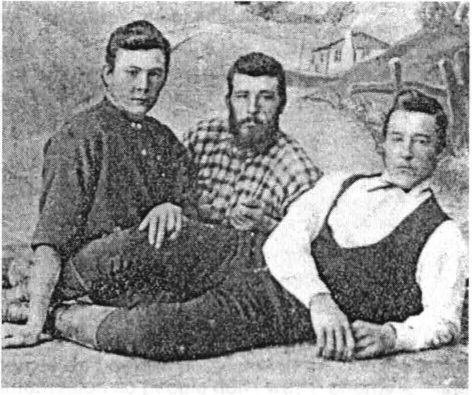
William Adie, Arthur Jnr & Robert Robertson >
Taken in 1874, they were aged respectively 16, 27 and 21 years.
In this photograph the Robertson broad hands with long fingers are apparent.
The research I have done means I probably know more than any other individual about the ins and outs of our family. I have already told you about some of the common themes that run through the family such as music and handicrafts. As well as these I have come across unexpected similarities in appearance and mannerisms in second and third cousins. For example there is something about the way Gus Ward tells a story that reminds me very much of my mother Lottie and one of my grand daughters has the same look I see in a photo of one of the Chiselett descendents. One of my daughters drew my attention to ‘Robertson hands’, which are visible in some of the photos. These are large square hands with long fingers. I now make a point of asking relations to show me their hands.
Something I certainly wasn’t looking for but which became apparent as I travelled around visiting relations, is a shared sense of humour. I don’t know whether there is a gene that determines our sense of humour, but I do know the way humour and irony are expressed and understood differs from one person to the next and from one nation to another. It is great being able to laugh about the same things with so many of my Robertson relations.
I was definitely looking for shared physical weaknesses as I had always been told the Robertsons have ‘weak chests’ and heart trouble, while my father’s family were more likely to die from strokes. Reading through the biographies you will find a lot of chest complaints mentioned - tuberculosis, asthma, emphysema and bronchitis. The other common ailment is arthritis. Heart disease is there but so is cancer, diseases that affect the whole population as we live longer than most of our forebears managed to do.
page 208
Looking through the charts you will notice the frequency with which twins appear. Whether this frequency is greater than in the general community I do not know.
There is still a lot I do not know about the descendants of Margaret Henderson and Arthur Robertson. I have not been able to trace some people and others I have written to have not answered my letters. There have been stories and minor scandals hinted at, which people have chosen not to share with me, and other cases in which people have taken me into their confidence but asked me not to publish what they have told me. As a social worker of long standing I am not surprised that arguments and lack of understanding have sometimes led to rifts and chasms of separation between family members. I am however saddened by these rifts, for if we cannot get on with and be tolerant toward our relations, how can we expect nations to get on with each other. I am not a Christian but I have obviously inherited some the family’s evangelical spirit and desire to make us all better people in a better world.
Maybe some of the missing relations will turn up as a result of this publication. And reading about the joys and difficulties others have experienced and dealt with, may help some of the younger members of the family recognize that each generation has its problems and ways of doing things, and their job is to get on and deal with their lives as best they can.
For the moment my journey through the family has come to a halt. Of course the story itself has not ended and those who follow will have another series of stories to tell.
Margaret Worrall
Innisfail, December 2002
page 209
Code and Abbreviations
The design of the genealogical charts is one I have devised for my own convenience and to suit the needs of our particular family. It is not related to any standard genealogical code.
Margaret Henderson and Arthur Robertson are classified as ‘A’, being the original couple coming to Australia from Shetland in the 1860s.
B = the next generation, ie: Arthur and Margaret’s children.
C = their grandchildren and so on for each successive generation.
B3 against James Robertson means he was the third surviving child of Margaret and Arthur.
B6 against Arthur Robertson Jnr means he was the sixth surviving child of Margaret and Arthur. SR = Shetland Records.
SFHS = Shetland Family History Society.
FN = the file number in Australian State records of birth, death and marriage, which is useful if anyone wants to obtain a copy of a certificate.
Family name (ie. surname) used by each individual is written in capitals.
Underlining of a given name or a name enclosed in a bracket following given name, indicates a commonly used name when this is different to the first given name. When married women continue to use their maiden name or for some reason surnames have been changed, I underline the used name.
b. = date and place of birth.
d. = date and place of death (and where buried in some cases), o. = occupation/s.
m. = marriage, including date, place and name of partner.
ml and m2 are used if there is more than one marriage.
Parentheses ( ) below marriage details gives the known information about partners.
mdf. = long term defacto relationship with the names and details presented in the same way as for legal marriages. It is important to have this information so people don't waste energy looking for marriage certificates that don’t exist. Date for the commencement of a defacto relationship (and separation) is included when this is known.
Some people have asked me to use the term fiance instead of defacto. I have rejected this on the grounds that fiance implies an intention to marry and does not necessarily mean the couple is already living together. Many defacto couples do not intend to marry. Another suggestion was common law spouse. I decided to stick to defacto marriage.
partner = long term same sex relationship.
divorce = divorce and date if known.
page 210
An asterisk (*) beside a person’s name means data has been checked by this family member. Note for American readers:
The Australian way of writing dates is used with the day followed by the month, followed by the year. This means the 27th of February 1934 is written as 27.2.1934.
I: Chart of Descendants of Agnes Robertson
II: Chart of Descendants of James Robertson
III: Chart of Descendants of Arthur Robertson Junior
IV: Chart of Descendants of Margaret Robertson
V: Chart of Descendants of Robert Robertson
VI: Chart of Descendants of William Adie Robertson
VII: Table of Descendants of Margaret Henderson & Arthur Robertson
page 293
Family stories passed down through Charlotte Robertson Dickins and Marjorie McCue Mathieson indicate that a Shetland Manson relative was a crew member on the ill-fated expedition to find the North-West Passage from the Atlantic to the Pacific Ocean, led by Sir John Franklin. The names of crewmembers on the two ships of the expedition, ‘HMS Erebus’ and ‘FIMS Terror’, are listed on the Franklin memorial in Waterloo Place, London. The most likely candidate as a relation is Able Seaman Magnus Manson, aged 28, who served on ‘HMS Terror’. Like many other volunteers for the expedition, Manson was newly enlisted in the Royal Navy.
Marjorie Mathieson writes in 1999, “Lady Franklin wrote to our family on more than one occasion (at Xmas etc) but the letters were lost in a house fire.”1 Marjorie’s understanding is that Magnus Manson was a brother of Barbara Manson, however the record of her siblings given to me by the SFHS does not substantiate this.
'HMS Erebus’ and 'HMS Terror’ had already been used for Polar exploration taking Sir James Ross’ expedition to the Antarctic - 1839 to 1843. During that trip the ships stopped at Van Diemen’s where Sir John Franklin was serving as Governor. Franklin had had an earlier association with Australia. When he was seventeen he had sailed with his cousin Matthew Flinders during his epic circumnavigation of Australia. Captain Francis Crozier, who captained the ‘Terror’, had been Ross’s second in command during the Antarctica expedition.
After being completely refitted and strengthened, the ‘Erebus’ and the ‘Terror’ left Woolwich (London) on 12 May 1845, and reached Stromness in Orkney on 6 June. Here two members of the crew (unnamed) were given leave to travel to Kirkwell, one to visit his wife, whom he had not seen for 4 years; the other to visit his mother, whom he had not seen for 17 years. From Orkney the ships headed towards Greenland via Rona, stopping at the Whalefish Islands near Disco (Disko) Island, on the west coast of Greenland, and departing on 12 July 1845. The last contacts with the ‘Erebus’ and the ‘Terror ‘were by two whalers in Baffin Bay east of Lancaster Sound, in late July.2
The fate of the expedition can only be conjectured from evidence found years later. A large number of rescue parties were sent out in the 1850s to search for survivors. The government sponsored some of these. Others were privately funded. No survivors were found. A party led by McClintock and Hobson (1857-59) was the most successful, finding the only written evidence of the fate of the expedition. At Victory Point, Hobson found a cairn containing two notes written on the same piece of naval record paper, one written on 28 May 1847, the other on 25 April 1848. The first message gave some details of the expeditions journey to date and stated -‘All well’. The second message detailed the location of the ships when they were abandoned, the intention of the surviving crew members to head for Back’s Fish River several hundred miles away on the American mainland, and recorded the death of 9 officers and 15 men. Franklin was the only one named. He died on 11 June 1847. Following Franklin’s death, Captain Crozier took command.
page 294
After spending the winter of 1845/46 on Beechey Island - where the graves of 3 crewmembers were discovered in August 1850 by Captain Penny - Franklin travelled south. The route he took is uncertain. North of King William Island in Peel Sound at a point 70°N, 90°W, the 'Erebus’ and ‘Terror’ were beset by ice from 12 September 1846 onward. The ships were abandoned on 22 April 1848. The nearest white settlement was over 1000 miles away and apparently the 105 surviving members of the party hoped to reach safety by ascending Back’s Fish River by boat. Flobson found one of the abandoned boats containing two skeletons, tools and other equipment; near a place he named Cape Crazier. Other relics were retrieved from Eskimos.
It seems certain that all members of the expedition had perished well before the first search parties were sent out. Stories told by Eskimo inhabitants suggest that only about 40 of the crew got as far as the Canadian mainland. Expeditions searching for further evidence and relics continued until the 1880s and beyond. Much of the impetus for the rescue efforts and search parties came from Lady Jane Franklin. She and her niece, Sophia Cracroft, spent time in Shetland and Orkney in July/August 1849, hoping to hear news of the expedition from whalers returning from Davis Strait.3 In 1952 members of the Canadian Airforce found a depot of supplies left by Franklin’s expedition.4
So what went wrong? Between 1981 and 1986 scientists from the University of Alberta, Canada, led by Owen Beattie a forensic anthropologist, conducted a series of expeditions looking for the remains of members of the Franklin’s expedition in an effort to learn more about the cause of their deaths. Beattie worked on the belief that it was unusual in the middle of the 19th century for a well-equipped expedition of hand picked men to have such a high death rate, particularly among officers - 24 out of a total complement of 129 were dead before the ships were abandoned in May 1848. Looking for burial sites and human remains, between where the ships were abandoned off King William Is and Back River, little was found. However the scientists were able to identify section of a skull and other bone fragments collected at Booth Point on the SW tip of King William Is. These were identified as a Caucasian male aged in his early or mid twenties. The bones gave some indications of scurvy. On analysis back in the laboratory, the bone fragments were found to contain extremely high levels of lead. As a follow up Beattie obtained permission to exhume the bodies of the three men who died early in the expedition and were buried on Beechey Island. Because of the harsh conditions this had to be done over several seasons. ‘Frozen in Time’ tells the tale of the exhumations and their findings.5 I believe a television documentary I saw some years ago was also about Beattie’s work.
The bodies of John Torrington, John Hartnell and William Braine were almost perfectly preserved by the cold conditions. They were reburied in their original graves after autopsies were conducted and body samples taken. All three bodies showed high lead levels and scientists were able to assess that this would have been obtained during the last months of their lives rather than earlier contamination in England or wherever. The bodies were extremely emaciated and indications of TB and pneumonia were present. It was probably pneumonia that finally killed them but lead poisoning would have been a factor in reducing their resistance and causing the emaciation.
Beattie was also able to collect samples of food tins the expedition had left behind on Beechey Island and analysis of these indicated that as well as lead solder being used on the inside of the tins, severe defects in the soldering process would have probably resulted in contamination of the contents. His conclusions are that the disastrous fate of the expedition was largely caused by lead poisoning, which would have affected both the physical and mental condition of the crew. He suggests the high ratio of death among officers, as compared to ordinary sailors, can also be explained by the lead findings.
“If the officers, a rigidly separated and very aloof class, even during long confined expeditions, were using their pewter tableware and eating a preferential food source (i.e. proportionally more tinned food), they may have ingested much higher lead than the other seamen. As for those men who died during the tragic death march in the spring and summer of 1848, some may have exhibited classic symptoms of poisoning, such as anorexia, weakness and fatigue, and paranoia, which would have compounded the effects of starvation and scurvy. Other crewmen may not have shown obvious effects of the poison, perhaps because of differing diets and physical response to the lead.”6
page 295
A second factor that probably contributed to the disaster was the timing of the expedition, which coincided with one of the least favourable climatic periods in 700 years, when the sea ice was extremely thick and would not have melted in the summer.7
A slightly different hypothesis is proposed by Scott Cookman following his research into Admiralty records and the canning processes used by Stephen Goldner who supplied canned food to the Royal Navy.8 Cookman makes out a good case for the contamination of the tinned food with botulism and/or other toxic organisms. The canning of food was still a relatively new process and despite patenting a new canning process in 1841, Goldner methods had much to be desired. Quite apart from the poor application of hygiene in the preparation of food, it would appear that the tins Goldner used were subject to defects. The Admiralty stipulated 1,2,4 and 8 pound tins for the meat, vegetables and 1 pound tins for soups9, but in the time available it would have been almost impossible for Goldner to have the requisite number of small cans made (they were made by hand). Besides it was cheaper for him to use large cans (up to 10 pounds). The larger size cans required longer cooking times for the contents to be cooked right through and any organisms destroyed. It seems unlikely this was done, again because of time factor between when tenders were let and the goods had to be delivered. As it was Goldner delivered nothing on time and some supplies arrived only the day before sailing. It is therefore unlikely that the cans were carefully inspected and even if they had been it would have been too late to find an alternative supply.
In the early part of the voyage cooking would have destroyed toxic organisms but as time went on and coal supplies started to dwindle food may have been eaten raw. This would account for an increase in deaths after the May 1847 message was written. Botulism was not known at the time and the expedition’s doctors would have been mystified by sudden and quick deaths (about 3 days) caused by this organism. Seems to me the fate of the Franklin expedition was probably brought about by a combination of the factors described by Beattie and Cookman
I have a full list of the 129 members of the Expedition.
1 Letter from M Mathieson, April 1999
2 Basic details about the expedition are taken from R. Owen, The Fate of Franklin’
3 N. Kendall, ‘With Naught But Kin Behind Them’, p.165
4 B. Keating, ‘The North West Passage’, p.85
5 O. Beattie and J. Geiger, ‘Frozen in Time’
6 Ibid, p 162
7 O. Beattie and J. Geiger, ‘Frozen in Time’, p.72
8 S. Cookman, 'Ice Blink'
9 Ibid, p.114
page 297
Children of John McCue and Margaret McDonald, who are understood to be the half siblings of Michael Grace McCue.
Patrick McCue - born 1 January 1835. Emigrated to America and is believed to have had a daughter who was blind.
Thomas McCue - born 13 August 1837. Remained in Ireland and is the Grandfather of the family Marion Parker met in 1968.
William McCue - born 18 September 1839. Died at the age of 14 years.
Martin McCue - born 6 April 1842. Emigrated to the USA but later returned to Ireland.
Briget (or Bridget) McCue - born 10 June 1845. Emigrated to America.
This list was obtained from Jeff McCue.
page 299
There are a number of links between these families spanning several generations. The following might help to sort this out. I hope I’ve got this right! Where possible I have explained the links when they appear in the genealogical charts of descendants.
Jane Mathieson Robertson, the wife of William Adie Robertson, is the Great Aunt of Archie Mathieson who married Marjorie McCue. Majorie is the granddaughter of William’s sister, Agnes Robertson McCue.
Robina (Bean) McCue married Henry Le Couteur, who was the brother of Annie Le Couteur Mathieson. Annie was the mother of Marjorie McCue Mathieson’s husband, Archie. One of Henry’s brothers was Archie Le Couteur.
Archie Mathieson’s aunt, Margaret Mathieson, married George Croft who was a cousin of the Croft brothers who married two of Margaret Robertson Chiselett’s daughters. Margaret Robertson Chiselett was a sister of Agnes McCue and William Adie Robertson.
Barbara McCue Crouch’s husband, Edwin Crouch, was the cousin of Tot Collins who married Barbara’s brother, Jack McCue.
William Crouch, the son of Barbara McCue Crouch, married Bessie Le Couteur. Bessie was the daughter of Archie Le Couteur. Archie’s brother, Henry Le Couteur, married Bean McCue. This means that two cousins (Marjorie McCue Mathieson and William Crouch) married two Le Couteur cousins (Archie Mathieson and Bessie Le Couteur).
Robina McCue Le Couteur’s son, Stuart Le Couteur, married Mary Mathieson. Mary is the daughter of Ainger Vincent Mathieson and Ethel Williams of Nullawarre and a first cousin of Archie Mathieson who married Marjorie McCue.
Mr and Mrs Archibald Mathieson Snr are mentioned in Robert Robertson’s 'The Port Campbell Revival’, written in 1937.
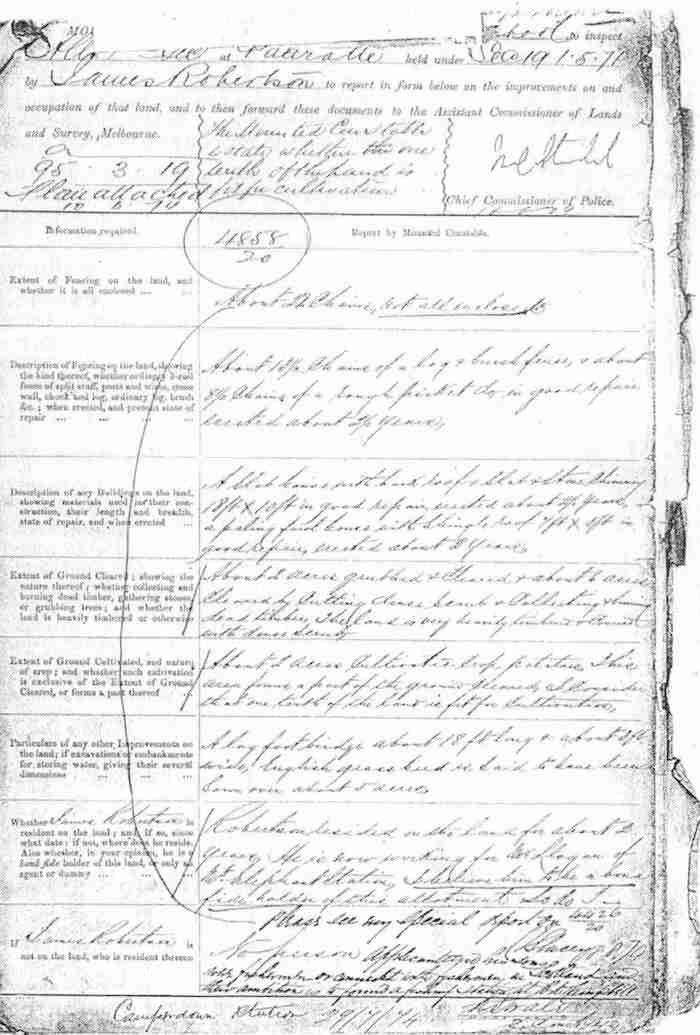
page 303
My mother, Lottie Dickins, used to play the following action rhyme with my siblings and me when we were children and I have passed it on to my children and grandchildren. As each part of the face is mentioned it is touched with a finger, finishing with a gentle flip of the hand off the top of the head. I was delighted to discover when reading John Nicolson’s Traditional Life in Shetland (p.156), that the rhyme comes from my Shetland heritage.
Garry Gillard in Western Australia knows a slightly different version of the same rhyme and both our versions differ from John Nicolson’s. Presumably our versions have become corrupted as they have been handed down by word of mouth.
Margaret Worrall’s version:
Chin chin cherry
Mooth mooth merry
Nose nose nappick
Ey perri winkle
Brew brew brattick
and a tip off the attic
Garry Gillard’s version:
Chin chin cherry
Mouth mouth murray
Nose nose droppy
Eye penny winky
Brow brow braddock
Tip over nappock
John Nicolson’s version:
Chin chin Cherry
Mooth mooth merry
Nose nose nappie
Eye eye blinkie
Brow brow brackie
An wa ower da tappie
page 304
Another rhyme printed in Nicolson’s book, which my mother also used with us, is designed to get a small child to open its mouth when being fed:
Knock at the door (tap the forehead)
Peep in (two fingers placed beneath the eyes)
Lift up the latch (press the nose)
and walk in (put a spoonful of food in the child’s mouth)
This is almost identical to Nicholson’s version except his is written in the Shetland dialect with ‘da’ for the, and ‘an’ for and.
He’s a Silkie on the sea
He’s a man upon the land
A Silkie is a seal and the expression was used to explain extra marital pregnancies. Marjorie Mathieson, who is the source for this saying, realistically suggests that the term ‘no issue’ is in some cases incorrect.
Courtesy of Majorie Mathieson
You will need - One portion of Shetland smoked cod, butter, flour and milk.
Place a tablespoon of butter in a small saucepan and carefully add the fish.
Simmer slowly for 4 minutes. Do not disturb the fish, as it is very tender and will break easily.
Tilt the saucepan until the butter runs to one side
Add 1 scant dessertspoon of plain flour to the butter, then quarter of a cup of milk (depending on how thick you want the sauce).
Cook gently for about 3 minutes.
Delicious! New Zealand cod can be substituted but does not have the peat smoke flavour of Shetland cod. Health conscious people can use Canola oil instead of butter and skim milk. Still nice, but not as rich.
Some of Grandma Barbara Crouch’s sayings supplied by Alan Ribbons:
1. On leaving after a visit, “Thank you for the rabbit and the goanna oil.”
2. “Do not answer in his own coin."
3. “Do as you will - as that is what will do."
4. “Not all of his puppies bark.", meaning someone is a bit simple.
5. “You can’t catch an old bird with chaff.”
page 305
Nan Robertson to her niece Pixie Robertson on an occasion when Pixie had done something to displease her:
“There but for the grace of God, you'd be gutting herrings m’ girl.”
From Gertie Grace. February 2000 when she was ninety-five:
“I have thought of some other stories that may interest you so will write them down and post at a later date - not too late I hope."
She still has a sense of humour as well as a sharp memory.
Mt Leura’s Fields of Green
Words and music by Robert Robertson
Oh, Victoria’s fairest scenes
Are Mount Leura’s fields of green!
There the lakes in all their wondrous beauty shine.
There an old slab cottage stood In a gently sloping wood
Where I spent my childhood days in sweet delight.
CHORUS:
There the magpies used to carol,
And the grey bears used to snarl,
And the wattle birds all sang a cheerful lay.
My mother dear lived there.
And I can't forget her prayer,
As we gathered round her knee at close of day.
There the lakes more brightly shone,
As the kindly setting sun
Arrayed them all in purple and in gold.
Mount Leura’s fields were green,
With a brighter richer sheen
Than brush or pen or poet ever told.
Oh give me back those days,
With their quaint old fashioned ways,
When the emu and the Yoo were in galore,
With the gaily cracking whip And the pattering hoofs of Snip,
As we chased and played in happy days of yore.
A copy of this song was sent to me by Margaret Haine and I have used the punctuation of that copy. Unfortunately I do not have a copy of the music.
page 306
The following piece also supplied by Margaret Haine, is hand written and signed A Robertson. Comparison with the signatures of the three Arthur Robertsons listed in the genealogy indicates that this piece was written by Arthur Robertson Senior, the one who brought the family to Australia. I think it has quite a modern turn of phrase.
I sat on life’s old window sill
God’s precious light shone in
It lit my soul and changed my will
And healed me of my sin
I often have a weekend trip
To the ocean of God’s love
And have a real refreshing dip
And think of heaven above
My cares soon leave me at the beach
When I gather God’s bright shells
I learn the lessons which they teach
Christ’s chiming, loving bells
This hymn was written by William Adie Robertson and is signed and dated 26.4.1894. He writes that it can be sung to the tune of Annie Laurie. Beryl Oakes supplied a photocopy of the original to me. The punctuation is hard to decipher so I have left it out.
Victory
The cross of Christ is precious
To sinners such as me
For through it I have pardon
Yes I have Victory
Through him who died for me
Through the blood of Christ my Saviour
I have glorious Victory
Though all the World reject Him
And on to ruin will go
I still will trust the Saviour
Because he loved me so
Yes Jesus loved me so
That He died for even me
And through trusting in his merit
I have glorious Victory
So when earth’s cares have ended
And I the cross lay down
To heaven bright ascended
There to receive a Crown
Yes I’ll receive a Crown
From Him who died for me
And through endless years in glory
I will sing of Victory
page 307
A hymn dedicated to his mother, Frances Saunders by her son H McNeil Saunders, for her ministry of song in the General Hospital, Brisbane. A copy of the music, also written by Neil Saunders, is contained in my files.
To The Heart
Do you know that God can save you, Heavy heart?
Do you know His love can change you, Heavy heart?
Your woes and grief He knows full well,
For you He mastered sin and hell,
Your dark confession to him tell,
Heavy heart. Heavy heart.
Do you know that Christ can keep you, Timid heart?
Do you know He will support you, Timid heart?
His word of might all things uphold
His tender grace is still untold,
From His firm clasp who shall unfold,
Timid heart? Timid heart.
Have you heard Jehovah liveth, Doubting heart?
Would you know the strength he giveth, Doubting heart?
Be strong in faith be not dismayed,
Shrink not in armour whole arrayed,
God’s will shall rule though long delayed,
Doubting heart. Doubting heart.
Blessed hope that Christ is coming, Waiting heart.
Though he tarry Christ is coming, Waiting heart.
The sons of God to glorify,
Sin’s cursed sway to nullify,
Waiting Heart. Waiting heart.
Do you know that sin will blight you, Careless heart?
Do you know that God will judge you, Careless heart?
No mercy waits at God’s white throne,
Now is the day his grace is shown,
Christ yearns for you, died to atone,
" Careless heart. Careless heart.
Tenderly God’s spirit woos you, Longing heart.
Yield to Jesus, He entreats you, Longing heart.
Be born anew by trusting him,
Here find sweet rest in serving him,
Till grace one day makes you like him,
Ransomed heart. Ransomed heart.
page 308
Here is another hymn. This one was written by Mrs A E Crouch (Bessie). The copy I have was given to me by Clive Crouch and includes the music. It was issued by the Overseas Mission Department Churches of Christ in Victoria and Tasmania.
O Wondrous Love
O wondrous love revealed to man
By God in His salvation plan,
A world of lost mankind to save,
His own beloved Son He gave.
He came, a babe of lowly birth
And dwelt among us here on earth,
He showed a new life-giving way
To all who will His voice obey.
Yet many souls have never heard
The gospel story in His word,
And still they live mid sin and strife,
With broken heart and empty life.
Lord may our aim forever be
To spend our lives in serving thee’
To heed Thy great commission’s call
And tell Thy wondrous love to all
The following poem was found in grandmother Barbara Crouch’s book. I have typed the poem up as Alan wrote it. I am not sure whether Barbara wrote the poem.
The Party Poem
There’s going to be a party
up in heaven bye and bye
Wont you come with me
Wont you come with me
There will be Jonah, Joseph, Jacob
and Nermaih, Able, Amos, Abraham
and good old Hizkiah
David, Daniel, and brave Nehimiah
Zechariah, Zephaniah, Job, Obadiah
Oh I nearly forgot, Abaniah, Amariah
Wont you come with me.
Wont you come with me.
What a party there will be
Do please come with me
and you know the best of all
Its absolutely free
page 309
The following poem was given to me by Rutherford Robertson. It was written by his grandfather Robert Robertson in 1935, to celebrate Rutherford’s scientific work on the structure of leaves.
Thought About A Leaf
When God created thee wee leaf
In thee He placed a cell
He hid in thee a mystery
which man hast guarded well
Now listen to me little leaf
for sure as you’re alive
I'll find out your secret deep
in 1935
I do not deal with hoof of horse
nor yet with horn of cow
I handle not the ‘Rosie stuff’
I pass the bristly sow
I walk adown phantasmal glades
where God-made looms are weaving
All that all life requires to live
a mystery past believing
Ye little doors which ope and shut
Do tell me all your story
For if you do you wreath my brow
with everlasting glory
But who are you the wee doors asked
who thus your soul should vex
My firm is science Ken it so
and I’m their Mr X
Then the wee doors related all
the story so long hid
And Mr X received the bun
for lifting off the lid
Chislett grave at Port Campbell:
“The road may be thorny and rough but when we reach those pearly gates God will open to us."
On William Robertson's gravestone at Beulah his wife Jane had inscribed Hymn No 740 from Sankey’s hymnal,
“Why what we long for most of all,
Eludes so oft our eager hand;
Why hopes are crushed, and castles fade,
Up there, some time, we’ll understand”
page 310

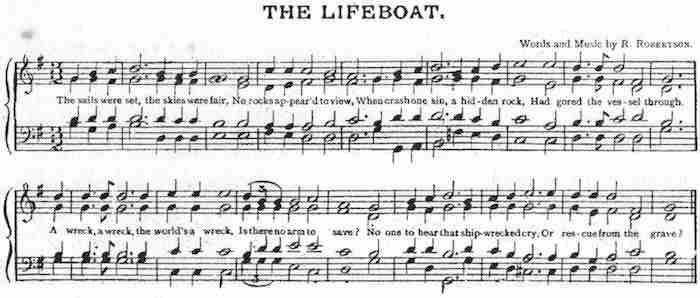 Words and Music of ‘My Mother’s Prayer’ and The Lifeboat’ by R Robertson
Words and Music of ‘My Mother’s Prayer’ and The Lifeboat’ by R Robertson
From Sacred Solos.
Garry Gillard | New: 5 September, 2022 | Now: 5 September, 2022